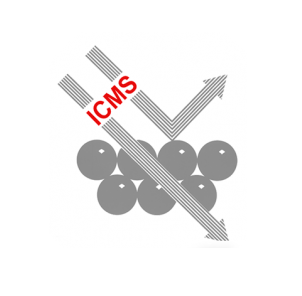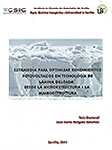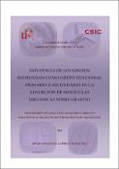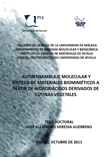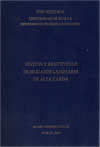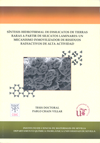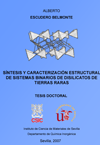Ingeniería de Cerámicas para Medioambientes Agresivos
Grupo de Investigación
- Materiales de Diseño para la Energía y Medioambiente (web)
Responsable del Grupo: Dra. Mª Dolores Alba Carranza
Catedráticos
Castro Arroyo, Miguel AngelCatedrático Universidad de Sevilla ✉ macastro@us.es ☎ 954 48 95 46 ✆ 446146 ORCID 0000-0001-6533-1343 |
Jiménez Melendo, ManuelCatedráticoUniversidad de Sevilla ✉ melendo@us.es ☎ 954 55 97 36 ORCID 0000-0002-8423-5928 |
Malet Maenner, María del PilarCatedráticaUniversidad de Sevilla ✉ malet@us.es |
Martínez Fernández, JuliánCatedrático Universidad de Sevilla ✉ martinez@us.es ☎ 954 55 28 94 ORCID 0000-0002-1199-6638 |
Ramírez de Arellano-López, AntonioCatedrático Universidad de Sevilla ✉ aral@us.es ☎ 954 55 97 32 |
Ramírez Rico, JoaquínCatedrático Universidad de Sevilla ✉ jrr@us.es ☎ 954 55 97 58 ORCID 0000-0002-1184-0756 |
Investigadores Científicos
Alba Carranza, María DoloresInvestigadora Científica CSIC ✉ alba@icmse.csic.es ☎ 954 48 95 46 ✆ 446146 ORCID 0000-0003-0025-3078 |
Científicos Titulares
Benítez Jiménez, José JesúsCientífico Titular CSIC ✉ benitez@icmse.csic.es ☎ 954 48 95 51 ✆ 446147 ORCID 0000-0002-3222-0564 |
Profesores Titulares
Bravo León, AlfonsoProfesor TitularUniversidad de Sevilla ✉ albravo@us.es ☎ 954 55 09 37 ORCID 0000-0001-7399-5190 |
Pavón González, EsperanzaProfesora Titular Universidad de Sevilla ✉ epavon@icmse.csic.es ORCID 0000-0002-4476-4403 |
Doctores Contratados
Mesquita Coelho, Joâo CarlosDoctor Contratado Universidad de Sevilla ✉ jmesquita@us.es ORCID 0000-0003-4217-3842 |
Materiales termoquímicos para almacenamiento de energía mejorados mediante control microestructural

01-09-2022 / 30-11-2024
Investigador Principal
Luis Allan Pérez Maqueda / Pedro Enrique Sánchez Jiménez
Organismo Financiador: Ministerio de Ciencia e Innovación
Código: TED2021-131839B-C22
Equipo de Investigación: Joaquín Ramírez Rico, José Manuel Valverde Millán, Antonio Perejón Pazo
El objetivo principal del proyecto MOTHERESE es el desarrollo de un nuevo concepto de almacenamiento termoquímico de energía basado en el proceso de “Calcium-Looping”. La novedad del concepto radica en disminuir la escala del componente de almacenamiento y dotarlo de un carácter modular, fácilmente integrable en plantas de generación de energía de diversa naturaleza, almacenable y móvil. El subproyecto 2 se se centra en los aspectos relacionados con el desarrollo de materiales adecuados a estas nuevas condiciones de operación, así como a la optimización de las mismas a esta nueva escala.
Se pretende abordar el desarrollo de estos materiales haciendo hincapié en técnicas de preparación que favorezcan morfologías y microestructuras que optimicen (i) la cinética de las reacciones sólido-gas, con el objeto de reducir los tiempos de residencia, (ii) estabilidad multicíclica, minimizando la desactivación por sinterizado y bloqueo de poros, y (iii) superficie activa, maximizando la cantidad de reactivo disponible para conversión en cada ciclo. Esto se conseguirá utilizando las técnicas de freeze casting y freeze granulation, especialmente adecuadas para la fabricación de estructuras cerámicas con porosidad abierta y morfología dirigida. También se plantea el uso de aditivos que mejoren el rendimiento del material. Finalmente, se contempla la integración del material activo y aditivos de alta conductividad térmica en estructuras tridimensionales estables, que no solo mejoren la ciclabilidad y eficiencia del material activo sino también asegure transferencias de calor rápidas y eficientes, necesarias para el sistema modular. Finalmente, se van a explorar nuevas condiciones de operación compatibles con la nueva escala, desde presiones reducidas hasta altas presiones de hasta 5 bares, manteniendo siempre un ciclo cerrado que evite la necesidad de separación de gases.
MOTHERESE apuesta por la economía circular, por lo que apunta al uso, como fuente de los aditivos e incluso del propio material activo, CaO, de subproductos y residuos procedentes de otras industrias, favoreciendo el aprovechamiento de residuos. Entre los planteados, escoria de acería, carbonatos biogénicos (moluscos), materiales celulósicos y cascarilla de arroz (fuente de SiO2).
Para abordar estos objetivos, el subproyecto cuenta con un equipo multidisciplinar de químicos, ingenieros, físicos y especialistas en materiales con experiencia en la gestión y participación en proyectos de investigación nacionales e internacionales, incluyendo proyectos relevantes centrados en almaceamiento termoquímico de energía. Además, el equipo tiene una red internacional de colaboradores tanto académicos como industriales que permitiría en la explotación de los resultados obtenidos y la propuesta de nuevos proyectos internacionales en esta misma línea.
Revalorización de los subproductos de la piel de patata en lacas multifuncionales sostenibles para envases metálicos de alimentos

01-12-2022 / 30-11-2024
Investigador Principal
José Jesús Benítez Jiménez / José Alejandro Heredia Guerrero (IHSM)
Organismo Financiador: Ministerio de Ciencia e Innovación
Código: TED2021-129656B-I00
Equipo de Investigación: Eva María Domínguez Carmona (IHSM), Mª de la Montaña Durán Barrantes (IHSM), Antonio Heredia Bayona (IHSM), Jorge Rencoret Pazo (IRNAS), José Carlos del Río Andrate (IRNAS), Diego Francisco Romero Hinojosa (IHSM)
El proyecto POP-UP tiene como objetivo proporcionar, en términos de bioeconomía circular, soluciones sostenibles, seguras y económicamente viables al uso masivo de resinas a base de petróleo de bisfenol A (BPA) en el envasado de alimentos a través de la fabricación de recubrimientos multifuncionales de alto rendimiento para sustratos metálicos de bajo costo a partir de subproductos agroalimentarios infrautilizados. En particular, las pieles resultantes del procesamiento industrial de patatas se utilizarán como un recurso bio-renovable de monómeros de suberina para fabricar lacas biodegradables de base biológica mediante tecnologías verdes y escalables (por ejemplo, pulverización de soluciones acuosas y policondensación en estado fundido no catalizada) para envases alimentarios sostenibles e inocuos. Este recubrimiento a base de suberina ofrecerá los mismos beneficios y propiedades con respecto a las resinas de BPA, pero estará diseñado para ser completamente atóxico y con propiedades antimicrobianas. Por lo tanto, los principales objetivos están relacionados con mejorar la seguridad alimentaria, contribuir a la transición ecológica de una economía lineal basada en los fósiles a una bioeconomía circular y aumentar la productividad agrícola mediante la revalorización de residuos vegetales.
Biomasa para la desalación por desionización capacitiva y almacenamiento de energía

01-01-2022 / 31-12-2022
Investigador Principal
Joaquín Ramírez Rico
Organismo Financiador: Junta de Andalucía
Código: US-1380856
Equipo de Investigación: Alfonso Bravo León, Manuel Jiménez Melendo, Julián Martínez Fernández
La presión sobre nuestros recursos hídricos, el calentamiento global y la escasez de combustibles fósiles son tres de los principales desafíos que, como sociedad, tendremos que abordar en la próxima década. Las soluciones a estos desafíos se basan en el desarrollo de nuevas tecnologías que permitan el uso eficiente y la reutilización de los recursos hídricos, así como en nuevos sistemas de almacenamiento de alta potencia y alta densidad de energía que se combinen con fuentes renovables. Estos dos temas aparentemente dispares dependen de una tecnología: electrodos y adsorbentes de carbono. Tanto los sistemas de desalinización y purificación como los supercondensadores y las baterías usan materiales basados en carbono con propiedades controladas mediante procesos físico-químicos. Una de las rutas más interesantes para la síntesis de estos materiales es la pirólisis de biomasa, un precursor barato y ampliamente disponible. La desionización capacitiva (CDI) es una tecnología emergente para aplicaciones en desalación que utiliza una pequeña diferencia de potencial eléctrico entre dos electrodos de carbono para eliminar iones de una solución mediante electrosorción. El pequeño potencial necesario para el proceso permite alimentar un dispositivo de CDI mediante paneles solares, lo que hace que esta tecnología sea útil en sistemas portátiles o fácilmente desplegables. Los supercondensadores y las baterías también se basan en mecanismos de adsorción y/o intercalación para almacenar carga eléctrica, en un proceso que es esencialmente el mismo, pero adaptado en este caso a maximizar la densidad de energía almacenada. Ambas tecnologías se basan en el uso de electrodos de carbono, con propiedades y estructura adaptadas a cada una de las aplicaciones.
El objetivo principal de esta propuesta es explorar el uso de residuos de biomasa como precursores de materiales de carbono con propiedades controladas para aplicaciones electroquímicas relacionadas la energía y el medio ambiente, con un enfoque en dos aplicaciones principales: almacenamiento de energía en sistemas de supercondensadores y baterías, y desalación por CDI. La ruta de preparación de será la pirólisis de precursores de biomasa, centrándonos en productos de desecho de explotaciones agrícolas. Para la obtención de electrodos monolíticos usaremos madera y tableros prensados de fibra. Desarrollaremos métodos físicos y químicos con el fin de controlar sus propiedades para mejorar su capacitancia o selectividad de iones.
Construiremos un dispositivo de CDI a escala laboratorio para determinar el comportamiento de desalinización y correlacionarlo con información microscópica obtenida por técnicas avanzadas como microscopía electrónica, experimentos de difracción de dispersión total, isotermas de adsorción de nitrógeno y otros. Estudiaremos las propiedades electroquímicas de estos materiales y las correlacionaremos con la estructura y las condiciones de procesado. Nuestro objetivo será optimizar los electrodos de carbono derivados de la biomasa para aplicaciones específicas y desarrollar materiales de carbono derivados de la biomasa ‘a la carta’.
Materiales Biomórficos para almacenamiento de energía

05-10-2021 / 31-03-2023
Investigador Principal
Joaquín Ramírez Rico
Organismo Financiador: Junta de Andalucía
Código: P20_011860 - PAIDI 2020
Equipo de Investigación: María Dolores Alba Carranza, Alfonso Bravo León, Manuel Jiménez Melendo, Esperanza Pavón González
El objetivo principal de esta propuesta es desarrollar materiales de carbono a medida para aplicaciones relacionadas con tecnologías energéticas y medioambientales, con un enfoque en tres aplicaciones principales: almacenamiento de energía, soportes de catalizador en pilas de combustible y electrolizadores y el almacenamiento y captura de gas, especialmente hidrógeno y dióxido de carbono. Proponemos producir estos materiales mediante pirólisis de desecho de biomasa y otros residuos orgánicos. El uso de biomasa como precursor en la síntesis de materiales tiene interés dada su abundancia y bajo costo, y presenta una oportunidad para convertir los residuos de la industria agroalimentaria local en un producto de alto valor añadido.
BioMatStor desarrolla I + D en diferentes niveles de aplicación: fundamental para la caracterización y fabricación de la ciencia de los materiales, y ciencia aplicada para el modelado y caracterización de sistemas de almacenamiento de energía. Este proyecto combina ciencia de materiales e ingeniería energética con el objetivo de obtener materiales de alto rendimiento para una amplia gama de aplicaciones en la producción y almacenamiento de energía. Proponemos un enfoque multidisciplinar que tiene su base en la excelencia científica, responde a los desafíos sociales y puede resultar en una transferencia de tecnología significativa a la industria. Este proyecto también aborda los objetivos socio-estratégicos de Horizonte 2020, ya que tiene como objetivo contribuir a la mejora de nuestro entorno a través de la ciencia avanzada y la investigación multidisciplinar, y está totalmente alineado con los objetivos y políticas de la Unión Europea, Horizon2020, SET Plan y los objetivos RIS3 de la región de Andalucía.
Cerámicas Conductoras de Protones para Electrolizadores Reversibles de Alta Eficiencia y Aplicaciones Power to X

01-06-2020 / 31-05-2023
Investigador Principal
Joaquín Ramírez Rico / Ricardo Chacartegui Ramírez
Organismo Financiador: Ministerio de Ciencia e Innovación
Código: PID2019-107019RB-I00 "Retos de la Sociedad"
Equipo de Investigación: Alfonso Bravo León, Manuel Jiménez Melendo, Julián Martínez Fernández, Miguel Torres García
PROCEX aborda el Reto social 3 "Energía limpia, eficiente y segura" y pretende abrir camino a una nueva generación de electrolizadores reversibles de alta eficiencia que operan a temperaturas intermedias (sobre 500ºC). Su éxito abriría una vía muy prometedora para nuevos sistemas de almacenamiento de energía fotovoltaica y eólica con características sobresalientes, tales como eficiencias de ida y vuelta (superiores al 75%) o tasas de retorno energético (>10). Estos valores son muy superiores a los que se pueden alcanzar con los mejores sistemas de almacenamiento térmico. Además, el uso de electrolizadores de alta eficiencia encontraría un enorme campo de aplicación en la producción de H2 y en la industria química. Para desarrollar estos sistemas, es necesario superar numerosos retos en el ámbito de los materiales cerámicos: en particular, es necesario desarrollar nuevos electrolitos conductores de protones con baja conductividad electrónica.
El objetivo principal del proyecto es identificar, sintetizar y demostrar nuevos materiales cerámicos conductores de protones con bajas pérdidas electrónicas en electrolisis, usando estrategias de dopado en compuestos de circonatos y ceratos de bario. Ponemos énfasis no sólo en mejorar la eficiencia sino también en la durabilidad de estos materiales. El proyecto demostrará el procesado de los electrolitos y su integración en pilas tipo botón a escala laboratorio, y estudiará los principales mecanismos de reacción, desarrollando modelos que permitan predecir su comportamiento a gran escala. Este proyecto parte de resultados publicados muy recientemente en la literatura y pretende superarlos apoyándose en las capacidades y experiencia previa del equipo investigador. En el proyecto ampliaremos el rango de composiciones y dopantes a estudiar y realizaremos un estudio sistemático que nos permita relacionar la composición y procesado con las propiedades y el rendimiento en condiciones de servicio (i.e. la degradación y el envejecimiento. A partir de la información obtenida pretendemos desarrollar y validar nuevos modelos que permitan evaluar la integración de estos sistemas en distintas aplicaciones. La ambición del este proyecto requiere un tratamiento multidisciplinar fruto de la combinación de dos grupos de investigación, uno de Ciencia de Materiales y otro de Ingeniería Energética, que poseen las capacidades e instalaciones necesarias para llevar a buen término el proyecto: síntesis y procesado de materiales, caracterización física, modelado numérico e integración de sistemas de almacenamiento de energía.
Aspectos genéticos y biofísicos de la formación de la cutícula del fruto del tomate

01-01-2019 / 30-06-2022
Investigador Principal
Eva María Domínguez Carmona (IHSM) / Rafael Muñoz Fernández (IHSM)
Organismo Financiador: Ministerio de Ciencia e Innovación
Código: RTI2018-094277-B-C22 "Retos de la Sociedad"
Equipo de Investigación: José Jesús Benítez Jiménez, Manuel León Camacho (IG)
Las ceras y los fenoles son compuestos minoritarios de la cutícula del fruto de tomate que, a pesar de ello, juegan un papel determinante en varios aspectos relacionados con la calidad de los frutos. Se ha demostrado que los fenoles de la cutícula modulan el color final de los frutos y la rigidez de la cutícula, determinando así el grado de sensibilidad del fruto al agrietado durante la maduración. No son, de todos modos, los únicos que contribuyen a las propiedades mecánicas de la cutícula. En proyectos anteriores se cartografiaron y validaron cinco QTLs relacionados con la cantidad de fenoles de la cutícula. La identificación de los genes responsables de estas regiones genómicas mejorará nuestra comprensión de este carácter y cómo modularlo para generar líneas comerciales con combinaciones deseables de color del fruto y resistencia mecánica. En este sentido, el análisis de QTLs de las propiedades mecánicas y térmicas de la cutícula será el primero de su tipo y permitirá conocer las bases genéticas de propiedades biofísicas. Por otro lado, las ceras cuticulares son la principal barrera a la permeabilidad del agua y regulan el estado hídrico de los frutos durante la cosecha, postcosecha y almacenamiento y transporte. Un análisis preliminar del contenido de ceras de las especies silvestres emparentadas con el tomate cultivado reveló el interés potencial de dos especies de fruto rojo para el desarrollo de nuevas variedades con tolerancia a ambientes deshidratantes. El análisis de la permeabilidad al agua y contenido y tipos de ceras de las cutículas de estas dos especies será un primer paso para la consecución de este objetivo final.
Nuevo concepto de caldera de biomasa basada en materiales biocerámicos y combustión porosa para operación eficiente con residuos

30-12-2016 / 31-12-2020
Investigador Principal
Joaquín Ramírez Rico
Organismo Financiador: Ministerio de Economía y Competitividad
Código: MAT2016-76526-R "Retos de la Sociedad"
Equipo de Investigación: Julián Martínez Fernández, Manuel Jiménez Melendo
En la Unión Europea se generan anualmente más de cinco toneladas de residuos por persona, siendo aproximadamente el 60% de esta cantidad materia orgánica. La tecnología de las calderas de biomasa actuales no permite el uso de estos residuos funcionando con altos valores de eficiencia, bajas emisiones y alta fiabilidadad de operación, siendo especialmente relevante en calderas de pequeño tamaño.
El principal objetivo de este proyecto es desarrollar un nuevo concepto de tecnología para calderas de biomasa doméstica capaz de operar con gran variedad de mezclas de biomasas y residuos agrícolas. Para ello se aprovecharán las sinergias de la integración de investigadores del: i) Grupo Maquinas y Motores Térmicos, GMTS, especialistas en combustión, calderas y máquinas térmicas ii) Grupo Materiales Biomiméticos y Multifuncionales, MBM, especialistas en la obtención de cerámicos porosos bioderivados, así como en caracterización físico-química y microestructural. El proyecto se completa con la colaboración de empresas en la evaluación de la tecnología y su aplicabilidad industrial.
El proyecto se basa en la innovadora integración de material biocerámico microporoso en las cámaras de combustión de calderas de biomasa de modo que actúen con diferentes funciones: combustor microporoso, filtro de partículas y recuperador de calor. Estas funcionalidades pueden ser simultáneas, en función de la región del flujo en que se encuentren y el rango de temperaturas de esa región. Este material biocerámico es desarrollado a partir de precursores vegetales para obtener elementos de Carburo de Silicio (SiC). Para ello se usan materiales locales sin tratar, produciendo elementos hechos a medida con propiedades microestructurales adecuadas para trabajar con altas temperaturas. Así, productos con geometrías complejas pueden ser obtenidos con relativamente bajo coste comparados con otros materiales con características mecánicas y químicas similares. La integración de componentes basados en estos materiales posibilita nuevos diseños de calderas de biomasa con un alto control de la combustión, las temperaturas y la emisión de partículas. El nuevo diseño evita la sinterización y fusión de las cenizas, actuando en la formación y evolución de contaminantes, inhibiendo los mecanismos de producción de dioxinas y activando la completa oxidación del monóxido de carbono (CO) y soots. El nuevo concepto permitirá la operación con una importante variedad de mezclas biomasa/ residuos agrícolas con bajas emisiones aun cuando el combustible presente un alto contenido de cenizas, resolviendo el principal reto para el desarrollo del uso residuos agrícolas en calderas de biomasa (especialmente las de menor tamaño). El desarrollo de esta tecnología permitirá ampliar los recursos de la Unión Europea para calefacción de uso doméstico. En la actualidad este uso supone un 30% del consumo energético total en la misma. La propuesta incluye el estudio de los procesos básicos de combustión, flujos, fabricación a medida de las matrices de materiales biocerámicos, así como estudio y desarrollo de prototipos de componentes y del sistema final. Estos serán estudiados a nivel de ensayos de laboratorio con residuos agrícolas, forestales y de la industria olivarera.
Bases genéticas de la composición y propiedades biofísicas de la cutícula del fruto del tomate. Aprovechamiento de la variabilidad natural
01-01-2016 / 31-12-2018
Investigador Principal
Rafael Fernández Muñoz (IHSM)
Organismo Financiador: Ministerio de Economía y Competitividad
Código: AGL2015-65246-R
Equipo de Investigación: José Jesús Benítez, Fernando Gallardo Alba (UMA), Antonio Heredia Bayona (IHSM)
La producción de frutos de gran calidad y valor añadido es uno de los retos importantes de la agricultura. La cutícula que cubre el exterior de las células epidérmicas juega un papel crucial en la calidad del fruto de tomate, concretamente en su apariencia externa (color, brillo, textura, uniformidad), en el origen y desarrollo de fisiopatías de gran importancia económica como el agrietado, además de en el mantenimiento del estado hídrico de los frutos durante la postcosecha. En proyectos anteriores (AGL2006-12494, AGL2009-12134 y AGL2012-32613), de los que éste puede considerarse una continuación, se puso de manifiesto el importante papel que juega la cutícula en el agrietado y cómo cambios en las propiedades biomecánicas de la misma repercuten en la incidencia de esta fisiopatía. De igual manera, el estudio de los flavonoides presentes en la cutícula que le proporcionan su especial coloración en estadios maduros permitió identificar el papel que éstos juegan como reguladores de la síntesis de cutícula y en su permeabilidad al agua. En este proyecto se empleará una población de líneas recombinantes puras (RIL) y una población de líneas de introgresión (IL) de un cruzamiento S. lycopersicum x S. pimpinellifolium para la validación e identificación de QTLs y genes candidatos involucrados en la deposición de los distintos componentes de la cutícula (ceras, cutina, flavonoides, polisacáridos) y la localización de QTLs/regiones genómicas asociadas a otros caracteres de cutícula como el grosor y densidad que hasta el momento no han sido estudiados. Este abordaje multidisciplinar, que incluye el análisis biofísico de las cutículas, permitirá el diseño de variedades de fruto de tomate con propiedades biomecánicas e hidrodinámicas que reduzcan la incidencia del agrietado, que mantengan el estatus hídrico del fruto durante la postcosecha y que eviten caracteres gustativos de la piel poco deseables para el consumidor. Finalmente, se estudiará una colección de entradas de todas las especies silvestres de tomate que ahondará en el conocimiento de cómo ha evolucionado la cutícula y sus componentes en el taxon Lycopersicon. Este análisis evolutivo permitirá la identificación de diferentes tipos morfológicos de cutículas y de diversas combinaciones de sus componentes que serán útiles para el aumento de la variabilidad disponible en los futuros programas de mejora genética para la obtención de variedades de tomate de calidad.
Tratamiento sostenible de residuos industriales: Materiales adsorbentes de diseño y bionanocomposites en la inmovilization de metales pesados y productos de fision
01-01-2016 / 30-06-2019
Investigador Principal
Maria Dolores Alba Carranza
Organismo Financiador: Ministerio de Economía y Competitividad
Código: MAT2015-63929-R
Equipo de Investigación: Miguel Angel Castro Arroyo, Ana Carmen Perdigón Aller, María del Mar Orta Cuevas
El Proyecto de investigación que se presenta aborda la exigencia tecnológica y medioambiental de desarrollar metodologías avanzadas para la eliminación de agentes contaminantes. El interés y los esfuerzos encaminados al desarrollo de nuevas tecnologías orientadas a tratamientos más eficientes en la inmovilización y revalorización de los residuos peligrosos es creciente en los planes de I+D+i. El objetivo central del proyecto se basa en el diseño de una estrategia de funcionalización de silicatos laminares de alta carga expansibles y en la síntesis de bionanocomposites a partir de ellos para conseguir una actividad eficaz respecto de la inmovilización de residuos tóxicos y peligrosos, catiónicos y aniónicos. Este objetivo es un cambio cualitativo en el trabajo que se viene desarrollando en el diseño de sistemas modelos adsorbentes con aplicaciones medioambientales de clara repercusión en la mejora de la calidad de vida de la población y conservación del medioambiente, ya que la funcionalización de diseño de los silicatos sintéticos permitirá la adsorción de un amplio abanico de adsorbentes en estado de oxidación aniónico-catiónico. La finalidad y objetivos del proyecto se centran en la Focus Area WASTE de H2020 y esta Focus Area se desarrolla dentro del reto 2 y 5 de H2020 y dentro del Reto 5 y 3 de los Planes Estatales de Investigación.
El proyecto ha despertado el interés de diversas empresas observadoras, EPOs, (ENRESA y la Agencia de la Energía y para la Sostenibilidad del Ayuntamiento de Sevilla ) impulsando la colaboración público-privada. Por tanto, la investigación desarrollada auna los principios básicos de la estrategia estatal de Ciencia y Tecnología: Poner la I+D+I al servicio de la ciudadanía, del bienestar social y de un desarrollo sostenible, hacer de la I+D+I un factor de mejora de la competitividad empresarial (transferencia de los resultados al sector privado, ver interes de los EPOs) y reconocer y promover la I+D como un elemento esencial para la generación de nuevos conocimientos de excelencia.
La viabilidad de la propuesta se garantiza porque el equipo de investigación, EI, por un lado, ha desarrollado con éxito la síntesis de silicatos laminares hidratables de alta carga, a través de un método novedoso que permite ajustar la carga deseada para el material, y, por otro, ha conseguido exitosamente su organofuncionalización (patente ES2362597B1). Además, ha desarrollado la metodología necesaria para el correcto progreso de este proyecto, en estrecha colaboración con otros Grupos de investigación internacionales de reconocido prestigio (e.g. CNRS-Universidad de Lille, Universidad de Cambridge...). Además el EI ha demostrado que potencia la agrupación de las capacidades y competencias científico-técnicas esenciales para abordar esta propuesta de marcado caracter transversal.
Estudio del mecanismo de adsorción de contaminantes aniónicos peligrosos por aluminosilicatos de diseño

01-02-2015 / 28-02-2017
Investigador Principal
Esperanza Pavón González
Organismo Financiador: Junta de Andalucía
Código: TAHUB-082. Programa Talent HUB
El desarrollo científico, tecnológico e industrial en la últimas décadas del siglo pasado ha causado un incremento en la contaminación del medio ambiente. Debido a ello, la comunidad internacional reconoce la necesidad de desarrollar nuevas tecnologías y estrategias para el control de la contaminación. El objective principal de este Proyecto cumple con este propósito: el diseño de silicatos laminares expansibles de alta carga y su posterior modificación superficial para que se conviertan en materiales adecuados para la retención e inmobilización de contaminantes tóxicos aniónicos.
La metodología del Proyecto se basas en la síntesis de micas de alta carga expansibles con sustituciones isomórficas de Si+4 por Al+3 y con una densidad de carga en el rango de las micas frágiles pero con una capacidad de intercambio e hinchamiento inusuales en estos materiales. Para potenciar su capacidad de adsorción, la superficie de estos materiales se funcionalizará con magnetica por un lado y con la inclusion de cationes de alquilamonio, por otro.
Además, se establecerá un protocolo de inmobilizacion de productos aniónicos altamente tóxicos como son AsO42-, SO42-, en función de la estructura y la funcionalización de las micas de alta carga expansibles. Más tarde, la aplicabilidad de estas reacciones de adsorción se comprobará en suelos reales contaminados de Chile y España.
Desarrollo de procesos de combustión catalítica de hidrógeno y estudio de su integración en dispositivos para aplicaciones portátiles

16-05-2014 / 15-05-2016
Investigador Principal
Asunción Fernández Camacho
Organismo Financiador: Junta de Andalucía
Código: P12-TEp-862
Equipo de Investigación: Julián Martínez, Gisela Arzac, Dirk Hufschmidt, Joaquín Ramírez, M.Carmen Vera, Vanda Godinho, Lionel Cervera, T.Cristina Rojas, Olga Montes, Mariana Paladini, Jaime Caballero-Hernández
El hidrógeno como vector de transporte y almacenamiento de energía es un candidato muy atractivo en el contexto de un mayor uso de las energías renovables y limpias. La producción y el uso de la energía basada en la tecnología del hidrógeno es de especial relevancia en pequeña escala para aplicaciones portátiles (y potencialmente escalable para aplicaciones estacionarias). En el presente proyecto se abordará el estudio del proceso de combustión catalítica o controlada de hidrógeno en los distintos aspectos que puedan conducir a una configuración final integrada con un sistema de generación de H2 en aplicaciones portátiles. Para ello se aprovecharán las sinergias integrando investigadores de dos grupos del PAI: i) Del grupo TEP217, especialistas en almacenamiento y generación de hidrógeno en sistemas basados en hidruros metálicos, hidruros complejos y composites de hidruros reactivos; así como en el uso de catalizadores y aditivos para controlar y mejorar las cinéticas de estos procesos. ii) Del grupo FQM342, especialistas en la obtención de cerámicos porosos de alto interés como soportes de catalizadores en entornos agresivos de combustión. Además la colaboración se completa con la participación de la empresa Abengoa Hidrógeno S.A. que participa en calidad de subcontratada como especialistas en sistemas de producción y almacenamiento de hidrógeno.
En particular se trabajará en este proyecto en las siguientes líneas de actuación:
1.- Desarrollo de catalizadores y soportes para la combustión controlada. Típicamente cerámicas porosas biomórficas de carburo de silicio y catalizadores clásicos tipo metal noble y nuevos catalizadores de bajo coste a desarrollar en el proyecto.
2.- Desarrollo de los reactores necesarios para el estudio de la combustión controlada. Típicamente para flujos de hidrógeno de unos pocos ml/min y para la escala de un generador de H2 ya disponible de 0.5 a 1.5 L/min.
3.- Acoplamiento al sistema de combustión controlada de los sistemas portátiles de generación de hidrógeno que hemos desarrollado en proyectos anteriores.
4.- Aplicación de la tecnología de pulverización catódica de una manera exploratoria en este proyecto para depositar los catalizadores de combustión catalítica en sustratos porosos.
5.- Caracterización microestructural y química de los soportes y catalizadores en la nanoescala para seguir los procedimientos de síntesis y evolución en operación.
Estudio de la inmovilización de metales pesados por micas de alta carga sintéticas organofuncionalizadas: pruebas a escala de laboratorio

16-05-2014 / 16-02-2019
Investigador Principal
María Dolores Alba Carranza
Organismo Financiador: Junta de Andalucía
Código: P12-FQM-567
El tema central del proyecto aborda la exigencia tecnológica mediambiental de desarrollar metodologías avanzadas para la eliminación de agentes contaminantes. El interés y los esfuerzos encaminados al desarrollo de nuevas tecnologías orientadas a tratamientos más eficientes en la inmovilización y revalorización de los residuos peligrosos es crecientes en los planes de I + D + i de los últimos años. Es en este escenario donde debe encuadrarse el presente proyecto y en concreto en el marco de la gestión de cationes de metales pesados, tema de elevado interés social en la presente década.
Desde la segunda mitad del siglo XX la Humanidad se ha enfrentado a un enorme desarrollo científico y tecnológico que es el responsable de un incremento de la contaminación mediambiental. Como ejemplo podemos mencionar dos problemas que en la actualidad son motivos de preocupación y actuación de la Junta de Andalucía: contaminación de los litorales andaluces y las aguas residuales urbanas. Por tanto, estamos ante un problema complejo en el que los agentes contaminantes son variados, las fuentes de procedencia son diversas y las vías o rutas seguidas por los distintos contaminantes, frecuentemente, escapan al control necesario para evitar efectos indeseados sobre el entorno natural y urbano. Es por ello, que se demanda una investigación a nivel básico y aplicado de los mecanismos necesarios para la inmovilización de dichos cationes nocivos.
Los objetivos y alcance de este proyecto se basan en los avances llevados a cabos por otros grupos de investigación de la gestión de estos tipos de contaminantes y en los últimos resultados de la investigación llevada a cabo por el equipo de investigación que han permitido el diseño de silicatos laminares expansibles de alta carga con especiales propiedades como precursores para la retención de residuos nocivos. Por tanto, se propone en este proyecto la organofuncionalización de dichas micas sintéticas con grupos tioles o con cationes de alquilamonio de longitud de cadena variable y la evaluación de su capacidad de adsorción y retención irreversible de metales pesados.
Filtros Bio-cerámicos para partículas en motores diesel
01-01-2014 / 31-12-2016
Investigador Principal
Julián Martínez Fernández / Ricado Chacartegui
Organismo Financiador: Ministerio de Economía y Competitividad
Código: MAT2013-41233-R (Programa Retos)
Equipo de Investigación: José Antonio Becerra Villanueva, Alfonso Bravo León, Manuel Jiménez Melendo, Antonio Ramírez de Arellano López, Joaquín Ramirez Rico, Francisco Varela Feria
La importancia del control de las emisiones de partículas en motores diésel es fundamental dados el volumen global de los mismos y el impacto medioambiental y económico asociado. Los sistemas de control de partículas basados en modificaciones del proceso de combustión en el motor no son suficientes para alcanzar las exigencias normativas actuales, y menos las futuras, y por tanto necesariamente hay que emplear sistemas de postratamiento como los filtros. Existe un amplio margen de mejora de los mismos tanto en fiabilidad, control de la degradación de prestaciones, durabilidad, operación multicombustible y reducción de costes.
En el presente proyecto se abordará el desarrollo y fabricación de un filtro de partículas regenerativo en motores diésel que mejore las especificaciones de los sistemas actuales, basado en una nueva generación de materiales cerámicos bioderivados, y que integre sistemas para la combustión de partículas. Para ello se aprovecharán las sinergias integrando investigadores del: i) Grupo Maquinas y Motores Térmicos, GMTS, especialistas en motores de combustión interna ii) Grupo Materiales Biomiméticos y Multifuncionales, MBM, especialistas en la obtención de cerámicos porosos bioderivados, así como en caracterización físico-química y microestructural. El proyecto se completa con la colaboración de empresas en la evaluación de la tecnología y su aplicabilidad industrial.
Se trabajará en las siguientes líneas:
-Determinación de rutas de procesado para el desarrollo de elementos filtrantes con propiedades físico‐químicas idóneas, en base a los conocimientos previos en materiales bioderivados y nuevas tecnologías relativas al uso de geles de SiO2.
-Determinación de catalizadores idóneos y sistemas para su deposición.
-Fabricación de los elementos filtrantes constituidos de soporte poroso más catalizador.
-Caracterización exhaustiva de las propiedades microstructurales y físico-químicas de interés para la aplicación.
-Desarrollo de sistemas de activación para la regeneración del filtro.
-Diseño y fabricación de los filtros con geometría idónea y dimensiones prototipo.
-Diseño de la unidad piloto y estudio de la integración y operación sobre el motor de referencia.
-Diseño final del filtro para su instalación industrial.
Estudios previos desarrollados por MBM en estos materiales bioderivados han demostrado su potencialidad como elementos filtrantes de gas a altas temperaturas en plantas de gasificación de carbón, lo que avala el éxito de este proyecto, que abordará las mejoras necesarias para desarrollar la tecnología en las condiciones de combustión de los motores diésel, bajo condiciones dinámicas en vehículos y filtros regenerativos.
Una reducción de contaminantes en las emisiones de los motores diésel tendría un gran impacto medioambiental, para la salud y económico, debido a los cerca de 100 millones de vehículos diésel circulando en Europa y una industria vinculada con más de 2 millones de empleos directos y tendencia creciente en el mercado. Este proyecto aborda el Reto Social 3 del Horizonte 2020, Energía segura, limpia y eficiente. Además el uso de materiales biocerámicos permite la sustitución de los elementos metálicos empleados en la actualidad, por lo que también se alinea con el Reto Social 5 del Horizonte 2020 en la búsqueda de alternativas a las materias primas esenciales en aplicaciones ya existentes reduciendo la dependencia de importaciones y sostenibilidad de las aplicaciones.
Obtención de bioplásticos tipo polihidroxialcanoato (PHA) de cadena larga a partir de desechos de epidermis de frutos comerciales

16-05-2013 / 15-05-2016
Investigador Principal
José Jesús Benítez Jiménez
Organismo Financiador: Junta de Andalucía
Código: P11-TEP-7418 (Proyecto de Excelencia)
Equipo de Investigación: Antonio Heredia Bayona, Miguel Angel San Miguel Barrera, Jaime Oviedo López, J. Alejandro Heredia Guerrero, Santiago Domínguez Meister, Daniel Aguilera Puerto, Francisco Javier Navas Martos, José Manuel de la Torre Ramírez
El presente proyecto de investigación tiene por objeto el estudio de la viabilidad de la implementación de un proceso a escala planta piloto que permita obtener un material bioplástico a partir de una materia prima asequible y de bajo coste como son los desechos de pieles (epidermis) de frutos. La oportunidad de la propuesta parte de proponer un nuevo tipo de material polimérico completamente inocuo, biodegradable y ecológico como sustituto de plásticos tradicionales obtenidos a partir del petróleo que conllevan un serio problema medioambiental, tanto en su producción industrial como en su posterior desecho. Por otro lado, el concepto de sostenibilidad medioambiental se extiende no sólo a la biodegradabilidad del producto final y al bajo impacto del proceso de producción propuesto, también a su obtención a partir de un recurso vegetal que no se retrae de la cadena alimenticia animal y humana, como es el caso de los bioplásticos que se vienen fabricando actualmente a partir de maíz o patata. Por otro lado, y en nuestro ámbito territorial andaluz, la materia prima es especialmente accesible dado el volumen de la actividad agroalimentaria. En este mismo sentido, el nuevo bioplástico podría paliar un importante problema de eliminación de residuos plásticos en explotaciones agrarias ya que se concibe como plenamente compostable y, por tanto, capaz de generar biomasa asimilable por la siguiente generación de plantas. El producto propuesto viene, además, a completar la gama de polihidroxialcanoatos (PHA) a los miembros de la serie obtenidos a partir de polihidroxiácidos de cadena larga. Las propiedades singulares de esta nueva familia puede ser un buen complemento de los ya conocidos y podría dar lugar a aplicaciones novedosas y de mayor valor añadido.
Estudio de las interacciones intermoleculares entre hidroxiacidos carboxilicos de cadena larga como modelo para el diseño de poliesteres biomimeticos

01-01-2012 / 31-12-2014
Investigador Principal
José Jesús Benítez Jiménez
Organismo Financiador: Ministerio de Ciencia e Innovación
Código: CTQ2011-24299
Equipo de Investigación: Alejandro Heredia Guerrero, Miguel Angel San Mibuel Barrera, Jaime Oviedo López, Miguel Salmerón Batalle
El objetivo de este proyecto de investigación es el estudio y determinación de las interacciones que se ponen de manifiesto entre las moléculas de ácidos carboxílicos lineales de cadena larga en función del nivel y tipo de funcionalización con grupos hidroxilos. Para ello se proponen sistemas modelos basados en capas autoensambladas de estas moléculas sobre un soporte plano de baja energía de interacción para que sean las propias interacciones intrermoleculares las que condicionen la estructura del empaquetamiento. La metodología de estudio de estos sistemas confinados combinará, fundamentalmente, las microscopías de sonda de proximidad, las simulaciones atomísticas de dinámica molecular y el análisis químico por espectroscopía infrarroja. La información fundamental obtenida se empleará para el diseño de una ruta de síntesis química de poliésteres miméticos a la cutina vegetal, un biopolímero de barrera hidrófobo, inocúo y completamente biodegradable. Se determinarán las propiedades físicas (mecánicas, permeabilidad, de transporte iónico, etc…) y químicas (grado de esterificación, degradabilidad, etc…) de estos materiales sintéticos y se relacionarán con sus estructuras primarias (red de enlaces ester) y secundarias (interacciones por puente de hidrógeno entre grupos hidroxilos remanentes). A partir de esta relación estructura-función, se modificará el protocolo de síntesis empleando elementos no propagadoras del entrecruzamiento de la red primaria (moléculas con bajo grado de hidroxilación) y modificadores de de la red secundaria (ácidos carboxílicos con distinto grado de hidroxilación), con vistas a la obtención de polímeros con propiedades “a la carta”. Finalmente, se explorará el potencial de aplicación de estos poliésteres sintéticos como sustitutos de plásticos obtenidos a partir de hidrocarburos con vistas a reducir residuos, tanto en el proceso de fabricación como los asociados a su desecho.
Inmovilización de cationes en un espacio confinado de alta densidad de carga: gestión de residuos peligrosos

01-01-2011 / 31-12-2013
Investigador Principal
María Dolores Alba Carranza
Organismo Financiador: Ministerio de Ciencia e Innovación
Código: CTQ2010-14874/BQU
Equipo de Investigación: Miguel Angel Castro Arroyo, Maria del Mar Orta Cuevas, Mery Carolina Pazos Zarama, Said ElMrabet, Esperanza Pavón González, Maria Villa Alfageme, Santiago Medina Carrasco, Ana Isabel Becerro Nieto, Alberto José Fernández Carrión
El tema central del Proyecto aborda la exigencia tecnológica medioambiental de desa-rrollar metodologías avanzadas para la eliminación de agentes contaminantes. El interés y los esfuerzos encaminados al desarrollo de nuevas tecnologías orientadas a tratamientos más eficientes en la inmovilización y revalorización de los residuos peligrosos es crecientes en los planes de I + D + i de los últimos años. Es en este escenario donde debe encuadrarse la presente propuesta, circunscrita en dos hallazgos básicos experimentales: el diseño de silicatos laminares expansibles de alta carga con una distribución controlada de sus centros activos que le confieren especiales propiedades como precursores para el diseño de materiales eficaces en cuanto a la retención de residuos nocivos y radiactivos, y la obtención de fases disilicatos insolubles en condiciones suaves, apropiadas para la inmovilización de dichas especies. Dicho objetivo representa un cambio cualitativo en el trabajo que se viene desarrollando en cuanto a su aplicación a residuos radioactivos y tóxicos reales, de una parte, y en cuanto a la aplicación de la metodología desarrollada en sistemas modelos a silicatos de utilidad, de otra. Los objetivos se adecuan, en general, a las líneas prioritarias de Investigación básica de Química, en concreto en el área de Química Inorgánica (Química del Estado Sólido) y Química Medioambiental, pero a pesar de su carácter básico posee un carácter aplicado que se adecua a diversas líneas de investigación de Química Orientada y ha despertado el interés de diversas empresas observadoras (ENRESA, BEFESA y ALQUIMIA). Estos objetivos requieren el desarrollo de técnicas de análisis sofisticado como la Resonancia magnética Nuclear de Sólido, la Difracción de Rayos-X bajo atmósfera controlada o espectroscopia gamma de bajo recuento, teniendo en cuenta el objetivo particular de dicha área de usar la tecnología instrumental y experimental para el estudio de materiales, satisfaciendo además el objetivo O2.5 (Potenciar la disponibilidad de infraestructuras de uso interdisciplinar y de uso compartido por los distintos agentes del sistema) del plan nacional de I+D+i 2008-2011. La viabilidad de la propuesta se garantiza, en primer lugar, porque el EI ha publicado recientemente la síntesis de silicatos laminares hidratables de alta carga, donde describe un método a partir del cual se puede ajustar la carga deseada para el material; en segundo lugar, el EI posee una dilatada experiencia en el diseño de mecanismos de síntesis de silicatos, como se demuestra por los numerosos artículos publicados en esta área durante la última década y finalmente, el EI ha desarrollado metodología necesaria para el desarrollo de este experimento en colaboración con otros Grupos con los que mantiene una estrecha colaboración científica.
Bioener: Aplicación de tecnologías biomiméticas a sistemas energéticos

01-01-2010 / 31-12-2012
Investigador Principal
Julián Martínez Fernández
Organismo Financiador: Junta de Andalucía
Código: P09-TEP-5152 (Proyecto de Excelencia)
Equipo de Investigación: Manuel Jiménez Melendo, Antonio Ramírez De Arellano-López, Alfonso Bravo León, F.M. Varela Feria
Los avances tecnológicos han permitido diversificar y optimizar la producción de ener-gía, lo que ha conducido al mismo tiempo, a desarrollar nuevas vías de almacenamiento de la misma. En particular, a medida que se diversifican los métodos de producción energética, es necesario desarrollar nuevos materiales para almacenamiento de energía, para su uso en dispositivos de consumo y transporte. Esto es especialmente importante para países que, como España, llevan años aumentando la presencia de las renovables en su carta de tecnologías de producción eléctrica y son actualmente líderes mundiales del sector. El Plan de Fomento de las Energías Renovables 2000-2010 tiene como objetivo para este año generar hasta el 30% de las necesidades de consumo energético nacionales a partir de energías renovables, mientras que en algunas comunidades autónomas la cuota de renovables supone ya más del 75% del consumo anual. La progresiva penetración de las renovables debe ir necesariamente acompañada del desarrollo de nuevas tecnologías de distribución y almacenamiento energético, teniendo en cuenta que la potencia suministrada por las renovables es intermitente y variable, al depender las condiciones meteorológicas. Otra estrategia a corto plazo para reducir la dependencia de los combustibles fósiles es la mejora de la eficiencia los sistemas de generación de energía convencionales mediante el aumento de las temperaturas de operación, por ejemplo en turbinas de combustión de gas. El desarrollo de nuevos materiales para aplicaciones de alta temperatura ha ido tradicionalmente ligado a la demanda de mayores eficiencias. De entre ellos, los materiales cerámicos se postulan como candidatos para aplicaciones en entornos químicamente agresivos a temperaturas superiores a los 1000ºC. Carburos y nitruros en particular, con su elevado punto de fusión y excelentes propiedades termomecánicas, están siendo extensamente estudiados en la actualidad para este tipo de aplicaciones. Los cerámicos porosos también son de gran interés en aplicaciones energéticas, como intercambiadores de calor o sistemas de filtrado de gas de síntesis, entre otros. De las líneas de investigación en nuevos materiales para almacenamiento energético, el desarrollo de nuevos sistemas de almacenamiento electroquímico tendrá un gran impacto a corto plazo, especialmente en el consumidor final: el desarrollo de baterías y condensadores electroquímicos de alta capacidad es clave para la viabilidad de tecnologías que, como los vehículos eléctricos, deberán implantarse en un corto plazo para reducir nuestra dependencia de los combustibles fósiles. Es por esta razón que los materiales para almacenamiento electroquímico han recibido gran atención de la comunidad científica y constituyen uno de los grandes retos tecnológicos actuales. El carburo de silicio biomórfico (bioSiC) es un material cerámico obtenido por infiltra-ción reactiva de preformas de carbono obtenidas mediante pirólisis de precursores vegetales. El precursor, generalmente madera, se mecaniza en bruto y se carboniza mediante un proceso de pirólisis en atmósfera controlada a alta temperatura, obteniéndose un material de carbono macroporoso (bioC) cuya microestructura es similar a la del precursor vegetal. Este precursor se mecaniza hasta una forma cercana al producto final y se infiltra reactivamente con silicio líquido o gaseoso para obtener un material de SiC/Si que presenta unas excelentes propiedades termomecánicas, con una microestructura que mimetiza la microestructura de la madera original. Es posible seleccionar las propiedades del material resultante mediante la elección adecuada del precursor. El silicio residual puede eliminarse para obtener un material de SiC macroporoso. Es posible, por último, reinfiltrar el bioSiC poroso con otros materiales, por ejemplo metales para obtener cermets bioSiC/Al o bioSiC/Cu. La posibilidad de producir materiales de carbono macroporosos con nanoporosidad controlada es interesante para su uso en aplicaciones electroquímicas, puesto que es posible infiltrar o recubrir los macroporos con una fase secundaria que proporcione funcionalidad adicional, por ejemplo en pilas de litio con arquitectura tridimensional o en supercondensadores oxido/carbono. En este sentido, el desarrollo de nuevos carbonos con porosidad y/o estructura controlada puede abrir una puerta hacia nuevas arquitecturas y diseños de dispositivo capaces de almacenar mayores densidades de energía. La mayoría de materiales nanoporosos de carbono utilizados en la actualidad se obtie-nen mediante la activación de carbones obtenidos por pirólisis de precursores orgánicos sintéticos, aunque en los últimos años el carbono obtenido a partir de carburos ha sido objeto de gran interés. Es posible, mediante el tratamiento a alta temperatura de carburos metálicos en una atmósfera clorada, obtener carbonos nanoporosos de alta pureza que resultan idóneos para aplicaciones electroquímicas. En este sentido ya se ha demostrado la posibilidad de obtener carbono nanoporoso a partir de carburos obtenidos por infiltración reactiva de precursores vegetales. El objetivo de este proyecto es doble: por un lado, se estudiará en detalle el procedi-miento de obtención de materiales de carbono a partir de precursores vegetales, prestando atención a la posibilidad de introducir distintos gases (CO2, vapor de agua) durante el proceso de pirólisis para obtener carbones activos con nanoporosidad para su uso en sistemas de almacenamiento electroquímico. Se estudiará además el efecto de la temperatura de pirólisis en el grado de cristalinidad, nanoporosidad, tamaño de cristal y estructura del carbono resultante, y se explorará la posibilidad de promover la cristalización del carbono mediante el uso de distintos catalizadores. Se caracterizará la microestructura de los materiales resultantes, así como sus propiedades físicas y termo-mecánicas.
Microestructura y deformación plástica a alta temperatura de óxidos eutécticos basados en Al2O3. Superplasticidad

01-01-2010 / 31-12-2012
Investigador Principal
Manuel Jiménez Melendo
Organismo Financiador: Ministerio de Ciencia y Tecnología
Código: MAT2009-13979-C03-01
Equipo de Investigación: Julián Martínez Fernández, Antonio Ramírez De Arellano-López, Alfonso Bravo León, Caroline Clauss Klamp, F.M. Varela Feria, C. Vaquero Aguilar
Se pretende desarrollar óxidos eutécticos binarios y ternarios basados en la alúmina –en concreto, Al2O3/ZrO2, Al2O3/Y3Al5O12(YAG), Al2O3/ZrO2/YAG y Al2O3/SiO2/ZrO2, con la circona estabilizada con diferentes contenidos de Y2O3– con microestructuras controladas en el intervalo micro- a nanométrico, para su empleo en aplicaciones estructurales y térmicas de sistemas de generación y conversión más eficientes de la energía: soportes para pilas de combustible, reactores químicos, reactores enfriados por gas de alta temperatura, barreras térmicas sobre superaleaciones metálicas en turbinas y motores, etc. Entre las altas prestaciones de estos materiales caben destacar: elevado punto de fu-sión, baja densidad, conductividad térmica, escasa reactividad química incluso a alta tempera-tura, y excelentes propiedades mecánicas tanto a bajas como a elevadas temperaturas: resis-tencia mecánica cercana a 5 GPa a temperatura ambiente, resistencia a la fluencia, al desgaste y a la erosión. Pero lo más novedoso y potencialmente interesante de estos materiales es su comportamiento superplástico, en microestructuras nanométricas, recientemente descubierto por el equipo investigador solicitante.Estos materiales se producirán por técnicas de procesamiento asistido por láser en tres configuraciones distintas: masivos, recubrimientos planos (capas individuales sobre soportes cerámicos y metálicos) y multicapas. En particular, para esta última configuración se diseñarán estructuras con campos de tensiones residuales favorables para unas prestaciones mecánicas y térmicas óptimas en función de las diferentes aplicaciones requeridas. Estas tensiones residuales se investigarán mediante técnicas de espectroscopía Raman y piezoespectroscopía, y se compararán con los resultados de simulaciones numéricas. Por otra parte, las técnicas de tratamiento por láser se emplearán también para alterar la microestructura de los recubrimientos cerámicos convencionales depositados por proyección térmica sobre las superaleaciones metálicas en componentes de motores así como para mecanizar los materiales producidos con objeto de conferirles una determinada geometría funcional, o con el fin de modificar su superficie de forma que mejore el comportamiento frente al desgaste. Uno de los objetivos fundamentales de este proyecto será estudiar materiales con fases nanométricas que posibiliten un comportamiento superplástico a altas temperaturas (que contrasta con la extraordinaria resistencia a la deformación de los materiales con fases micrométricas), de forma que abra la posibilidad de la unión y el conformado fácil con forma casi final de piezas complejas, recuperando su resistencia característica tras tratamientos térmicos. Las propiedades mecánicas (resistencia a compresión y a flexión, módulo de elastici-dad, dureza, tenacidad a fractura y desgaste) de los materiales se evaluarán desde temperatura ambiente hasta 1950 K mediante diferentes técnicas en aire, así como en otras atmósferas para determinar su influencia en el comportamiento mecánico o la degradación del material. Una parte complementaria, pero fundamental, del proyecto es la caracterización es-tructural y microestructural de los materiales fabricados, así como su evolución con los ensa-yos mecánicos. De esta forma se podrán establecer las relaciones entre el comportamiento mecánico observado (propiedades necesarias para el diseño ingenieril) y sus parámetros microestructurales característicos. Con esta finalidad, se utilizarán técnicas de microscopía óptica convencional y confocal, electrónica con microanálisis y difracción, de fuerzas atómicas, así como difracción con textura por rayos X. Del análisis de los resultados de los ensayos termo-mecánicos y de la caracterización microestructural se pretende llegar al entendimiento básico de la relación entre microestruc-tura y propiedades. Esto permitirá retroalimentar el proceso de producción de los materiales eutécticos, para lograr microestructuras específicas para las diferentes aplicaciones con pro-piedades macroscópicas optimizadas.
Estructura, empaquetamiento y propiedades tribológicas de monocapas autoensambladas de alquilaminas lineales de cadena larga

01-01-2009 / 31-12-2011
Investigador Principal
José Jesús Benítez Jiménez
Organismo Financiador: Ministerio de Ciencia y Tecnología
Código: CTQ2008-00188
Equipo de Investigación: Miguel Salmerón, Eduardo Garzón Garzón, Pedro J. Sánchez Soto, J. Alejandro Heredia Guerrero
El presente proyecto se encuadra en la línea de investigación que analiza las propiedades tribológicas de monocapas autoensamblas. Más concretamente en la contribución de eventos a escala molecular en la propiedades fricciónales de sistemas modelos a base de monocapas autoensambladas de moléculas alquílicas. La información de que se dispone para sistemas modelo a base de tioles sobre oro y alquisilanos sobre mica empleando técnicas de sonda de proximidad, fundamentalmente AFM (atomic force microscopy), es muy amplia. La aportación que proporciona este proyecto es más novedosa y parte del empleo de otro sistema modelo, alquilaminas de cadena larga sobre mica. La interacción del grupo funcional amino con el soporte mica es considerablemente menor que la propia del tiol-oro y el silano-mica lo que se traduce en una menor calidad del empaquetamiento molecular. El control de la calidad del empaquetamiento mediante el ajuste de las condiciones de preparación permitiría disponer de un sistema con gran contenido de defectos sobre el que establecer la influencia de éstos en las propiedades friccionales. La consistencia mecánica de las capas de alquilaminas sobre mica impide su resolución estructural a nivel molecular empleando el microscopio AFM en modo de contacto, por lo que se propone una metodología que englobe y complemente el característico análisis friccional y la microscopia SPFM (scanning polarization force microsco-py). La técnica SPFM se basa en la medida de la fuerza electrostática que se establece entre una sonda polarizada y las cargas, dipolos permanentes o inducidos a nivel superficial. Dadas las marcadas diferencias entre las magnitudes dieléctricas de la mica y la monocapa alquílica, la metodología propuesta parte del análisis del efecto de pantalla de la capa autoensamblada sobre la señal en polarización del soporte y su relación con el grado de compactación de ésta. La técnica SPFM es especialmente sensible a la presencia de agua dado su elevada constante dieléctrica por lo que resulta muy adecuada para la detección de vacantes o intersticios sus-ceptibles de adsorber agua en el seno de la capa autoensamblada. En último extremo, el pro-yecto tiene por objeto la correlación de las propiedades friccionales con la evaluación SPFM del grado de empaquetamiento de las capas preparadas.
Materiales compuestos de matriz cerámica y fase de baja dimensionalidad orientados a la gestión de residuos

01-10-2007 / 30-09-2010
Investigador Principal
Miguel Angel Castro Arroyo
Organismo Financiador: Ministerio de Educación y Ciencia
Código: CTQ2007-63297
Equipo de Investigación: Alba, M.D., Alvero, R., Becerro, A.I., Chain, P., Escudero, A., Naranjo, M., Trillo, J.M.
El objetivo central del Proyecto es la obtención de materiales compuestos a partir de silicatos laminares de alta carga expansibles particularmente diseñados conteniendo fases de baja dimensionalidad con actividad eficaz respecto de la retención e inmovilización de residuos tóxicos y peligrosos. El aspecto esencialmente innovador surge, de una parte, de la confluencia de los estudios que el E.I. venía realizando con investigadores de la Universidad de Cambridge (Reino Unido) con los resultados del último proyecto nacional desarrollado. De otra, de la acción de reunificación de los investigadores que participan en un proyecto único, de carácter multidisciplinar, en la frontera de la química básica de los silicatos con la gestión de residuos e interpretación del fenómeno de subducción en el manto inferior de la Tierra. La hipótesis según la cual la eficacia en la eliminación de contaminantes tóxicos y radioactivos por aluminosilicatos laminares viene controlada por la disposición estructural y por la composición de las fases de baja dimensionalidad originada durante los tratamientos se ha elaborado a partir de los resultados obtenidos por el E.I. en la última década de trabajo. La metodología prevista no se limita a la síntesis de los materiales compuestos y a su caracterización, pues incorpora una medida del potencial que representarían en el tratamiento de residuos, esencialmente basados en algunos contaminantes orgánicos y cationes pesados, tóxicos y radiactivos. El desarrollo del proyecto incidirá sobre las relaciones del E.I. con los Grupos de la Universidad de Bayreuth (Alemania) y Cambridge (Reino Unido), las cuales han conducido a numerosas publicaciones conjuntas, antecedentes de la presente solicitud. El carácter multidisciplinar del proyecto junto con el marcado carácter académico y docente, se considera avales de la elevada capacidad formativa del Proyecto.
Inertización de residuos tóxicos y radioactivos en una matriz de silicatos

28-2-2007 / 1-3- 2010
Investigador Principal
Miguel Angel Castro Arroyo
Organismo Financiador: Junta de Andalucía
Código: P06-FQM-02179
Equipo de Investigación: Alba, M.D., Alvero, R., Becerro, A.I., Chain, P., Escudero, A., Naranjo, M., Pavón, E., Trillo, J.
El presente Proyecto pretende emplear silicatos laminares expansibles de alta carga, diseñados bajo procedimientos que permitan controlar la cantidad y distribución de los centros tetraédricos activos, en un conjunto de tratamientos químicos suaves, en contacto con elementos tóxicos seleccionados, en colaboración con las empresas BEFESA y ENRESA, que permitan su encapsulamiento e inmovilización posterior. Durante la realización del mismo se plantea, en un primer período, analizar el efecto que las variables experimentales involucradas en el procedimiento de síntesis ejercen sobre la distribución de los centros activos de los materiales. En un segundo período, los precursores obtenidos se tratarán bajo condiciones hidrotermales, en condiciones subcríticas, con disoluciones conteniendo elementos tóxicos y radioactivos cuidadosamente seleccionados. Finalmente, se estimará el grado de retención de los elementos en las nuevas fases obtenidas. El Equipo Investigador (E.I.) responsable de la realización del Proyecto incorporará una metodología experimental desarrollada recientemente en su seno que incluye el empleo combinado de técnicas tales como la Resonancia Magnética Nuclear de Sólidos, la Difracción, y la Fluorescencia y Microfluorescencia de Rayos X, que suministrarán información acerca tanto del orden a largo alcance como del entorno local de los centros activos de los residuos, responsables de su peligrosidad. Ello deberá suministrar información directa, no disponible en la actualidad, acerca del mecanismo final de fijación, piedra angular del Proyecto. Los Resultados esperados aportarán, desde el punto de vista de la investigación desarrollada, información básica útil acerca de los mecanismos de interacción de iones metálicos con la red de silicatos laminares expansibles y su relación con el ordenamiento local de los átomos constituyente de éstos y, en segundo lugar, un conocimiento útil, de carácter aplicado, que permita desarrollar nuevos procedimientos adecuados de encapsulamiento de residuos industriales, en conexión con las colaboraciones actualmente desarrolladas con empresas del sector, lo cual marca el carácter innovador del mismo.
Nuevos procesos de bio-ceramización aplicables a estructuras vegetales jerarquizadas

01-10-2006 / 30-09-2010
Investigador Principal
Julián Martínez Fernández
Organismo Financiador: Unión Europea
Código: STRP 033277 TEM-PLANT
Equipo de Investigación: Antonio Ramírez de Arellano-López, Manuel Jiménez Melendo, M. Marrero, Caroline Clauss, Alfonso Bravo, José Javier Quispe
El Proyecto TEM PLANT se centra en el desarrollo y aplicación de procesos avanzados para transformar estructuras jerarquizadas vegetales en dispositivos biomédicos innovadores con comportamientos anisotrópicos inteligentes y características biomédicas avanzadas, diseñadas para la sustitución de huesos y ligamentos. Las bioestructuras naturales normalmente poseen propiedades superiores a sus análogos sintéticamente fabricados con iguales composiciones de fase, ya que están sumamente organizadas desde las escalas molecular, a la nano, micro y macroscópica, siempre de una forma jerarquizada, con unas arquitecturas complejas pero extremadamente funcionales capaces de adaptarse constantemente a los cambios mecánicos necesarios. El proyecto TEM-PLANT combina la biología, química, ciencia de materiales, nanotecnología y tecnologías de producción, en nuevos y complejos procesos de transformación que originen materiales para implantes óseos o sustitutos de ligamentos. Partiendo de la materia prima vegetal adecuadamente seleccionada, se originarán precursores carbonosos, sobre los cuales se realizará procesos de infiltración en fase líquida o vapor de silicio y calcio, electroforesis y mineralización/deposición superficial, produciendo estructuras cerámicas inertes/reabsorbibles de carburo de silicio/apatita.
Los experimentos de implantación in vivo demuestran la excelente biocompatibilidad de este nuevo material, y cómo es colonizado por el tejido óseo anfitrión debido a su porosidad jerárquicamente interconectada única. Este proyecto desarrollará materiales ligeros y resistentes para la sustitución de huesos con una estructura-morfología adecuada para una funcionalidad mecánica óptima, lo que abriría las puertas a una amplia nueva generación de aplicaciones biomédicas.
2025
2025
Materiales de Diseño para la Energía y Medioambiente
Plasticized cellulose bioplastics with beeswax for the fabrication of multifunctional, biodegradable active food packaging
Florido-Moreno, P; Benítez, JJ; González-Buesa, J; Porras-Vázquez, JM; Hierrezuelo, J; Grifé-Ruiz, M; Romero, D; Athanassiou, A; Heredia-Guerrero, JA; Guzmán-Puyol, SFood Hydrocolloids, 162 (2025) 110933 DOI: 10.1016/j.foodhyd.2024.110933
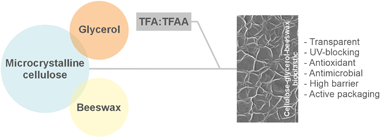
Abstract
Plasticized cellulose bioplastics with antioxidant and antimicrobial properties were prepared by blending cellulose and glycerol in a mixture of trifluoroacetic acid and trifluoroacetic anhydride, adding a solution of beeswax in chloroform, and subsequent drop-casting. Optical, chemical, structural, mechanical, thermal, and hydrodynamic properties were fully characterized. In addition, the biodegradability in seawater was investigated by determination of the biological oxygen demand. The incorporation of beeswax ruled out the transparency and UV blocking, modified the main mechanical parameters, and improved the thermal stability and the antioxidant capacity, as well as the hydrodynamic and barrier properties. In general, these features were comparable to those of common petroleum-based food packaging plastics. Such changes were explained by the incorporation of beeswax into the polymer matrix, as determined by infrared spectroscopy and X-ray diffraction. These cellulosebeeswax bioplastics were evaluated as viable food packaging materials by determination of the overall migration by using Tenax (R) as a dry food simulant, oxygen permeability at different relative humidities, measurement of antimicrobial activity against Escherichia coli and Bacillus cereus, and through preservation of fresh-cut pear slices, showing results similar to those obtained by using low-density polyethylene.
Mayo, 2025 · DOI: 10.1016/j.foodhyd.2024.110933
2024
2024
Materiales de Diseño para la Energía y Medioambiente
Enhanced extraction of bioactive compounds from tea waste for sustainable polylactide-based bioplastic applications in active food packaging
Acquavia, MA; Benítez, JJ; Guzmán-Puyo, S; Porras-Vázquez, JM; Hierrezuelo, J; Grifé-Ruiz, M; Romero, D; Di Capua, A; Bochicchio, R; Laurenza, S; Bianca, Giuliana, Heredia-Guerrero, JAFood Packaging and Shel Life, 46 (2024) 101410 DOI: 10.1016/j.fpsl.2024.101410
Abstract
Active and sustainable food packaging materials were prepared through solvent casting, by blending tea waste (TW) extract rich in bioactive molecules with a neat polylactide (PLA) polymeric matrix. The optimization of tea waste extraction using a response surface methodology allowed achieving efficient yield and high phenolic content, which significantly enhanced the antioxidant properties of the resulting bioplastics. TW extract incorporation into PLA films increased UV-blocking capability, while keeping the oxygen permeability performance. Mechanical testing revealed improved ductility and toughness in TW extract-containing films compared to pure polylactide film, ascribed to the plasticizing effect of TW polyphenols. Food packaging assays showed effective moisture retention, comparable to low-density polyethylene (LDPE) plastics, antioxidant activity, and excellent bacteria barrier properties allowing the use for food packaging applications. Moreover, migration tests and detection of non-intentionally added substances (NIAS) allowed to establish the safety and regulatory compliance of these bioplastics.
Diciembre, 2024 · DOI: 10.1016/j.fpsl.2024.101410
Materiales de Diseño para la Energía y Medioambiente
Influence of the chemical activation with KOH/KNO3 on the CO2 adsorption capacity of activated carbons from pyrolysis of cellulose
Lamata-Bermejo, I; Alba, MD; Ramírez-Rico, JJournal of Envieronmental Chemical Engineering, 12 (2024) 114288 DOI: 10.1016/j.jece.2024.114288
Abstract
Plant biomass is an attractive precursor to prepare activated carbons with high surface area for CO2 adsorption due to its low-cost and easy regeneration. Despite this interest, there are still remaining questions regarding the optimal processing conditions and the choice of activating agent. Moreover, since plant biomass shows a highly variable proportion of different biopolymers (cellulose, hemicellulose, lignin), it is important to understand the activation effect on each constituent. In this work, carbons obtained from pyrolysis of cellulose were activated using two potassium salts, using two different activation temperatures. The samples were characterized to elucidate the influence of the activation conditions on their CO2 adsorption capacity. In general, all the carbons activated at higher temperature showed higher adsorption capacity. These results are comparable with other carbons derived from biomass described in the bibliography. Among the activated carbons studied, the carbon activated only with KOH exhibits the highest CO2 adsorption capacity at 1 bar meanwhile the highest adsorption capacity at saturation pressure belongs to the carbon activated with larger ratio of KNO3.
Diciembre, 2024 · DOI: 10.1016/j.jece.2024.114288
Materiales de Diseño para la Energía y Medioambiente
Poly(Ionic) Liquid-Enhanced Ion Dynamics in Cellulose-Derived Gel Polymer Electrolytes
Paiva, TG; Klem, M; Silvestre, SL; Coelho, J; Alves, N; Fortunato, E; Cabrita, EJ; Corvo, MCChemSusChem (2024). DOI: 10.1002/cssc.202401710

Abstract
Gel polymer electrolytes (GPEs) are regarded as a promising alternative to conventional electrolytes, combining the advantages of solid and liquid electrolytes. Leveraging the abundance and eco-friendliness of cellulose-based materials, GPEs were produced using methyl cellulose and incorporating various doping agents, either an ionic liquid (1-Butyl-1-methylpyrrolidinium bis(trifluoromethylsulfonyl)imide [Pyr14][TFSI]), its polymeric ionic liquid analogue (Poly(diallyldimethylammonium bis(trifluoromethylsulfonyl)imide) [PDADMA][TFSI]), or an anionically charged backbone polymeric ionic liquid (lithium poly[(4-styrenesulfonyl)(trifluoromethyl(S-trifluoromethylsulfonylimino) sulfonyl) imide] LiP[STFSI]). The ion dynamics and molecular interactions within the GPEs were thoroughly analyzed using Attenuated Total Reflectance Fourier-Transform Infrared Spectroscopy (ATR-FTIR), Heteronuclear Overhauser Enhancement Spectroscopy (HOESY), and Pulsed-Field Gradient Nuclear Magnetic Resonance Diffusion (PFG-NMR). Li+ transference numbers (tLi+) were successfully calculated. Our study found that by combining slow-diffusing polymeric ionic liquids (PILs) with fast-diffusing lithium salt, we were able to achieve transference numbers comparable to those of liquid electrolytes, especially with the anionic PIL, LiP[STFSI]. This research highlights the influence of the polymer ' s nature on lithium-ion transport within GPEs. Additionally, micro supercapacitor (MSC) devices assembled with these GPEs exhibited capacitive behavior. These findings suggest that further optimization of GPE composition could significantly improve their performance, thereby positioning them for application in sustainable and efficient energy storage systems.
Noviembre, 2024 · DOI: 10.1002/cssc.202401710
Materiales de Diseño para la Energía y Medioambiente
Revisiting plant cuticle biophysics
Heredia, A; Benitez, JJ; Moreno, AG; Domínguez, ENew Phytologist, 244 (2024) 65-73 DOI: 10.1111/nph.20009
Abstract
The plant cuticle is located at the interface of the plant with the environment, thus acting as a protective barrier against biotic and abiotic external stress factors, and regulating water loss. Additionally, it modulates mechanical stresses derived from internal tissues and also from the environment. Recent advances in the understanding of the hydric, mechanical, thermal, and, to a lower extent, optical and electric properties of the cuticle, as well as their phenomenological connections and relationships are reviewed. An equilibrium based on the interaction among the different biophysical properties is essential to ensure plant growth and development. The notable variability reported in cuticle geometry, surface topography, and microchemistry affects the analysis of some biophysical properties of the cuticle. This review aimed to provide an updated view of the plant cuticle, understood as a modification of the cell wall, in order to establish the state-of-the-art biophysics of the plant cuticle, and to serve as an inspiration for future research in the field.
Octubre, 2024 · DOI: 10.1111/nph.20009
Materiales de Diseño para la Energía y Medioambiente
Elucidating the Mechanism of Iron-Catalyzed Graphitization: The First Observation of Homogeneous Solid-State Catalysis
Hunter, RD; Takeguchi, M; Hashimoto, A; Ridings, KM; Hendy, SC; Zakharov, D; Warnken, N; Isaacs, J; Fernández-Muñoz, S; Ramirez-Rico, J; Schnepp, ZAdvanced Materials, 36 (2024) 2404170 DOI: 10.1002/adma.202404170
Abstract
Carbon is a critical material for existing and emerging energy applications and there is considerable global effort in generating sustainable carbons. A particularly promising area is iron-catalyzed graphitization, which is the conversion of organic matter to graphitic carbon nanostructures by an iron catalyst. In this paper, it is reported that iron-catalyzed graphitization occurs via a new type of mechanism that is called homogeneous solid-state catalysis. Dark field in situ transmission electron microscopy is used to demonstrate that crystalline iron nanoparticles “burrow” through amorphous carbon to generate multiwalled graphitic nanotubes. The process is remarkably fast, particularly given the solid phase of the catalyst, and in situ synchrotron X-ray diffraction is used to demonstrate that graphitization is complete within a few minutes.
Septiembre, 2024 · DOI: 10.1002/adma.202404170
Materiales de Diseño para la Energía y Medioambiente
A zirconia/tantalum biocermet: in vitro and in vivo evaluation for biomedical implant applications
Smirnov, A; Guitián, F; Ramírez-Rico, J; Bartolomé, JFJournal of Materials Chemistry B (2024) DOI: 10.1039/d4tb01158a
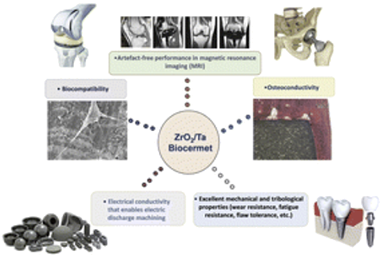
Abstract
A biocermet made of zirconia/20 vol% tantalum (3Y-TZP/Ta) is a new composite with exceptional capabilities due to a combination of properties that are rarely achieved in conventional materials (high strength and toughness, cyclic fatigue resistance and flaw tolerance, wear resistance, corrosion resistance, electrical conductivity, etc.). In this study, for the first time, the biomedical performance of a 3Y-TZP/Ta biocermet was evaluated in detail. Its in vitro biocompatibility was assessed using mesenchymal stem cell culture. The effectiveness of in vivo osteointegration of the biocermet was confirmed 6 months after implantation into the proximal tibiae of New Zealand white rabbits. In addition, the possibility of using magnetic resonance imaging (MRI) for medical analysis of the considered biocermet material was studied. The 3Y-TZP/Ta composite showed no injurious effect on cell morphology, extracellular matrix production or cell proliferation. Moreover, the implanted biocermet appeared to be capable of promoting bone growth without adverse reactions. On the other hand, this biocermet demonstrates artefact-free performance in MRI biomedical image analysis studies, making it more suitable for implant applications. These findings open up possibilities for a wide range of applications of these materials in orthopedics, dentistry and other areas such as replacement of hard tissues.
Agosto, 2024 · DOI: 10.1039/d4tb01158a
Materiales de Diseño para la Energía y Medioambiente
Direct laser writing of MnOx x decorated laser-induced graphene on paper for sustainable microsupercapacitor fabrication
Abreu, R; Klem, MD; Pinheiro, T; Pinto, JV; Alves, N; Martins, R; Carlos, E; Coelho, JFlatchem, 46 (2024) 100672 DOI: 10.1016/j.flatc.2024.100672
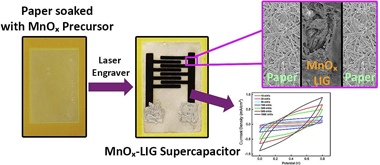
Abstract
Laser-induced graphene (LIG) on paper is a popular choice for fabricating flexible micro-supercapacitors (MSCs) as it is a simple and sustainable process. However, carbon-based MSC electrodes have limited energy densities. To address this challenge, this study presents a highly reproducible and cost-effective method for decorating manganese oxide (MnOx) x ) on interdigital LIG MSC electrodes, fabricated via a single-step direct laser writing (DLW) process on paper substrates. The paper fibers embedded with MnOx x precursors are transformed into graphene through laser processing while reducing the salt, resulting in the formation of MnOx-LIG. x-LIG. The resulting MnOx-LIG-MSC x-LIG-MSC exhibits a specific capacitance of 12.30 mF cm- 2 (0.05 mA cm- 2 ) with a 60 % retention at 1000 bending cycles (30 degrees), degrees ), due to the pseudocapacitive contribution of MnOx. x . Furthermore, the devices exhibit high electrochemical stability, retaining 190 % of the initial specific capacitance after 10,000 cycles, and a high energy density of 2.6 mu Wh cm-- 2 (at a power of 0.109 mW cm-- 2 ). The study demonstrates that manganese oxide- based LIG-MSCs have the potential to be used as energy storage devices for portable, low-cost, and flexible paper electronics.
Julio, 2024 · DOI: 10.1016/j.flatc.2024.100672
Materiales de Diseño para la Energía y Medioambiente
Transparent, plasticized cellulose-glycerol bioplastics for food packaging applications
Benítez, JJ; Florido-Moreno, P; Porras-Vazquez, JM; Tedeschi, G; Athanassiou, A; Heredia-Guerrero, JA; Guzman-Puyol, SInternational Journal of Biological Macromolecules, 273 (2024) 132956 DOI: 10.1016/j.ijbiomac.2024.132956
Abstract
Free-standing films have been obtained by drop-casting cellulose-glycerol mixtures (up to 50 wt% glycerol) dissolved in trifluoroacetic acid and trifluoroacetic anhydride (TFA:TFAA, 2:1, v:v). A comprehensive examination of the optical, structural, mechanical, thermal, hydrodynamic, barrier, migration, greaseproof, and biodegradation characteristics of the films was conducted. The resulting cellulose-glycerol blends exhibited an amorphous molecular structure and a reinforced H-bond network, as evidenced by X-ray diffraction analysis and infrared spectroscopy, respectively. The inclusion of glycerol exerted a plasticizing influence on the mechanical properties of the films, while keeping their transparency. Hydrodynamic and barrier properties were assessed through water uptake and water vapor/oxygen transmission rates, respectively, and obtained values were consistent with those of other cellulose-based materials. Furthermore, overall migration levels were below European regulation limits, as stated by using Tenax as a dry food simulant. In addition, these bioplastics demonstrated good greaseproof performance, particularly at high glycerol content, and potential as packaging materials for bakery products. Biodegradability assessments were carried out by measuring the biological oxygen demand in seawater and high biodegradation rates induced by glycerol were observed.
Junio, 2024 · DOI: 10.1016/j.ijbiomac.2024.132956
Materiales de Diseño para la Energía y Medioambiente
Materials for 3D Printed Metal and Metal-Ion Batteries
García Rodríguez, T; Medina Santos, JI; Coelho,m J; Pinilla, SChemElectroChem (2024) e202400206 DOI: 10.1002/celc.202400206
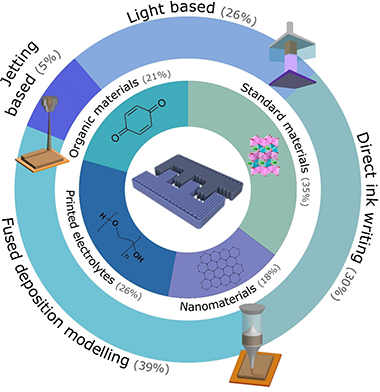
Abstract
The review provides an overview of the latest innovations, trends, and challenges in the field of 3D-printed metal and metal-ion batteries. It focuses on the materials used in the printing of batteries, including electrodes, electrolytes, and other electroactive components. Compared to other high-quality reviews on the topic, this review provides a broader selection of materials that are expected to gain attention in the next few years, such as redox-active polymers and metal-organic frameworks. This work gives an overview and insight into the latest trends in printing techniques as well as a statistical review of their uses and strengths. We have also gathered the latest works done for each of the material types, and we have taken the opportunity to put them in context and use them to exemplify in which direction is the field going. The review concludes with a critical view of the challenges ahead and a discussion of the direction that the field is taking as well as the external factors that might help to define its future.
Mayo, 2024 · DOI: 10.1002/celc.202400206
Materiales de Diseño para la Energía y Medioambiente
Green Fabrication of Stackable Laser-Induced Graphene Micro-Supercapacitors under Ambient Conditions: Toward the Design of Truly Sustainable Technological Platforms
Silvestre, SL; Morais, M; Soares, RRA; Johnson, Z; Benson, E; Ainsley, E; Pham, V; Claussen, JC; Gomes, CL; Martins, R; Fortunato, E; Pereira, L; Coelho, JAdvanced Materials Technologies, (2024) 2365709X DOI: 10.1002/admt.202400261
Abstract
Extensive research into green technologies is driven by the worldwide push for eco-friendly materials and energy solutions. The focus is on synergies that prioritize sustainability and environmental benefits. This study explores the potential of abundant, non-toxic, and sustainable resources such as paper, lignin-enriched paper, and cork for producing laser-induced graphene (LIG) supercapacitor electrodes with improved capacitance. A single-step methodology using a CO2 laser system is developed for fabricating these electrodes under ambient conditions, providing an environmentally friendly alternative to conventional carbon sources. The resulting green micro-supercapacitors (MSCs) achieve impressive areal capacitance (≈7–10 mF cm−2) and power and energy densities (≈4 μW cm-2 and ≈0.77 µWh cm−2 at 0.01 mA cm−2). Stability tests conducted over 5000 charge–discharge cycles demonstrate a capacitance retention of ≈80–85%, highlighting the device durability. These LIG-based devices offer versatility, allowing voltage output adjustment through stacked and sandwich MSCs configurations (parallel or series), suitable for various large-scale applications. This study demonstrates that it is possible to create high-quality energy storage devices based on biodegradable materials. This development can lead to progress in renewable energy and off-grid technology, as well as a reduction in electronic waste.
Mayo, 2024 · DOI: 10.1002/admt.202400261
Materiales de Diseño para la Energía y Medioambiente
Direct Laser Writing: From Materials Synthesis and Conversion to Electronic Device Processing
Pinheiro, T; Morais, M; Silvestre, S; Carlos, E; Coelho, J; Almeida, HV; Barquinha, P; Fortunato, E; Martins, RAdvanced Materials, 36 (2024) 26 DOI: 10.1002/adma.202402014
Abstract
Direct Laser Writing (DLW) has been increasingly selected as a microfabrication route for efficient, cost-effective, high-resolution material synthesis and conversion. Concurrently, lasers participate in the patterning and assembly of functional geometries in several fields of application, of which electronics stand out. In this review, recent advances and strategies based on DLW for electronics microfabrication are surveyed and outlined, based on laser material growth strategies. First, the main DLW parameters influencing material synthesis and transformation mechanisms are summarized, aimed at selective, tailored writing of conductive and semiconducting materials. Additive and transformative DLW processing mechanisms are discussed, to open space to explore several categories of materials directly synthesized or transformed for electronics microfabrication. These include metallic conductors, metal oxides, transition metal chalcogenides and carbides, laser-induced graphene, and their mixtures. By accessing a wide range of material types, DLW-based electronic applications are explored, including processing components, energy harvesting and storage, sensing, and bioelectronics. The expanded capability of lasers to participate in multiple fabrication steps at different implementation levels, from material engineering to device processing, indicates their future applicability to next-generation electronics, where more accessible, green microfabrication approaches integrate lasers as comprehensive tools.
This review covers recent progress and breakthroughs in direct laser writing for multimaterial synthesis and conversion, toward processing and fabrication of electronics. Predominant laser-material processing mechanisms for the writing of conductive and semiconductive materials are discussed, alongside important considerations on laser operation and implementation for both rigid and flexible electronics, including microelectronics, energy harvesting and storage, sensors, and bioelectronics. image
Abril, 2024 · DOI: 10.1002/adma.202402014
Materiales de Diseño para la Energía y Medioambiente
Optimising anode supported BaZr1-xYxO3-δ electrolytes for solid oxide fuel cells: Microstructure, phase evolution and residual stresses analysis
Fernández Muñoz, S; Chacartegui, R; Alba, MD; Ramírez Rico, JJournal of Power Sources, 596 (2024) 234070 DOI: 10.1016/j.jpowsour.2024.234070
Abstract
Yttrium-doped BaZrO3 is a promising electrolyte for intermediate-temperature protonic ceramic fuel cells. In the anode-supported configuration, a slurry containing the electrolyte is deposited on the surface of a calcined porous anode and sintered. Differences in sintering behaviour and thermal expansion coefficients for the anode and electrolyte result in elastic residual stresses that can impact the long-term stability of the cell during cyclic operation. Half-cells using BaZr0.8Y0.2O3-δ as the electrolyte were fabricated using the solid-state reaction sintering method under various sintering conditions. Comprehensive microstructure and residual stress analyses as a function of processing parameters were performed using two-dimensional X-ray diffraction, Rietveld refinement, and scanning electron microscopy, before and after the half-cells were reduced under hydrogen, giving a complete picture of phase, microstructure, and stress evolution under thermal and reduction cycles like the actual operation of the cell. Our results reveal that a temperature of 1400 °C and shorter soaking times might be advantageous for obtaining phase-pure and thin yttrium-doped BaZrO3 electrolytes with improved microstructure and the presence of compressive residual stress. These findings offer valuable insights into optimising the fabrication process of BaZrO3-based electrolytes, leading to enhanced performance and long-term stability of anode-supported protonic ceramic fuel cells operating at intermediate temperatures.
Marzo, 2024 · DOI: 10.1016/j.jpowsour.2024.234070
Materiales de Diseño para la Energía y Medioambiente
Revalorization of Yerba Mate Residues: Biopolymers-Based Films of Dual Wettability as Potential Mulching Materials
Sánchez, LM; De Haro, J; Domínguez, E; Rodríguez, A; Heredia, A; Benítez, JJPolymers, 16 (2024) 815 DOI: 10.3390/polym16060815
Abstract
Biodegradable mulching films are a very attractive solution to agronomical practices intended to achieve more successful crop results. And, in this context, the employment of agricultural and industrial food residues as starting material for their production is an alternative with economic and environmental advantages. This work reports the preparation of bilayer films having two different wettability characteristics from three bio-derived biopolymers: TEMPO-oxidized cellulose nanofibers isolated from infused Yerba Mate residues, Chitosan and Polylactic acid. The infused Yerba Mate residues, the isolated and oxidized cellulose nanofibers, and the films were characterized. Nanofibrillation yield, optical transmittance, cationic demand, carboxyl content, intrinsic viscosity, degree of polymerization, specific surface area and length were studied for the (ligno)cellulose nanofibers. Textural and chemical analysis, thermal and mechanical properties studies, as well as water and light interactions were included in the characterization of the films. The bilayer films are promising materials to be used as mulching films.
Marzo, 2024 · DOI: 10.3390/polym16060815
2023
2023
Materiales de Diseño para la Energía y Medioambiente
Plasticized, greaseproof chitin bioplastics with high transparency and biodegradability
Heredia-Guerrero, JA; Benitez, JJ; Porras-Vazquez, JM; Tedeschi, G; Morales, Y; Fernandez-Ortuno, D; Athanassiou, A; Guzman-Puyol, SFood Hydrocolloids, 145 (2023) 109072 DOI: 10.1016/j.foodhyd.2023.109072
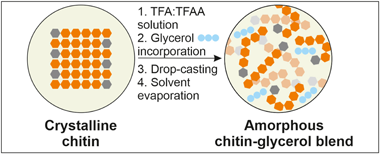
Abstract
A mixture of trifluoroacetic acid:trifluoroacetic anhydride (TFA:TFAA) was used to dissolve chitin from shrimp shells. Free-standing films were prepared by blending the chitin solution and glycerol at different percentages, followed by drop-casting, and the complete evaporation of the solvents. After this process, the chitin matrix showed an amorphous molecular structure, as determined by X-ray diffraction. Optical, mechanical, thermal, and antioxidant properties were also thoroughly investigated. The incorporation of glycerol induced a plasticizing effect on the mechanical response of films and improved their transparency. In addition, hydrodynamic and barrier properties were determined by contact angle and water vapor/oxygen transmission rates, respectively, and revealed typical values of other polysaccharides. These bioplastics also presented an excellent greaseproof behavior with the highest degree of oil repellency as determined by the Kit test. Moreover, the overall migration was evaluated by using Tenax & REG; as a dry food simulant and levels were compliant with European regulations. Their antifungal properties were tested using Botrytis cinerea as a model. Biodegradability was also determined by measuring the biological oxygen demand in seawater. Degradation rates were high and similar to those of other fully-degradable materials.
Diciembre, 2023 · DOI: 10.1016/j.foodhyd.2023.109072
Materiales de Diseño para la Energía y Medioambiente
Incorporation of bioactive compounds from avocado by-products to ethyl cellulose-reinforced paper for food packaging applications
Acquavia, MA; Benitez, JEJ; Bianco, G; Crescenzi, MA; Hierrezuelo, J; Grife-Ruiz, M; Romero, D; Guzman-Puyol, S; Heredia-Guerrero, JAFood Chemistry, 429 (2023) 136906 DOI: 10.1016/j.foodchem.2023.136906
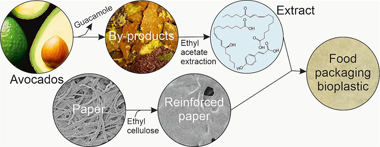
Abstract
Reinforced films were fabricated by impregnating paper in ethyl cellulose solutions. After solvent evaporation, the infused ethyl cellulose acted as binder of the paper microfibres and occupied the pores and cavities, thus improving the mechanical and barrier properties. To prepare active films, avocado by-products from guacamole industrial production were extracted in ethyl acetate. Then, the extract (optimized to be rich in phenolic compounds and flavonoids and mainly composed by lipids) was incorporated to the paper reinforced with the highest content of ethyl cellulose. In general, the addition of the avocado by-products extract decreased the water uptake and permeability, improved the wettability, and increased the biodegradability in seawater and the antioxidant capacity. In addition, these films acted as barriers and retainers for Escherichia coli and Bacillus cereus. The potentiality of these materials for food packaging was demonstrated by low overall migrations and a similar food preservation to common low-density polyethylene.
Diciembre, 2023 · DOI: 10.1016/j.foodchem.2023.136906
Materiales de Diseño para la Energía y Medioambiente
A technological approach based on engineered nanoclay composites for cesium and iodine retention
Osuna, FJ; Pavon, E; Alba, MDChesmosphere, 341 (2023) 140128 DOI: 10.1016/j.chemosphere.2023.140128
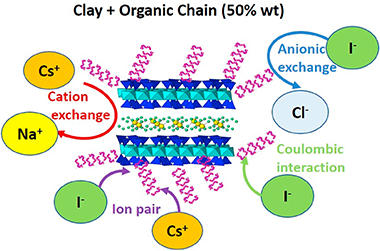
Abstract
The development of effective and environmentally friendly methods for separating hazardous radionuclides from waste poses a significant technological challenge. 137Cs and 131I are among the most important radionuclides discharged into the environment by nuclear power plants. One of the best ways to eliminate them involves adsorption on clay minerals. In this regard, studies have demonstrated that organofunctionalized clay minerals are effective adsorbents. Thus, this study investigates the capability of organofunctionalized synthetic design clay minerals to jointly eliminate cesium and iodine. The adsorbents studied are a range of organofunctionalized clay minerals with alkylammonium cations of different alkyl chain lengths (2, 3 and 18) and some physical mixtures of raw clay minerals and octadecylammonium compounds. Organofunctionalized synthetic swelling highly charged micas are effective adsorbents for the simultaneous adsorption of cesium and iodine. In addition, the optimal system is a mixture of Na-M4 with octadecylammonium (50% w/w).
Noviembre, 2023 · DOI: 10.1016/j.chemosphere.2023.140128
Materiales de Diseño para la Energía y Medioambiente
Mechanical treatments on design powder ceramic materials: Insight into the textural and structural changes
Osuna, FJ; Fernández, M; Pavón, E; Sánchez, RMT; Alba, MDAdvanced Powder Technology, 34 (2023) 104189 DOI: 10.1016/j.apt.2023.104189
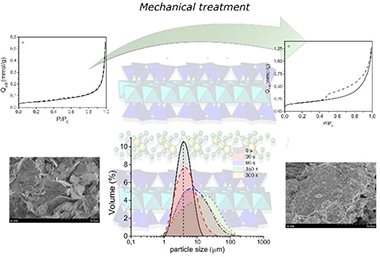
Abstract
Mechanical treatment of porous ceramics, such as porous clay minerals, is a crucial step in ceramic processing. Among clay minerals, design swelling brittle micas have shown exceptional properties for further applications, although they exhibit low surface area and porosity. But, their mechanical activation could improve their textural properties and deserves to be investigated. Thus, the aim of this work was to evaluate the effects of gradual grinding in their surface and framework. At short grinding times, the surface area increases and mesoporous and microporous are generated. Long grinding time provokes particle agglomeration with the consequent change in their colloidal stability. At bulk level, framework defects are observed in both tetrahedral and octahedral sheets and increase with the total layer charge.
Octubre, 2023 · DOI: 10.1016/j.apt.2023.104189
Materiales de Diseño para la Energía y Medioambiente
Sustainable Integration of Zinc Oxide Nanoparticles: Enhancing Properties of Poly(ε-Caprolactone) Electrospun Nanofibers and Cast Films
Abdullah, JAA; Benítez, JJ; Guerrero, A; Romero, ACoatings, 13 (2023) 1665 DOI: 10.3390/coatings13101665
Abstract
This study investigated the impact of adding zinc oxide nanoparticles (ZnO-NPs) to electrospun membranes and cast films made of poly(epsilon-caprolactone) (PCL). The physicochemical, mechanical, and morphological properties of the samples were analyzed. Physicochemical parameters included water contact angle (WCA), water vapor transmission rate (WVTR), permeance, water vapor permeability (WVP), light transmission (T-600), and transparency (T). Mechanical properties, such as maximum stress (6(max)), elongation (epsilon(max)), and Young's modulus (MPa), were also evaluated. Morphological properties were analyzed in terms of thickness, dispersion, and surface roughness (measured by the arithmetic (Ra) and quadratic (Rq) averages). The crystallinity and melting point, as well as the functional DPPH center dot scavenging percentage (SP%), were also studied. The results showed that adding 1 wt% ZnO-NPs improved the water barrier properties of PCL membranes and films, increasing WCA by 1%-6% and decreasing WVTR by 11%-19%, permeance by 34%-20%, and WVP by 4%-11%, respectively. The T-600 values of PCL/ZnO-NPs membranes and films were 2-3 times lower than those of neat PCL samples, indicating improved optical properties. The mechanical properties of the composite membranes and films also improved, with 6(max) increasing by 56%-32% and Young's modulus increasing by 91%-95%, while epsilon(max) decreased by 79%-57%. The incorporation of ZnO-NPs also increased the thickness and surface roughness of the samples. The SP% of PCL/ZnO-NPs increased by almost 69%, demonstrating the beneficial effects of ZnO-NPs on the system. These findings suggest that incorporating ZnO-NPs into PCL membranes and films can enhance their properties, making them well suited for various applications, such as those within the realm of materials science and nanotechnology.
Octubre, 2023 · DOI: 10.3390/coatings13101665
Materiales de Diseño para la Energía y Medioambiente
Biodegradability Assessment of Prickly Pear Waste-Polymer Fibers under Soil Composting
Correa-Pacheco, ZN; Bautista-Baños, S; Benítez-Jiménez, JJ; Ortega-Gudiño, P; Cisneros-López, EO; Hernández-López, MPolymers, 15 (2023) 4164 DOI: 10.3390/polym15204164
Abstract
Nowadays, solving the problems associated with environmental pollution is of special interest. Therefore, in this work, the morphology and thermal and mechanical properties of extruded fibers based on polylactic acid (PLA) and poly(butylene adipate-co-terephthalate) (PBAT) added to prickly pear flour (PPF) under composting for 3 and 6 months were evaluated. The highest weight loss percentage (92 +/- 7%) was obtained after 6-month degradation of the PLA/PBAT/PPF/CO/AA blend, in which PPF, canola oil (CO), and adipic acid (AA) were added. Optical and scanning electron microscopy (SEM) revealed structural changes in the fibers as composting time increased. The main changes in the absorption bands observed by Fourier transform infrared spectroscopy (FTIR) were related to the decrease in -C=O (1740 cm-1) and -C-O (1100 cm-1) groups and at 1269 cm-1, associated with hemicellulose in the blends with PPF. Differential scanning calorimetry (DSC) showed an increase in the cold crystallization and melting point with degradation time, being more evident in the fibers with PPF, as well as a decrease in the mechanical properties, especially Young's modulus. The obtained results suggest that PPF residues could promote the biodegradability of PLA/PBAT-based fiber composites.
Octubre, 2023 · DOI: 10.3390/polym15204164
Materiales de Diseño para la Energía y Medioambiente
The Role of Protective Surface Coatings on the Thermal Stability of Delithiated Ni-Rich Layered Oxide Cathode Materials
Reissig, F; Ramirez-Rico, J; Placke, TJ; Winter, M; Schmuch, R; Gomez-Martin, ABatteries-Basel, 9 (2023) 245 DOI: 10.3390/batteries9050245
Abstract
To achieve a broader public acceptance for electric vehicles based on lithium-ion battery (LIB) technology, long driving ranges, low cost, and high safety are needed. A promising pathway to address these key parameters lies in the further improvement of Ni-rich cathode materials for LIB cells. Despite the higher achieved capacities and thus energy densities, there are major drawbacks in terms of capacity retention and thermal stability (of the charged cathode) which are crucial for customer acceptance and can be mitigated by protecting cathode particles. We studied the impact of surface modifications on cycle life and thermal stability of LiNi0.90Co0.05Mn0.05O2 layered oxide cathodes with WO3 by a simple sol-gel coating process. Several advanced analytical techniques such as low-energy ion scattering, differential scanning calorimetry, and high-temperature synchrotron X-ray powder diffraction of delithiated cathode materials, as well as charge/discharge cycling give significant insights into the impact of surface coverage of the coatings on mitigating degradation mechanisms. The results show that successful surface modifications of WO3 with a surface coverage of only 20% can prolong the cycle life of an LIB cell and play a crucial role in improving the thermal stability and, hence, the safety of LIBs.
Abril, 2023 · DOI: 10.3390/batteries9050245
Materiales de Diseño para la Energía y Medioambiente
Effect of Mo and W interlayers on microstructure and mechanical properties of Si3N4-nickel-base superalloy joints
Singh, M; Fernandez, JM; Asthana, R; Ramirez-Rico, J; Valera-Feria, FMInternational Journal of Applied Ceramic Technology, 20(2) (2023) 987-994 DOI: 10.1111/ijac.14266
Abstract
Si3N4/nickel-base superalloy (Inconel-625) and Si3N4/Si3N4 joints with refractory metal (W and Mo) interlayers were vacuum brazed using a Ti-active braze Cu-ABA (92.75Cu-3Si-2Al-2.25Ti) at 1317 K for 30 min with the following interlayered arrangements: Si3N4/Mo/W/Inconel and Si3N4/Mo/W/Si3N4. The joints exhibited Ti segregation at the Si3N4/Cu-ABA interface, elemental interdiffusion across the joint interfaces, and sound metallurgical bonding. Knoop microhardness profiles revealed hardness gradients across the joints that mimicked the interlayered arrangement. The compressive shear strength of Si3N4/Si3N4 joints both with and without W and Mo layers was similar to 142 MPa but the strength of Si3N4/Inconel joints increased from similar to 9 MPa for directly bonded joints without interlayers to 53.5 MPa for joints with Mo and W interlayers.
Marzo, 2023 · DOI: 10.1111/ijac.14266
Materiales y Procesos Catalíticos de Interés Ambiental y Energético
Revealing the Impact of Different Iron-Based Precursors on the ‘Catalytic’ Graphitization for Synthesis of Anode Materials for Lithium Ion Batteries
Frankenstein, L; Glomb, P; Ramirez-Rico, J; Winter, M; Placke, T; Gomez-Martin, AChemelectrochem, 10 (2023) e202201073 DOI: 10.1002/celc.202201073

Abstract
Low cost and environmentally friendly production of graphite anodes from naturally available biomass resources is of great importance to satisfy the increasing material demand for lithium ion batteries. Herein, graphitization of coffee ground was performed using four different iron-based activating additives, including iron (III) chloride, iron (III) nitrate, iron (III) oxide and pure iron, following either a wet or a dry mixing approach. The structural development regarding the type of activator used and the impact on the corresponding electrochemical performance are systematically investigated. A maximum degree of graphitization between 55 and 74 % (as determined by Raman spectroscopy) is attained using iron (III) chloride and iron powder, respectively. The graphitic anode material synthesized using iron powder reached a maximum reversible capacity of approximate to 320 mAh g(-1) at a rate of 0.1 C. This study provides significant insights into the impact of activators on the design of synthetic graphite from renewable sources.
Marzo, 2023 · DOI: 10.1002/celc.202201073
Materiales de Diseño para la Energía y Medioambiente
Improved stability of design clay minerals at high temperature: A comparison study with natural ones
Osuna, FJ; Chaparro, JR; Pavon, E; Alba, MDCeramics International, 49 (2023) 5279-5291 DOI: 10.1016/j.ceramint.2022.10.046
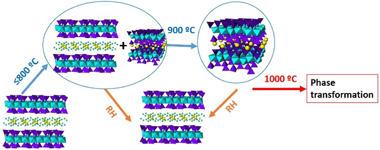
Abstract
Clay minerals are ceramics materials that are involved in a wide range of economic uses. But, their structure and composition are modified by heating and, consequently, compromise their final applications. The actual tem-peratures at which changes occur vary greatly from one group to another group and even for different specimens within a given group. The aim of this research has been to evaluate the thermal behaviour of a set of design swelling micas, Na-Mica -n (Mn) and compare them with a set of natural smectites. All samples were heated in the range 200 degrees C to 1000 degrees C; afterwards, they were rehydrated thorough water suspension (0.4% wt). The results have shown that swelling micas have better property of hydration/dehydration than natural clay minerals and those with higher layer charge exhibited higher rehydration ability and dehydration temperature.
Febrero, 2023 · DOI: 10.1016/j.ceramint.2022.10.046
Materiales de Diseño para la Energía y Medioambiente
Bio-based lacquers from industrially processed tomato pomace for sustainable metal food packaging
Benitez, JJ; Ramirez-Pozo, MC; Duran-Barrantes, MM; Heredia, A; Tedeschi, G; Ceseracciu, L; Guzman-Puyol, S; Marrero-López, D; Becci, A; Amato, A; Heredia-Guerrero, JAJournal of Cleaner Production, 386 (2023) 1356836 DOI: 10.1016/j.jclepro.2022.135836

Abstract
Bio-based lacquers prepared from an underutilized tomato processing residue such as pomace have been investigated as sustainable alternatives to bisphenol A (BPA)-based coatings for metal food packaging. The fabrication methodology consisted of a two-step process: spray-coating of a paste of the lipid fraction of tomato pomace with a mixture ethanol:H2O (3:1, v:v) on common metal substrates, used for food canning, such as aluminum (Al), chromium-coated tin-free steel (TFS), and electrochemically tin-plated steel (ETP), followed by the self melt-polycondensation of such lipid fraction. The polymerization reaction was conducted at 200 degrees C for different times (10, 20, 30, 40, 50, and 60 min) and was monitored by specular infrared spectroscopy, resulting in maximum degrees of esterification of-92% for Al and-85% for TFS and ETP substrates. The anticorrosion performance of the coatings was studied by electrochemical impedance spectroscopy at different immersion times (time intervals of 2-5 h during an overall stability test up to 170 h) in an aqueous solution of 1 wt% NaCl. The degree of polymerization and the physical properties of the coatings showed a strong dependence on the metal substrate used. In general, the best results were found for tomato pomace-based lacquers applied on aluminum, achieving higher mechanical strength (critical load of 1739 +/- 198 mN for Al, 1078 +/- 31 mN for ETP, and 852 +/- 206 mN for TFS), hydrophobicity (water contact angle-95 degrees for Al,-91 degrees for ETP, and-88 degrees for TFS), and improved anticorrosion performance (coating resistance of 0.7 M omega cm2 after 170 h of immersion for Al, 0.7 M omega cm2 after 70 h of immersion for TFS, and negligible coating resistance for ETP). In view of the technical innovation proposed in the present paper, the estimation of the environmental sustainability of the process has been considered relevant to fit the circular economy target. For this purpose, a life cycle analysis (LCA) was applied to the overall process, revealing multiple advantages for both the environment and human health.
Febrero, 2023 · DOI: 10.1016/j.jclepro.2022.135836
2022
2022
Materiales de Diseño para la Energía y Medioambiente
Biopolymer-Based Films Reinforced with FexOy-Nanoparticles
Abdullah, JAA; Jimenez-Rosado, M; Benitez, JJ; Guerrero, A; Romero, APolymers, 14 (2022) 4487 DOI: 10.3390/polym14214487
Abstract
Nowadays, natural polymer-based films are considered potentially environmentally friendly alternatives to conventional plastic films, due to many advantageous properties, including their easy processability, high flexibility, non-toxicity, low cost, high availability, and environmental safety. However, they are limited in their application by a number of shortcomings, including their high water solubility and vapor permeability as well as their poor opacity and low mechanical resistance. Thus, nanoparticles, such as green FexOy-NPs, can be used to overcome the drawbacks associated with these materials. Therefore, the aim of this study was to develop three different polymer-based films (gelatin-based, cellulose acetate-based and chitosan-based films) containing green synthesized FexOy-NPs (1.0% w/w of the initial polymer weight) as an additive to improve film properties. This was accomplished by preparing the different films using the casting method and examining their physicochemical, mechanical, microstructural, and functional characteristics. The results show that the incorporation of FexOy-NPs into the different films significantly enhanced their physicochemical, mechanical, and morphological properties as well as their antioxidant characteristics. Consequently, it was possible to produce suitable natural polymer-based films with potential applications across a wide range of industries, including functional packaging for food, antioxidants, and antimicrobial additives for pharmaceutical and biomedical materials as well as pesticides for agriculture.
Noviembre, 2022 · DOI: 10.3390/polym14214487
Materiales de Diseño para la Energía y Medioambiente
Exploring the local environment of the engineered nanoclay Mica-4 under hydrothermal conditions using Eu(3+)as a luminescent probe
Martin-Rodriguez, R; Aguado, F; Alba, MD; Valiente, R; Pavon, E; Perdigon, ACJournal of Alloys and Compounds, 921 (2022) 166086 DOI: 10.1016/j.jallcom.2022.166086
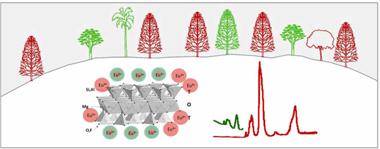
Abstract
High charge mica Na4Al4Si4Mg6O20F4 , Mica-4, is a promising candidate as a filling material to immobilize high-level radioactive waste in deep geological repositories due to its extraordinary adsorption capacity. In contrast to traditional clay materials, the structural composition of this mica, with a high content of alu-minum in the tetrahedral sheet, enhances its chemical reactivity, favoring the formation of new crystalline phases under mild hydrothermal conditions, and thus providing a definitive isolation of the radionuclides in the engineered barrier. Moreover, this synthetic clay has some features that allow its use as an optical sensor by doping with luminescent rare earth cations such as Eu3+. In this paper we discuss the local structure of the nanoclay Mica-4 using Eu3+ as a local probe to track the physical and chemical modifica-tions under hydrothermal conditions. For that purpose, a set of hydrothermal experiments has been carried out heating Mica-4 and an aqueous Eu(NO3)(3) solution in a stainless steel reactor at different temperatures and times. Optical properties of the as-treated samples were characterized by spectroscopic measurements. The fine peak structure of emission and the relative intensity of different Eu3+ transitions as well as the luminescence lifetime have been correlated with the structure and composition of this nanoclay, and the interaction mechanisms between the lanthanide ions and the clay mineral at different temperatures and times. Special attention has been paid to understanding the role of the aluminum content, which may act as either an aggregating or dispersing agent, in the optical features and reactivity of the system.
Noviembre, 2022 · DOI: 10.1016/j.jallcom.2022.166086
Materiales de Diseño para la Energía y Medioambiente
Transparency of polymeric food packaging materials
Guzman-Puyol, Susana; Benitez, Jose J; Heredia-Guerrero, Jose AFood Research International, 161 (2022) 111792 DOI: 10.1016/j.foodres.2022.111792
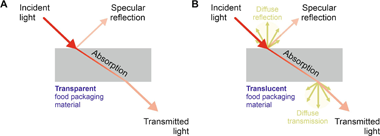
Abstract
Transparency is a very important technical parameter to evaluate and validate certain food packaging materials. In the recent scientific literature, several methods (i.e. transmittance, opacity, haze, and absorbance) have been used and such variety hinders a direct comparison of results from different authors. In this Review, we describe and discuss the most widely employed methods to measure transparency, with special emphasis on two main parameters: transmittance and opacity. Moreover, a comparison of the different techniques is addressed and the typical values of transmittance and opacity of common transparent food packaging materials are provided. Our current opinion is that transparency should be expressed as transmittance in the visible range due to both the quickness and easiness of the measurement and the standardization of data. This information should be accompanied by the thickness value and a graphical image of the analysed samples for a useful and complete characterization.
Noviembre, 2022 · DOI: 10.1016/j.foodres.2022.111792
Materiales de Diseño para la Energía y Medioambiente
Insights into the Impact of Activators on the 'Catalytic' Graphitization to Design Anode Materials for Lithium Ion Batteries
Hanhart, V; Frankenstein, L; Ramirez-Rico, J; Diozios, V; Winter, M; Gomez-Martin, A; Placke, TChemelectrochem, 9 (2022) e202200819 DOI: 10.1002/celc.202200819
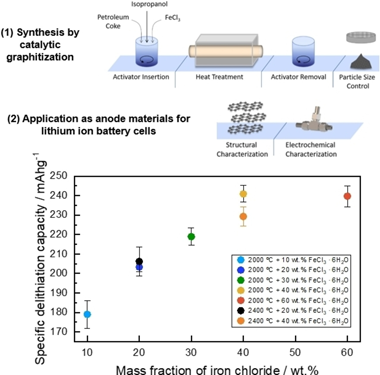
Abstract
In this work, we systematically investigate the 'catalytic' graphitization of a biomass precursor (coffee ground) using 10-60 wt.% of the activator iron (III) chloride hexahydrate in a temperature range of 1000 degrees C-2400 degrees C. Special focus is put on the correlation of synthesis conditions, e.g., heat treatment temperature and mass fraction of iron chloride, with the electrochemical performance in carbon vertical bar vertical bar Li metal cells. The structural investigations of the materials reveal a positive impact of an increasing heat treatment temperature and/or mass fraction of inserted activator on the degree of graphitization and the delithiation capacity. However, a saturation point regarding the maximum degree of graphitization at 2000 degrees C and reversible capacity by the 'catalytic' graphitization approach using iron (III) chloride has been found. A maximum degree of graphitization of approximate to 69% could be reached by applying 2000 degrees C and 40 wt.% FeCl3 center dot 6H(2)O, resulting in a reversible capacity of 235 mAh g(-1).
Noviembre, 2022 · DOI: 10.1002/celc.202200819
Materiales de Diseño para la Energía y Medioambiente
Flame confinement in biomass combustion systems for particles abatement
Ciria, D; Orihuela, MP; Moreno-Naranjo, P; Chacartegui, R; Ramirez-Rico, J; Becerra, JAEnergy Conversion and Management, 264 (2022) 115706 DOI: 10.1016/j.enconman.2022.115706
Abstract
This work explores the use of open-pore, inert ceramic foams with different pore sizes as particle abatement systems in small biomass combustion systems. Porous foams made of silicon carbide with pore sizes 10 to 60 pores-per-inch were installed in an in-house designed combustion unit operated with wood pellets. Their effects on the temperature distribution inside the chamber, particulate and gases emissions were studied using different airflow rates in the reaction-limited regime (low equivalence ratio) to minimise stoichiometric factors. The influence of pore size, foam position with respect to the flame and space velocity were assessed. The confinement of the flame with inert foams was found to substantially modify the temperature distribution in the combustion chamber, improve the air-fuel mixture, and favour the thermal decomposition of the pellet, leading to a reduction in particulate emissions when compared to free-flame combustion at the same experimental conditions. In general, the amount of particulate matter was found to decrease by up to one order of magnitude as the pore size of the foam was reduced, while the temperature gradient in the combustion chamber was increased. Nitrogen oxides and carbon dioxide emissions were essentially unchanged, irrespectively of the pore size of the foam. It is expected that these values will be improved with longer residence times, as happens in operations with reduced excess air ratios. These results suggest that it is possible to control pollutants derived from domestic heating within the most restrictive current regulations on particulate emissions by integrating flame confinement designs with better operating practices and efficient abatement systems.
Julio, 2022 · DOI: 10.1016/j.enconman.2022.115706
Materiales de Diseño para la Energía y Medioambiente
Greaseproof, hydrophobic, and biodegradable food packaging bioplastics from C6-fluorinated cellulose esters
Guzman-Puyol, S; Tedeschi, G; Goldoni, L; Benitez, JJ; Ceseracciu, L; Koschella, A; Heinze, T; Athanassiou, A; Heredia-Guerrera, JAFood Hydrocolloids, 128 (2022) 107562 DOI: 10.1016/j.foodhyd.2022.107562
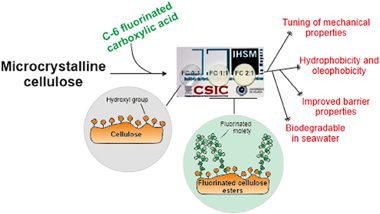
Abstract
Tridecafluorononanoic acid (TFNA), a C6-fluorinated carboxylic acid, was esterified with cellulose at different molar ratios (0:1, 1:1, 2:1, and 3:1) in a trifluoroacetic acid (TFA):trifluoroacetic anhydride (TFAA):CHCl3 (2:1:1, v:v:v) solvent mixture. Free-standing films were obtained for all formulations and are presented as alternatives to composites and blends of paper with fluorinated molecules. Mechanical properties were investigated by tensile tests, and a plasticizer effect of fluorinated chains was observed. Interestingly, the wettability of these new cellulose derivatives was similar or even better than other common cellulose derivatives and fluorinated poly-mers employed in food packaging. Hydrodynamic properties were also improved by addition of TFNA, resulting in materials with water vapor permeability values comparable to other cellulose-based food packaging materials. In addition, films with the higher amounts of TFNA showed the required oil resistance for papers used in food packaging applications, as determined by the Kit Test. Finally, the biodegradation of these C6-fluorinated cel-lulose esters, assessed by biological oxygen demand (BOD) in seawater, was higher than typical bio-based polymers used in food packaging. The bioplastic synthesized at a molar ratio 1:1 (TFNA:cellulose) showed excellent performances in terms of greaseproof, hydrophobicity, ductility, and biodegradability, representing a sustainable alternative to typical plastics used in food packaging.
Julio, 2022 · DOI: 10.1016/j.foodhyd.2022.107562
Materiales de Diseño para la Energía y Medioambiente
High temperature mechanical properties of polycrystalline Y2SiO5
Cabezas-Rodríguez, R; Ciria, D; Martínez-Fernandez, J; Dezanneau, G; Karolak, F; Ramirez-Rico, JBoletin de la Sociedad Española de Ceramica y Vidrio, 61 (2022) S60-S68-228 DOI: 10.1016/j.bsecv.2021.09.008
Abstract
The high temperature mechanical properties of polycrystalline Y2SiO5 were studied in compression at temperatures in the range of 1200-1400 degrees C, both in constant strain rate and constant stress experiments. To examine the effect of grain size on the plastic deformation, two routes were used for the synthesis and sintering of Y2SiO5: one of solid state reaction followed by conventional sintering in air, and one of sol-gel synthesis followed by spark-plasma sintering, resulting in starting grain sizes of 2.2 and 0.9 mu m, respectively. Ceramics obtained by these routes exhibited different high-temperature compression behavior: while the conventionally processed ceramic exhibited grain growth during mechanical testing and a stress exponent close to one, compatible with diffusional creep, the spark-plasma sintered ceramic showed no grain growth but significant cavitation, a stress exponent close to two and partially superplastic behavior. These results have implications for the design and lifetime assessment of rare earth silicate-based environmental barrier coatings.
Mayo, 2022 · DOI: 10.1016/j.bsecv.2021.09.008
Materiales de Diseño para la Energía y Medioambiente
Transparent, UV-blocking, and high barrier cellulose-based bioplastics with naringin as active food packaging materials
Guzman-Puyol, S; Hierrezuelo, J; Benitez, JJ; Tedeschi, G; Porras-Vazquez, JM; Heredia, A; Athanassiou, A; Romero, D; Heredia-Guerrero, JAInternational Journal of Biological Macromolecules, 209 (2022) 1985-1994 DOI: 10.1016/j.ijbiomac.2022.04.177
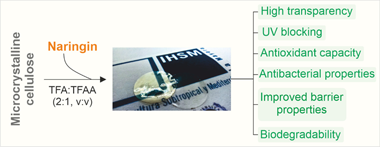
Abstract
Free-standing, robust, and transparent bioplastics were obtained by blending cellulose and naringin at different proportions. Optical, thermal, mechanical, antioxidant, and antimicrobial properties were systematically investigated. In general, the incorporation of naringin produced important UV blocking and plasticizer effects and good antioxidant and antibacterial properties. Moreover, the barrier properties were characterized by determination of their water and oxygen transmission rates, finding that both parameters decreased by increasing the naringin content and reaching values similar to other petroleum-based plastics and cellulose derivatives used for food packaging applications. Finally, the biodegradability of these films was determined by measurement of the biological oxygen demand (BOD) in seawater, demonstrating an excellent decomposition in such conditions.
Mayo, 2022 · DOI: 10.1016/j.ijbiomac.2022.04.177
Materiales de Diseño para la Energía y Medioambiente
Insight into the role of temperature, time and pH in the effective zirconium retention using clay minerals
Pavon, E; Alba, MDJournal of Environmental Chemical Engineering, 308 (2022) 114635 DOI: 10.1016/j.jenvman.2022.114635
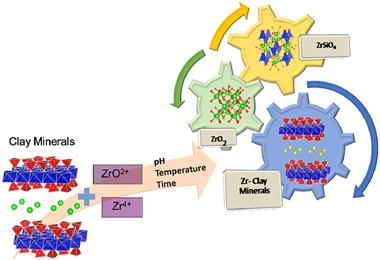
Abstract
The use of zirconium in chemical industries generates a potential risk of Zr contamination in the environment, with particular concern for the decommissioning of uranium-graphite reactors. Among the natural adsorbents employed for the treatment of nuclear waste, clay minerals showed a very high affinity adsorption for radionuclides, but the influence of the chemical composition, pressure, temperature and time reaction have not yet been analysed on deep. Thus, the objective of this research is to explore several experimental conditions for an actual prediction of the behaviour of zirconium immobilization by clay minerals. The results have shown that factors such as zirconium cation nature (Zr4+ or ZrO2+), temperature, time and pH influence the extent of zirconium immobilization by clay minerals and the zirconium phases generated. At moderate conditions, zirconium tectosilicates are formed and evolve to zircon at high temperature and a longer time reaction.
Abril, 2022 · DOI: 10.1016/j.jenvman.2022.114635
Materiales de Diseño para la Energía y Medioambiente
Structural analysis of mixed alpha- and beta-amyrin samples
Gomez-Pulido, LDM; Gonzalez-Cano, RC; Benitez, JJ; Dominguez, E; Heredia, ARoyal Society Open Science, 9 (2022) 211787 DOI: 10.1098/rsos.211787
Abstract
Little is known about the structure and molecular arrangement of alpha- and beta-amyrin, a class of triterpenoids found within the cuticle of higher plants. Blends of both amyrin isomers with different ratios have been studied taking into consideration a combined methodology of density functional theory (DFT) calculations with experimental data from scanning electron microscopy, differential scanning calorimetry and Raman vibrational spectroscopy. Results indicate that trigonal trimeric aggregations of isomer mixtures are more stable, especially in the 1 : 2 (alpha : beta) ratio. A combination of Raman spectroscopy and DFT calculations has allowed to develop an equation to determine the amount of beta-amyrin in a mixed sample.
Abril, 2022 · DOI: 10.1098/rsos.211787
Materiales de Diseño para la Energía y Medioambiente
Strength and thermal shock resistance of fiber-bonded Si-Al-C-O and Si-Ti-C-O ceramics
Vera, MC; Martinez-Fernandez, J; Singh, M; Ramirez-Rico, JInternational Journal of Applied Ceramic Technology, 19 (2022) 1126-1135 DOI: 10.1111/ijac.13928
Abstract
Silicon carbide-based fiber-bonded ceramics, obtained from hot pressing of woven silicon carbide fibers, are a cost-effective alternative to ceramic-matrix composites due to their ease of fabrication, involving few processing steps, and competitive thermomechanical properties. In this work, we studied the high-temperature strength and thermal shock resistance of Si-Al-C-O and Si-Ti-C-O fiber-bonded SiC ceramics obtained from hot pressing of two types of ceramic fibers, by mechanical testing in four-point bending. The bending strength of Si-Al-C-O-based fiber-bonded ceramics at room temperature is similar to 250-260 MPa and remains constant with temperature, while the bending strength of Si-Ti-C-O increases slightly from the initial 220 to similar to 250 MPa for the highest temperature. Both materials retain up to 90% of their room temperature strength after thermal shocks of 1400 degrees C and show no reduction in elastic moduli. After thermal shock, failure mode is the same as in the case of as-received materials.
Marzo, 2022 · DOI: 10.1111/ijac.13928
Materiales de Diseño para la Energía y Medioambiente
Iron-catalyzed graphitization for the synthesis of nanostructured graphitic carbons
Hunter, RD; Ramirez-Rico, J; Schnepp, ZJournal of Materials Chemistry A, 10 (2022) 4489-4516 DOI: 10.1039/d1ta09654k
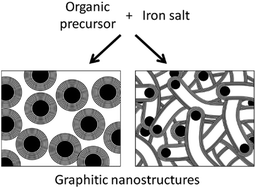
Abstract
Carbons are versatile and diverse materials that have numerous applications across energy and environmental sciences. Carbons with a graphitic structure are particularly appealing due to their high chemical stability, large surface areas and high thermal and electronic conductivity. Numerous methods exist to produce nanostructured graphitic carbons but some of these can be energy-intensive and/or have problems with scalability. One option that is being increasingly explored is the process of iron-catalyzed graphitization. This simply involves the pyrolysis of carbon-rich precursors in the presence of an iron catalyst and has been used to produce carbons with a wide range of structures and properties. This review will examine the current field of iron-catalyzed graphitization, with a focus on molecular organic or biomass precursors. Bio-derived precursors are particularly attractive as a potential option for sustainable production of graphitic carbons. We start with a brief introduction to some key carbon structures, the current applications in which they are employed and some of the key methods that have been developed to produce nanostructured graphitic carbons. We will then review the history of catalytic graphitization before evaluating the wide range of conditions and precursors that have been employed in catalytic graphitization. Finally, this review will investigate the current challenges facing iron-catalyzed graphitization, looking particularly at the limitations of the current understanding of the mechanistic aspects of graphitization, with a view to outlining where research in this field might progress.
Febrero, 2022 · DOI: 10.1039/d1ta09654k
Materiales de Diseño para la Energía y Medioambiente
The Response of Tomato Fruit Cuticle Membranes Against Heat and Light
Benitez, JJ; Moreno, AG; Guzman-Puyol, S; Heredia-Guerrero, JA; Heredia, A; Dominguez, EFrontiers in Plant Science, 12 (2022) 807723 DOI: 10.3389/fpls.2021.807723
Abstract
Two important biophysical properties, the thermal and UV-Vis screening capacity, of isolated tomato fruit cuticle membranes (CM) have been studied by differential scanning calorimetry (DSC) and UV-Vis spectrometry, respectively. A first order melting, corresponding to waxes, and a second order glass transition (T-g) thermal events have been observed. The glass transition was less defined and displaced toward higher temperatures along the fruit ripening. In immature and mature green fruits, the CM was always in the viscous and more fluid state but, in ripe fruits, daily and seasonal temperature fluctuations may cause the transition between the glassy and viscous states altering the mass transfer between the epidermal plant cells and the environment. CM dewaxing reduced the T-g value, as derived from the role of waxes as fillers. T-g reduction was more intense after polysaccharide removal due to their highly interwoven distribution within the cutin matrix that restricts the chain mobility. Such effect was amplified by the presence of phenolic compounds in ripe cuticle membranes. The structural rigidity induced by phenolics in tomato CMs was directly reflected in their mechanical elastic modulus. The heat capacity (Cp-rev) of cuticle membranes was found to depend on the developmental stage of the fruits and was higher in immature and green stages. The average Cp-rev value was above the one of air, which confers heat regulation capacity to CM. Cuticle membranes screened the UV-B light by 99% irrespectively the developmental stage of the fruit. As intra and epicuticular waxes contributed very little to the UV screening, this protection capacity is attributed to the absorption by cinnamic acid derivatives. However, the blocking capacity toward UV-A is mainly due to the CM thickness increment during growth and to the absorption by flavone chalconaringenin accumulated during ripening. The build-up of phenolic compounds was found to be an efficient mechanism to regulate both the thermal and UV screening properties of cuticle membranes.
Enero, 2022 · DOI: 10.3389/fpls.2021.807723
2021
2021
Materiales de Diseño para la Energía y Medioambiente
Designed organomicaceous materials for efficient adsorption of iodine
Osuna, FJ; Pavon, E; Pazos, MC; Alba, MDJournal of Environmental Chemical Engineering, 9 (2021) 106577 DOI: 10.1016/j.jece.2021.106577
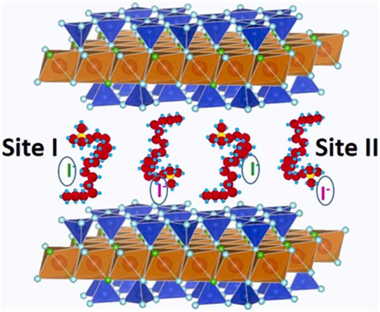
Abstract
The anionic iodine I-129 has a significant contribution to overall long-term dose resulting from the nuclear waste storage and its immobilization by clay barrier is crucial. Organoclays have been tested as ideal adsorption materials, being the clay layer charge and the length and type of organic molecules the most relevant parameters affecting the adsorption. In this work, a family of designed organomicas are explored in term of iodine adsorption capacity. Their adsorption capacities were always higher than that of the traditional clays and organoclays. C-18-M4 shows a maximum monolayer adsorption capacity one order of magnitude higher than natural organoclays, with a free energy typical of physical adsorption and adsorption sites of high affinity. However, its surface is not homogeneous in terms of stability constant according to the Scatchard adsorption parameters. Hence, this study can provide a guidance for the design and construction of ultrahigh-capacity iodine adsorbents.
Diciembre, 2021 · DOI: 10.1016/j.jece.2021.106577
Materiales de Diseño para la Energía y Medioambiente
Mechanical Performances of Isolated Cuticles Along Tomato Fruit Growth and Ripening
Benitez, JJ; Guzman-Puyol, S; Vilaplana, F; Heredia-Guerrero, JA; Dominguez, E; Heredia, AFrontiers in Chemistry, 12 (2021) 787839 DOI: 10.3389/fpls.2021.787839
Abstract
The cuticle is the most external layer that protects fruits from the environment and constitutes the first shield against physical impacts. The preservation of its mechanical integrity is essential to avoid the access to epidermal cell walls and to prevent mass loss and damage that affect the commercial quality of fruits. The rheology of the cuticle is also very important to respond to the size modification along fruit growth and to regulate the diffusion of molecules from and toward the atmosphere. The mechanical performance of cuticles is regulated by the amount and assembly of its components (mainly cutin, polysaccharides, and waxes). In tomato fruit cuticles, phenolics, a minor cuticle component, have been found to have a strong influence on their mechanical behavior. To fully characterize the biomechanics of tomato fruit cuticle, transient creep, uniaxial tests, and multi strain dynamic mechanical analysis (DMA) measurements have been carried out. Two well-differentiated stages have been identified. At early stages of growth, characterized by a low phenolic content, the cuticle displays a soft elastic behavior. Upon increased phenolic accumulation during ripening, a progressive stiffening is observed. The increment of viscoelasticity in ripe fruit cuticles has also been associated with the presence of these compounds. The transition from the soft elastic to the more rigid viscoelastic regime can be explained by the cooperative association of phenolics with both the cutin and the polysaccharide fractions.
Diciembre, 2021 · DOI: 10.3389/fpls.2021.787839
Materiales de Diseño para la Energía y Medioambiente
By-products revaluation in the production of design micaceous materials
Mouchet, A; Raffin, F; Cota, A; Osuna, FJ; Pavon, E; Alba, MDAplied Clay Science, 214 (2021) 106292 DOI: 10.1016/j.clay.2021.106292
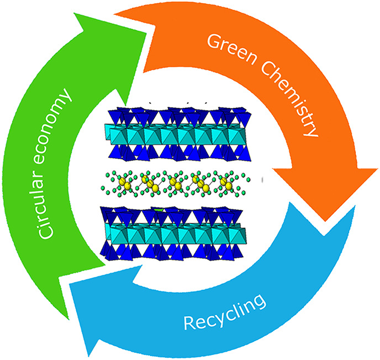
Abstract
One of the main objectives of a sustainable development and circular economy is the recycling of by-products generated in industrial and agricultural production processes. One of the possible solution is the use of such by-product materials in the synthesis of environmental adsorbents. In the current research, we present the synthesis of a high charge swelling mica with enhance adsorbent properties from blast furnace slag and rice husk ash. Moreover, to ensure the sustainable synthesis a natural bentoniteis used as Si and Al source. Thus, the current study investigated the fabrication of swelling high charged micas, Na-Mn (n (layer charge) = 2 or 4), from FEBEX bentonite, blast furnace slag and rice husk ash thorough the NaCl melt method. The reaction yield, cation framework distribution and structural characteristic of micas have been studied thorough X-ray Diffraction and Solid State Nuclear Magnetic Resonance. The yields of Na-Mn synthesis and degree of purity of the mica depends on the nature of these precursors. Thus, a sustainable, non-expensive and environmental friendly process has been evaluated.
Noviembre, 2021 · DOI: 10.1016/j.clay.2021.106292
Materiales de Diseño para la Energía y Medioambiente
Zinc Polyaleuritate Ionomer Coatings as a Sustainable, Alternative Technology for Bisphenol A-Free Metal Packaging
Morselli, D; Cataldi, P; Paul, UC; Ceseracciu, L; Benitez, JJ; Scarpellini, A; Guzman-Puyol, S; Heredia, A; Valentini, P; Pompa, PP; Marrero-López, D; Athanassiou, A; Heredia-Guerrero, AACS Sustainable Chemistry & Engineering, 9 (2021) 15484-15495 DOI: 10.1021/acssuschemeng.1c04815
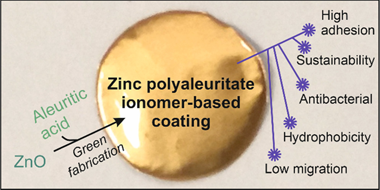
Abstract
Sustainable coatings for metal food packaging were prepared from ZnO nanoparticles (obtained by the thermal decomposition of zinc acetate) and a naturally occurring polyhydroxylated fatty acid named aleuritic (or 9,10,16-trihydroxy-hexadecanoic) acid. Both components reacted, originating under specific conditions zinc polyaleuritate ionomers. The polymerization of aleuritic acid into polyaleuritate by a solvent-free, melt polycondensation reaction was investigated at different times (15, 30, 45, and 60 min), temperatures (140, 160, 180, and 200 degrees C), and proportions of zinc oxide and aleuritic acid (0:100, 5:95, 10:90, and 50:50, w/w). Kinetic rate constants calculated by infrared spectroscopy decreased with the amount of Zn due to the consumption of reactive carboxyl groups, while the activation energy of the polymerization decreased as a consequence of the catalyst effect of the metal. The adhesion and hardness of coatings were determined from scratch tests, obtaining values similar to robust polymers with high adherence. Water contact angles were typical of hydrophobic materials with values >= 94 degrees. Both mechanical properties and wettability were better than those of bisphenol A (BPA)-based resins and most likely are related to the low migration values determined using a hydrophilic food simulant. The presence of zinc provided a certain degree of antibacterial properties. The performance of the coatings against corrosion was studied by electrochemical impedance spectroscopy at different immersion times in an aqueous solution of NaCl. Considering the features of these biobased lacquers, they can be potential materials for bisphenol A-free metal packaging.
Noviembre, 2021 · DOI: 10.1021/acssuschemeng.1c04815
Materiales de Diseño para la Energía y Medioambiente
Waterproof-breathable films from multi-branched fluorinated cellulose esters
Tedeschi, G; Guzman-Puyol, S; Ceseracciu, L; Benitez, JJ; Goldoni, L; Koschella, A; Heinze, T; Cavallo, G; Dichiarante, V; Terraneo, G; Athanassiou, A; Metrangolo, P; Heredia-Guerrero, JACarbohydrate Polymers, 271 (2021) 118031 DOI: 10.1016/j.carbpol.2021.118031

Abstract
Cellulose ester films were prepared by esterification of cellulose with a multibranched fluorinated carboxylic acid, "BRFA" (BRanched Fluorinated Acid), at different anhydroglucose unit:BRFA molar ratios (i.e., 1:0, 10:1, 5:1, and 1:1). Morphological and optical analyses showed that cellulose-BRFA materials at molar ratios 10:1 and 5:1 formed flat and transparent films, while the one at 1:1 M ratio formed rough and translucent films. Degrees of substitution (DS) of 0.06, 0.09, and 0.23 were calculated by NMR for the samples at molar ratios 10:1, 5:1, and 1:1, respectively. ATR-FTIR spectroscopy confirmed the esterification. DSC thermograms showed a single glass transition, typical of amorphous polymers, at -11 degrees C. The presence of BRFA groups shifted the mechanical behavior from rigid to ductile and soft with increasing DS. Wettability was similar to standard fluoropolymers such as PTFE and PVDF. Finally, breathability and water uptake were characterized and found comparable to materials typically used in textiles.
Noviembre, 2021 · DOI: 10.1016/j.carbpol.2021.118031
Materiales de Diseño para la Energía y Medioambiente
Impact of flame confinement with inert ceramic foams on the particulate emissions of domestic heating systems
Ciria, D; Orihuela, MP; Becerra, JA; Chacartegui, R.; Ramirez-Rico, J.Fuel, 304 (2021) 121264 DOI: 10.1016/j.fuel.2021.121264
Abstract
Small solid biomass combustion systems are among the main contributors to the global particulate emissions share, and cheap, efficient abatement systems are not yet available for them. The placement of inert porous material to confine the combustion region is being recently explored as a possible mitigation system for this kind of pollution. However, given the complexity of biomass thermochemical decomposition processes, it is challenging to justify the performance of these systems on the basis of a physicochemical understanding. A foundational experiment-based study is carried out in this work to understand how combustion confinement affects the particulate emissions production mechanisms. A combustion unit was designed and built to systematically test ceramic foams with different porosities: keeping constant airflow and fuel feed rates. A comprehensive characterisation study was carried out on the solid biomass fuel, the temperature profile, the particulate emissions, and the remaining solid residue. The results evidenced that the use of foams has a substantial impact on the temperature distribution in the combustion chamber. The higher the cell density of the foam, the higher and more homogeneous are the temperatures reached in the combustion bed. This fact improved the thermal decomposition process of the pellets due to a better air-fuel mixture, leading to a reduction of the solid particulate matter emissions by more than 70%. These findings suggest that the use of an inert porous material above the combustion region might be a feasible solution for particulate emission control in small-size biomass combustion technology.
Noviembre, 2021 · DOI: 10.1016/j.fuel.2021.121264
Materiales de Diseño para la Energía y Medioambiente
Swelling layered minerals applications: A solid state NMR overview
Pavon, E; Alba, MDProgress in Nuclear Magnetic Resonance Spectroscopy, 124 (2021) 99-128 DOI: 10.1016/j.pnmrs.2021.04.001
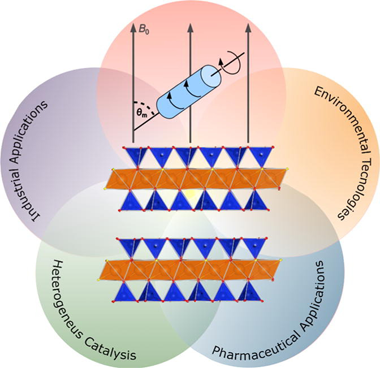
Abstract
Swelling layered clay minerals form an important sub-group of the phyllosilicate family. They are characterized by their ability to expand or contract in the presence or absence of water. This property makes them useful for a variety of applications, ranging from environmental technologies to heteroge-neous catalysis, and including pharmaceutical and industrial applications. Solid State Nuclear Magnetic Resonance (SS-NMR) has been extensively applied in the characterization of these materials, providing useful information on their dynamics and structure that is inaccessible using other characterization methods such as X-ray diffraction. In this review, we present the key contributions of SS-NMR to the understanding of the mechanisms that govern some of the main applications associated to swelling clay minerals. The article is divided in two parts. The first part presents SS-NMR conventional applications to layered clay minerals, while the second part comprises an in-depth review of the information that SS-NMR can provide about the different properties of swelling layered clay minerals.
Junio, 2021 · DOI: 10.1016/j.pnmrs.2021.04.001
Materiales de Diseño para la Energía y Medioambiente
Pectin-cellulose nanocrystal biocomposites: Tuning of physical properties and biodegradability
Moreno, Ana Gonzalez; Guzman-Puyol, Susana; Dominguez, Eva; Benitez, Jose J.; Segado, Patricia; Lauciello, Simone; Ceseracciu, Luca; Porras-Vazquez, Jose M.; Leon-Reina, Laura; Heredia, Antonio; Heredia-Guerrero, Jose A.International Journal of Biological Macromolecules, 180 (2021) 709-717 DOI: 10.1016/j.ijbiomac.2021.03.126
Abstract
The fabrication of pectin-cellulose nanocrystal (CNC) biocomposites has been systematically investigated by blend-ing both polysaccharides at different relative concentrations. Circular free-standing films with a diameter of 9 cm were prepared by simple solution of these carbohydrates in water followed by drop-casting and solvent evaporation. The addition of pectin allows to finely tune the properties of the biocomposites. Textural characterization by AFM showed fibrous morphology and an increase in fiber diameter with pectin content. XRD analysis demonstrated that pectin incorporation also reduced the degree of crystallinity though no specific interaction between both poly-saccharides was detected, by ATR-FTIR spectroscopy. The optical properties of these biocomposites were character-ized for the first time and it was found that pectin in the blend reduced the reflectance of visible light and increased UV absorbance. Thermal stability, analyzed by TGA, was improved with the incorporation of pectin. Finally, pectin-cellulose nanocrystal biocomposites showed a good biodegradability in seawater, comparable to other common bioplastics such as cellulose and low-molecular weight polylactide, among others.
Junio, 2021 · DOI: 10.1016/j.ijbiomac.2021.03.126
Materiales de Diseño para la Energía y Medioambiente
New Trends in Nanoclay-Modified Sensors
Pavon, E; Martin-Rodriguez, R; Perdigon, AC; Alba, MDInorganics, 9 (2021) 43 DOI: 10.3390/inorganics9060043
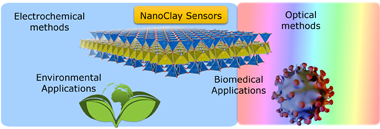
Abstract
Nanoclays are widespread materials characterized by a layered structure in the nano-scale range. They have multiple applications in diverse scientific and industrial areas, mainly due to their swelling capacity, cation exchange capacity, and plasticity. Due to the cation exchange capacity, nanoclays can serve as host matrices for the stabilization of several molecules and, thus, they can be used as sensors by incorporating electroactive ions, biomolecules as enzymes, or fluorescence probes. In this review, the most recent applications as bioanalyte sensors are addressed, focusing on two main detection systems: electrochemical and optical methods. Particularly, the application of electrochemical sensors with clay-modified electrodes (CLME) for pesticide detection is described. Moreover, recent advances of both electrochemical and optical sensors based on nanoclays for diverse bioanalytes' detection such as glucose, H2O2, organic acids, proteins, or bacteria are also discussed. As it can be seen from this review, nanoclays can become a key factor in sensors' development, creating an emerging technology for the detection of bioanalytes, with application in both environmental and biomedical fields.
Junio, 2021 · DOI: 10.3390/inorganics9060043
Materiales de Diseño para la Energía y Medioambiente
Structural Evolution in Iron-Catalyzed Graphitization of Hard Carbons
Gomez-Martin, A; Schnepp, Z; Ramirez-Rico, JChemistry of Materials, 33 (2021) 3087-3097 DOI: 10.1021/acs.chemmater.0c04385
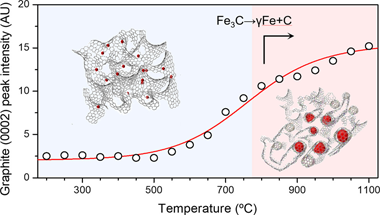
Abstract
Despite the recent interest in catalytic graphitization to obtain graphite-like materials from hard-carbon sources, many aspects of its mechanism are still poorly unknown. We performed a series of in situ experiments to study phase transformations during graphitization of a hard-carbon precursor using an iron catalyst at temperatures up to 1100 degrees C and ex situ total scattering experiments up to 2000 degrees C to study the structural evolution of the resulting graphitized carbon. Our results show that upon heating and cooling, iron undergoes a series of reductions to form hematite, magnetite, and wustite before forming a carbide that later decomposes into metallic iron and additional graphite and that the graphitization fraction increases with increasing peak temperature. Structural development with temperature results in decreasing sheet curvature and increased stacking, along with a decrease in turbostratic disorder up to 1600 degrees C. Higher graphitization temperatures result in larger graphitic domains without further ordering of the graphene sheets. Our results have implications for the synthesis of novel biomass-derived carbon materials with enhanced crystallinity.
Mayo, 2021 · DOI: 10.1021/acs.chemmater.0c04385
Materiales de Diseño para la Energía y Medioambiente
Pb2+, Cd2+ and Hg2+ removal by designed functionalized swelling high-charged micas
Osuna, FJ; Pavon, E; Alba, MDScience of The Total Environment, 764 (2021) 142811 DOI: 10.1016/j.scitotenv.2020.142811
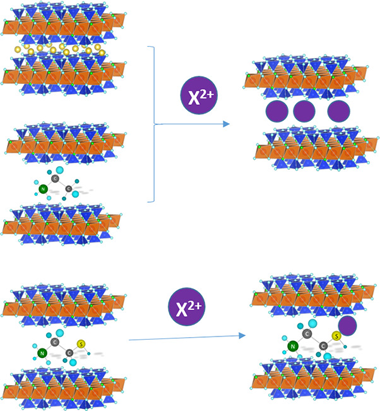
Abstract
The increasing accumulation of toxic heavy metals in the environment has generated the need of efficient removal systems, being the adsorption method the most popular one applied in aqueous solutions. Of particular concern is the case of Pb2+, Cd2+ and Hg2+ due to their high potential hazard. In this paper, we describe the feasibility of a new family of nanomaterials, swelling high charge micas, in the removal of these cations from aqueous solutions. Batch adsorption experiments were carried out in the as-made micas, NaMn, and after functionalization with ethylammonium, EA-Mn, and mercaptoethylammonium, MEA-Mn. The results have demonstrated that all of them are efficient heavy metal adsorbents, being Na-M2 the best adsorbent for Pb2+ and Cd2+, and, MEA-M2 for Hg2+.
Abril, 2021 · DOI: 10.1016/j.scitotenv.2020.142811
Materiales de Diseño para la Energía y Medioambiente
Organophilization of acid and thermal treated sepiolite for its application in BTEX adsorption from aqueous solutions
Varela, CF; Pazos, MC; Alba, MDJournal of Water Process Engineering, 40 (2021) 101949 DOI: 10.1016/j.jwpe.2021.101949
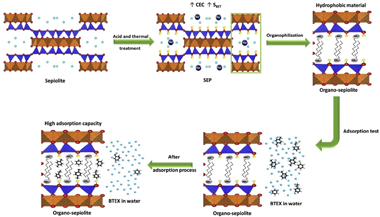
Abstract
Acid and thermal treated sepiolite was organophilized by cationic exchange with several alkylammonium cations (octylammonium, hexadecylammonium, tetradecyltrimethylammonium, and hexadecyltrimethylammonium). The adsorption capacity of BTEX from aqueous solutions was evaluated through the adsorption isotherms performed in batch. The results were analysed using three isotherm models: Freundlich, Langmuir and Dubinin-Radushkevich (D-R model). The behaviour of adsorption isotherm suggested the multilayer coverage on a heterogeneous surface, which is according to the Freundlich isotherm model. The thermodynamic analyse using the D-R model show that physical mechanisms govern the process. The maximum adsorption capacity of BTEX on the obtained materials was in the range values of 81.19 mg g(-1) - 1448.42 mg g(-)(1), which are higher than those reported up to now. The organo-sepiolite materials exhibit a high potential in the adsorption of BTEX compounds from aqueous solutions.
Abril, 2021 · DOI: 10.1016/j.jwpe.2021.101949
Materiales de Diseño para la Energía y Medioambiente
Zirconium retention for minimizing environmental risk: Role of counterion and clay mineral
Montes, L; Pavon, E; Cota, A; AlbaChemosphere, 267 (2021) 128914 DOI: 10.1016/j.chemosphere.2020.128914
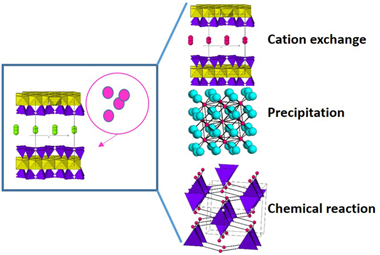
Abstract
Zr(IV) together with U(IV) are the major components of high-level radionuclide waste (HLRW) and spent nuclear fuel (SNF) from nuclear power plants. Thus, their retention in the waste disposal is of great importance for the environmental risk control. Here, the influence of clay minerals on the retention of Zr(IV), as component of the nuclear waste and as chemical analogues of U(IV), has been evaluated. Three clay minerals, two bentonites and one saponite, were hydrothermally treated with three zirconium salts. A structural study at long-range order by X-ray diffraction and short-range order by NMR was performed to evaluate the generation of new zirconium phases and degradation of the clay minerals. Three immobilization mechanisms were observed: i) cation exchange of ZrO2+ or Zr4+ by clay minerals, ii) the precipitation/crystallization of ZrO2, and, iii) the chemical interaction of zirconium with the clay minerals, with the formation of zirconium silicates.
Marzo, 2021 · DOI: 10.1016/j.chemosphere.2020.128914
2020
2020
Materiales de Diseño para la Energía y Medioambiente
Microstructure and thermal conductivity of Si-Al-C-O fiber bonded ceramics joined to refractory metals
Vera, MC; Martinez-Fernandez, J; Singh, M; Casalegno, V; Balagna, C; Ramirez-Rico, JMaterials Letters, 276 (2020) 128203 DOI: 10.1016/j.matlet.2020.128203
Abstract
We explore joining Si-Al-C-O fiber-bonded ceramics to Cu-clad-Mo using an Ag-Ti-Cu brazing alloy. A temperature of 900 degrees C and times in the range of 10-20 min are required to obtain sound joints irrespectively of the fiber orientation. The reaction layer is 1-2 mu m thick and free of pores and defects. The thermal conductivity of the joined samples is well described considering that the metal and the ceramic are in series for thermal resistance. This implies that the joint is highly conductive and forms an almost perfect
Octubre, 2020 · DOI: 10.1016/j.matlet.2020.128203
Materiales de Diseño para la Energía y Medioambiente
Multiple pollutants removal by functionalized heterostructures based on Na-2-Mica
Pazos, MC; Bravo, LR; Ramos, SE; Osuna, FJ; Pavon, E; Alba, MDApplied Clay Science, 196 (2020) 105749 DOI: 10.1016/j.clay.2020.105749
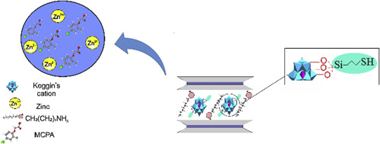
Abstract
Organomica, C8-2-Mica, was obtained from a high charged synthetic mica, Na-2-Mica, by cation exchange reaction with octylammonium cations and these were used to host other bulky guest species such as polyhydroxy aluminium cations, Al(13)20. The hydrolization of 3-mercaptopropyltrimethoxysilane (MPTMS) allowed the covalent attachment with hydroxyl groups of the oligomeric cation, providing thiol groups that create specific adsorption sites, Al(13)20/SH. The structure of the adsorbents was analysed by XRD and Infrared spectroscopy and these were tested as an adsorbent for the removal of zinc and herbicide MCPA from aqueous solutions. C8-2-Mica was the best adsorbent for MCPA and thiol groups favoured the adsorption of Zn2+. Moreover, Al(13)20/SH showed excellent adsorptive properties for the simultaneous adsorption of MCPA and Zn2+.
Octubre, 2020 · DOI: 10.1016/j.clay.2020.105749
Materiales de Diseño para la Energía y Medioambiente
Novel procedure for laboratory scale production of composite functional filaments for additive manufacturing
Diaz-Garcia, A; Law, JY; Cota, A; Bellido-Correa, A; Ramirez-Rico, J; Schafer, R; Franco, VMaterials Today Communications, 24 (2020) 101049 DOI: 10.1016/j.mtcomm.2020.101049
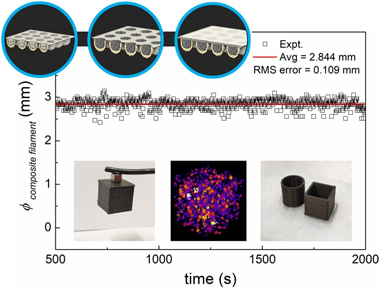
Abstract
Successful 3D printing by material extrusion of functional parts for new devices requires high quality filaments. Uniform homogeneity and good dispersion of particles embedded in filaments typically takes several cycles of extrusion or well-prepared feedstock by injection molding, industrial kneaders or twin-screw compounding. These methods need specific production devices that are not available in many laboratories non-specialized in polymer research, such as those working on different material science and technology topics that try to connect with additive manufacturing. Therefore, laboratory studies are usually limited to compositions and filler concentrations provided by commercial companies. Here, we present an original laboratory scale methodology to custom-prepare the feedstock for extruding magnetic composite filaments for fused filament fabrication (FFF), which is attainable by a desktop single-screw extruder. It consists in encapsulating the fillers in custom made capsules that are used as feedstock and reach the melting area of the extruder maintaining the same concentration of fillers. Results have shown that our approach can create smooth and continuous composite filaments with good homogeneity and printability with fine level of dimensional control. We further show the good dispersion of the particles in the composite filament using X-Ray Tomography, which enabled a 3D reconstruction of the spacial distribution of the embedded magnetic particles. The major advantage of this new way of preparing the composite feedstock is that it avoids the hassle of multiple extrusion runs and industrial machinery, yet providing uniform filaments of well controlled filler concentration, which is predictable and reproducible. The proposed methodology is suitable for different polymer matrices and applicable to other functional particle types, not just limited to magnetic ones. This opens an avenue for further laboratory scale development of novel functional composite filaments, useful for any community. This democratization of complex filament preparation, including consumers preparing their own desired uniform novel filaments, will facilitate to unify efforts nearing 3D printing of new functional devices.
Septiembre, 2020 · DOI: 10.1016/j.mtcomm.2020.101049
Materiales de Diseño para la Energía y Medioambiente
Elucidating esterification reaction during deposition of cutin monomers from classical molecular dynamics simulations
Bueno, OVM; Benitez, JJ; San-Miguel, MAJournal of Molecular Modeling, 26 (2020) 280 DOI: 10.1007/s00894-020-04544-9
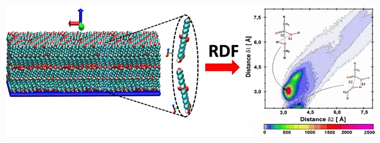
Abstract
The structural behavior of some cutin monomers, when deposited on mica support, was extensively investigated by our research group. However, other events, such as esterification reaction (ER), are still a way to explore. In this paper, we explore possible ER that could occur when these monomers adsorb on support. Although classical molecular dynamics simulations are not able to capture reactive effects, here, we show that they become valuable strategies to analyze the initial structural configurations to predict the most favorable reaction routes. Thus, when depositing aleuritic acid (ALE), it is observed that the loss of capacity to form self-assembled (SA) systems favors different routes to occur ER. In pure ALE bilayers systems, an ER is given exclusively through the -COOH and primary -OH groups. In pure ALE monolayers systems, the ER does not happen when the system is self-assembled. However, for disorganized systems, it is able to occur by two possible routes: -COOH and primary -OH (route 1) and -COOH and secondary -OH (route 2). When palmitic acid (PAL) is added in small quantities, ALE SAMs can now form an ER. In this case, ER occurs mostly through the -COOH and secondary -OH groups. However, when the presence of PAL is dominant, ER can occur with either of both possibilities, that is, routes 1 and 2.
Septiembre, 2020 · DOI: 10.1007/s00894-020-04544-9
Materiales de Diseño para la Energía y Medioambiente
An electrochemical evaluation of nitrogen-doped carbons as anodes for lithium ion batteries
Gomez-Martin, A; Martinez-Fernandez, J; Ruttert, M; Winter, M; Placke, T; Ramirez-Rico, JCarbon, 164 (2020) 261-271 DOI: 10.1016/j.carbon.2020.04.003

Abstract
New anode materials beyond graphite are needed to improve the performance of lithium ion batteries (LIBs). Chemical doping with nitrogen has emerged as a simple strategy for enhancing lithium storage in carbon-based anodes. While specific capacity and rate capability are improved by doping, little is known about other key electrochemical properties relevant to practical applications. This work presents a systematic evaluation of electrochemical characteristics of nitrogen-doped carbons derived from a biomass source and urea powder as anodes in LIB half- and full-cells. Results show that doped carbons suffer from a continuous loss in capacity upon cycling that is more severe for higher nitrogen contents. Nitrogen negatively impacts the voltage and energy efficiencies at low charge/discharge current densities. However, as the charge/discharge rate increases, the voltage and energy efficiencies of the doped carbons outperform the non-doped ones. We provide insights towards a fundamental understanding of the requirements needed for practical applications and reveal drawbacks to be overcome by novel doped carbon-based anode materials in LIB applications. With this work, we also want to encourage other researchers to evaluate electrochemical characteristics besides capacity and cycling stability which are mandatory to assess the practicality of novel materials.
Agosto, 2020 · DOI: 10.1016/j.carbon.2020.04.003
Materiales de Diseño para la Energía y Medioambiente
Sustainable, High-Barrier Polyaleuritate/Nanocellulose Biocomposites
Tedeschi, G; Guzman-Puyol, S; Ceseracciu, L; Benitez, JJ; Cataldi, P; Bissett, M; Heredia, A; Athanassiou, A; Heredia-Guerrero, JAACS Sistainable Chemistry & Engineering, 8 (2020) 10682-10690 DOI: 10.1021/acssuschemeng.0c00909
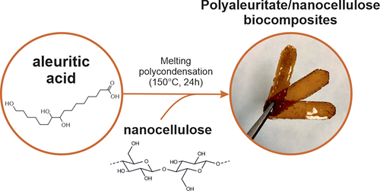
Abstract
Free-standing and flexible biocomposite films formed by a polyaleuritate matrix and nanocellulose fillers (i.e., cellulose nanofibrils) have been fabricated by a sustainable process. For this, 9,10,16-trihydroxyhexadecanoic (aleuritic) acid from shellac and nanocellulose were blended at different ratios in water through a sonication process. Polymerization of the polyhydroxylated fatty acid into polyaleuritate was induced by a solvent-free, melting polycondensation reaction in the oven. These biocomposites were characterized to evaluate their chemical (by ATR-FTIR spectroscopy) and physical (e.g., density, thermal stability, rigidity, gas permeability, surface energy, etc.) properties. The compatibility between the polyester matrix and the polysaccharide fillers was excellent due to the interaction by H bonds of the polar groups of both components. The addition of nanocellulose increased all determined mechanical parameters as well as the wettability and the barrier properties, while the thermal stability and the water uptake were determined by the polyaleuritate matrix. The physical properties of these biocomposites were compared to those of petroleum-based plastics and bio-based polymers, indicating that the developed materials can represent a sustainable alternative for different applications such as packaging.
Julio, 2020 · DOI: 10.1021/acssuschemeng.0c00909
Materiales de Diseño para la Energía y Medioambiente
Performance trends in wall-flow diesel particulate filters: Comparative analysis of their filtration efficiency and pressure drop
Orihuela, MP; Chacartegui, R; Gomez-Martin, A; Ramirez-Rico, J; Villanueva, JABJournal of Cleaner Production, 60 (2020) 12063 DOI: 10.1016/j.jclepro.2020.120863
Abstract
Soot and particulate emissions from the transport sector are a major concern worldwide, given their harmful effects on public health and the environment. On-road vehicles are the main contributing source to this kind of pollution. They are strictly regulated in many countries, with limitations on the number and concentration of released particles, and they must be equipped with particle abatement systems. Wall-flow particulate filters are the most popular and effective devices to reduce particulate emissions from diesel and gasoline vehicles. Diesel Particulate Filters (DPFs) have been a recurrent research topic since the last century. There are different research studies analysing different aspects of these systems, at different levels, using different methodologies and different approaches. Their results are not always comparable. This work analyses the latest advances and trends in this technology by comparing two relevant performance parameters: their filtration efficiency and pressure drop. The findings of this study suggest that, in order to be competitive, upcoming DPFs should have filtration efficiencies above 80%, and pressure drops below 10 kPa, for space velocities of 1.5.10(5) h(-1) or more at the clean state. They should reach similar to 100% efficiency after a short operation period, before the soot load reaches 0.2 g/L. Later, they should keep a low pressure drop for a longer time, with a reference of no more than 13 kPa for 6 g/L of soot load. Based on this analysis, this work proposes some test criteria and suggestions for the main parameters.
Julio, 2020 · DOI: 10.1016/j.jclepro.2020.120863
Materiales de Diseño para la Energía y Medioambiente
New biomorphic filters to face upcoming particulate emissions policies: A review of the FIL-BIO-DIESEL project
Orihuela, MP; Chacartegui, R; Martinez-Fernandez, JEnergy, 201 (2020) 117577 DOI: 10.1016/j.energy.2020.117577
Abstract
With a high number of diesel vehicles worldwide, particulate emission control is an urgent issue with a global impact, from the health of citizens to commercial future of this technology in some transport segments. Particulate filters are widely used in automotive engines to comply emissions regulations, but current technologies have room for improvement as they add additional backpressure in the exhaust system, and efficient on-board regeneration process is challenging.
The Fil-Bio-Diesel Project is a R&D initiative to improve current particle filtration systems, based on the development of novel biomorphic substrates. By replicating the biologic tissue of a wood precursor, a biomorphic silicon carbide with hierarchic orthotropic microstructure can be produced. The porosity, the pore size, and pore orientation of this bioceramic material can be tailored through the selection of a suitable precursor, widening the initially narrow relationship between filtration efficiency and pressure drop that characterizes granular ceramic materials. In this paper the methodology and main results of the Fil-Bio-Diesel Project are presented. This work shows the peculiar advantages of biomorphic silicon carbide through several experimental studies. The results show the potential of this novel filter substrate to be used in future particulate abatement systems.
Junio, 2020 · DOI: 10.1016/j.energy.2020.117577
Materiales de Diseño para la Energía y Medioambiente
Vegetable hierarchical structures as template for bone regeneration: New bio‐ceramization process for the development of a bone scaffold applied to an experimental sheep model
Filardo, G; Roffi, A; Fey, T; Fini, M; Giavaresi, G; Marcacci, M; Martinez-Fernandez, J; Martini, L; Ramirez-Rico, J; Salamanna, F; Sandri, M; Sprio, S; Tampieri, A; Kon, EJournal of Biomedical Materials Research Part B-Applied Materials, 108 (2020) 600-611 DOI: 10.1002/jbm.b.34414
Abstract
Long bone defects still represent a major clinical challenge in orthopedics, with the inherent loss of function considerably impairing the quality of life of the affected patients. Thus, the purpose of this study was to assess the safety and potential of bone regeneration offered by a load‐bearing scaffold characterized by unique hierarchical architecture and high strength, with active surface facilitating new bone penetration and osseointegration in critical size bone defects. The results of this study showed the potential of bio‐ceramization processes applied to vegetable hierarchical structures for the production of new wood‐derived bone scaffolds, further improved by surface functionalization, with good biological and mechanical properties leading to successful treatment of critical size bone defects in the sheep model. Future studies are needed to evaluate if these scaffolds prototypes, as either biomaterial alone or in combination with augmentation strategies, may represent an optimal solution to enhance bone regeneration in humans.
Abril, 2020 · DOI: 10.1002/jbm.b.34414
Materiales de Diseño para la Energía y Medioambiente
Bio-Based Coatings for Food Metal Packaging Inspired in Biopolyester Plant Cutin
Benitez, JJ; Osbild, S; Guzman-Puyol, S; Heredia, A; Heredia-Guerrero, JAPolymers, 12 (2020) 942 DOI: 10.3390/polym12040942
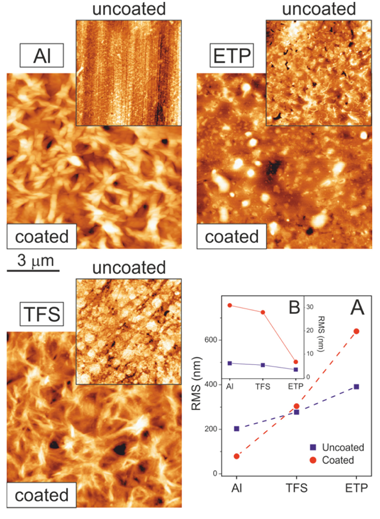
Abstract
Metals used for food canning such as aluminum (Al), chromium-coated tin-free steel (TFS) and electrochemically tin-plated steel (ETP) were coated with a 2-3-mu m-thick layer of polyaleuritate, the polyester resulting from the self-esterification of naturally-occurring 9,10,16-trihydroxyhexadecanoic (aleuritic) acid. The kinetic of the esterification was studied by FTIR spectroscopy; additionally, the catalytic activity of the surface layer of chromium oxide on TFS and, in particular, of tin oxide on ETP, was established. The texture, gloss and wettability of coatings were characterized by AFM, UV-Vis total reflectance and static water contact angle (WCA) measurements. The resistance of the coatings to solvents was also determined and related to the fraction of unreacted polyhydroxyacid. The occurrence of an oxidative diol cleavage reaction upon preparation in air induced a structural modification of the polyaleuritate layer and conferred upon it thermal stability and resistance to solvents. The promoting effect of the tin oxide layer in such an oxidative cleavage process fosters the potential of this methodology for the design of effective long-chain polyhydroxyester coatings on ETP.
Abril, 2020 · DOI: 10.3390/polym12040942
Materiales de Diseño para la Energía y Medioambiente
An insight on the design of mercapto functionalized swelling brittle micas
Osuna, FJ; Pavon, E; Alba, MDJournal of Colloid and Interface Science, 561 (2020) 533-541 DOI: 10.1016/j.jcis.2019.11.028
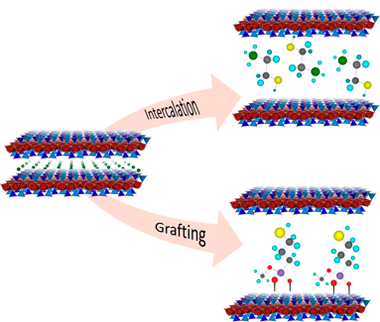
Abstract
Surface modification of natural clay minerals with reagents containing metal chelating groups has great environmental value. The functionalization by adsorption or grafting guarantees a durable immobilization of the reactive organic groups, preventing their leaching when they are used in liquid media. The aim of this research was the designed mercapto functionalization of swelling brittle micas, Na-Mn, thorough both chemical and physical mechanisms. Na-Mn were functionalized with 2-mercaptoethylammonium (MEA), 2,3-dimercapto-1-propanol (BAL) and (3-mercaptopropyl)trimethoxysilane (MPTMS). The thiol concentration on swelling brittle micas is higher than the observed value for others adsorbents. The cation exchange reaction with MEA and one-step grafting with MPTMS in acid medium are the most efficient mercapto functionalization mechanism.
Marzo, 2020 · DOI: 10.1016/j.jcis.2019.11.028
Materiales de Diseño para la Energía y Medioambiente
Binder-free supercapacitor electrodes: Optimization of monolithic graphitized carbons by reflux acid treatment
Gomez-Martin, A; Gutierrez-Pardo, A; Martinez-Fernandez, J; Ramirez-Rico, JFuel Processing Technology, 199 (2020) 106279 DOI: 10.1016/j.fuproc.2019.106279
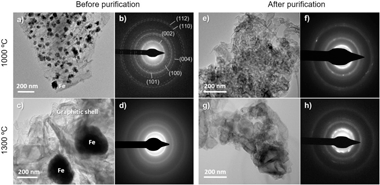
Abstract
The rational design of electrodes mimicking the cellular structure of natural bio-resources has been a matter of increasing interest for applications in energy storage. Due to their anisotropic and hierarchical porosity, monolithic carbon materials from natural wood precursors are appealing as electrodes for supercapacitor applications due to their interconnected channels, relatively low cost and environmentally friendly synthesis process. In this work, a liquid-phase oxidative treatment with refluxing nitric acid at 100 degrees C for 8 h was performed to enhance the surface properties of beech-derived graphitized carbons treated with an iron catalyst. Microstructural, textural and surface investigations revealed that this strategy was successful in removing amorphous carbon and in functionalizing their surfaces. The crystallinity, accessible surface area, micropore volume and surface functionality of beech-derived carbons were increased upon the reflux treatment. The resulting porous carbon materials were evaluated as binderless monolithic electrodes for supercapacitors applications in aqueous KOH electrolyte. A maximum specific capacitance of 179 F.g(-1) and a volumetric capacitance of 89 Fcm(-3) in galvanostatic charge/discharge experiments were reached. Monolithic electrodes exhibited good cycling stability, with a capacitance retention over 95% after 10,000 cycles.
Marzo, 2020 · DOI: 10.1016/j.fuproc.2019.106279
Materiales de Diseño para la Energía y Medioambiente
Preparation and Characterization of Bio-Based PLA/PBAT and Cinnamon Essential Oil Polymer Fibers and Life-Cycle Assessment from Hydrolytic Degradation
Correa-Pacheco, ZN; Black-Solis, JD; Ortega-Gudino, P; Sabino-Gutierrez, MA; Benitez-Jimenez, JJ; Barajas-Cervantes, A; Bautista-Banos, S; Hurtado-Colmenares, LBPolymers, 12 (2020) 38 DOI: 10.3390/polym12010038
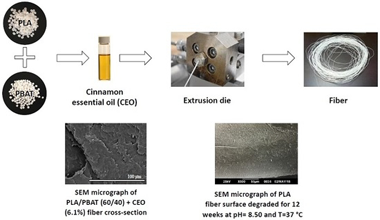
Abstract
Nowadays, the need to reduce the dependence on fuel products and to achieve a sustainable development is of special importance due to environmental concerns. Therefore, new alternatives must be sought. In this work, extruded fibers from poly (lactic acid) (PLA) and poly (butylene adipate-co-terephthalate) (PBAT) added with cinnamon essential oil (CEO) were prepared and characterized, and the hydrolytic degradation was assessed. A two-phase system was observed with spherical particles of PBAT embedded in the PLA matrix. The thermal analysis showed partial miscibility between PLA and PBAT. Mechanically, Young's modulus decreased and the elongation at break increased with the incorporation of PBAT and CEO into the blends. The variation in weight loss for the fibers was below 5% during the period of hydrolytic degradation studied with the most important changes at 37 degrees C and pH 8.50. From microscopy, the formation of cracks in the fiber surface was evidenced, especially for PLA fibers in alkaline medium at 37 degrees C. This study shows the importance of the variables that influence the performance of polyester-cinnamon essential oil-based fibers in agro-industrial applications for horticultural product preservation.
Enero, 2020 · DOI: 10.3390/polym12010038
2019
2019
Materiales de Diseño para la Energía y Medioambiente
Understanding segregation processes in SAMs formed by mixtures of hydroxylated and non-hydroxylated fatty acids
Bueno, OVM; Benitez, JJ; San-Miguel, MARSC Advances, 9 (2019) 39252-39263 DOI: 10.1039/c9ra06799j
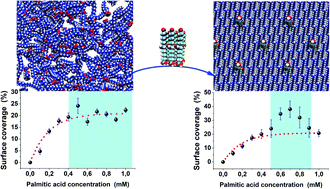
Abstract
In this paper, we focus on the segregation processes emerging when preparing mixtures with different compositions of aleuritic (9,10,16 trihydroxyhexadecanoic) (ALE) and palmitic (hexadecanoic) (PAL) acids. The combination of atomic force microscopy (AFM) and molecular dynamics (MD) simulations enabled us to prove the role of the functional groups in the formation of self-assembled monolayers (SAMs) on muscovite mica surfaces. MD simulations indicate that segregation processes are favored in high ALE composition mixtures in agreement with the experimental evidence, whereas low ALE compositions promote the co-existence between segregated and dispersed systems. The secondary hydroxyl groups play a central role in the self-assembling mechanism because they control the formation of hydrogen bonding networks guarantying system stability.
Diciembre, 2019 · DOI: 10.1039/c9ra06799j
Materiales de Diseño para la Energía y Medioambiente
Porous Graphene-like Carbon from Fast Catalytic Decomposition of Biomass for Energy Storage Applications
Gomez-Martin, A; Martinez-Fernandez, J; Ruttert, M; Winter, M; Placke, T; Ramirez-Rico, JACS Omega, 4 (2019) 21446-21458 DOI: 10.1021/acsomega.9b03142

Abstract
A novel carbon material made of porous graphene-like nanosheets was synthesized from biomass resources by a simple catalytic graphitization process using nickel as a catalyst for applications in electrodes for energy storage devices. A recycled fiberboard precursor was impregnated with saturated nickel nitrate followed by high-temperature pyrolysis. The highly exothermic combustion of in situ formed nitrocellulose produces the expansion of the cellulose fibers and the reorganization of the carbon structure into a three-dimensional (3D) porous assembly of thin carbon nanosheets. After acid washing, nickel particles are fully removed, leaving nanosized holes in the wrinkled graphene-like sheets. These nanoholes confer the resulting carbon material with approximate to 75% capacitance retention, when applied as a supercapacitor electrode in aqueous media at a specific current of 100 A.g(-1) compared to the capacitance reached at 20 mA.g(-1), and approximate to 35% capacity retention, when applied as a negative electrode for lithium-ion battery cells at a specific current of 3720 mA.g(-1) compared to the specific capacity at 37.2 mA.g(-1). These findings suggest a novel way for synthesizing 3D nanocarbon networks from a cellulosic precursor requiring low temperatures and being amenable to large-scale production while using a sustainable starting precursor such as recycled fiberwood.
Diciembre, 2019 · DOI: 10.1021/acsomega.9b03142
Materiales de Diseño para la Energía y Medioambiente
Design swelling micas: Insights on heavy metals cation exchange reaction
Osuna, FJ; Pavon, E; Alba, MDApplied Clay Science, 182 (2019) 105298 DOI: 10.1016/j.clay.2019.105298
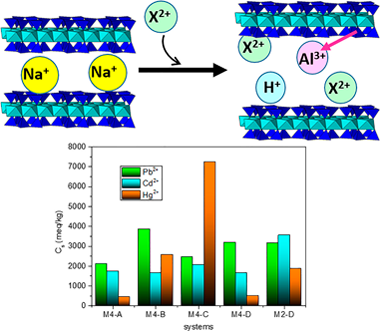
Abstract
Heavy metal pollution has become one of the most serious environmental problems, demanding specialized remediation mechanisms. Among the studied treatments, ion-exchange processes have been widely used due to their high remediation capacity, efficiency and fast kinetic. Here, the potential use of a new family of design micas as cation exchanger has been analysed. Micas with a layer charge in the range of brittle micas have been synthesized and their heavy metals cation exchange capacity analysed as a function of the nature of the heavy metal cations (Pb2+, Cd2+ or Hg2+), the nature of the counterions (Cl− or NO3−), concentration of the solutions and the micas layer charge. A cation exchange ratio between 35% and 154% of their cation exchange capacity (CEC) was achieved, being more efficient when mica layer charge diminished. In general, the maximum adsorption capacity followed the trend: Hg2+ > Pb2+ > Cd2+. The efficiency of the cation exchange and adsorption mechanism of the synthetic micas depended on the experimental conditions and they were more efficient than raw and modified natural clay minerals.
Diciembre, 2019 · DOI: 10.1016/j.clay.2019.105298
Materiales de Diseño para la Energía y Medioambiente
Correlation of Structure and Performance of Hard Carbons as Anodes for Sodium Ion Batteries
Gomez-Martin, A; Martinez-Fernandez, J; Ruttert, M; Winter, M; Placke, T; Ramirez-Rico, JChemistry of Materials, 31 (2019) 7288-7299 DOI: 10.1021/acs.chemmater.9b01768

Abstract
Hard carbons are the material of choice as negative electrode in sodium ion batteries. Despite being extensively studied, there is still debate regarding the mechanisms responsible for storage in low- and high-potential regions. This work presents a comprehensive approach to elucidate the involved storage mechanisms when Na ions insert into such disordered structures. Synchrotron X-ray total scattering experiments were performed to access quantitative information on atomic ordering in these materials at the nanoscale. Results prove that hard carbons undergo an atomic rearrangement as the graphene layers cross-link at intermediate temperatures (1200-1600 degrees C), resulting in an increase of the average interplanar distance up to 1400 degrees C, followed by a progressive decrease. This increase correlates with the positive trend in the reversible capacity of biomass-derived carbons when processed up to 1200-1600 degrees C due to an increased capacity at low potential (<= 0.1 V vs Na/Na+). A decrease in achievable sloping capacity with increasing heat-treatment temperature arises from larger crystalline domains and a lower concentration of defects. The observed correlation between structural parameters and electrochemical properties clearly supports that the main storage of Na ions into a hard-carbon structure is based on an adsorption-intercalation mechanism.
Septiembre, 2019 · DOI: 10.1021/acs.chemmater.9b01768
Materiales de Diseño para la Energía y Medioambiente
Applications and potentialities of Atomic Force Microscopy in fossil and extant plant cuticle characterization
Benitez, JJ; Guzman-Puyol, S; Dominguez, E; Heredia, A; Heredia-Guerrero, JAReview of Palaeobotany and Palynology, 268 (2019) 125-132 DOI: 10.1016/j.revpalbo.2019.06.015

Abstract
Atomic Force Microscopy (AFM) is a versatile technique of surface characterization, providing accurate information about the topography and other wide variety of magnitudes at submicron scale. It is extensively utilized in materials science, but its use in other disciplines such as paleobotany is infrequent. In this review, we introduce the main concepts of AFM to paleobotanists, comparing the characteristics of this technique to common electronic and optical microscopies. Then, main works with extant plants, in particular plant cuticles, are described. Finally, realistic applications with fossils are reviewed and their potential use in the characterization of plant fossils discussed. AFM is proposed as a complementary technique to common microscopies to characterize plant cuticle fine details at nanoscale.
Septiembre, 2019 · DOI: 10.1016/j.revpalbo.2019.06.015
Materiales de Diseño para la Energía y Medioambiente
Insoluble and Thermostable Polyhydroxyesters From a Renewable Natural Occurring Polyhydroxylated Fatty Acid
Benitez, JJ; Guzman-Puyol, S; Cruz-Carrillo, MA; Ceseracciu, L; Moreno, AG; Heredia, A; Heredia-Guerrero, JAFrontiers in Chemistry, 7 (2019) art. 643 DOI: 10.3389/fchem.2019.00643
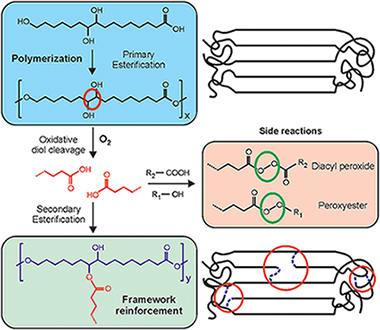
Abstract
To explore the potential of long chain polyhydroxyalkanoates as non-toxic food packaging materials, the characterization of polyesters prepared from a natural occurring polyhydroxylated C16 carboxylic acid (9,10,16-trihydroxyhexadecanoic or aleuritic acid) has been addressed. Such monomer has been selected to elucidate the reactivity of primary and secondary hydroxyl groups and their contribution to the structure and properties of the polyester. Resulting polyaleuritate films have been produced using an open mold in one-step, solvent-free self-polycondensation in melt state and directly in air to evaluate the effect of oxygen in their final physical and chemical properties. These polymers are amorphous, insoluble, and thermostable, being therefore suitable for solvent, and heat resistant barrier materials. Structurally, most of primary hydroxyls are involved in ester bonds, but there is some branching arising from the partial participation of secondary O-H groups. The oxidative cleavage of the vicinal diol moiety and a subsequent secondary esterification had a noticeable effect on the amorphization and stiffening of the polyester by branching and densification of the ester bond network. A derivation of such structural modification was the surface compaction and the reduction of permeability to water molecules. The addition of Ti(OiPr)(4) as a catalyst had a moderate effect, likely because of a poor diffusion within the melt, but noticeably accelerated both the secondary esterification and the oxidative processes. Primary esterification was a high conversion bulk reaction while oxidation and secondary esterification was restricted to nearby regions of the air exposed side of cast films. The reason was a progressive hindering of oxygen diffusion as the reaction progresses and a self-regulation of the altered layer growth. Despite such a reduced extent, the oxidized layer noticeably increased the UV-vis light blockage capacity. In general, characterized physical properties suggest a high potential of these polyaleuritate polyesters as food preserving materials.
Septiembre, 2019 · DOI: 10.3389/fchem.2019.00643
Materiales de Diseño para la Energía y Medioambiente
Bio-based composite fibers from pine essential oil and PLA/PBAT polymer blend. Morphological, physicochemical, thermal and mechanical characterization
Hernandez-Lopez, M; Correa-Pacheco, ZN; Bautista-Banos, S; Zavaleta-Avejar, L; Benitez-Jimenez, JJ; Sabino-Gutierrez, MA; Ortega-Gudino, PMaterials Chemistry and Physics, 234 (2019) 345-353 DOI: 10.1016/j.matchemphys.2019.01.034
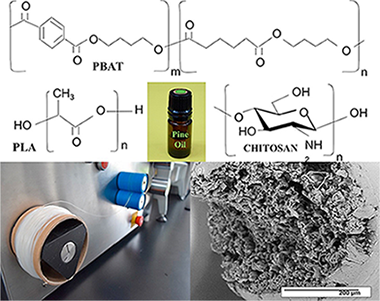
Abstract
Biodegradable aliphatic polyesters are an alternative to reduce the use of synthetic plastic materials that cause severe damage to the environment. Formulations based on poly (lactic acid) (PLA) and poly (butylene adipate-co-terephthalate) (PBAT), were mixed in a 60:40 ratio, adding different concentrations of pine essential oil through the use of extrusion technology to obtain biodegradable polymer fibers. Some formulations were coated with chitosan. All the elaborated fibers were characterized by Scanning Electron Microscopy (SEM), Fourier Transform Infrared Spectroscopy-Attenuated Total Reflection (FTIR-ATR), Differential Scanning Calorimetry (DSC), X-ray Diffraction (XRD) and mechanical properties. The SEM studies showed that the PBAT improves the tenacity and provides greater elasticity promoting the interaction between the blends phases with fibril formation. In the FTIR-ATR analysis, compatibility between the blends was observed due to a possible interaction of the carbonyl group of PBAT with PLA. The DSC and the mechanical properties showed partial miscibility of the blends, indicating, that the plasticizing action of the essential oil gave greater mobility, flexibility, less rigidity and crystallization in the blends. A lower Young's modulus and greater elongation at break was also observed.
Agosto, 2019 · DOI: 10.1016/j.matchemphys.2019.01.034
Materiales de Diseño para la Energía y Medioambiente
Natural abundance O-17 MAS NMR and DFT simulations: New insights into the atomic structure of designed micas
Pavon, E; Osuna, FJ; Alba, MD; Delevoye, LSolid State Nuclear Magnetic Resonance, 100 (2019) 45-51 DOI: 10.1016/j.ssnmr.2019.03.006
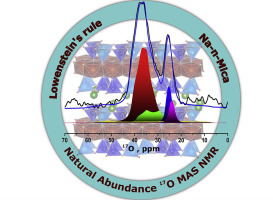
Abstract
Combining O-17 Magic-Angle Spinning (MAS) NMR at natural abundance with DFT calculations is a promising methodology to shed light on the structure and disorder in tetrahedral sheets of designed micas with enhanced properties. Among brittle micas, synthetic mica is an important alternative to natural ones with a swelling sheet-like structure that results in many applications, by exploiting unique characteristics. Lowenstein's rule is one of the main chemical factor that determines the atomic structure of aluminosilicates and furthermore their properties. In the present article, O-17 MAS NMR spectroscopy is used to validate (or not) the agreement of the Lowenstein's rule with the distribution of Si and Al sites in the tetrahedral sheets of synthetic micas. O-17 MAS spectra of synthetic high-charged micas exhibit two regions of signals that revealed two distinguishable oxygen environments, namely Si-O-X (with X = Si, Al-tet , Mg) and Al-tet -O-Y (Y=Mg or Al-tet). DFT calculations were also conducted to obtain the O-17 chemical shift and other NMR features like the quadrupolar coupling constant, C-Q, for all of the oxygen environments encountered in the two model structures, one respecting the Lowenstein's rule and the other involving Al-tet -O-Al-tet and Si-O-Si environments. Our DFT calculations support the O-17 assignment, by confirming that Al-tet -O-3Mg and Al tet -O-Al tet oxygen environments show chemical shifts under 30 ppm and more important, with quadrupolar coupling constants of about 1 MHz, in line with the spectral observation. By quantifying the O-17 MAS NMR spectra at natural abundance, we demonstrate that one of the synthetic mica compositions does not meet the Lowenstein's rule.
Agosto, 2019 · DOI: 10.1016/j.ssnmr.2019.03.006
Materiales de Diseño para la Energía y Medioambiente
Bionanocomposites based on chitosan intercalation in designed swelling high-charged micas
Alba, MD; Cota, A; Osuna, FJ; Pavon, E; Perdigon, AC; Raffin, FScientific Reports, 9 (2019) art. 10265 DOI: 10.1038/s41598-019-46495-z
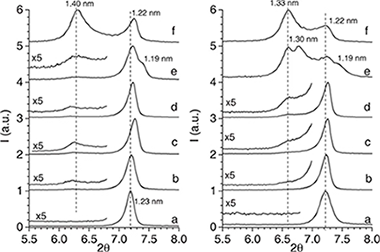
Abstract
Bionanocomposites based on layered inorganic components, as clays, and polymers of biological origin, as chitosan, have a major impact in medical and environmental fields, being economical and environmentally friendly materials. Na-Mn micas (n = 2 and 4) with controlled surface charge, high cation exchange capacity and swelling behaviour, are attractive inorganic composite components that exhibit improved adsorption properties compared to other inorganic solids which makes them potentially useful for bionanocomposites. The goal of this research was to explore the potential use of those synthetic brittle micas to form eco-friendly bionanocomposites with chitosan biopolymer. Hence, chitosan-mica bionanocomposites were prepared by ion-exchange reaction between chitosan solution and synthetic high charge mica. X-ray diffraction, Fourier transform infrared spectroscopy, thermal analysis, MAS-NMR spectroscopy and zeta-potential have been employed for bionanocomposites characterization. The results showed that the adsorption of chitosan is effective, although a chitosan portion remains in the outer surface being hydrogen-bonded to the tetrahedral sheet of the silicate.
Julio, 2019 · DOI: 10.1038/s41598-019-46495-z
Materiales de Diseño para la Energía y Medioambiente
Low molecular weight epsilon-caprolactone-p-coumaric acid copolymers as potential biomaterials for skin regeneration applications
Contardi, M; Alfaro-Pulido, A; Picone, P; Guzman-Puyol, S; Goldoni, L; Benitez, J; Heredia, A; Barthel, MJ; Ceseracciu, L; Cusimano, G; Brancato, OR; Di Carlo, M; Athanassiou, A; Heredia-Guerrero, JAPLoS One, 14 (2019) e0214956 DOI: 10.1371/journal.pone.0214956
Abstract
epsilon-caprolactone-p-coumaric acid copolymers at different mole ratios (epsilon-caprolactone: p-coumaric acid 1:0, 10:1, 8:1, 6:1, 4:1, and 2:1) were synthesized by melt-polycondensation and using 4-dodecylbenzene sulfonic acid as catalyst. Chemical analysis by NMR and GPC showed that copolyesters were formed with decreasing molecular weight as p-coumaric acid content was increased. Physical characteristics, such as thermal and mechanical properties, as well as water uptake and water permeability, depended on the mole fraction of p-coumaric acid. The p-coumarate repetitive units increased the antioxidant capacity of the copolymers, showing antibacterial activity against the common pathogen Escherichia coli. In addition, all the synthesized copolyesters, except the one with the highest concentration of the phenolic acid, were cytocompatible and hemocompatible, thus becoming potentially useful for skin regeneration applications.
Abril, 2019 · DOI: 10.1371/journal.pone.0214956
Materiales de Diseño para la Energía y Medioambiente
Sustainable polycondensation of multifunctional fatty acids from tomato pomace agro-waste catalyzed by tin (II) 2-ethylhexanoate
J.A. Heredia-Guerrero, G. Caputo, S. Guzmán-Puyol, G. Tedeschi, A. Heredia, L. Ceseracciu, J.J. Benítez, A. AthanassiouMaterials Today Sustainability, 3-4 (2019) 100004 DOI: 10.1016/j.mtsust.2018.12.001
Abstract
Bioplastics were prepared from the fatty fraction (i.e., unsaturated and polyhydroxylated fatty acids) of tomato pomace agro-wastes. Aliphatic polyesters were synthesized at different temperatures (125, 150, and 175 °C), reaction times (0.25, 0.5, 0.75, 1, 3, 5, and 7 h), and amounts of tin (II) 2-ethylhexanoate (0, 0.02, 0.05, and 0.10 mmol) used as a catalyst. The rate constants and activation energies were calculated from infrared spectra. The right combination of reaction temperature and amount of catalyst improved the reaction kinetics (apparent k from ∼1 to ∼8.5 h−1), whereas the activation energy was reduced from ∼39 without catalyst to ∼28 kJ/mol when tin (II) 2-ethylhexanoate was present. Glass transitions between ca. −25 and ∼0 °C were measured by differential scanning calorimetry, strictly depending on the degree of polymerization. The amorphous character of the samples was confirmed by X-ray diffraction. Young's modulus and hardness were calculated from indentation tests and were typical of soft materials, although increased as the polycondensation reaction progressed. High water-contact angles (maximum value ∼109°) and low water uptakes (minimum value ∼2.1%) were determined. Physical properties were compared with those of common man-made plastics and polymers, finding that these tomato pomace bioplastics could be their realistic alternatives.
Marzo, 2019 · DOI: 10.1016/j.mtsust.2018.12.001
Materiales de Diseño para la Energía y Medioambiente
Combining dietary phenolic antioxidants with polyvinylpyrrolidone: transparent biopolymer films based on p-coumaric acid for controlled release
Contardi, M; Heredia-Guerrero, JA; Guzman-Puyol, S; Summa, M; Benitez, JJ; Goldoni, L; Caputo, G; Cusimano, G; Picone, P; Di Carlo, M; Bertorelli, R; Athanassioua, A; Bayer, ISJournal of Materials Chemistry B, 7 (2019) 1384-1396 DOI: 10.1039/c8tb03017k
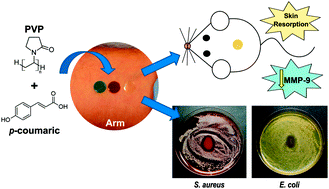
Abstract
Polyvinylpyrrolidone (PVP) has probably been one of the most utilized pharmaceutical polymers with applications ranging from a blood plasma substitute to nanoparticle drug delivery, since its synthesis in 1939. It is a highly biocompatible, non-toxic and transparent film forming polymer. Although high solubility of PVP in aqueous environment is advantageous, it still poses several problems for some applications in which sustained targeting and release are needed or hydrophobic drug inclusion and delivery systems are to be designed. In this study, we demonstrate that a common dietary phenolic antioxidant, p-coumaric acid (PCA), can be combined with PVP covering a wide range of molar ratios by solution blending in ethanol, forming new transparent biomaterial films with antiseptic and antioxidant properties. PCA not only acts as an effective natural plasticizer but also establishes H-bonds with PVP increasing its resistance to water dissolution. PCA could be released in a sustained manner up to a period of 3 days depending on the PVP/ PCA molar ratio. Sustained drug delivery potential of the films was studied using methylene blue and carminic acid as model drugs, indicating that the release can be controlled. Antioxidant and remodeling properties of the films were evaluated in vitro by free radical cation scavenging assay and in vivo on a murine model, respectively. Furthermore, the material resorption of films was slower as PCA concentration increased, as observed from the in vivo full-thickness excision model. Finally, the antibacterial activity of the films against common pathogens such as Escherichia coli and Staphylococcus aureus and the effective reduction of inflammatory agents such as matrix metallopeptidases were demonstrated. All these properties suggest that these new transparent PVP/ PCA films can find a plethora of applications in pharmaceutical sciences including skin and wound care.
Marzo, 2019 · DOI: 10.1039/c8tb03017k
Materiales de Diseño para la Energía y Medioambiente
Transparent and Robust All-Cellulose Nanocomposite Packaging Materials Prepared in a Mixture of Trifluoroacetic Acid and Trifluoroacetic Anhydride
Guzman-Puyol, S; Ceseracciu, L; Tedeschi, G; Marras, S; Scarpellini, A; Benitez, JJ; Athanassiou, A; Heredia-Guerrero, JANanomaterials, 9 (2019) 368 DOI: 10.3390/nano9030368
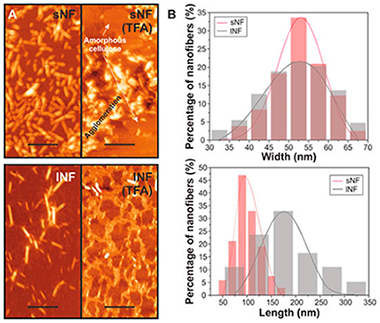
Abstract
All-cellulose composites with a potential application as food packaging films were prepared by dissolving microcrystalline cellulose in a mixture of trifluoroacetic acid and trifluoroacetic anhydride, adding cellulose nanofibers, and evaporating the solvents. First, the effect of the solvents on the morphology, structure, and thermal properties of the nanofibers was evaluated by atomic force microscopy (AFM), X-ray diffraction (XRD), and thermogravimetric analysis (TGA), respectively. An important reduction in the crystallinity was observed. Then, the optical, morphological, mechanical, and water barrier properties of the nanocomposites were determined. In general, the final properties of the composites depended on the nanocellulose content. Thus, although the transparency decreased with the amount of cellulose nanofibers due to increased light scattering, normalized transmittance values were higher than 80% in all the cases. On the other hand, the best mechanical properties were achieved for concentrations of nanofibers between 5 and 9 wt.%. At higher concentrations, the cellulose nanofibers aggregated and/or folded, decreasing the mechanical parameters as confirmed analytically by modeling of the composite Young's modulus. Finally, regarding the water barrier properties, water uptake was not affected by the presence of cellulose nanofibers while water permeability was reduced because of the higher tortuosity induced by the nanocelluloses. In view of such properties, these materials are suggested as food packaging films.
Marzo, 2019 · DOI: 10.3390/nano9030368
Materiales de Diseño para la Energía y Medioambiente
Eu3+ Luminescence in High Charge Mica: An In Situ Probe for the Encapsulation of Radioactive Waste in Geological Repositories
Martin-Rodriguez, R; Aguado, F; Alba, MD; Valiente, R; Perdigon, ACACS Applied Materials & Interfaces, 11 (4) (2019) 7559-7565 DOI: 10.1021/acsami.8b20030

Abstract
Isolation of high-level radioactive waste (HLW) in deep geological repositories (DGR) through a multibarrier concept is the most accepted approach to ensure long-term safety. Clay minerals are one of the most promising materials to be used as engineered barriers. In particular, high charge micas, as components of the engineered barrier, show superselectivity for some radioactive isotopes and a large adsorption capacity, which is almost twice that of the other low charge aluminosilicates. In addition, high charge micas are optimum candidates for decontamination of nuclear waste through two different mechanisms; namely an ion exchange reaction and a nonreversible mechanism involving the formation of new stable crystalline phases under hydrothermal conditions. In this work, we report a new in situ optical sensor based on the incorporation of Eu3+ in these high charge micas for tracking the long-term physical-chemical behavior of HLW contaminants in DRG under mild hydrothermal conditions. The incorporation of Eu3+ into the interlayer space of the mica originates a well resolved green and red luminescence, from both the 5D1 and 5D0 excited states, respectively. The formation of new crystalline phases under hydrothermal conditions involves important changes in the Eu3+ emission spectra and lifetime. The most interesting features of Eu3+ luminescence to be used as an optical sensor are (1) the presence or absence of the Eu3+ green emission from the 5D1 excited state, (2) the energy shift of the 5D0 → 7F0 transition, (3) the crystal-field splitting of the 7F1 Eu3+ level, and (4) the observed luminescence lifetimes, which are directly related to the interaction mechanisms between the lanthanide ions and the silicate network.
Febrero, 2019 · DOI: 10.1021/acsami.8b20030
Materiales de Diseño para la Energía y Medioambiente
Influence of framework and interlayer on the colloidal stability of design swelling high-charged micas
Osuna, FJ; Cota, A; Fernandez, MA; Pavon, E; Sanchez, RMT; Alba, MDColloids and Surfaces A: Physicochemical and Engineering Aspects, 561 (2019) 32-38 DOI: 10.1016/j.colsurfa.2018.09.086
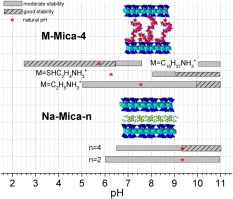
Abstract
Stability of colloidal clay minerals dispersion of fundamental in many industrial processes. Therefore, surface charge of the synthetic swelling high-charged mica family, Na-Mica-n (n = 2 or 4, n is the total layer charge) were investigated to study its colloidal dispersion stability as a function of the framework and interlayer space composition. Na-Mica-n (n = 2 or 4) micas were synthesized and functionalized with ethylammonium, mercaptoethylammonium or octadecylammonium. Their zeta-potential evolutions as a function of solution pH were correlated with their structural, compositional and morphological characteristics. The results have shown that the total charge of swelling high charged micas, Mica-n, didn´t affect significantly their colloidal dispersion stability, the interlayer composition and interlayer cation arrangement were the main factors of colloidal behaviour. The synthesis and functionalization of those synthetic micas can be tuned for their optimal use.
Enero, 2019 · DOI: 10.1016/j.colsurfa.2018.09.086
2018
2018
Materiales de Diseño para la Energía y Medioambiente
Sustainable Fabrication of Plant Cuticle-Like Packaging Films from Tomato Pomace Agro-Waste, Beeswax, and Alginate
Tedeschi, G; Benitez, JJ; Ceseracciu, L; Dastmalchi, K; Itin, B; Stark, RE; Heredia, A; Athanassiou, A; Heredia-Guerrero, JAACS Sustainable Chemistry & Engineering, 6 (2018) 14955-14966 DOI: 10.1021/acssuschemeng.8b03450
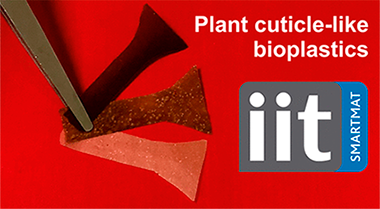
Abstract
Plant cuticles have been used as models to produce hydrophobic films composed of sodium alginate, the fatty acid fraction of tomato pomace agrowaste, and beeswax. The fabrication process consisted of the blending of components in green solvents (water and ethanol) and a subsequent thermal treatment (150 degrees C, 8 h) to polymerize unsaturated and polyhydroxylated fatty acids from tomato pomace. When sodium alginate and tomato pomace fatty acids were blended, free-standing films were obtained. These films were characterized to evaluate their morphological (SEM), chemical (solid-state NMR, ATR-FTIR), mechanical (tensile tests), thermal (TGA), and hydrodynamic (water contact angle, uptake, and permeability) properties. A comparison between nonpolymerized and polymerized samples was carried out, revealing that the thermal treatment represents a sustainable route to create structured, composite networks of both components. Finally, beeswax was added to the blend with the same amounts of sodium alginate and tomato pomace fatty acids. The presence of the wax improved the hydrophobicity and the mechanical and water barrier properties as well as decreased the water uptake. These results indicate that polymerized plant cuticle-like films have valuable potential for packaging applications.
Noviembre, 2018 · DOI: 10.1021/acssuschemeng.8b03450
Materiales de Diseño para la Energía y Medioambiente
Valorization of Tomato Processing by-Products: Fatty Acid Extraction and Production of Bio-Based Materials
Benitez, JJ; Castillo, PM; del Rio, JC; Leon-Camacho, M; Dominguez, E; Heredia, A; Guzman-Puyol, S; Athanassiou, A; Heredia-Guerrero, JAMaterials, 11 (2018) art. 2211 DOI: 10.3390/ma11112211
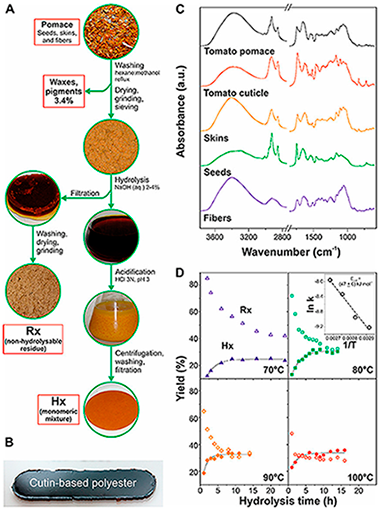
Abstract
A method consisting of the alkaline hydrolysis of tomato pomace by-products has been optimized to obtain a mixture of unsaturated and polyhydroxylated fatty acids as well as a non-hydrolysable secondary residue. Reaction rates and the activation energy of the hydrolysis were calculated to reduce costs associated with chemicals and energy consumption. Lipid and non-hydrolysable fractions were chemically (infrared (IR) spectroscopy, gas chromatography/mass spectrometry (GC-MS)) and thermally (differential scanning calorimetry (DSC), thermogravimetric analysis (TGA)) characterized. In addition, the fatty acid mixture was used to produce cutin-based polyesters. Freestanding films were prepared by non-catalyzed melt-polycondensation and characterized by Attenuated Total Reflected-Fourier Transform Infrared (ATR-FTIR) spectroscopy, solid-state nuclear magnetic resonance (NMR), DSC, TGA, Water Contact Angles (WCA), and tensile tests. These bio-based polymers were hydrophobic, insoluble, infusible, and thermally stable, their physical properties being tunable by controlling the presence of unsaturated fatty acids and oxygen in the reaction. The participation of an oxidative crosslinking side reaction is proposed to be responsible for such modifications.
Noviembre, 2018 · DOI: 10.3390/ma11112211
Materiales de Diseño para la Energía y Medioambiente
Behavior of High-Strength Polypropylene Fiber-Reinforced Self-Compacting Concrete Exposed to High Temperatures
Rios, JD; Cifuentes, H; Leiva, C; Garcia, C; Alba, MDJournal of Materials in Civil Engineering, 30 (2018) 04018271 DOI: 10.1061/(ASCE)MT.1943-5533.0002491
Abstract
In this study we analyzed the use of high-performance structural concrete reinforced with polypropylene fibers in applications requiring long exposure times to high temperatures, such as thermal energy storage systems. We analyzed the behavior of the concrete at different temperatures (hot tests: 100 degrees C, 300 degrees C, 500 degrees C and 700 degrees C), cooled-down states (cold tests) and exposure times (6, 24, and 48h). We also experimentally determined the thermogravimetric analysis, fracture behavior, compressive strength, Young's modulus, and tensile strength of concrete. Subsequently, we performed a comprehensive analysis of the thermal and mechanical behavior of high-performance concrete under different thermal conditions. We applied longer exposure times to broaden the available results on the behavior of high-performance fiber-reinforced concrete when subjected to high temperatures. Results show that, once thermal and moisture equilibriums are reached, exposure time does not have any influence on mechanical properties. They also provide useful information about the influence of high temperatures on the different parameters of fiber-reinforced concrete and its application for thermal energy storage structures.
Noviembre, 2018 · DOI: 10.1061/(ASCE)MT.1943-5533.0002491
Materiales de Diseño para la Energía y Medioambiente
Environmentally friendly monolithic highly-porous biocarbons as binder-free supercapacitor electrodes
Orlova, TS; Shpeizman, VV; Glebova, NV; Nechitailov, AA; Spitsyn, AA; Ponomarev, DA; Gutierrez-Pardo, A; Ramirez-Rico, JReviews on Advanced Materials Science, 55 (2018) 50-60 DOI: 10.1515/rams-2018-0027
Abstract
A simple, low-cost and environmentally friendly method has been used to obtain highly porous biomorphic carbon monoliths with a good combination of interconnected macro-, meso- and microporosity, and good electrical conductivity and mechanical strength, making these biocarbon materials interesting for electrochemical applications as binder-free electrodes. Highly porous monolithic biocarbons were obtained from beech wood precursors through pyrolysis and subsequent surface modification in a steam heated to 970 degrees C with different activation times. The obtained biocarbons demonstrated good electrical conductivity and mechanical strength. They were studied as electrodes for supercapacitors in half cell experiments, demonstrating maximum gravimetric capacitance of 200 F g(-1) in a basic media at scan rate 1 mV s(-1). Galvanostatic charge-discharge experiments showed maximum capacitance of 185 F g(-1) at current density of 0.15 A g(-1) and similar to 100 F g(-1) at current density of 0.75 A g(-1). It has been shown that in addition to the developed porous surface, the micropores with diameters exceeding 1 nm play a key role for the enhanced electrochemical capacity. Long-cycling experiments demonstrated excellent stability of the monolithic biocarbon electrodes with no reduction of the initial capacitance values after 600 cycles in voltammetry.
Noviembre, 2018 · DOI: 10.1515/rams-2018-0027
Materiales de Diseño para la Energía y Medioambiente
Performance improvement in olive stone's combustion from a previous carbonization transformation
Gomez-Martin, A; Chacartegui, R; Ramirez-Rico, J; Martinez-Fernandez, JFuel, 228 (2018) 254-262 DOI: 10.1016/j.fuel.2018.04.127
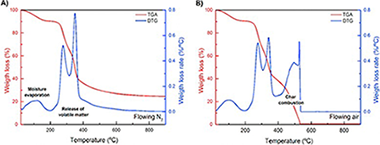
Abstract
Under the framework of circular economy, agricultural wastes are an interesting carbon-based feedstock for thermal energy and power generation. Their use could extend the availability of biomass-based fuel and, at the same time, would reduce negative environmental effects. However, depending on the residues' characteristics, their direct combustion in boilers presents some challenges which could be overcome with a carbonization pretreatment. In this paper, the main mechanisms of thermochemical transformation of an abundant agricultural waste, olive stone, into biochar products via slow carbonization are analyzed, with emphasis on the effect of peak carbonization temperature. Thermogravimetric and differential scanning calorimetry analysis are used to evaluate the performance of the resulting biochars compared to raw olive stone in combustion processes and to assess the correlation between the peak carbonization temperature and compositional and fuel properties. Results show that with a prior treatment up to an optimum temperature of 800 degrees C the energy density is increased up to three times compared to the raw material. These findings suggest that carbonization of olive stones reduces the barriers to their direct use in current biomass boiler technology.
Septiembre, 2018 · DOI: 10.1016/j.fuel.2018.04.127
Materiales de Diseño para la Energía y Medioambiente
A comprehensive and in-depth analysis of the synthesis of advanced adsorbent materials
Osuna, FJ; Cota, A; Pavon, E; Alba, MDJournal of Cleaner Production, 194 (2018) 665-672 DOI: 10.1016/j.jclepro.2018.05.179

Abstract
Na-Mica-4, a synthetic fluorophlogopite, is an attractive adsorbent. However, the synthesis at large scale demands an economically prized, feasible scalable and sustainable synthesis method, which requires a deep knowledge of the influence of each synthesis step. A set of Na-Mica-4 were synthesized by methods that had one synthesis parameter as variable. The purity, crystallinity and heteroatoms distribution were analysed thorough X-ray diffraction and nuclear magnetic resonance. The results shed a light on the main factors for the design of the final product and indicated that an environmental friendship synthesis could be possible.
Septiembre, 2018 · DOI: 10.1016/j.jclepro.2018.05.179
Materiales de Diseño para la Energía y Medioambiente
Iron-Catalyzed Graphitic Carbon Materials from Biomass Resources as Anodes for Lithium-Ion Batteries
Gomez-Martin, A; Martinez-Fernandez, J; Ruttert, M; Heckmann, A; Winter, M; Placke, T; Ramirez-Rico, JChemsuschem, 11 (2018) 2776-2787 DOI: 10.1002/cssc.201800831
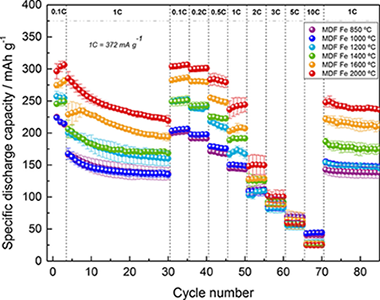
Abstract
Graphitized carbon materials from biomass resources were successfully synthesized with an iron catalyst, and their electrochemical performance as anode materials for lithium-ion batteries (LIBs) was investigated. Peak pyrolysis temperatures between 850 and 2000 degrees C were covered to study the effect of crystallinity and microstructural parameters on the anodic behavior, with a focus on the first-cycle Coulombic efficiency, reversible specific capacity, and rate performance. In terms of capacity, results at the highest temperatures are comparable to those of commercially used synthetic graphite derived from a petroleum coke precursor at higher temperatures, and up to twice as much as that of uncatalyzed biomass-derived carbons. The opportunity to graphitize low-cost biomass resources at moderate temperatures through this one-step environmentally friendly process, and the positive effects on the specific capacity, make it interesting to develop more sustainable graphite-based anodes for LIBs.
Agosto, 2018 · DOI: 10.1002/cssc.201800831
Materiales de Diseño para la Energía y Medioambiente
Comparison of solvent extraction and extraction chromatography resin techniques for uranium isotopic characterization in high-level radioactive waste and barrier materials
Hurtado-Bermudez, S; Villa-Alfageme, M; Mas, JL; Alba, MDApplied Radiation and Isotopes, 137 (2018) 177-183 DOI: 10.1016/j.apradiso.2018.04.008

Abstract
The development of Deep Geological Repositories (DGP) to the storage of high-level radioactive waste (HLRW) is mainly focused in systems of multiple barriers based on the use of clays, and particularly bentonites, as natural and engineered barriers in nuclear waste isolation due to their remarkable properties.
Due to the fact that uranium is the major component of HLRW, it is required to go in depth in the analysis of the chemistry of the reaction of this element within bentonites. The determination of uranium under the conditions of HLRW, including the analysis of silicate matrices before and after the uranium-bentonite reaction, was investigated. The performances of a state-of-the-art and widespread radiochemical method based on chromatographic UTEVA resins, and a well-known and traditional method based on solvent extraction with tri-n-butyl phosphate (TBP), for the analysis of uranium and thorium isotopes in solid matrices with high concentrations of uranium were analysed in detail.
In the development of this comparison, both radiochemical approaches have an overall excellent performance in order to analyse uranium concentration in HLRW samples. However, due to the high uranium concentration in the samples, the chromatographic resin is not able to avoid completely the uranium contamination in the thorium fraction.
Julio, 2018 · DOI: 10.1016/j.apradiso.2018.04.008
Materiales de Diseño para la Energía y Medioambiente
Plant cuticle under global change: Biophysical implications
Heredia-Guerrero, JA; Guzman-Puyol, S; Benitez, JJ; Athanassiou, A; Heredia, A; Dominguez, EGlobal Change Biology, 24 (2018) 2749-2751 DOI: 10.1111/gcb.14276
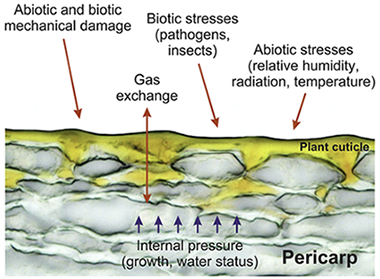
Abstract
Climatic stressors due to global change induce important modifications to the chemical composition of plant cuticles and their biophysical properties.
In particular, plant cuticles can become heavier, stiffer and more inert, improving plant protection.
The climatic stressors that modify the chemical composition of plant tissues have been recently reviewed by Suseela and Tharayil (2018). In particular, the authors stated that the response of plants to global change effects (viz. increasing temperatures and frequent drought periods) can induce important modifications in plant cuticles such as an increase of the main cuticle components (cutin and polysaccharides), a preponderance of cutan, heavier wax loads, and changes in the chemical composition of waxes, mainly the accumulation of longer aliphatic compounds. In this letter, we would like to emphasize the biophysical consequences that this new scenario involves and how it would affect plant performance.
Julio, 2018 · DOI: 10.1111/gcb.14276
Materiales de Diseño para la Energía y Medioambiente
Heteroatom framework distribution and layer charge of sodium Taeniolite
Perdigon, AC; Pesquera, C; Cota, A; Osuna, FJ; Pavon, E; Alba, MDApplied Clay Science, 158 (2018) 246-251 DOI: 10.1016/j.clay.2018.03.036
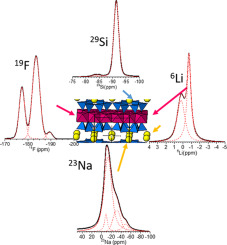
Abstract
The most advanced applications of clays depend crucially on their hydration state and swelling is probably the most important feature of expandable 2:1 layered silicate. Sodium Taeniolite, Na-TAE, a swelling trioctahedral fluormica, has been synthesized and studied using thermogravimetric analysis, X-ray diffraction, scanning electron microscopy and infrared and solid state NMR spectroscopies. The results indicated the formation of a swelling 2:1 phyllosilicate with actual layer charge lower than the nominal one. Herein, a new heteroatom distribution and more accurate composition could be deduced.
Junio, 2018 · DOI: 10.1016/j.clay.2018.03.036
Materiales de Diseño para la Energía y Medioambiente
Cesium adsorption isotherm on swelling high-charged micas from aqueous solutions: Effect of temperature
Osuna, FJ; Cota, A; Pavon, E; Pazos, MC; Alba, MDAmerican Mineralogist, 103 (2018) 623-628 DOI: 10.2138/am-2018-6203

Abstract
The potential use of a new family of synthetic swelling micas for cesium immobilization from aqueous solution was evaluated and the structural modifications after adsorption were analyzed. The results have revealed that they are good cesium adsorbents compared to natural clays and as the layer charge increases, the adsorption capacity and affinity increase. The cesium ions are adsorbed through a cation exchange mechanism, but an inner sphere complex with the basal O atoms of the tetrahedral sheet is favored. These findings imply that is possible to design minerals with improved environmental applications.
Abril, 2018 · DOI: 10.2138/am-2018-6203
Materiales de Diseño para la Energía y Medioambiente
Experimental measurement of the filtration efficiency and pressure drop of wall-flow diesel particulate filters (DPF) made of biomorphic Silicon Carbide using laboratory generated particles
Orihuela, MP; Gomez-Martin, A; Miceli, P; Becerra, JA; Chacartegui, R; Fino, DApplied Thermal Engineering, 131 (2018) 41-53 DOI: 10.1016/j.applthermaleng.2017.11.149
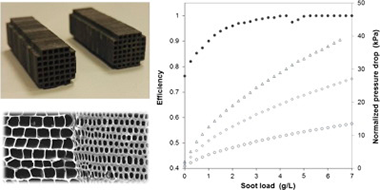
Abstract
Biomorphic Silicon Carbide (bioSiC) has been recently introduced in the scope of porous ceramic substrates for hot gas filtration applications, where it has demonstrated to have good thermal and mechanical properties, and a high potential to meet the requirements for current Diesel Particulate Filters (DPF). In this experimental study, a small wall-flow bioSiC diesel filter was characterized using a soot generator, the particle size distribution of which being similar to the one generated by a diesel engine. The bioSiC samples were manufactured from Medium Density Fiberboard (MDF) following a general manufacturing procedure for bioSiC ceramics, but paying special attention in the mechanizing stage to the geometry and optimal design of the honeycomb structure required for diesel engine applications. The samples had a cell density of 57.59 cell/cm(2) (371.6 cpsi), a square cross section of 9.2 x 9.2 mm, and a length of 31 mm. To generate the particle laden stream and perform the filtration tests, a synthetic Soot Generator (SG) was used. Tests were performed under controlled and reproducible conditions, with a fixed gas flow rate of 5 LPM and a soot mass flow rate of 4 mg/h. The filtration efficiency was determined with the aid of a Scanning Mobility Particle Sizer (SMPS) from the measurements of the particle concentration upstream and downstream the filter samples. During the soot loading process, the pressure drop was also monitored. The results show that, in the initial stage (clean filter), bioSiC wall-flow DPFs may have a filtration efficiency between 0.7 and 0.85 and a pressure drop of around 2 kPa for a normalized wall velocity of 0.01 m/s at ambient temperature. The filtration performance of wall-flow bioSiC particle filters showed in this work can help us to better understand their real potential for automotive applications.
Febrero, 2018 · DOI: 10.1016/j.applthermaleng.2017.11.149
Materiales de Diseño para la Energía y Medioambiente
Packing Defects in Fatty Amine Self-Assembled Monolayers on Mica as Revealed from AFM Techniques
Benitez, JJ; Heredia-Guerrero, JA; San-Miguel, MA; Galloway, HCJournal of Physical Chemistry B, 122 (2018) 493-499 DOI: 10.1021/acs.jpcb.7b03603
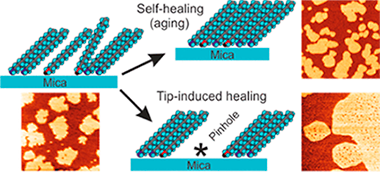
Abstract
Self-assembled monolayers of n-octadecylamine (ODA-SAMs) on mica have been prepared and studied by contact and jumping mode atomic force microscopy (AFM). Adhesion and friction data show that the compactness of the monolayers spontaneously increases as they are allowed to ripen. Molecular packing can also be induced by the controlled mechanical perturbation exerted by the probe when getting into and out of contact intermittently. Under these conditions, defects and vacancies aggregate giving rise to detectable pinholes uniformly distributed in AFM images. Created pinhole density was found to decrease with ripening time, thus confirming the proposed spontaneous self-healing mechanism. Pinhole density is also suggested as a parameter characterizing the packing degree of ODA-SAMs, and it has been related to their tribological properties. Additionally, molecular dynamics simulations were used to corroborate the compatibility between the packing degree and the observed topography of ODA-SAMs on mica.
Enero, 2018 · DOI: 10.1021/acs.jpcb.7b03603
2017
2017
Materiales de Diseño para la Energía y Medioambiente
High temperature compressive strength and creep behavior of Si-Ti-C-O fiber-bonded ceramics
Vera, MC; Martinez-Fernandez, J; Singh, M; Ramirez-Rico, JJournal of the European Ceramic Society, 37 (2017) 4442-4448 DOI: 10.1016/j.jeurceramsoc.2017.06.037
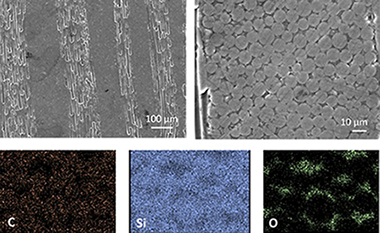
Abstract
Fiber bonded silicon carbide ceramic materials provide cost-advantage over traditional ceramic matrix composites and require fewer processing steps. Despite their interest in extreme environment thermostructural applications no data on long term mechanical reliability other than static fatigue is available for them. We studied the high temperature compressive strength and creep behavior of a fiber bonded SiC material obtained by hot-pressing of Si Ti-C-O fibers. The deformation mechanism and onset of plasticity was evaluated and compared with other commercial SiC materials. Up to 1400 degrees C, plasticity is very limited and any macroscopic deformation proceeds by crack formation and damage propagation. A transient viscous creep stage is observed due to flow in the silica matrix and once steady state is established, a stress exponent n similar to 4 and an activation energy Q similar to 700 kJ mol(-1) are found. These results are consistent with previous data on creep of polymer derived SiC fibers and polycrystals.
Diciembre, 2017 · DOI: 10.1016/j.jeurceramsoc.2017.06.037
Materiales de Diseño para la Energía y Medioambiente
Performance of biomorphic Silicon Carbide as particulate filter in diesel boilers
Orihuela, M Pilar; Gomez-Martin, Aurora; Becerra, Jose A; Chacartegui, Ricardo; Ramirez-Rico, JoaquinJournal of Environmental Management, 203 (2017) 907-919 DOI: 10.1016/j.jenvman.2017.05.003
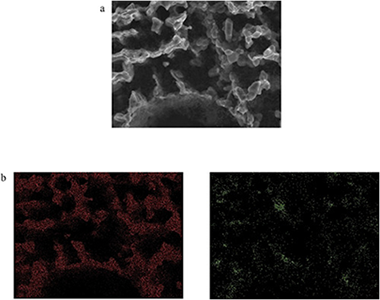
Abstract
Biomorphic Silicon Carbide (bioSiC) is a novel porous ceramic material with excellent mechanical and thermal properties. Previous studies have demonstrated that it may be a good candidate for its use as particle filter media of exhaust gases at medium or high temperature. In order to determine the filtration efficiency of biomorphic Silicon Carbide, and its adequacy as substrate for diesel particulate filters, different bioSiC-samples have been tested in the flue gases of a diesel boiler. For this purpose, an experimental facility to extract a fraction of the boiler exhaust flow and filter it under controlled conditions has been designed and built. Several filter samples with different microstructures, obtained from different precursors, have been tested in this bench. The experimental campaign was focused on the measurement of the number and size of particles before and after placing the samples. Results show that the initial efficiency of filters made from natural precursors is severely determined by the cutting direction and associated microstructure. In biomorphic Silicon Carbide derived from radially cut wood, the initial efficiency of the filter is higher than 95%. Nevertheless, when the cut of the wood is axial, the efficiency depends on the pore size and the permeability, reaching in some cases values in the range 70–90%. In this case, the presence of macropores in some of the samples reduces their efficiency as particle traps. In continuous operation, the accumulation of particles within the porous media leads to the formation of a soot cake, which improves the efficiency except in the case when extra-large pores exist. For all the samples, after a few operation cycles, capture efficiency was higher than 95%. These experimental results show the potential for developing filters for diesel boilers based on biomorphic Silicon Carbide.
Diciembre, 2017 · DOI: 10.1016/j.jenvman.2017.05.003
Materiales de Diseño para la Energía y Medioambiente
Effect of the crystal chemistry on the hydration mechanism of swelling micas
Pavon, E; Alba, MD; Castro, MA; Cota, A; Osuna, FJ; Pazos, MCGeochimica et Cosmochimica Acta, 217 (2017) 231-239 DOI: 10.1016/j.gca.2017.08.028
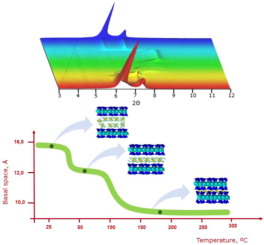
Abstract
Swelling and dehydration under minor changes in temperature and water vapor pressure is an important property that clays and clay minerals exhibit. In particular, their interlayer space, the solid-water interface and the layers' collapse and re-expansion have received much attention because it affects to the dynamical properties of interlayer cations and thus the transfer and fate of water and pollutants. In this contribution, the dehydration and rehydration mechanism of a swelling high-charge mica family is examined by in situ X-ray Diffraction. The effect of the aluminosilicate layer charge and the physicochemical properties of the interlayer cations on these processes are analyzed. The results showed that the dehydration temperature and the number of steps involved in this process are related to the layer charge of the silicate and the physicochemical properties of the interlayer cations. Moreover, the ability to adsorb water molecules in a confined space with high electric field by the interlayer cations does not only depend on their hydration enthalpy but also on the electrostatic parameters of these cations.
Noviembre, 2017 · DOI: 10.1016/j.gca.2017.08.028
Materiales de Diseño para la Energía y Medioambiente
Cellulose-polyhydroxylated fatty acid ester-based bioplastics with tuning properties: Acylation via a mixed anhydride system
Heredia-Guerrero, JA; Goldoni, L; Benitez, JJ; Davis, A; Ceseracciu, L; Cingolani, R; Bayer, IS; Heinze, T; Koschella, A; Heredia, A; Athanassiou, ACarbohydrate Polymers, 173 (2017) 312-320 DOI: 10.1016/j.carbpol.2017.05.068

Abstract
The synthesis of microcrystalline cellulose (MCC) and 9,10,16-hydroxyhexadecanoic (aleuritic) acid ester-based bioplastics was investigated through acylation in a mixed anhydride (trifluoroacetic acid (TFA)/trifluoroacetic acid anhydride (TFAA)), chloroform co-solvent system. The effects of chemical interactions and the molar ratio of aleuritic acid to the anhydroglucose unit (AGU) of cellulose were investigated. The degree of substitution (DS) of new polymers were characterized by two-dimensional solution-state NMR and ranged from 0.51 to 2.60. The chemical analysis by attenuated total reflection Fourier transform infrared spectroscopy (ATR-FTIR) confirmed the presence of aleuritate groups in the structure induces the formation of new H-bond networks. The tensile analysis and the contact angle measurement confirmed the ductile behavior and the hydrophobicity of the prepared bioplastics. By increasing the aleuritate amounts, the glass transition temperature decreased and the solubility of bioplastic films in most common solvents was improved. Furthermore, this new polymer exhibits similar properties compared to commercial cellulose derivatives.
Octubre, 2017 · DOI: 10.1016/j.carbpol.2017.05.068
Materiales de Diseño para la Energía y Medioambiente
High-temperature thermal conductivity of biomorphic SiC/Si ceramics
Ramirez-Rico, J.; Singh, M.; Zhu, D.; Martinez-Fernandez, J.Journal of Materials Science, 52 (2017) 10038-10046 DOI: 10.1007/s10853-017-1199-y
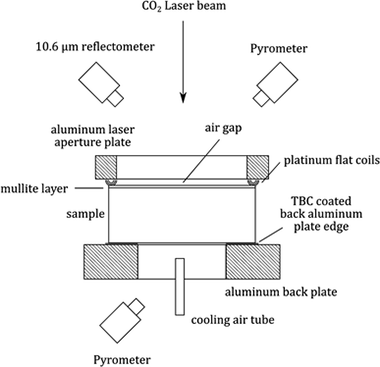
Abstract
Thermal conductivity of biomorphic SiC/Si, a silicon carbide + silicon containing two phase material, was evaluated using the laser steady-state heat flux method. These materials were processed via silicon melt infiltration of wood-derived carbon scaffolds. In this approach, heat flux was measured through the thickness when one side of the specimen was heated with a 10.6-A mu m CO2 laser. A thin mullite layer was applied to the heated surface to ensure absorption and minimize reflection losses, as well as to ensure a consistent emissivity to facilitate radiative loss corrections. The influence of the mullite layer was accounted for in the thermal conductivity calculations. The effect of microstructure and composition (inherited from the wood carbonaceous performs) on measured conductivity was evaluated. To establish a baseline for comparison, a dense, commercially available sintered SiC ceramic was also evaluated. It was observed that at a given temperature, thermal conductivity falls between that of single-crystal silicon and fine-grained polycrystalline SiC and can be rationalized in terms of the SiC volume fraction in biomorphic SiC/Si material.
Septiembre, 2017 · DOI: 10.1007/s10853-017-1199-y
Materiales de Diseño para la Energía y Medioambiente
New insights into surface-functionalized swelling high charged micas: Their adsorption performance for non-ionic organic pollutants
Pazos, MC; Castro, MA; Cota, A; Osuna, FJ; Pavon, E; Alba, MDJournal of Industrial and Engineering Chemistry, 52 (2017) 179-186 DOI: 10.1016/j.jiec.2017.03.042
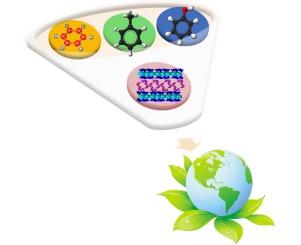
Abstract
The major components of the wastewater from the petroleum refineries are benzene, toluene and phenol and one of the techniques applied to the treatment of effluents is sorption using organo-functionalized clay. The materials exploited in the present study are a family of surface-functionalized synthetic micas and their sorption capacities for non-ionic organic pollutants are analyzed. The organo-functionalization of their surface provides them the capacity to sorb effectively non-ionic pollutants in the interface. Their adsorption performance is a function of the alkylamonium properties such as the chain length, the mass fraction and the organization of the organic cation in the interlayer space of the micas.
Agosto, 2017 · DOI: 10.1016/j.jiec.2017.03.042
Materiales de Diseño para la Energía y Medioambiente
Biomorphic ceramics from wood-derived precursors
Ramirez-Rico, J.; Martinez-Fernandez, J.; Singh, M.International Materials Reviews, 62 (2017) Issue 8 DOI: 10.1080/09506608.2017.1354429

Abstract
Materials development is driven by microstructural complexity and, in many cases, inspired by biological systems such as bones, shells and wood. In one approach, one selects the main microstructural features responsible for improved properties and design processes to obtain materials with such microstructures (continuous-fibre-reinforced ceramics, porous ceramics, fibrous ceramic monoliths, etc.). In a different approach, it is possible to use natural materials directly as microstructural templates. Biomorphic ceramics are produced from natural and renewable resources (wood or wood-derived products). A wide variety of SiC-based ceramics can be fabricated by infiltration of silicon or silicon alloys into cellulose-derived carbonaceous templates, providing a low-cost route to advanced ceramic materials with near-net shape potential and amenable to rapid prototyping. These materials have tailorable microstructure and properties, and behave like ceramic materials manufactured by advanced ceramic processing approaches. This review aims to be a comprehensive description of the development of bioSiC ceramics: from wood templates and their microstructure to potential applications of bioSiC materials.
Agosto, 2017 · DOI: 10.1080/09506608.2017.1354429
Materiales de Diseño para la Energía y Medioambiente
Cutin from agro-waste as a raw material for the production of bioplastics
Heredia-Guerrero, JA; Heredia, A; Dominguez, E; Cingolani, R; Bayer, IS; Athanassiou, A; Benitez, JJJournal of Experimental Botany, 68 (2017) 5401-5410 DOI: 10.1093/jxb/erx272
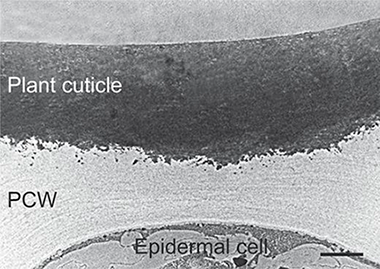
Abstract
Cutin is the main component of plant cuticles constituting the framework that supports the rest of the cuticle components. This biopolymer is composed of esterified bi- and trifunctional fatty acids. Despite its ubiquity in terrestrial plants, it has been underutilized as raw material due to its insolubility and lack of melting point. However, in recent years, a few technologies have been developed to obtain cutin monomers from several agro-wastes at an industrial scale. This review is focused on the description of cutin properties, biodegradability, chemical composition, processability, abundance, and the state of art of the fabrication of cutin-based materials in order to evaluate whether this biopolymer can be considered a source for the production of renewable materials.
Agosto, 2017 · DOI: 10.1093/jxb/erx272
Materiales de Diseño para la Energía y Medioambiente
Cs+ immobilization by designed micaceous adsorbent under subcritical conditions
Osuna, FJ; Cota, A; Pavon, E; Pazos, MC; Alba, MDApplied Clay Science, 143 (2017) 293-299 DOI: 10.1016/j.clay.2017.03.041
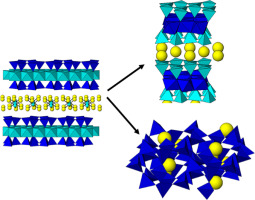
Abstract
The adsorption of Cs+ by clay minerals is a complicate process, being cation exchange and frayed-edge sites the major mechanisms that govern it. However, environmental variables have a significant impact on the process. In this work, the influence of the temperature and time in the cesium adsorption capacity of Na-Mica-n (n = 2 and 4) have been explored under subcritical conditions. Those synthetic micas were able to immobilize cations Cs+ combining adsorption at nonspecific sites, at specific sites and chemical reaction. The distribution constant of Cs+ was larger in the Na-Mica-2 denoting a higher concentration of specific adsorption sites when layer charge decreased.
Julio, 2017 · DOI: 10.1016/j.clay.2017.03.041
Materiales de Diseño para la Energía y Medioambiente
Failure mode and effect analysis of a large scale thin-film CIGS photovoltaic module
Delgado-Sanchez, JM; Sanchez-Cortezon, E; Lopez-Lopez, C; Aninat, R; Alba, MDEngireering failure analysis, 76 (2017) 55-60 DOI: 10.1016/j.engfailanal.2017.02.004
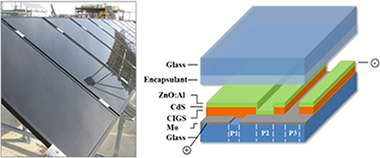
Abstract
The efficiency of thin-film CIGS based cells at the laboratory scale is now getting closer to conventional Silicon technologies. As a consequence, the long-term stability of CIGS is now one of the main challenges left to address in order to assess its potential as an alternative for photovoltaic plants. This paper reports an overview of the critical risks for the commercial viability of the CIGS thin-film technology. The key causes of the potential failures of this technology are determined through the Failure Mode Analysis and Effects (FMEA) methodology. To validate the results obtained from the FMEA, aging tests and outdoor monitoring were also carried out. Based on the results obtained, we argue that the encapsulation material is the main cause of degradation in CIGS modules.
Junio, 2017 · DOI: 10.1016/j.engfailanal.2017.02.004
Materiales de Diseño para la Energía y Medioambiente
Features of electrical properties of BE-C(Fe) biocarbons carbonized in the presence of an Fe-containing catalyst
Popov, VV; Orlova, TS; Gutierrez-Pardo, A; Ramirez-Rico, JPhysics of the Solid State, 59 (2017) 703-709 DOI: 10.1134/S1063783417040205
Abstract
The effect of partial graphitization on electrical and galvanomagnetic properties of BE-C(Fe) biomorphic carbons produced by beech wood carbonization at temperatures of 850-1600A degrees C in the presence of an iron-containing catalyst is studied. The use of an Fe catalyst at D cent (carb) ae<yen> 1000A degrees C leads to the formation of nanoscale graphite-phase inclusions; its total volume and nanocrystallite sizes increase with D cent (carb). The data on the carrier concentration and mobility are obtained. It was shown that partially graphitized BE-C(Fe) carbons with D cent (carb) ae<yen> 1000A degrees C in the conductivity type and magnetoresistance features relate to highly disordered metal systems whose conductivity can be described taking into account the contribution of quantum corrections, mainly the correction caused by the electron-electron interaction. It is shown that nonmonotonic dependences of the Hall constant R on the magnetic field are characteristic of BE-C(Fe) samples with 1000 ae<currency> D cent (carb) < 1600A degrees C, which is most probably caused by the contribution of various carrier groups, i.e., electrons and holes. In BE-C(Fe) samples with D cent (carb) = 1600A degrees C, the Hall coefficient corresponds to the metal state, which is associated with conducting medium homogenization resulting from the formation of a significant graphite phase volume.
Abril, 2017 · DOI: 10.1134/S1063783417040205
Materiales de Diseño para la Energía y Medioambiente
Packaging Materials: All‐Natural Sustainable Packaging Materials Inspired by Plant Cuticles (Adv. Sustainable Syst. 1‐2/2017)
Heredia-Guerrero, JA; Benitez, JJ; Cataldi, P; Paul, UC; Contardi, M; Cingolani, R; Bayer, IS; Heredia, A; Athanassiou, AAdvanced Sustainable Systems, 1 (2017) DOI: 10.1002/adsu.201770012
Abstract
In article number 1600024, José A. Heredia‐Guerrero, Athanassia Athanassiou, and co‐workers present new, sustainable composite materials inspired by plant cuticles. These materials are fabricated by the impregnation of fibrous cellulose substrates with a naturally occurring polyhydroxylated fatty acid, and subsequent polymerization of the latter into a polyester. In the image a piece of this new material is shown together with tomato and pepper fruits. Cover image created by Dr. Duilio Farina.
Febrero, 2017 · DOI: 10.1002/adsu.201770012
Materiales de Diseño para la Energía y Medioambiente
Precision and accuracy of stress measurement with a portable X-ray machine using an area detector
Lee, SY; Ling, JJ; Wang, SH; Ramirez-Rico, JJournal of Applied Crystallography, 50 (2017) 131-144 DOI: 10.1107/S1600576716018914
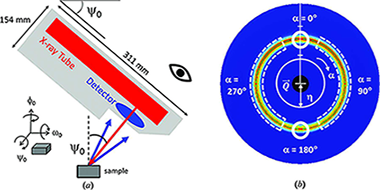
Abstract
The use of portable X-ray stress analyzers, which utilize an area detector along with the newly adopted 'cos alpha' or full-ring fitting method, has recently attracted increasing interest. In laboratory conditions, these measurements are fast, convenient and precise because they employ a single-exposure technique that does not require sample rotation. In addition, the effects of grain size and orientation can be evaluated from the Debye ring recorded on the area detector prior to data analysis. The accuracy of the measured stress, however, has been questioned because in most cases just a single reflection is analyzed and the sample-to-detector distances are relatively short. This article presents a comprehensive analysis of the uncertainty associated with a state-of-the-art commercial portable X-ray device. Annealed ferrite reference powders were used to quantify the instrument precision, and the accuracy of the stress measurement was tested by in situ tensile loading on 1018 carbon steel and 6061 aluminium alloy bar samples. The results show that the precision and accuracy are sensitive to the instrument (or sample) tilt angle (0) as well as to the selected hkl reflection of the sample. The instrument, sample and data analysis methods all affect the overall uncertainty, and each contribution is described for this specific portable X-ray system. Finally, on the basis of the conclusions reached, desirable measurement/analysis protocols for accurate stress assessments are also presented.
Febrero, 2017 · DOI: 10.1107/S1600576716018914
Materiales de Diseño para la Energía y Medioambiente
Front contact optimization of industrial scale CIGS solar cells for low solar concentration using 2D physical modeling
Delgado-Sanchez, JM; Lopez-Gonzalez, JM; Orpella, A; Sanchez-Cortezon, E; Alba, MD; Lopez-Lopez, C; Alcubilla, RRenewable Energy, 101 (2017) 90-95 DOI: 10.1016/j.renene.2016.08.046
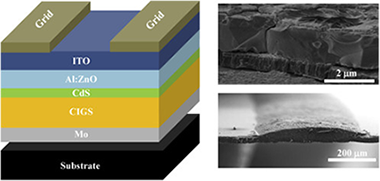
Abstract
Cu(In,Ga)Se-2 (CIGS) technology is one of the best absorber materials with record efficiencies among photovoltaic thin-film technologies (22.3% at lab scale and 16% at large commercial module). Although research on this material was originally motivated by low-cost, glass-glass applications focusing to fixed photovoltaic structures, the high efficiency values make CIGS an interesting alternative for low concentration systems. In this paper a 2D model for Cu(In,Ga)Se-2 (CIGS) solar cells under low solar concentration is described and contrasted with experimental data. Using simulation, the effect of front electric contact design parameters: finger width, finger separation, and number of buses are analyzed for solar concentrations from 1 up to 10 suns. Efficiency maps allowing front contact grid optimization are shown and analyzed for each concentration factor (Cx), assessing the viability of CIGS solar cells for low concentration applications, where commercial CIGS solar cells may exhibit 35% of electrical power increases with proper front grid optimization under low concentration respect to conventional grid design.
Enero, 2017 · DOI: 10.1016/j.renene.2016.08.046
Materiales de Diseño para la Energía y Medioambiente
Insolubilization and thermal stabilization of a long-chain polyester by noncatalyzed melt-polycondensation synthesis in air
Benitez, JJ; Heredia-Guerrero, JA; Cruz-Carrillo, MA; Barthel, MJ; Knicker, HE; Heredia, AJournal of Applied Polymer Science, 134 (2017) 1 art 44350 DOI: 10.1002/app.44350

Abstract
Self-standing films of poly(-hydroxyl hexadecanoic acid) [poly(-OHC16)] have been prepared by noncatalyzed melt-polycondensation in air at 150, 175, and 200 degrees C. Poly(-OHC16)s obtained are characterized as polyesters by infrared spectroscopy (FT-IR) and solid state magic angle spinning C-13 nuclear magnetic resonance (C-13 MAS-NMR). Structurally, poly(-OHC16)s are quite crystalline as revealed by wide angle X-ray diffraction (WAXD). The presence of oxygen in the reaction atmosphere causes a mild oxidation in the form of peroxyester species, tentatively at the interphase between poly(-OHC16) crystallites, and the structure amorphization. The interfacial peroxyester phase ends up in the encapsulation of the polyester grains and provides a barrier towards the action of solvents. Thermal stabilization and insolubility resulting from the synthesis conditions used are interesting features to prepare solvent and heat resistant poly(-OHC16) coatings. Thus, a few microns thick poly(-OHC16) layer has been fabricated on aluminum foil and its resistivity towards a chloroform:methanol (1:1, v:v) mixture has been confirmed.
Enero, 2017 · DOI: 10.1002/app.44350
2016
2016
Materiales de Diseño para la Energía y Medioambiente
Microstructure, elastic, and inelastic properties of biomorphic carbons carbonized using a Fe-containing catalyst
Orlova, TS; Kardashev, BK; Smirnov, BI; Gutierrez-Pardo, A; Ramirez-Rico, JPhysics of the Solid State, 58 (2016) 2481-2487 DOI: 10.1134/S1063783416120234
Abstract
The microstructure and amplitude dependences of the Young’s modulus E and internal friction (logarithmic decrement δ), and microplastic properties of biocarbon matrices BE-C(Fe) obtained by beech tree carbonization at temperatures Tcarb = 850–1600°C in the presence of an iron-containing catalyst are studied. By X-ray diffraction analysis and transmission electron microscopy, it is shown that the use of Fe-catalyst during carbonization with Tcarb ≥ 1000°C leads to the appearance of a bulk graphite phase in the form of nanoscale bulk graphite inclusions in a quasi-amorphous matrix, whose volume fraction and size increase with Tcarb. The correlation of the obtained dependences E(Тcarb) and δ(Tcarb) with microstructure evolution with increasing Тcarb is revealed. It is found that E is mainly defined by a crystalline phase fraction in the amorphous matrix, i.e., a nanocrystalline phase at Тcarb < 1150°C and a bulk graphite phase at Tcarb > 1300°C. Maximum values E = 10–12 GPa are achieved for samples with Тcarb ≈ 1150 and 1600°C. It is shown that the microplasticity manifest itself only in biocarbons with Tcarb ≥ 1300°C (upon reaching a significant volume of the graphite phase); in this case, the conditional microyield stress decreases with increasing total volume of introduced mesoporosity (free surface area).
Diciembre, 2016 · DOI: 10.1134/S1063783416120234
Materiales de Diseño para la Energía y Medioambiente
Thermal conductivity of porous biomorphic SiC derived from wood precursors
Gomez-Martin, A; Orihuela, MP; Ramirez-Rico, J; Chacartegui, R; Martinez-Fernandez, JCeramics International, 42 (2016) 16220-16229 DOI: 10.1016/j.ceramint.2016.07.151
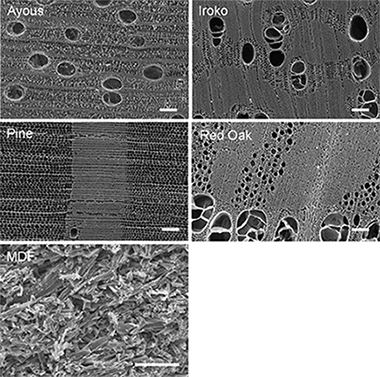
Abstract
Biomorphic SiC is a SiC/Si composite made by the reactive infiltration of molten silicon by capillarity into a carbon preform from high-temperature pyrolysis of a wood porous precursor. When excess silicon is removed, a hierarchically porous SiC material with highly interconnected porosity is obtained. By choosing different wood precursors, different pore size distributions can be obtained thus tailoring the resulting properties.
We study the thermal conductivity of porous biomorphic SiC from five different precursors, including a recycled wood product, in order to determine the microstructure-conductivity correlation. Here, we remove the excess of silicon by a high temperature capillary extraction-evaporation method. We used the laser flash technique to measure thermal diffusivity in the range similar to 300 K to 973 K, in order to determine the thermal conductivity. Thermal conductivities in the range 4-88 W/m K were achieved. The temperature, porosity, pore shape and orientation, and the treatment used to remove the remaining silicon all have a significant impact in the resulting thermal conductivity. We explain this influence in a first approximation in terms of a geometrical model.
Noviembre, 2016 · DOI: 10.1016/j.ceramint.2016.07.151
Materiales de Diseño para la Energía y Medioambiente
Enhancement of dielectric barrier layer properties by sol-gel and PECVD stacks
Lopez-Lopez, C; Menendez, MF; Menendez, LA; Menendez, A; Sanchez, P; Alba, MD; Sanchez-Cortezon, E; Delgado-Sanchez, JMSurface and Coatings Technology, 305 (2016) 36-40 DOI: 10.1016/j.surfcoat.2016.07.085
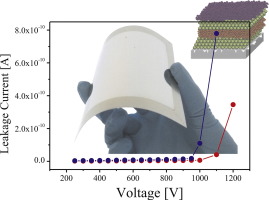
Abstract
Thin-film PV modules grown on flexible, light weight, thermally stable and low cost substrates such as stainless steel foil, are an attractive product for solar market applications. When metal foils are used as substrate, it is essential to deposit a dielectric barrier layer to isolate electrically and chemically the thin-film solar cells from the substrate. In this work, SiOx stacks deposited on ‘rough’ stainless steel by a combination of a new sol-gel formulation and a Plasma Enhanced Chemical Vapor Deposition (PECVD) deposition step are reported as a suitable dielectric barrier layer candidate. Using these SiOx multilayers, a smooth and homogeneous film was achieved. X-ray diffraction (XRD) analysis showed that back contact of the solar cell (based on Molybdenum) is not affected by the presence of the barrier layer. Moreover, according to X-ray photoelectron spectroscopy (XPS) and Secondary Ion Mass Spectrometry (SIMS) measurements, this approach led to excellent barrier layer properties against the diffusion of impurities from the stainless steel. A complete electrical characterization of these dielectric barrier layers was also carried out showing good electrical insulation.
Noviembre, 2016 · DOI: 10.1016/j.surfcoat.2016.07.085
Materiales de Diseño para la Energía y Medioambiente
Manganese Dioxide Supported on Porous Biomorphic Carbons as Hybrid Materials for Energy Storage Devices
Gutierrez-Pardo, A; Lacroix, B; Martinez-Fernandez, J; Ramirez-Rico, JACS Applied Materials & Interfaces, 8 (2016) 30890-30898 DOI: 10.1021/acsami.6b09361

Abstract
A facile and low-cost method has been employed to fabricate MnO2/C hybrid materials for use as binder-free electrodes for supercapacitor applications. Biocarbon monoliths were obtained through pyrolysis of beech wood, replicating the microstructure of the cellulosic precursor, and serve as 3D porous and conductive scaffolds for the direct growth of MnO, nanosheets by a solution method. Evaluation of the experimental results indicates that a homogeneous and uniform composite material made of a carbon matrix exhibiting ordered hierarchical porosity and MnO, nanosheets with a layered nanocrystalline structure is obtained. The tuning of the MnO2 content and crystallite size via the concentration of KMnO4 used as impregnation solution allows to obtain composites that exhibit enhanced electrochemical behavior, achieving a capacitance of 592 F g(-1) in electrodes containing 3 wt % MnO2 with an excellent cyclic stability. The electrode materials were characterized before and after electrochemical testing.
Noviembre, 2016 · DOI: 10.1021/acsami.6b09361
Materiales de Diseño para la Energía y Medioambiente
Permeability and mechanical integrity of porous biomorphic SiC ceramics for application as hot-gas filters
Gomez-Martin, A.; Orihuela, M. P.; Becerra, J. A.; Martinez-Fernandez, J.; Ramirez-Rico, J.Materials & Design, 107 (2016) 450-460 DOI: 10.1016/j.matdes.2016.06.060
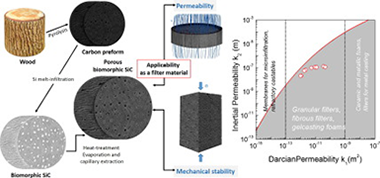
Abstract
Biomorphic SiC is a biotemplated material fabricated by Si melt-infiltration of carbon preforms from wood pyrolysis. In this work, porous bioSiC ceramics from five different wood precursors, with porosities between 45 and 72% were studied for their feasibility in filtering applications.
Gas permeability and mechanical stability were investigated as a function of the microstructure of the starting wood precursor. Air-permeation performance at room temperature was measured for a range of flow rates, and the permeability constants were assessed by fitting of Forchheimer's equation to the experimental data. Darcian permeabilities were achieved in the range 10− 11–10− 12 m2, while inertial terms were in the range 10− 7–10− 8 m, showing a correlation with the average pore size and orientation of the larger channels. Regarding the mechanical stability, maximum compressive strength values were reached in the range of 3–115 MPa.
These results improve our understanding of the ways in which the microstructure influences permeability and mechanical robustness, enabling the device requirements to be tailored by selecting the wood precursor. It was also shown that these materials are promising for hot-gas filtering applications.
Octubre, 2016 · DOI: 10.1016/j.matdes.2016.06.060
Materiales de Diseño para la Energía y Medioambiente - Materiales Nanoestructurados y Microestructura
Monolithic supports based on biomorphic SiC for the catalytic combustion of hydrogen
Arzac, G. M.; Ramirez-Rico, J.; Gutierrez-Pardo, A.; Jimenez de Haro, M. C.; Hufschmidt, D.; Martinez-Fernandez, J.; Fernandez, A.RSC Advances, 6 (2016) 66373-66384 DOI: 10.1039/c6ra09127j
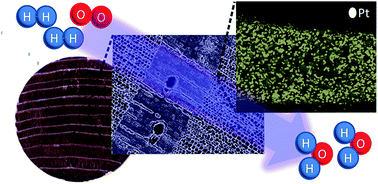
Abstract
Catalytic hydrogen combustion was studied with H-2/air mixtures in conditions that simulate the H-2 concentration of the exhaust gases from fuel cells (3-4% v/v H-2 in air). Pt-impregnated monoliths based on porous biomorphic SiC (bio-SiC) substrates were employed for the first time for this reaction. Capillary forces were exploited for the incipient impregnation of supports with H2PtCl6 solutions. Freeze drying permitted us to obtain a homogeneous distribution of the active phase reducing accumulation at the monolith's outer shell. The supports and catalysts were characterized from a structural and thermal point of view. Catalytic tests were performed in a homemade reactor fed with up to 1000 ml min(-1) H-2/air mixtures and a diffusional regime (non-isothermal) was achieved in the selected conditions. Catalyst loading was tested in the range of 0.25-1.5 wt% Pt and 100% conversion was achieved in all cases. Temperatures were recorded at different points of the monoliths during the reaction showing anisotropic thermal behavior for selected bio-SiC substrates. These effects are of interest for heat management applications and were explained in correlation with thermal conductivity measurements performed on the supports. Pt-impregnated monoliths were also tested in less than 100% conversion conditions (1% v/v H-2 in air) and in powder form in kinetic conditions for comparative purposes.
Septiembre, 2016 · DOI: 10.1039/c6ra09127j
Materiales de Diseño para la Energía y Medioambiente
Sliding wear resistance of porous biomorphic sic ceramics
Lopez-Robledo, MJ; Gomez-Martin, A; Ramirez-Rico, J; Martinez-Fernandez, JInternational Journal of Refractory Metals & Hard Materials, 59 (2016) 26-31 DOI: 10.1016/j.ijrmhm.2016.05.004
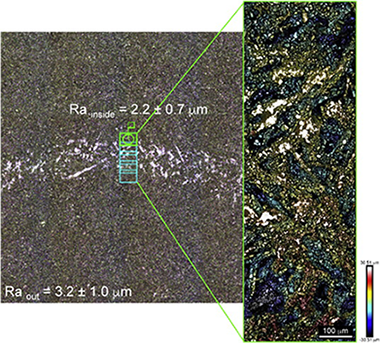
Abstract
Porous biomorphic SiC ceramics were fabricated from four different wood precursors, three natural woods and one recycled wood product, by reactive infiltration of molten silicon into a carbon preform obtained from wood pyrolysis. Sliding wear resistance when sliding against a Si3N4 ball in air was studied. Tribological experiments were done with a pin-on-disk apparatus, under normal loads of 1 and 2 N, at a sliding velocity of 100 mm/s. The wear properties and the volume fraction of porosity were correlated. A commercial sintered SiC ceramic was also tested for comparison. The measured values of friction coefficient were in the range reported in literature for monolithic SiC ceramics under similar dry contact conditions. Two concurrent wear mechanisms are taking place: abrasion from the SiC debris and soft ploughing. The presence of an oxide tribolayer was assessed using energy dispersive X-ray analysis. Wear rates were found to scale with the composite porosity.
Septiembre, 2016 · DOI: 10.1016/j.ijrmhm.2016.05.004
Materiales de Diseño para la Energía y Medioambiente
Electrochemical Energy Storage Applications of CVD Grown Niobium Oxide Thin Films
Fiz, Raquel; Appel, Linus; Gutierrez-Pardo, Antonio; Ramirez-Rico, Joaquin; Mathur, SanjayACS Applied Materials & Interfaces, 8 (2016) 21423–21430 DOI: 10.1021/acsami.6b03945
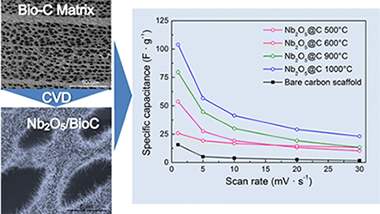
Abstract
We report here on the controlled synthesis, characterization, and electrochemical properties of different polymorphs of niobium pentoxide grown by CVD of new single-source precursors. Nb2O5 films deposited at different temperatures showed systematic phase evolution from low-temperature tetragonal (TT-Nb2O5, T-Nb2O5) to high temperature monoclinic modifications (H–Nb2O5). Optimization of the precursor flux and substrate temperature enabled phase-selective growth of Nb2O5 nanorods and films on conductive mesoporous biomorphic carbon matrices (BioC). Nb2O5 thin films deposited on monolithic BioC scaffolds produced composite materials integrating the high surface area and conductivity of the carbonaceous matrix with the intrinsically high capacitance of nanostructured niobium oxide. Heterojunctions in Nb2O5/BioC composites were found to be beneficial in electrochemical capacitance. Electrochemical characterization of Nb2O5/BioC composites showed that small amounts of Nb2O5 (as low as 5%) in conjunction with BioCarbon resulted in a 7-fold increase in the electrode capacitance, from 15 to 104 F g–1, while imparting good cycling stability, making these materials ideally suited for electrochemical energy storage applications.
Agosto, 2016 · DOI: 10.1021/acsami.6b03945
Materiales de Diseño para la Energía y Medioambiente
Stress measurement using area detectors: a theoretical and experimental comparison of different methods in ferritic steel using a portable X-ray apparatus
Ramirez-Rico, J; Lee, SY; Ling, JJ; Noyan, ICJournal of Materials Science, 51 (2016) 5343-5355 DOI: 10.1007/s10853-016-9837-3
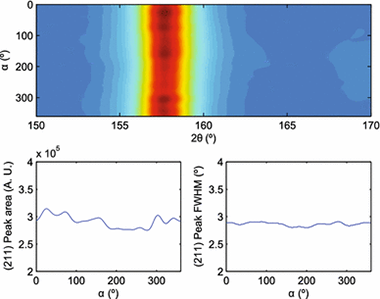
Abstract
Using area detectors for stress determination by diffraction methods in a single exposure greatly simplifies the measurement process and permits the design of portable systems without complex sample cradles or moving parts. An additional advantage is the ability to see the entire or a large fraction of the Debye ring and thus determine texture and grain size effects before analysis. The two methods most commonly used to obtain stress from a single Debye ring are the so-called cosαcosαand full-ring fitting methods, which employ least-squares procedures to determine the stress from the distortion of a Debye ring by probing a set of scattering vector simultaneously. The widely applied sin2ψsin2ψ method, in contrast, requires sample rotations to probe a different subset of scattering vector orientations. In this paper, we first present a description of the different methods under the same formalism and using a unified set of coordinates that are suited to area detectors normal to the incident beam, highlighting the similarities and differences between them. We further characterize these methods by means of in situ measurements in carbon steel tube samples, using a portable detector in reflection geometry. We show that, in the absence of plastic flow, the different methods yield basically the same results and are equivalent. An analysis of possible sources of errors and their impact in the final stress values is also presented.
Junio, 2016 · DOI: 10.1007/s10853-016-9837-3
Materiales de Diseño para la Energía y Medioambiente
Thermal conductivity of Fe graphitized wood derived carbon
Ramirez-Rico, J; Gutierrez-Pardo, A; Martinez-Fernandez, J; Popov, VV; Orlova, TSMaterials & Design, 99 (2016) 528-534 DOI: 10.1016/j.matdes.2016.03.070

Abstract
Graphitic porous carbon materials from pyrolysis of wood precursors were obtained by means of a nanosized Fe catalyst, and their microstructure and electrical and thermal transport properties investigated. Thermal and electrical conductivity of graphitized carbon materials increase with the pyrolysis temperature, indicating a relationship between the degree of graphitization and thus in crystallite size with transport properties in the resulting carbon scaffolds. Evaluation of the experimental results indicate that thermal conductivity is mainly through phonons and increases with the temperature in Fe-catalyzed carbons suggesting that the mean free path of phonons in the material is small and defect scattering dominates over phonon-phonon interactions in the range from room temperature to 800 °C.
Junio, 2016 · DOI: 10.1016/j.matdes.2016.03.070
Materiales de Diseño para la Energía y Medioambiente
Biodegradable polyester films from renewable aleuritic acid: surface modifications induced by melt-polycondensation in air
Benitez, JJ; Heredia-Guerrero, JA; de Vargas-Parody, MI; Cruz-Carrillo, MA; Morales-Florez, V; de la Rosa-Fox, N; Heredia, AJournal of Physics D-Applied Physics, 49 (2016) 175601 DOI: 10.1088/0022-3727/49/17/175601
Abstract
Good water barrier properties and biocompatibility of long-chain biopolyesters like cutin and suberin have inspired the design of synthetic mimetic materials. Most of these biopolymers are made from esterified mid-chain functionalized.-long chain hydroxyacids. Aleuritic (9,10,16-trihydroxypalmitic) acid is such a polyhydroxylated fatty acid and is also the major constituent of natural lac resin, a relatively abundant and renewable resource. Insoluble and thermostable films have been prepared from aleuritic acid by melt-condensation polymerization in air without catalysts, an easy and attractive procedure for large scale production. Intended to be used as a protective coating, the barrier's performance is expected to be conditioned by physical and chemical modifications induced by oxygen on the air-exposed side. Hence, the chemical composition, texture, mechanical behavior, hydrophobicity, chemical resistance and biodegradation of the film surface have been studied by attenuated total reflection-Fourier transform infrared spectroscopy (ATR-FTIR), atomic force microscopy (AFM), nanoindentation and water contact angle (WCA). It has been demonstrated that the occurrence of side oxidation reactions conditions the surface physical and chemical properties of these polyhydroxyester films. Additionally, the addition of palmitic acid to reduce the presence of hydrophilic free hydroxyl groups was found to have a strong influence on these parameters.
Mayo, 2016 · DOI: 10.1088/0022-3727/49/17/175601
Materiales de Diseño para la Energía y Medioambiente
Biological strategy for the fabrication of highly ordered aragonite helices: the microstructure of the cavolinioidean gastropods
Checa, AG; Macias-Sanchez, E; Ramirez-Rico, JScientific Reports, 6 (2016) article number 25989 DOI: 10.1038/srep25989
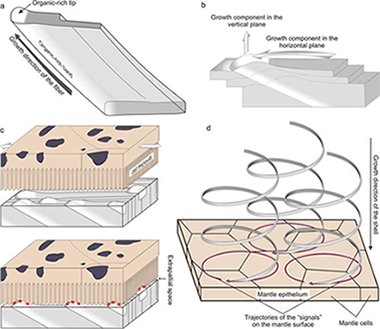
Abstract
The Cavolinioidea are planktonic gastropods which construct their shells with the so-called aragonitic helical fibrous microstructure, consisting of a highly ordered arrangement of helically coiled interlocking continuous crystalline aragonite fibres. Our study reveals that, despite the high and continuous degree of interlocking between fibres, every fibre has a differentiated organic-rich thin external band, which is never invaded by neighbouring fibres. In this way, fibres avoid extinction. These intra-fibre organic-rich bands appear on the growth surface of the shell as minuscule elevations, which have to be secreted differentially by the outer mantle cells. We propose that, as the shell thickens during mineralization, fibre secretion proceeds by a mechanism of contact recognition and displacement of the tips along circular trajectories by the cells of the outer mantle surface. Given the sizes of the tips, this mechanism has to operate at the subcellular level. Accordingly, the fabrication of the helical microstructure is under strict biological control. This mechanism of fibre-by-fibre fabrication by the mantle cells is unlike that any other shell microstructure.
Mayo, 2016 · DOI: 10.1038/srep25989
Materiales de Diseño para la Energía y Medioambiente
Strength and microplasticity of biocarbons prepared by carbonization in the presence of a catalyst
Shpeizman, VV; Orlova, TS; Smirnov, BI; Gutierrez-Pardo, A; Ramirez-Rico, JPhysics of the Solid State, 58 (2016) 703-710 DOI: 10.1134/S1063783416040223
Abstract
The microdeformation has been investigated under uniaxial compression of beech-derived biocarbons partially graphitized during carbonization in the presence of a Ni- or Fe-containing catalyst. The strength and ultimate fracture strain have been determined at different temperatures of carbonization of the samples in the absence or in the presence of a catalyst. It has been shown using high-precision interferometry that the deformation of biocarbon samples under uniaxial loading occurs through jumps (in magnitude and rate of deformation) with axial displacements in the nanometer and micrometer ranges. The use of a catalyst leads to a decrease in the size of nanometer-scale jumps and in the number of micrometer-scale jumps. The standard deviations of the strain rate on loading steps from the smooth average dependence of the strain rate on the displacement have been calculated for micrometer-scale jumps. A similar characteristic for nanometer- scale jumps has been determined from the distortion of the shape of beats in the primary interferogram. It has been shown that the variation in the standard deviation of the strain rate with a change in the carbonization temperature is similar to the corresponding dependence of the ultimate fracture strain.
Abril, 2016 · DOI: 10.1134/S1063783416040223
Materiales de Diseño para la Energía y Medioambiente
Active metal brazing of silicon nitride ceramics using a Cu-based alloy and refractory metal interlayers
Fernandez, JM; Asthana, R; Singh, M; Valera, FMCeramics International, 42 (2016) 5447-5454 DOI: 10.1016/j.ceramint.2015.12.087

Abstract
Silicon nitride/silicon nitride joints with refractory metal (W and Mo) interlayers were vacuum brazed using an active braze, Cu-ABA (Cu-3Si-2Al-2.25Ti, wt%), and two interlayer arrangements in a double-lap offset configuration: Si3N4/Cu-ABA/W/Cu-ABA/Mo/Cu-ABA/Si3N4 and Si3N4/Cu-ABA /Si3N4. Titanium segregated at the Si3N4/Cu-ABA and Mo/Cu-ABA interfaces, but not at the W/Cu-ABA interface. The room-temperature compression-shear strength values of Si3N4/Cu-ABA/Si3N4 and Si3N4/Cu-ABA/W/Cu-ABA/Mo/Cu-ABA/Si3N4 joints were 118 +/- 24 MPa and 22 +/- 5 MPa, respectively. Elevated-temperature compression tests showed that Si3N4/Cu-ABA/Si3N4 joints had strength of 31 +/- 6 MPa at 1023 K and 17 +/- 3 MPa at 1073 K. Likewise, Si3N4/Cu-ABA/W/Cu-ABA/Mo/Cu-ABA/Si3N4 joints had strength of 19 +/- 4 MPa at 1023 K and 13 +/- 3 MPa at 1073 K. Knoop microhardness profiles revealed hardness gradients across the joints. The effect of joint microstructure and test configuration on the mechanical behavior is discussed.
Marzo, 2016 · DOI: 10.1016/j.ceramint.2015.12.087
Materiales de Diseño para la Energía y Medioambiente
Influence of temperature and time on the Eu3+ reaction with synthetic Na-Mica-n (n=2 and 4)
Garcia-Jimenez, MJ; Cota, A; Osuna, FJ; Pavon, E; Alba, MDChemical Engineering Journal, 284 (2016) 1174-1183 DOI: 10.1016/j.cej.2015.09.077
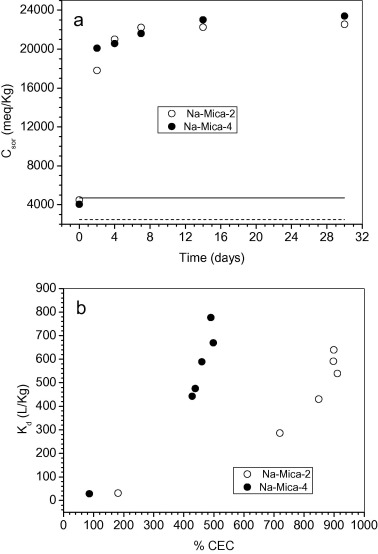
Abstract
Bentonite is accepted as the best clay material for the engineered barrier of Deep Geological Repositories (DGRs). The performance of clay as the main component of the engineered barrier in the DGR has been intensively studied and the structure of the selected clay mineral play a crucial role. In this sense, a new family of synthetic swelling silicates, Na-Mica-n, with tuned layer charge (n) values between 2.0 and 4.0 per unit cell has recently been synthesized and a general synthetic method has been reported. These swelling high-charge micas could be highly valuable for the decontamination of harmful cations. The ability of these micas to immobilize Eu3+ under subcritical conditions has been probed. The adsorption was in both non-specific sites (cation exchange mechanism) and specific sites (chemical reaction or surface defects adsorption). Moreover, its adsorption capacity, under the same conditions is higher than in saponite and far superior to the bentonites.
Enero, 2016 · DOI: 10.1016/j.cej.2015.09.077
Materiales de Diseño para la Energía y Medioambiente
Thermal conductivity of partially graphitized biocarbon obtained by carbonization of medium-density fiberboard in the presence of a Ni-based catalyst
Orlova, TS; Parfen'eva, LS; Smirnov, BI; Gutierrez-Pardo, A; Ramirez-Rico, JPhysics of the Solid State, 58 (2016) 208-214 DOI: 10.1134/S1063783416010236
Abstract
The thermal conductivity k and resistivity rho of biocarbon matrices, prepared by carbonizing medium-density fiberboard at T (carb) = 850 and 1500A degrees C in the presence of a Ni-based catalyst (samples MDF-C( Ni)) and without a catalyst (samples MDF-C), have been measured for the first time in the temperature range of 5-300 K. X-ray diffraction analysis has revealed that the bulk graphite phase arises only at T (carb) = 1500A degrees C. It has been shown that the temperature dependences of the thermal conductivity of samples MDFC- 850 and MDF-C-850(Ni) in the range of 80-300 K are to each other and follow the law of k(T) similar to T (1.65), but the use of the Ni-catalyst leads to an increase in the thermal conductivity by a factor of approximately 1.5, due to the formation of a greater fraction of the nanocrystalline phase in the presence of the Ni-catalyst at T (carb) = 850A degrees C. In biocarbon MDF-C-1500 prepared without a catalyst, the dependence is k(T) similar to T (1.65), and it is controlled by the nanocrystalline phase. In MDF-C-1500(Ni), the bulk graphite phase formed increases the thermal conductivity by a factor of 1.5-2 compared to the thermal conductivity of MDF-C-1500 in the entire temperature range of 5-300 K; k(T = 300 K) reaches the values of similar to 10 W m(-1) K-1, characteristic of biocarbon obtained without a catalyst only at high temperatures of T (carb) = 2400A degrees C. It has been shown that MDF-C-1500(Ni) in the temperature range of 40aEuro'300 K is characterized by the dependence, k(T) similar to T (1.3), which can be described in terms of the model of partially graphitized biocarbon as a composite of an amorphous matrix with spherical inclusions of the graphite phase.
Enero, 2016 · DOI: 10.1134/S1063783416010236
2015
2015
Materiales de Diseño para la Energía y Medioambiente
Impact of hydrothermal treatment of FEBEX and MX80 bentonites in water, HNO3 and Lu(NO3)(3) media: Implications for radioactive waste control
Osuna, FJ; Chain, P; Cota, A; Pavon, E; Alba, MDApplied Clay Science, 118 (2015) 48-55 DOI: 10.1016/j.clay.2015.08.036
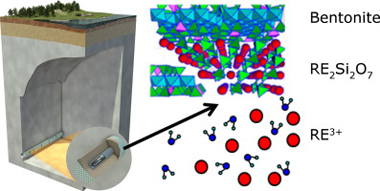
Abstract
Engineered barriers of deep geological repositories (DGR) are commonly constructed with bentonite. FEBEX and MX80 bentonites have been selected by different countries as reference materials for the sealing of repositories; however, their chemical reactivity with high-level long-lived radioactive wastes (HLRW) under subcritical conditions had not been explored before. The hydrothermal stability in neutral and acid media and chemical reactivity in contact with an actinide analogous compound were both studied. The long-range and short-range structural changes were analyzed by X-ray diffraction, nuclear magnetic resonance and scanning electron microscopy. Both bentonites have exhibited a good stability in neutral and acid media and have generated a new phase immobilizing the actinide analogous compound. The extent of the chemical reaction is higher in MX80 bentonite than in FEBEX bentonite.
Diciembre, 2015 · DOI: 10.1016/j.clay.2015.08.036
Materiales de Diseño para la Energía y Medioambiente
Specific features of the electrical properties in partially graphitized porous biocarbons of beech wood
Popov, VV; Orlova, TS; Gutierrez-Pardo, A; Ramirez-Rico, JPhysics of the solid state, 57 (2015) 1746-1751 DOI: 10.1134/S1063783415090280
Abstract
The electrical and galvanomagnetic properties of partially graphitized highly porous bioC(Ni) biocarbon matrices produced by pyrolysis (carbonization) of beech wood at temperatures T (carb) = 850-1600A degrees C in the presence of a Ni-containing catalyst have been studied in comparison with their microstructural features. The temperature dependences of the resistivity, the magnetoresistance, and the Hall coefficient have been measured in the temperature range of 4.2-300 K in magnetic fields to 28 kOe. It has been shown that an additional graphite phase introduction into samples with T (carb) a parts per thousand yen 1000A degrees C results in an increase in the carrier mobility by a factor of 2-3, whereas the carrier (hole) concentration remains within similar to 10(20) cm(-3), as in biocarbons obtained without catalyst. An analysis of experimental data has demonstrated that the features of the conductivity and magnetoresistance of these samples are described by quantum corrections related to their structural features, i.e., the formation of a globular graphite phase of nano- and submicrometer sizes in the amorphous matrix. The quantum corrections to the conductivity decrease with increasing carbonization temperature, which indicates an increase in the degree of structure ordering and is in good agreement with microstructural data.
Septiembre, 2015 · DOI: 10.1134/S1063783415090280
Materiales de Diseño para la Energía y Medioambiente
Viability of adding gypsum and calcite for remediation of metal-contaminated soil: laboratory and pilot plant scales
Gonzalez-Nunez, R; Alba, MD; Vidal, M; Rigol, AInternational Journal of Environmental Science and Technology, 12 (2015) 2697-2710 DOI: 10.1007/s13762-014-0671-3
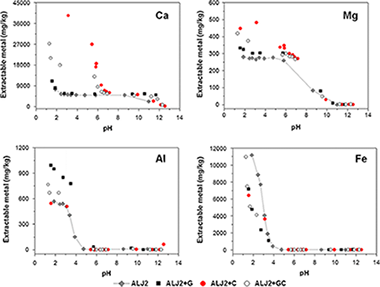
Abstract
The effect of adding waste materials (gypsum and calcite) for the remediation of a soil contaminated by pyritic minerals was examined. Materials were characterised in terms of their acid neutralisation capacity (ANC), sorption capacity and structural components. Their effect on the contaminant leaching in soil + material mixtures over a wide range of pH was also evaluated. Results at laboratory and pilot plant scales were compared to account for the potential variability in the material efficiency when applied at larger scale. The use of gypsum permitted its valorisation, although calcite was a more effective amendment because its addition led to a greater increase in the pH and acid neutralisation capacity, and thus in the sorption capacity in the resulting soil + material mixture. In the same way, when the combination of gypsum + calcite was added to the soil, it led to an increase in the pH from 2.5 to 6.9 and in the ANC from −86 to 1,513 meq/kg. As a result, the concentration of extractable heavy metals and As was reduced, and they were successfully immobilised both at laboratory and at pilot plant scales. Thus, the use of these materials induced a significant reduction in the contaminant mobility and permitted the valorisation of waste materials.
Agosto, 2015 · DOI: 10.1007/s13762-014-0671-3
Materiales de Diseño para la Energía y Medioambiente
Uranium immobilization by FEBEX bentonite and steel barriers in hydrothermal conditions
Villa-Alfageme, M; Hurtado, S; El Mrabet, S; Pazos, MC; Castro, MA; Alba, MDChemical Engineering Journal, 269 (2015) 279-287 DOI: 10.1016/j.cej.2015.01.134
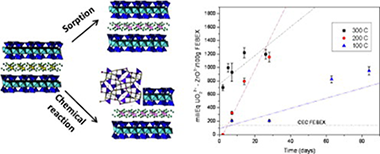
Abstract
FEBEX clay is considered a reference material in engineered barriers for safe storage of nuclear waste and uranium is a minor component of high-level radioactive waste (HLRW) and a main component of the spent nuclear fuel (SNF). Here, the kinetics of reaction of uranium with FEBEX was investigated in addition to the uranium immobilisation ability and the structural analysis of the reaction products. Hydrothermal treatments were accomplished with UO22+ and tetravalent actinide simulator ZrO2+, also present in HLRW. The quantification of the reaction was performed through gamma spectrometry of uranium. Two mechanisms for UO22+ retention by FEBEX were detected: adsorption and formation of stable and insoluble new phases. The structural analyses performed using ZrO2+, confirmed the uranium adsorption and the presence of new phases, ZrO2 and Zr(SiO4), that emphasise the existence of a chemical reaction with the bentonite. The analysis of the velocity of reaction uranium-clay minerals revealed temperature dependence. An exponential fitting suggested that the removal of uranium from solution at temperatures over 200 °C could be completed in less than a year. For lower temperatures, several years are needed. Milliequivalents of UO22+ immobilised by the clay depended on temperature and time and were over cation exchange capacity (CEC) of FEBEX even at 100 °C (reaching 600% of CEC). The reaction with steel, also temperature dependent, was finally analysed. At 200 °C 40–70% of uranium reacted with steel. But only 30–15% reacted at 300 °C and 100 °C. The reactions provide a stable immobilisation mechanism for uranium even when its sorption and swelling capacities fail. Our experiments will be of particular interest for very deep borehole disposals were higher temperatures and pressures are expected.
Junio, 2015 · DOI: 10.1016/j.cej.2015.01.134
Materiales de Diseño para la Energía y Medioambiente
Self-Assembling of Tetradecylammonium Chain on Swelling High Charge Micas (Na-Mica-3 and Na-Mica-2): Effect of Alkylammonium Concentration and Mica Layer Charge
Pazos, MC; Cota, A; Osuna, FJ; Pavon, E; Alba, MDLangmuir, 31 (2015) 4394-4401 DOI: 10.1021/acs.langmuir.5b00224
Abstract
A family of tetradecylammonium micas is synthesized using synthetic swelling micas with high layer charge (NanSi8-nAln,Mg6F4O20 center dot XH2O, where n = 2 and 3) exchanged with tetradecylammonium cations. The molecular arrangement of the surfactant is,elucidated on the basis of XRD patterns and DTA. The ordering conformation of the surfactant molecules into the interlayer space of Micas is investigated by IR/FT, C-13, Al-27, and Si-29 MAS NMR. The structural arrangement of the tetradecylammonium cation in the interlayer space of high-charge micas is more sensitive to the effect of the mica layer charge at high concentration. The surfactant arrangement is found to follow the bilayer-paraffin model for all values of layer charge and surfactant concentration. However, at initial concentration below the mica CEC, a lateral monolayer is also observed. The amount of ordered conformation all-trans is directly proportional to the layer charge and surfactant concentration.
Abril, 2015 · DOI: 10.1021/acs.langmuir.5b00224
Materiales de Diseño para la Energía y Medioambiente
Pectin-Lipid Self-Assembly: Influence on the Formation of Polyhydroxy Fatty Acids Nanoparticles
Guzman-Puyol, Susana; Jesus Benitez, Jose; Dominguez, Eva; Bayer, Ilker Sefik; Cingolani, Roberto; Athanassiou, Athanassia; Heredia, Antonio; Heredia-Guerrero, Jose AlejandroPLoS One, 10 (2015) e0124639 DOI: 10.1371/journal.pone.0124639
Abstract
Nanoparticles, named cutinsomes, have been prepared from aleuritic (9,10,16-trihidroxipalmitic) acid and tomato fruit cutin monomers (a mixture of mainly 9(10), 16-dihydroxypalmitic acid (85%, w/w) and 16-hydroxyhexadecanoic acid (7.5%, w/w)) with pectin in aqueous solution. The process of formation of the nanoparticles of aleuritic acid plus pectin has been monitored by UV-Vis spectrophotometry, while their chemical and morphological characterization was analyzed by ATR-FTIR, TEM, and non-contact AFM. The structure of these nanoparticles can be described as a lipid core with a pectin shell. Pectin facilitated the formation of nanoparticles, by inducing their aggregation in branched chains and favoring the condensation between lipid monomers. Also, pectin determined the self-assembly of cutinsomes on highly ordered pyrolytic graphite (HOPG) surfaces, causing their opening and forming interconnected structures. In the case of cutin monomers, the nanoparticles are fused, and the condensation of the hydroxy fatty acids is strongly affected by the presence of the polysaccharide. The interaction of pectin with polyhydroxylated fatty acids could be related to an initial step in the formation of the plant biopolyester cutin.
Abril, 2015 · DOI: 10.1371/journal.pone.0124639
Materiales de Diseño para la Energía y Medioambiente
Synthesis temperature effect on Na-Mica-4 crystallinity and heteroatom distribution
Naranjo, M; Castro, MA; Cota, A; Osuna, FJ; Pavon, E; Alba, MDMicroporous and Mesoporous Materials, 204 (2015) 282-288 DOI: 10.1016/j.micromeso.2014.11.026
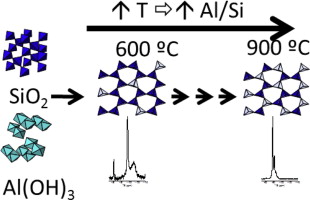
Abstract
The discovery of swelling brittle mica, Na-Mica-4, has been one of the most significant advances in the pursuit for a material with high ion-exchange capacity. For technical applications, the control of the phase evolution during the synthesis is crucial. The main aim of this study was to investigate the effect of Na-Mica-4 synthesis temperature on the crystalline phase evolution, Si–Al distribution in the tetrahedral sheet, the Al occupancy between tetrahedral and octahedral sites and their effects on the interlayer space composition. The synthesis temperature range between 600 °C and 900 °C was explored. At low temperature (600 °C), the precursors were transformed in a low-charged swelling 2:1 phyllosilicate, saponite type, which was progressively aluminum enriched with temperature. The high-charged swelling mica was completely formed at 700 °C, although a minor anhydrous contribution remained up to 850 °C. Up to 800 °C, silicates and fluorides secondary phases were detected as a minor contribution.
Marzo, 2015 · DOI: 10.1016/j.micromeso.2014.11.026
Materiales de Diseño para la Energía y Medioambiente
Effect of catalytic graphitization on the electrochemical behavior of wood derived carbons for use in supercapacitors
Gutierrez-Pardo, A; Ramirez-Rico, J; Cabezas-Rodriguez, R; Martinez-Fernandez, JJournal of Power Sources, 278 (2015) 18-26 DOI: 10.1016/j.jpowsour.2014.12.030
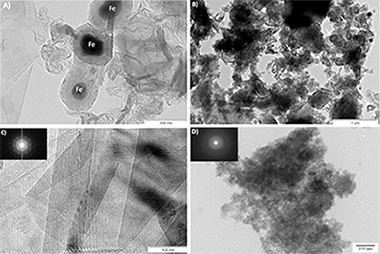
Abstract
Porous graphitic carbons were successfully obtained from wood precursors through pyrolysis using a transition metal as catalyst. Once the catalyst is removed, the resulting material mimics the microstructure of the wood and presents high surface area, open and interconnected porosity and large pore volume, high crystallinity and good electrical conductivity, making these carbons interesting for electrochemical devices. Carbons obtained were studied as electrodes for supercapacitors in half cell experiments, obtaining high capacitance values in a basic media (up to 133 F g−1 at current densities of 20 mA g−1 and 35 F g−1 at current densities of 1 A g−1). Long-cycling experiments showed excellent stability of the electrodes with no reduction of the initial capacitance values after 1000 cycles in voltammetry.
Marzo, 2015 · DOI: 10.1016/j.jpowsour.2014.12.030
Materiales de Diseño para la Energía y Medioambiente
Microstructure, elastic and inelastic properties of partially graphitized biomorphic carbons
Orlova, TS; Kardashev, BK; Smirnov, BI; Gutierrez-Pardo, A; Ramirez-Rico, J; Martinez-Fernandez, JPhysics of the Solid State, 57 (2015) 586-591 DOI: 10.1134/S106378341503018X

Abstract
The microstructural characteristics and amplitude dependences of the Young's modulus E and internal friction (logarithmic decrement delta) of biocarbon matrices prepared by beech wood carbonization at temperatures T (carb) = 850-1600A degrees C in the presence of a nickel-containing catalyst have been studied. Using X-ray diffraction and electron microscopy, it has been shown that the use of a nickel catalyst during carbonization results in a partial graphitization of biocarbons at T (carb) a parts per thousand yen 1000A degrees C: the graphite phase is formed as 50- to 100-nm globules at T (carb) = 1000A degrees C and as 0.5- to 3.0-mu m globules at T (carb) = 1600A degrees C. It has been found that the measured dependences E(T (carb)) and delta(T (carb)) contain three characteristic ranges of variations in the Young's modulus and logarithmic decrement with a change in the carbonization temperature: E increases and delta decreases in the ranges T (carb) < 1000A degrees C and T (carb) > 1300A degrees C; in the range 1000 < T (carb) < 1300A degrees C, E sharply decreases and delta increases. The observed behavior of E(T (carb)) and delta(T (carb)) for biocarbons carbonized in the presence of nickel correlates with the evolution of their microstructure. The largest values of E are obtained for samples with T (carb) = 1000 and 1600A degrees C. However, the samples with T (carb) = 1600A degrees C exhibit a higher susceptibility to microplasticity due to the presence of a globular graphite phase that is significantly larger in size and total volume.
Marzo, 2015 · DOI: 10.1134/S106378341503018X
Materiales de Diseño para la Energía y Medioambiente
Sliding wear resistance of biomorphic SiC ceramics
Vera, MC; Ramirez-Rico, J; Martinez-Fernandez, J; Singh, MInternational Journal of Refractory Metals & Hard Materials, 49 (2015) 327-333 DOI: 10.1016/j.ijrmhm.2014.07.004
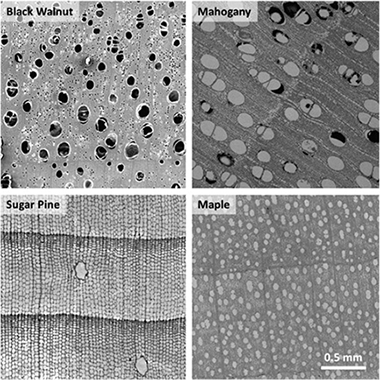
Abstract
Biomorphic SiC ceramics were fabricated from four different wood precursors and their Knoop hardness and sliding wear resistance when sliding against a Si3N4 ball in air were studied. Tribological experiments were performed using a pin on disk apparatus, under normal loads of 2 and 5 N, at a sliding speed of 100 mm/s. The effects of specimen porosity and microstructure on measured wear were evaluated. A commercial sintered silicon carbide ceramic was also tested for comparison. Small differences in friction coefficient comparable to monolithic SiC ceramics were obtained. Several concurrent wear mechanisms are taking place: microfracture, plastic deformation in the Si phase and oxidation of the Si and/or SiC phase. The presence of an oxide tribolayer was assessed using fluorescence microscopy. Wear rates were found to scale with SiC content and depend on residual porosity in the composite.
Marzo, 2015 · DOI: 10.1016/j.ijrmhm.2014.07.004
Materiales de Diseño para la Energía y Medioambiente
Sliding wear resistance of sintered SiC-fiber bonded ceramics
Vera, MC; Ramirez-Rico, J; Martinez-Fernandez, J; Singh, MInternational Journal of Refractory Metals & Hard Materials, 49 (2015) 232-239 DOI: 10.1016/j.ijrmhm.2014.06.020
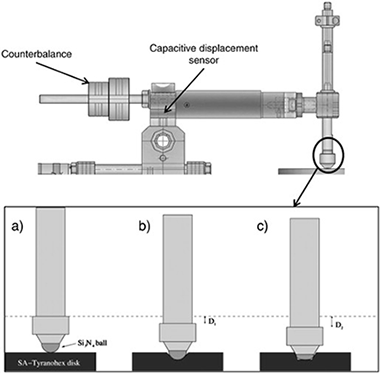
Abstract
Advanced SiC-based ceramics and fiber reinforced composites are interesting materials for a wide variety of applications involving sliding wear conditions because of their excellent thermomechanical properties. The microstructure and wear resistance of sintered SiC fiber bonded ceramics (SA Tyrannohex) were studied. The material is composed of SiC-fibers in two orientations, with polygonal cross sections and cores having higher carbon content than their surroundings, as observed with SEM. A thin layer of C exists between the fibers. This layer has been found to be a turbostratic-layered structure oriented parallel to the fiber surface. XRD shows that the material is highly crystalline and composed mostly of β-SiC. Unlubricated wear behavior of the SA-Tyrannohex material when sliding against a Si3N4 ball in air at room temperature was evaluated. Experiments were performed using a pin on disk apparatus, under different normal loads of 2, 5 and 10 N at sliding speeds of 25, 50, 100 mm/s. A decrease of the friction coefficient with load was found due to the presence of the turbostratic carbon layer between the fibers. Wear rates of the order of 100 mm3/MJ were obtained, independently of sliding speed. Microfracture of the fibers is the main wear mechanism.
Marzo, 2015 · DOI: 10.1016/j.ijrmhm.2014.06.020
Materiales de Diseño para la Energía y Medioambiente
Polyester Films Obtained by Noncatalyzed Melt-Condensation Polymerization of Aleuritic (9,10,16-Trihydroxyhexadecanoic) Acid in Air
Benitez, JJ; Heredia-Guerrero, JA; Guzman-Puyol, S; Dominguez, E; Heredia, AJournal of Applied Polymer, 132 (2015) Art. 41328 DOI: 10.1002/app.41328
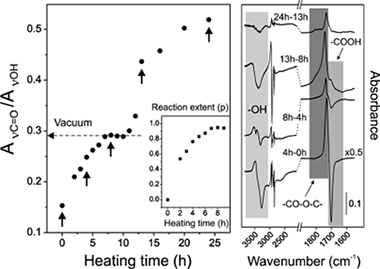
Abstract
To mimic nontoxic and fully biodegradable biopolymers like the plant cutin, polyester films from a natural occurring fatty polyhydroxyacid like aleuritic (9,10,16-trihydroxyhexadecanoic) acid have been prepared by noncatalyzed melt-polycondensation at moderate temperature (150 degrees C) directly in air. The course of the reaction has been followed by infrared spectroscopy, C-13 magic angle spinning nuclear magnetic resonance spectroscopy, differential scanning calorimetry and X-ray diffraction and well differentiated stages are observed. First, a high conversion esterification reaction leads to an amorphous rubbery, infusible, and insoluble material whose structure is made out of ester linkages mostly involving primary hydroxyls and partially branched by minor esterification with secondary ones. Following the esterification stage, the cleavage of vicinal secondary hydroxyls and further oxidation to carboxylic acid is observed at the near surface region of films. New carboxylic groups created also undergo esterification and generate cross-linking points within the polymer structure. Additionally, and despite the harsh preparation conditions used, very little additional side reaction like peroxidation and dehydration are observed. Results demonstrate the feasibility of polyester films fabrication from a reference fatty polyhydroxyacid like aleuritic acid by noncatalyzed melt-polycondensation directly in air. The methodology can potentially be extended to similar natural occurring hydroxyacids to obtain films and coatings to be used, for instance, as nontoxic and biodegradable food packaging material.
Febrero, 2015 · DOI: 10.1002/app.41328
Materiales de Diseño para la Energía y Medioambiente
Long-Chain Polyhydroxyesters from Natural Occurring Aleuritic Acid as Potential Material for Food Packaging
Benitez, JJ; Heredia-Guerrero, JA; Guzman-Puyol, S; Dominguez, E; Heredia, ASoft Materials, 13 (2015) 5-11 DOI: 10.1080/1539445X.2014.993476
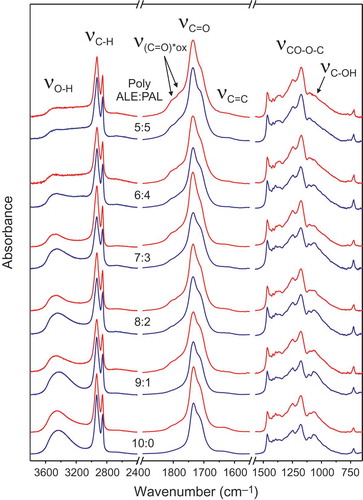
Abstract
Fatty polyhydroxyesters (C≥16) are present in nature as barrier polymers like cutin in some protective tissues of higher plants. The mimicry of these biopolymers is regarded as a strategy to design nontoxic and fully biodegradable food packaging films and coatings. To obtain cutin inspired materials we have used a natural occurring polyhydroxylated monomer like aleuritic (9,10,16-trihydroxypalmitic) acid and a direct and scalable synthesis route consisting in the noncatalyzed melt-condensation polymerization in air. To reduce the number of hydroxyl groups and to increase hydrophobicity, palmitic acid has been used as a capping agent. Aleuritic-palmitic polyhydroxyesteres films have been obtained and characterized.
Enero, 2015 · DOI: 10.1080/1539445X.2014.993476
2014
2014
Materiales de Diseño para la Energía y Medioambiente
Enhanced activity of clays and its crucial role for the activity in ethylene polymerization
Camejo-Abreu, C; Tabernero, V; Alba, MD; Cuenca, T; Terreros, PJournal of Molecular Catalysis A-Chemical, 393 (2014) 96-104 DOI: 10.1016/j.molcata.2014.05.030
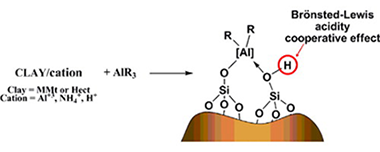
Abstract
This paper presents a study of the effects of different treatments on the polymerization activity of modified clays as cocatalysts. To achieve this goal, an intercalating cation was introduced into two smectites and these clays were then modified with trimethyl aluminium. The results for ethylene polymerization, when a zirconocene complex was used as catalyst, and the structure analysis, allow us to obtain interesting deductions about the generation mode of the active species. All active materials employed as support activators presented aluminium in a pentahedral environment together with acidic hydrogen atoms. These two features were detected only after TMA treatment and they seem to be crucial elements in active cocatalyst generation. Moreover, a material without structural aluminium displayed the best activity pointing to the new aluminium species generated in the solid matrix as the determining factor for the activity. We proposed a synergic effect between Lewis acid aluminium centres and acidic Bronsted protons that generate the SiOHAl groups that activate the zirconium compound.
Noviembre, 2014 · DOI: 10.1016/j.molcata.2014.05.030
Materiales de Diseño para la Energía y Medioambiente
Ceramic Barrier Layers for Flexible Thin Film Solar Cells on Metallic Substrates: A Laboratory Scale Study for Process Optimization and Barrier Layer Properties
Delgado-Sanchez, JM; Guilera, N; Francesch, L; Alba, MD; Lopez, L; Sanchez, EACS Applied Materials & Interfaces, 6 (2014) 18543-18549 DOI: 10.1021/am504923z

Abstract
Flexible thin film solar cells are an alternative to both utility-scale and building integrated photovoltaic installations. The fabrication of these devices over electrically conducting low-cost foils requires the deposition of dielectric barrier layers to flatten the substrate surface, provide electrical isolation between the substrate and the device, and avoid the diffusion of metal impurities during the relatively high temperatures required to deposit the rest of the solar cell device layers. The typical roughness of low-cost stainless-steel foils is in the hundred-nanometer range, which is comparable or larger than the thin film layers comprising the device and this may result in electrical shunts that decrease solar cell performance. This manuscript assesses the properties of different single-layer and bilayer structures containing ceramics inks formulations based on Al2O3, AlN, or Si3N4 nanoparticles and deposited over stainless-steel foils using a rotogravure printing process. The best control of the substrate roughness was achieved for bilayers of Al2O3 or AlN with mixed particle size, which reduced the roughness and prevented the diffusion of metals impurities but AlN bilayers exhibited as well the best electrical insulation properties.
Noviembre, 2014 · DOI: 10.1021/am504923z
Materiales de Diseño para la Energía y Medioambiente
Quantification and comparison of the reaction properties of FEBEX and MX-80 clays with saponite: Europium immobilisers under subcritical conditions
Villa-Alfageme, M; Hurtado, S; Castro, MA; El Mrabet, S; Orta, MM; Pazos, MC; Alba, MDApplied Clay Science, 101 (2014) 10-15 DOI: 10.1016/j.clay.2014.08.012
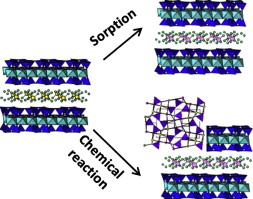
Abstract
The evaluation of the retention mechanisms in FEBEX and MX-80 bentonites, selected as reference materials to construct engineered barriers, carries major implications in the safe storage of immobilisation capacity through a recently discovered chemical retention mechanism and the structural analysis of the reaction products. Hydrothermal treatments were accomplished with immobilisation capacity through a recently discovered chemical retention mechanism and the structural analysis of the reaction products. Hydrothermal treatments were accomplished with Eu(NO3)3 (151Eu and 153Eu, with 52.2% 153Eu) and spiked with radioactive 152Eu for the quantification of the reactions. Results were compared with saponite as the reference smectite. The strong dependence of the reaction parameters with temperature and time was quantified and the reaction velocity was evaluated. The velocity follows these trends: 240 days are needed for the total retention of europium for temperatures over 200 °C; below 150 °C, significantly longer reaction times, on the order of three years, are required to complete the reaction. Clays do not influence velocity rates, but the retention capacity of bentonites remains lower than for saponite. At 300 °C, the milliequivalents retained by the three clays are consistently over CEC. The structural analyses reveal not only adsorption of europium but also the presence of Eu(OH)3 precipitation and Eu2SiO3 confirming the existence of a chemical reaction.
Noviembre, 2014 · DOI: 10.1016/j.clay.2014.08.012
Materiales de Diseño para la Energía y Medioambiente
Characterization of porous graphitic monoliths from pyrolyzed wood
Gutierrez-Pardo, A; Ramirez-Rico, J; de Arellano-Lopez, AR; Martinez-Fernandez, JJournal of Materials Science, 49 (2014) 7688-7696 DOI: 0.1007/s10853-014-8477-8
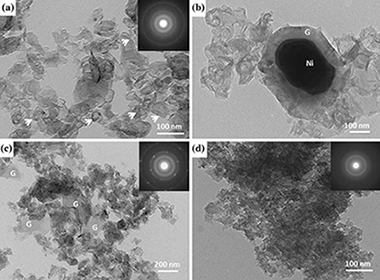
Abstract
Porous graphitic carbons were obtained from wood precursors using Ni as a graphitization catalyst during pyrolysis. The structure of the resulting material retains that of the original wood precursors with highly aligned, hierarchical porosity. Thermal characterization was performed by means of thermogravimetry and differential scanning calorimetry, and the onset temperature for graphitization was determined to be similar to 900 A degrees C. Structural and microstructural characterization was performed by means of electron microscopy, electron and x-ray diffraction, and Raman spectroscopy. The effect of maximum pyrolysis temperature on the degree of graphitization was assessed. No significant temperature effect was detected by means of Raman scattering in the range of 1000-1400 A degrees C, but at temperatures over the melting point of the catalyst, the formation of graphite grains with long-range order was detected.
Noviembre, 2014 · DOI: 0.1007/s10853-014-8477-8
Materiales de Diseño para la Energía y Medioambiente
Direct evidence of Lowenstein's rule violation in swelling high-charge micas
Pavon, E; Osuna, FJ; Alba, MD; Delevoye, LChemical Communications, 53 (2014) 6984-6986 DOI: 10.1039/C4CC01632G
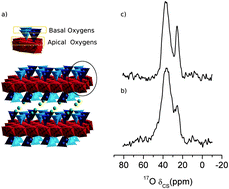
Abstract
The structure of high-charged micas, Na-n-micas (n = 2 and 4), a family of synthetic silicates with a wide range of applications, was investigated through the use of 17O solid-state NMR at natural abundance in order to preserve quantitative spectral information. The use of a very high-field and highly sensitive probehead, together with 17O NMR literature data allowed for the detection of an isolated signal at 26 ppm, assigned partially to AlOAl, as evidence of the violation of Lowenstein's rule for Na-4-mica.
Julio, 2014 · DOI: 10.1039/C4CC01632G
Materiales de Diseño para la Energía y Medioambiente
Biomimetic polymers of plant cutin: an approach from molecular modeling
San-Miguel, MA; Oviedo, J; Heredia-Guerrero, JA; Heredia, A; Benitez, JJJournal of Molecular Modeling, 20 (2014) 2329 DOI: 10.1007/s00894-014-2329-y
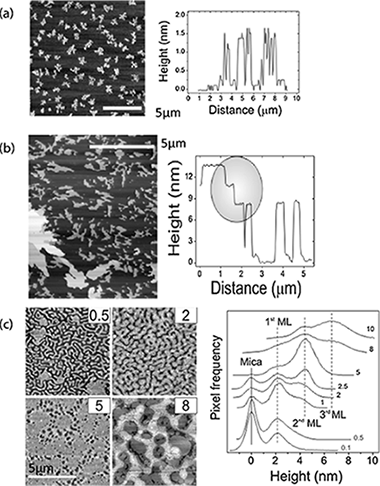
Abstract
Biomimetics of materials is based on adopting and reproducing a model in nature with a well-defined functionality optimized through evolution. An example is barrier polymers that protect living tissues from the environment. The protecting layer of fruits, leaves, and non-lignified stems is the plant cuticle. The cuticle is a complex system in which the cutin is the main component. Cutin is a biopolyester made of polyhydroxylated carboxylic acids of 16 and 18 carbon atoms. The biosynthesis of cutin in plants is not well understood yet, but a direct chemical route involving the self-assembly of either molecules or molecular aggregates has been proposed. In this work, we present a combined study using experimental and simulation techniques on self-assembled layers of monomers selectively functionalized with hydroxyl groups. Our results demonstrate that the number and position of the hydroxyl groups are critical for the interaction between single molecules and the further rearrangement. Also, the presence of lateral hydroxyl groups reinforces lateral interactions and favors the bi-dimensional growth (2D), while terminal hydroxyl groups facilitate the formation of a second layer caused by head–tail interactions. The balance of 2D/3D growth is fundamental for the plant to create a protecting layer both large enough in 2D and thick enough in 3D.
Julio, 2014 · DOI: 10.1007/s00894-014-2329-y
Materiales de Diseño para la Energía y Medioambiente
Influence of the synthesis parameter on the interlayer and framework structure of lamellar octadecyltrimethylammonium kanemite
Corredor, JI; Cota, A; Pavon, E; Osuna, FJ; Alba, MDApplied Clay Science, 95 (2014) 9-17 DOI: 10.1016/j.clay.2014.02.030
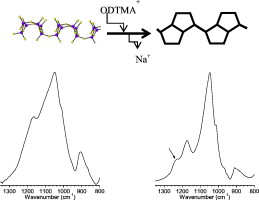
Abstract
Inorganic–organic nanostructures, used as host materials for selective adsorption of functional molecules and as mesostructured material precursors, can be constructed by the interlayer modification of inorganic layered materials with surfactants. The formation mechanism is mainly determined by the surfactant assemblies in the 2D limited space. In this paper, a detailed structural analysis of the lamellar mesophases prepared from kanemite, a lamellar silicate, and octadecyltrimethylammonium (ODTMA) under various conditions was reported. The adsorbed amount of ODTMA and the long and short range structural orders were explored by TGA, XRD, IR/FT and MAS NMR spectroscopies. The results revealed that ODTMA molecules were efficiently intercalated in the interlayer space of kanemite and, in all synthesis conditions, an ordered lamellar structure was obtained. The ODTMA adsorption in kanemite caused changes not only in the interlayer space but also in the silicate framework, where five-member rings were formed. The characteristics of the final products were influenced by the synthesis conditions, although the separation mode, filtration or centrifugation, was not relevant. Therefore, the adsorption conditions of ODTMA in kanemite will contribute to the design of novel layered materials with potential environmental and technological use.
Junio, 2014 · DOI: 10.1016/j.clay.2014.02.030
Materiales de Diseño para la Energía y Medioambiente
Infrared and Raman spectroscopic features of plant cuticles: a review
Heredia-Guerrero, JA; Benitez, JJ; Dominguez, E; Bayer, IS; Cingolani, R; Athanassiou, A; Heredia, AFrontiers in Plant Science, 25 (2014) DOI: 10.3389/fpls.2014.00305
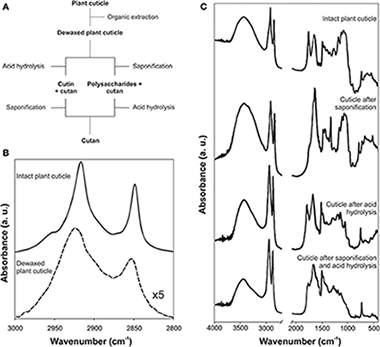
Abstract
The cuticle is one of the most important plant barriers. It is an external and continuous lipid membrane that covers the surface of epidermal cells and whose main function is to prevent the massive loss of water. The spectroscopic characterization of the plant cuticle and its components (cutin, cutan, waxes, polysaccharides and phenolics) by infrared and Raman spectroscopies has provided significant advances in the knowledge of the functional groups present in the cuticular matrix and on their structural role, interaction and macromolecular arrangement. Additionally, these spectroscopies have been used in the study of cuticle interaction with exogenous molecules, degradation, distribution of components within the cuticle matrix, changes during growth and development and characterization of fossil plants.
Junio, 2014 · DOI: 10.3389/fpls.2014.00305
Materiales de Diseño para la Energía y Medioambiente
Biomechanical properties of the tomato (Solanum lycopersicum) fruit cuticle during development are modulated by changes in the relative amounts of its components
Espana, L; Heredia-Guerrero, JA; Segado, P; Benitez, JJ; Heredia, A; Dominguez, ENew Phytologist, 202 (3) (2014) 790-802 DOI: 10.1111/nph.12727
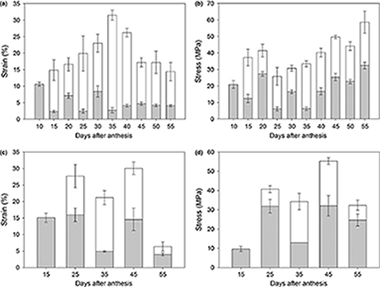
Abstract
Keywords:
attenuated total reflectance–Fourier transform infrared (ATR-FTIR);biomechanics;cuticle;cutin;flavonoids;tomato (Solanum lycopersicum) fruit
Summary
- In this study, growth-dependent changes in the mechanical properties of the tomato (Solanum lycopersicum) cuticle during fruit development were investigated in two cultivars with different patterns of cuticle growth and accumulation.
- The mechanical properties were determined in uniaxial tensile tests using strips of isolated cuticles. Changes in the functional groups of the cuticle chemical components were analysed by attenuated total reflectance–Fourier transform infrared (ATR-FTIR).
- The early stages of fruit growth are characterized by an elastic cuticle, and viscoelastic behaviour only appeared at the beginning of cell enlargement. Changes in the cutin:polysaccharide ratio during development affected the strength required to achieve viscoelastic deformation. The increase in stiffness and decrease in extensibility during ripening, related to flavonoid accumulation, were accompanied by an increase in cutin depolymerization as a result of a reduction in the overall number of ester bonds.
- Quantitative changes in cuticle components influence the elastic/viscoelastic behaviour of the cuticle. The cutin:polysaccharide ratio modulates the stress required to permanently deform the cuticle and allow cell enlargement. Flavonoids stiffen the elastic phase and reduce permanent viscoelastic deformation. Ripening is accompanied by a chemical cleavage of cutin ester bonds. An infrared (IR) band related to phenolic accumulation can be used to monitor changes in the cutin esterification index.
Mayo, 2014 · DOI: 10.1111/nph.12727
Materiales de Diseño para la Energía y Medioambiente
Thermal conductivity at the amorphous-nanocrystalline phase transition in beech wood biocarbon
Parfen'eva, LS; Orlova, TS; Smirnov, BI; Smirnov, IA; Misiorek, H; Jezowski, A; Ramirez-Rico, JPhysica of the Solid State, 56 (2014) 1071-1080 DOI: 10.1134/S1063783414050229
Abstract
High-porosity samples of beech wood biocarbon (BE-C) were prepared by pyrolysis at carbonization temperatures T carb = 650, 1300, and 1600°C, and their resistivity ρ and thermal conductivity κ were studied in the 5–300 and 80–300 K temperature intervals. The experimental results obtained were evaluated by invoking X-ray diffraction data and information on the temperature dependences ρ(T) and κ(T) for BE-C samples prepared at T carb = 800, 1000, and 2400°C, which were collected by the authors earlier. An analysis of the κ(T carb) behavior led to the conclusion that the samples under study undergo an amorphous-nanocrystalline phase transition in the interval 800°C < T carb < 1000°C. Evaluation of the electronic component of the thermal conductivity revealed that the Lorentz number of the sample prepared at T carb = 2400°C exceeds by far the classical Sommerfeld value, which is characteristic of metals and highly degenerate semiconductors.
Mayo, 2014 · DOI: 10.1134/S1063783414050229
Materiales de Diseño para la Energía y Medioambiente
Effect of clays and metal containers in retaining Sm3+ and ZrO2+ and the process of reversibility
El Mrabet, S; Castro, MA; Hurtado, S; Orta, MM; Pazos, MC; Villa-Alfageme, M; Alba, MDAmerican Mineralogist, 99 (4) (2014) 696-703 DOI: 10.2138/am.2014.4665
Abstract
Knowledge and understanding about radionuclides retention processes on the materials composing the engineered barrier (clay mineral and metallic container waste) are required to ensure the safety and the long-term performance of radioactive waste disposal. Therefore, the present study focuses on the competitiveness of clay and the metallic container in the process of adsorption/desorption of the radionuclides simulators of Am3+ and UO22+. For this purpose, a comparative study of the interaction of samarium (chosen as chemical analog for trivalent americium) and zirconyl (as simulator of uranyl and tetravalent actinides) with both FEBEX bentonite and metallic container, under subcritical conditions, was carried out. The results revealed that the AISI-316L steel container, chemical composition detailed in Table 1, immobilized the high-radioactive waste (HRW), even during the corrosion process. The ZrO2+ was irreversibly adsorbed on the minireactor surface. In the case of samarium SEM/EDX analysis revealed the formation of an insoluble phase of samarium silicate on the container surface. There was no evidence of samarium diffusion through the metallic container. Samarium remained adsorbed by the container also after desorption experiment with water. Therefore, steel canister is actively involved in the HRW immobilization.
Abril, 2014 · DOI: 10.2138/am.2014.4665
Materiales de Diseño para la Energía y Medioambiente
A new route of synthesis of Na-Mica-4 from sodalite
Naranjo, M; Castro, MA; Cota, A; Pavon, E; Pazos, MC; Alba, MDMicroporous and Mesoporous Materials, 188 (2014) 176-180 DOI: 10.1016/j.micromeso.2013.12.004

Abstract
Synthesis of Na-Mica-4 has been achieved by a “mix and calcine” method using sodalite and magnesium fluoride as the only precursors. Previous research found sodalite as a key intermediate reaction product in the formation of Na-Mica-4 when the NaCl melt method was employed. Similarities in structure, chemical composition and cation distribution in products using the proposed method and the NaCl melt method are described and suggest that Na-Mica-4 is a very stable product. The use of sodalite as precursor provokes microporous formation in the final mica. The absence of excess Na leads to a lower particle size and to the presence of less impurity in the calcined product. Different sodalites could be used in the synthesis of different Na-Mica-4 with presumably different physicochemical properties.
Marzo, 2014 · DOI: 10.1016/j.micromeso.2013.12.004
Materiales de Diseño para la Energía y Medioambiente
Effect of carbonization temperature on the microplasticity of wood-derived biocarbon
Shpeizman, VV; Orlova, TS; Kardashev, BK; Smirnov, BI; Gutierrez-Pardo, A; Ramirez-Rico, JPhysics of the Solid State, 56 (2014) 538-545 DOI: 10.1134/S1063783414030305
Abstract
The uniaxial compression strength under stepped loading and the 325-nm-stepped deformation rate of biocarbon samples obtained by carbonization of beech wood at different temperatures in the 600–1600°C range have been measured using high-precision interferometry. It has been shown that the strength depends on the content of nanocrystalline phase in biocarbon. The magnitude of deformation jumps at micro- and nanometer levels and their variation with a change in the structure of the material and loading time have been determined. For micro- and nanometer-scale jumps, standard deviations of the differences between the experimentally measured deformation rate at loading steps and its magnitude at the smoothed fitting curve have been calculated, and the correlation of the error with the deformation prior to destruction has been shown. The results obtained have been compared with the previously published data on measurements of the elastic properties and internal friction of these materials.
Marzo, 2014 · DOI: 10.1134/S1063783414030305
Materiales de Diseño para la Energía y Medioambiente
New Bio-Ceramization Processes Applied to Vegetable Hierarchical Structures for Bone Regeneration: An Experimental Model in Sheep
Filardo, G; Kon, E; Tampieri, A; Cabezas-Rodriguez, R; Di Martino, A; Fini, M; Giavaresi, G; Lelli, M; Martinez-Fernandez, J; Martini, L; Ramirez-Rico, J; Salamanna, F; Sandri, M; Sprio, S; Marcacci, MTissue Engineering Part A, 20 (2014) 763-773 DOI: 10.1089/ten.tea.2013.0108
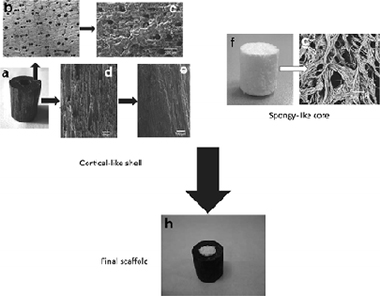
Abstract
Bone loss is still a major problem in orthopedics. The purpose of this experimental study is to evaluate the safety and regenerative potential of a new scaffold based on a bio-ceramization process for bone regeneration in long diaphyseal defects in a sheep model. The scaffold was obtained by transformation of wood pieces into porous biomorphic silicon carbide (BioSiC®). The process enabled the maintenance of the original wood microstructure, thus exhibiting hierarchically organized porosity and high mechanical strength. To improve cell adhesion and osseointegration, the external surface of the hollow cylinder was made more bioactive by electrodeposition of a uniform layer of collagen fibers that were mineralized with biomimetic hydroxyapatite, whereas the internal part was filled with a bio-hybrid HA/collagen composite. The final scaffold was then implanted in the metatarsus of 15 crossbred (Merinos-Sarda) adult sheep, divided into 3 groups: scaffold alone, scaffold with platelet-rich plasma (PRP) augmentation, and scaffold with bone marrow stromal cells (BMSCs) added during implantation. Radiological analysis was performed at 4, 8, 12 weeks, and 4 months, when animals were sacrificed for the final radiological, histological, and histomorphometric evaluation. In all tested treatments, these analyses highlighted the presence of newly formed bone at the bone scaffolds' interface. Although a lack of substantial effect of PRP was demonstrated, the scaffold+BMSC augmentation showed the highest value of bone-to-implant contact and new bone growth inside the scaffold. The findings of this study suggest the potential of bio-ceramization processes applied to vegetable hierarchical structures for the production of wood-derived bone scaffolds, and document a suitable augmentation procedure in enhancing bone regeneration, particularly when combined with BMSCs.
Febrero, 2014 · DOI: 10.1089/ten.tea.2013.0108
Materiales de Diseño para la Energía y Medioambiente
Interaction of Hydrated Cations with Mica-n (n = 2, 3 and 4) Surface
Pavon, E; Castro, MA; Cota, A; Osuna, FJ; Pazos, MC; Alba, MDJournal of Physical Chemistry C, 118 (2014) 2115-2121 DOI: 10.1021/jp4110695

Abstract
High charged swelling micas, with layer charge between 2 and 4, have been found to readily swell with water, and complete cation exchange (CEC) can be achieved. Because of their high CEC, applications like radioactive cation fixation or removal of heavy metal cations from wastewater were proposed. Their applicability can be controlled by the location of the interlayer cation in a confined space with a high electric field. In synthetic brittle micas, the interlayer cation has a low water coordination number; therefore, their coordination sphere would be completed by the basal oxygen of the tetrahedral layer as inner-sphere complexes (ISC). However, no direct evidence of these complexes formation in brittle micas has been reported yet. In this contribution, we mainly focus on the understanding the mechanisms that provoke the formation of ISC in high charge swelling micas, Mica-n. A whole series of cations (X) were used to explore the influence of the charge and size of the interlayer cation. Three brittle swelling micas, Mica-n (n = 4, 3 and 2), were selected in order to analyze the influence of the layer charge in the formation of ISC. The contribution of the ISC has been analyzed thorough the evolution of the 060 reflection and the changes in the short-range order of the tetrahedral cations will be followed 29Si and 27Al MAS NMR. The results showed that ISC was favored in X-Mica-4 and that provoked a high distortion angle between the Si–Al tetrahedra. When the content of aluminum decreases, the electrostatic forces between the layers are relaxed, and the hydrated cations did not interact so strongly with the tetrahedral sheet, having the opportunity to complete their hydration sphere.
Enero, 2014 · DOI: 10.1021/jp4110695
Materiales de Diseño para la Energía y Medioambiente
Competitive effect of the metallic canister and clay barrier on the sorption of Eu3+ under subcritical conditions
El Mrabet, S; Castro, MA; Hurtado, S; Orta, MM; Pazos, MC; Villa-Alfageme, M; Alba, MDApplied Geochemistry, 40 (2014) 25-31 DOI: j.apgeochem.2013.10.014
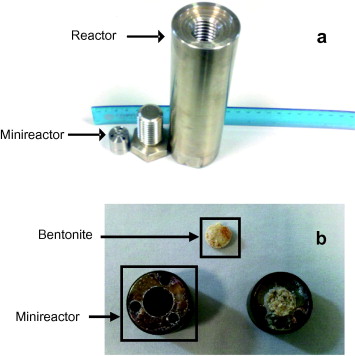
Abstract
An in depth knowledge and understanding of high activity radionuclide (HLRW) immobilization processes on the materials composing the engineered barrier (clay and metallic canister) is required to ensure the safety and the long-term performance of radioactive waste disposal procedures. Therefore, the aim of this study was to understand the mechanisms involved in the retention of Eu3+ by two components of the multibarrier system, the bentonite barrier and the canister. As such, a comparative study of the interaction of trivalent Eu3+, used to simulate trivalent actinides, with both bentonite and a metallic canister has been undertaken in this work. To this end, we designed a minireactor into which the bentonite was introduced and compacted. The minireactor-bentonite system was then submitted to a hydrothermal reaction with a 7.9 × 10−2 M solution of Eu3+ at 300 °C for 4.5 days. SEM and XRD results revealed that both bentonite and the container were involved in the immobilization of europium by the formation of insoluble europium silicate phases. The presence of europium silicate adsorbed on the surface of the metallic canister indicates the competitive effect of both components of the engineered barrier (bentonite and metallic canister) in HLRW immobilization. These results suggested that the canister could play a role in the HLRW immobilization even during its corrosion process.
Enero, 2014 · DOI: j.apgeochem.2013.10.014
2013
2013
Materiales de Diseño para la Energía y Medioambiente
Modeling Macro-Sized, High Aspect Ratio Through-Hole Filling by Multi-Component Additive-Assisted Copper Electrodeposition
Childers, AS; Johnson, MT; Ramirez-Rico, J; Faber, KTJournal of the Electrochemical Society, 160 (2013) D3093-D3102 DOI: 10.1149/2.018312jes
Abstract
A multi-element, time-dependent model is used to examine additive-assisted copper electroplating in macro-channels. This model is an adaptation of the work of Akolkar and Landau [J. Electrochem. Soc., 156, D351 (2009)], used to describe plating in micro-vias for integrated circuits. Using their method for describing species movement in the channel, the model has been expanded to include transport and adsorption limitations of the inhibitor and accelerator, as well as the copper ions in solution. The model is used to investigate copper plating as an infiltration method across many size scales and aspect ratios. Biomorphic graphite scaffolds produced from wood are used as a representative system and the results of a two-additive bath are used to characterize the behavior of the additives and determine the effectiveness of the plating. The results indicate that at macro-scales, channel dimensions play an increasingly important role in dictating the behavior of additive-assisted plating. Because additive systems are designed to establish differential surface coverage within the channel, the success of which is determined by the additive's rates of diffusion and adsorption, certain size scale/aspect ratio combinations preclude such coverage. A guide for sample geometries that may be successfully infiltrated with a two-additive bath is provided.
Diciembre, 2013 · DOI: 10.1149/2.018312jes
Materiales de Diseño para la Energía y Medioambiente
In situ imaging and strain determination during fracture in a SiC/SiC ceramic matrix composite
Ramirez-Rico, J; Stolzenburg, F; Almer, JD; Routbort, JL; Singh, D; Faber, KTScripta Materialia, 69 (2013) 497-500 DOI: 10.1016/j.scriptamat.2013.05.032

Abstract
A combined imaging and microdiffraction technique using high-energy synchrotron X-rays is described and used to reveal microstructure, damage and strain evolution around notches in SiC/SiC composites. This technique allows for monitoring the material for cracks while loading and mapping the strain distribution in fibers and matrix with a resolution of tens of microns. We show that at current resolutions this technique is capable of measuring the strain distribution near crack tips in ceramic matrix composites and observe load transfer effects.
Octubre, 2013 · DOI: 10.1016/j.scriptamat.2013.05.032
Materiales de Diseño para la Energía y Medioambiente
Thermal conductivity of wood-derived graphite and copper–graphite composites produced via electrodeposition
Johnson, MT; Childers, AS; Ramirez-Rico, J; Wang, H; Faber, KTComposites Part A: Applied Science and Manufaturing, 63 (2013) 182-189 DOI: 10.1016/j.compositesa.2013.06.009
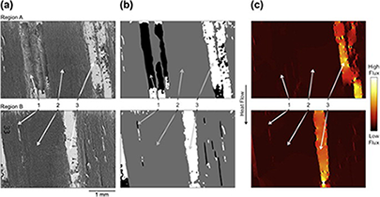
Abstract
The thermal conductivity of wood-derived graphite and graphite/copper composites was studied both experimentally and using finite element analysis. The unique, naturally-derived, anisotropic porosity inherent to wood-derived carbon makes standard porosity-based approximations for thermal conductivity poor estimators. For this reason, a finite element technique which uses sample microstructure as model input was utilized to determine the conductivity of the carbon phase independent of porosity. Similar modeling techniques were also applied to carbon/copper composite microstructures and predicted conductivities compared well to those determined via experiment.
Octubre, 2013 · DOI: 10.1016/j.compositesa.2013.06.009
Materiales de Diseño para la Energía y Medioambiente
Structure-mediated transition in the behavior of elastic and inelastic properties of beach tree bio-carbon
Kardashev, BK; Orlova, TS; Smirnov, BI; Gutierrez, A; Ramirez-Rico, JPhysics of the Solid State, 55 (2013) 1884-1891 DOI: 10.1134/S1063783413090151
Abstract
Microstructural characteristics and amplitude dependences of the Young modulus E and of internal friction (logarithmic decrement δ) of bio-carbon matrices prepared from beech tree wood at different carbonization temperatures T carb ranging from 600 to 1600°C have been studied. The dependences E(T carb) and δ(T carb) thus obtained revealed two linear regions of increase of the Young modulus and of decrease of the decrement with increasing carbonization temperature, namely, ΔE ∼ AΔT carb and Δδ ∼ BΔT carb, with A ≈ 13.4 MPa/K and B ≈ −2.2 × 10−6 K−1 for T carb < 1000°C and A ≈ 2.5 MPa/K and B ≈ −3.0 × 10−7 K−1 for T carb > 1000°C. The transition observed in the behavior of E(T carb) and δ(T carb) at T carb = 900–1000°C can be assigned to a change of sample microstructure, more specifically, a change in the ratio of the fractions of the amorphous matrix and of the nanocrystalline phase. For T carb < 1000°C, the elastic properties are governed primarily by the amorphous matrix, whereas for T carb > 1000°C the nanocrystalline phase plays the dominant part. The structurally induced transition in the behavior of the elastic and microplastic characteristics at a temperature close to 1000°C correlates with the variation of the physical properties, such as electrical conductivity, thermal conductivity, and thermopower, reported in the literature.
Septiembre, 2013 · DOI: 10.1134/S1063783413090151
Materiales de Diseño para la Energía y Medioambiente
Monolayer arrangement of fatty hydroxystearic acids on graphite: Influence of hydroxyl groups
Medina, S; Benitez, JJ; Castro, MA; Cerrillos, C; Millan, C; Alba, MDThin Solid Films, 539 (2013) 194-200 DOI: 10.1016/j.tsf.2013.05.053
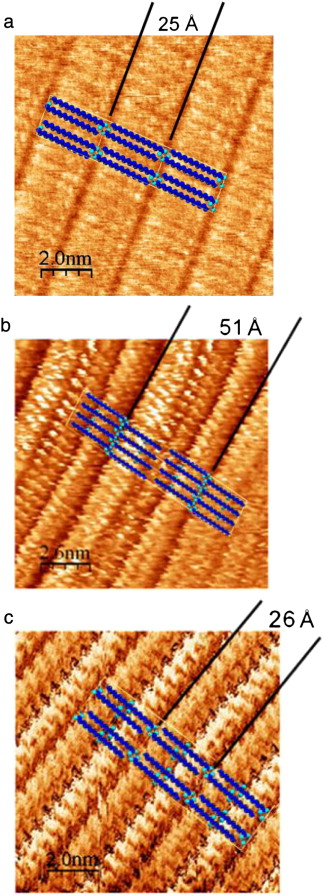
Abstract
Previous studies have indicated that long-chain linear carboxylic acids form commensurate packed crystalline monolayers on graphite even at temperatures above their melting point. This study examines the effect on the monolayer formation and structure of adding one or more secondary hydroxyl, functional groups to the stearic acid skeleton (namely, 12-hydroxystearic and 9,10-dihydroxystearic acid). Moreover, a comparative study of the monolayer formation on recompressed and monocrystalline graphite has been performed through X-ray diffraction (XRD) and Scanning Tunneling Microscopy (STM), respectively. The Differential Scanning Calorimetry (DSC) and XRD data were used to confirm the formation of solid monolayers and XRD data have provided a detailed structural analysis of the monolayers in good correspondence with obtained STM images. DSC and XRD have demonstrated that, in stearic acid and 12-hydroxystearic acid adsorbed onto graphite, the monolayer melted at a higher temperature than the bulk form of the carboxylic acid. However, no difference was observed between the melting point of the monolayer and the bulk form for 9,10-dihydroxystearic acid adsorbed onto graphite. STM results indicated that all acids on the surface have a rectangular p2 monolayer structure, whose lattice parameters were uniaxially commensurate on the a-axis. This structure does not correlate with the initial structure of the pure compounds after dissolving, but it is conditioned to favor a) hydrogen bond formation between the carboxylic groups and b) formation of hydrogen bonds between secondary hydroxyl groups, if spatially permissible. Therefore, the presence of hydroxyl functional groups affects the secondary structure and behavior of stearic acid in the monolayer.
Julio, 2013 · DOI: 10.1016/j.tsf.2013.05.053
Materiales de Diseño para la Energía y Medioambiente
Evaluation of rare earth on layered silicates under subcritical conditions: Effect of the framework and interlayer space composition
Chain, P; Cota, A; El Mrabet, S; Pavon, E; Pazos, MC; Alba, MDChemical Geology, 347 (2013) 208-216 DOI: 10.1016/j.chemgeo.2013.03.006
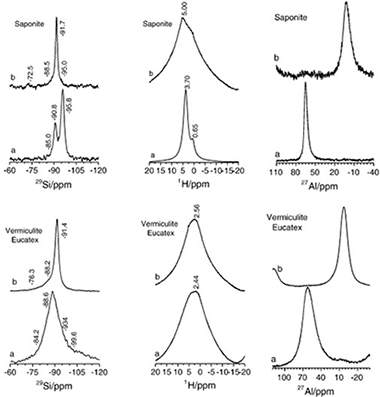
Abstract
Clay-based minerals are considered to be an important component in backfill barriers due to both their ability to seal and adsorb radioactive waste and to interact chemically with it under subcritical conditions. Herein, we describe a systematic study of the properties of layered silicates that could affect their hydrothermal reactivity, namely type of layers, octahedral occupancy, origin and total amount of the layer charge, and nature of the interlayer cation. The silicates studied were selected on the basis of their different characteristics associated with these properties and were treated hydrothermally at 300 °C for 48 h in a 7.3 · 10− 2 M Lu(NO3)3 · 3.6H2O solution. The final products were analyzed by X-ray diffraction and solid-state NMR spectroscopy. All the layered silicates studied were found to be able to generate a Lu2Si2O7 phase after hydrothermal treatment under subcritical conditions, thereby confirming the participation of a chemical mechanism of the clay barrier generating phases being stables with temperature and pH conditions. However, the extent of this reaction depends to a large extent on the physicochemical properties of the framework and the interlayer space composition, such as the presence or absence of an octahedral sheet, the degree of occupancy of this sheet, and the origin and total layer charge. Therefore, this study allows tuning the clay mineral framework characteristic that favors the rare earth cations (as trivalent actinide simulator) immobilization.
Junio, 2013 · DOI: 10.1016/j.chemgeo.2013.03.006
Materiales de Diseño para la Energía y Medioambiente
Synthesis and characterization of kanemite from fluoride-containing media: Influence of the alkali cation
Corredor, JI; Cota, A; Pavon, E; Alba, MDAmerican Mineralogist, 98 (2013) 1000-1007 DOI: 10.2138/am.2013.4372
Abstract
Kanemite belongs to the group of naturally occurring sodium silicate minerals that was first found in Kanem, at the edge of the Lake Chad, and has been synthesized in different ways from NaOH-SiO2 mixtures and used as precursor for the design of microporous and mesoporous materials. The fluoride route to the synthesis of microporous materials is based on the substitution of OH− anions by fluoride anions, which may subsequently also play a mineralizing role, and gives rise to materials with higher hydrophobicity and thermal and hydrothermal stability. Moreover, F− plays an important role in the incorporation of framework heteroatoms, thereby affecting the activity of the final material. The aim of this study was to synthesize fluorokanemite using different synthetic routes and different F− source. The final product was characterized by a combination of methods that provided information regarding the incorporation of fluorine into the framework and the short- and long-range structural order of the fluorosilicate. Kanemite with water content close to ideal was obtained in all cases. The washing process was found to have no effect in the long- or short-range structural order of the layer framework, although it did affect the structure of the cation in the interlayer space of kanemite. The mineralizing agent therefore appears to be the key to the synthesis. Furthermore, it governs the resulting kanemite structure by controlling the formation of hydrogen bonds in the framework, and therefore the degree of lamellar structure condensation.
Mayo, 2013 · DOI: 10.2138/am.2013.4372
Materiales de Diseño para la Energía y Medioambiente
Solution Properties of the System ZrSiO4–HfSiO4: A Computational and Experimental Study
Cota, Agustin; Burton, Benjamin P.; Chain, Pablo; Pavon, Esperanza; Alba, Maria D.Journal of Physical Chemistry C, 117 (2013) 10013-10019 DOI: 10.1021/jp401539g

Abstract
ZrSiO4 and HfSiO4 are of considerable interest because of their low thermal expansions, thermal conductivities, and the optical properties of HfSiO4. In addition, silicate phases of both are studied as model radioactive waste disposal materials. Previous first principles calculations reported near ideal mixing in the Zr1–xHfxSiO4 system, with a very weak propensity for phase separation. Density functional theory (DFT)/cluster-expansion first principles calculations presented in this work indicate near ideal mixing with a very weak propensity for ordering. Zr1–xHfxSiO4 samples (x = 0, 0.25, 0.5, 0.75, and 1.0) were synthesized from intimate stoichiometric mixtures of constituent-oxides and annealing at 1823 K for 20 days in a platinum crucible. Samples were characterized by X-ray diffraction (XRD; Rietveld analysis) and 29Si MAS NMR. The XRD data exhibited a pronounced negative deviation from Vegard’s law in the excess volume of mixing, and the 29Si MAS NMR spectra also suggest nonideal mixing. Given the very weak energetics that favor cation ordering, it is clear that there must be some other cause(s) for the observed deviations from ideal mixing behavior.
Mayo, 2013 · DOI: 10.1021/jp401539g
Materiales de Diseño para la Energía y Medioambiente
Effects of thermal and mechanical treatments on montmorillonite homoionized with mono- and polyvalent cations: Insight into the surface and structural changes
Fernandez, M; Alba, MD; Sanchez, RMTColloids and Surfaces A: Physicochemical and Engineering Aspects, 423 (2013) 1-10 DOI: 10.1016/j.colsurfa.2013.01.040
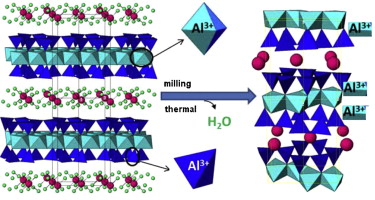
Abstract
Smectite is a family of clay minerals that have important applications. In the majority of these clay minerals, the hydrated interlayer cations play a crucial role on the properties of the clay. Moreover, many studies have revealed that both thermal and grinding treatments affect the MMT structure and that interlayer cations play an important role in the degradation of the structure, primarily after mechanical treatment. In this study, the effects of these treatments on MMTs homoionized with mono (Na+, Li+ or K+) or polyvalent (Ca2+ or Al3+) cations were analyzed by the combination of a set of techniques that can reveal the difference of bulk phenomena from those produced on the surface of the particles. The thermal and mechanical (in an oscillating mill) treatments affected the framework composition and structure of the MMT, and the thermal treatment caused less drastic changes that the mechanical one. The effect of the interlayer cations is primarily due to the oxidation state and, to the size of the cations, which also influenced the disappearance of aluminum in the MMT tetrahedral sheet. These treatments caused a decrease in the surface area and an increase in the particle agglomeration and the isoelectric point. Both treatments caused the leaching of the framework aluminum. Furthermore, the mechanical treatment induced structural defects, such as the breakup of the particles, which favored the dehydroxylation and the increase of the isoelectric points of the montmorillonites.
Abril, 2013 · DOI: 10.1016/j.colsurfa.2013.01.040
Materiales de Diseño para la Energía y Medioambiente
Joining and interface characterization of in situ reinforced silicon nitride
Asthana, R; Singh, M; Martinez-Fernandez, JJournal of Alloys and Compounds, 552 (2013) 137-145 DOI: 10.1016/j.jallcom.2012.09.104
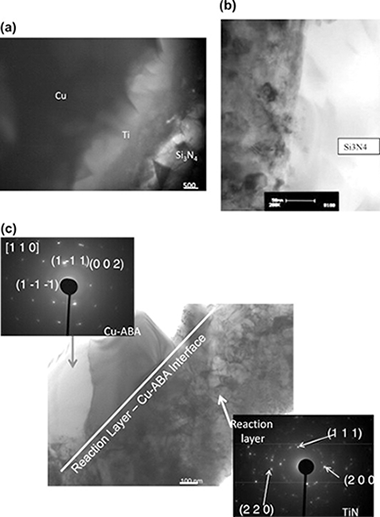
Abstract
Copper-base active metal interlayers were used to bond in situ reinforced silicon nitride (Honeywell AS800) at 1317 K for 5 and 30 min in vacuum. The joints were characterized using scanning electron microscopy (SEM), energy dispersive spectroscopy (EDS), electron back scattered diffraction (EBSD), and transmission electron microscopy (TEM). A Ti-rich interaction zone (∼3.0–3.5 μm thick) formed at the Si3N4/braze interface. This reaction layer grew toward the inner part of the joint with a featureless microstructure, creating a strong bond. Regions of a Ti-rich phase were frequently found next to the reaction layer but surrounded by the Cu alloy. Extensive Ti and Si enrichments were noted at the interface but there was no evidence of interfacial segregation of Y, La, and Sr (from Y2O3, La2O3 and SrO, added as sintering aids). The reaction layer thickness and composition did not change when brazing time increased from 5 min to 30 min suggesting rapid growth kinetics in the early stages of reaction. The joints were crack-free and showed features associated with plastic deformation, which indicated that the metal interlayer accommodated strain associated with CTE mismatch. The inner part of the joint consisted of highly textured large grains of the braze alloy.
Marzo, 2013 · DOI: 10.1016/j.jallcom.2012.09.104
Materiales de Diseño para la Energía y Medioambiente
Hydration properties of synthetic high-charge micas saturated with different cations: An experimental approach
Pavon, E; Castro, MA; Naranjo, M; Orta, MM; Pazos, MC; Alba, MDAmerican Mineralogist, 98 (2013) 394-400 DOI: 10.2138/am.2013.4217
Abstract
An understanding of the interaction mechanisms between exchangeable cations and layered silicates is of interest from both a basic and an applied point of view. Among 2:1 phyllosilicates, a new family of swelling high-charge synthetic micas has been shown to be potentially useful as decontaminant. However, the location of the interlayer cations, their acidity and the water structure in the interlayer space of these silicates are still unknown. The aim of this paper was therefore to study the hydration state of the interlayer cations in the interlayer space of high-charge expandable micas and to evaluate the effect that this hydration has on the swelling and acidity behavior of these new materials. To achieve these objectives, three synthetic micas with different charge density total layer charges (ranging between 2 and 4 per unit cell) and with five interlayer cations (Na+, Li+, K+, Mg2+, and Al3+) were synthesized and their hydration state, interlayer space, and acidity analyzed by DTA/TG, XRD, and 1H MAS NMR spectroscopy. The results showed that the hydration state depends on both the layer charge and the nature of the interlayer cation. A high participation of the inner-sphere complexes in the highly charged confined space has been inferred and proposed to induce Brønsted acidity in the solid.
Marzo, 2013 · DOI: 10.2138/am.2013.4217
Materiales de Diseño para la Energía y Medioambiente
Heat capacity of Bio-SiC and SiC/Si ecoceramics prepared from white eucalyptus, beech, and sapele tree wood
Smirnov, IA; Smirnov, BI; Orlova, TS; Wlosewicz, D; Hackemer, A; Misiorek, H; Mucha, J; Jezowski, A; Ramirez-Rico, J; Martinez-Fernandez, JPhysics of the Solid State, 55 (2013) 454-460 DOI: 10.1134/S1063783413020285
Abstract
This paper reports on measurement of the heat capacity at constant pressure C p of silicon bio-carbide prepared within the 5–300 K temperature interval from beech tree wood (bio-SiC(BE)), and within 80–300 K, from tree wood of sapele (bio-SiC(SA)), as well as SiC/Si ecoceramics of beech, sapele, and white eucalyptus wood. It has been shown that in bio-SiC(BE) the measured heat capacity contains a significant contribution of surface heat capacity, whose magnitude decreases with increasing temperature. Of the ecoceramics, only SiC/Si(SA) characterized by a high enough porosity has revealed a small contribution to the heat capacity coming from its surface component. The experimental results obtained are discussed.
Febrero, 2013 · DOI: 10.1134/S1063783413020285
Materiales de Diseño para la Energía y Medioambiente
Thermopower of Bio-SiC and SiC/Si ecoceramics prepared from sapele tree wood
Smirnov, IA; Smirnov, BI; Orlova, TS; Sulkovski, C; Misiorek, H; Muha, J; Jezowski, A; Ramirez-Rico, J; Martinez-Fernandez, JPhysics of the Solid State, 55 (2013) 54-59 DOI: 10.1134/S1063783413010307
Abstract
The thermopower coefficients of bio-SiC and SiC/Si ecoceramics prepared from sapele tree wood have been measured in the temperature interval 5–300 K. The measurements have been performed both along and perpendicular to empty (bio-SiC), as well as empty and partially silicon-filled (SiC/Si) channels in the samples. In bio-SiC, a contribution to thermopower associated with electron drag by phonons has been shown to exist within the temperature interval 5–200 (250) K. No such effect is realized in SiC/Si. This is assumed to derive from the presence in this material of heavily doped silicon embedded in SiC channels and the dominant part it plays in the behavior of the thermopower of this ceramics. The results obtained for the thermopower are compared with the available data for bio-SiC prepared from white eucalyptus tree wood and heavily doped bismuth.
Febrero, 2013 · DOI: 10.1134/S1063783413010307
2012
2012
Materiales de Diseño para la Energía y Medioambiente
Chemical–physical characterization of isolated plant cuticles subjected to low-dose γ-irradiation
Heredia-Guerrero, Jose A; de Lara, Rocio; Dominguez, Eva; Heredia, Antonio; Benavente, Juana; Benitez, Jose JChemistry and physics of lipids, 165 (2012) 803-808 DOI: 10.1016/j.chemphyslip.2012.10.003
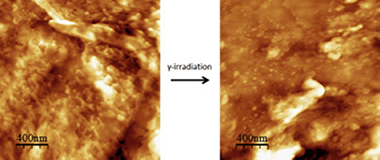
Abstract
Isolated tomato fruit cuticles were subjected to low dose (80 Gy) γ-irradiation, as a potential methodology to prevent harvested fruit and vegetables spoilage. Both irradiated and non-irradiated samples have been morphologically and chemically characterized by scanning electron (SEM), atomic force (AFM), attenuated total reflectance Fourier transform infrared (ATR-FTIR) and X-ray photoelectron (XPS) spectroscopies. Additionally, electrochemical measurements comprising membrane potential and diffusive permeability were carried out to detect modifications in transport properties of the cuticle as the fruit primary protective membrane. It has been found that low dose γ-irradiation causes some textural changes on the surface but no significant chemical modification. Texture modification is found to be due to a partial removal of outermost (epicuticular) waxes which is accompanied by mild changes of electrochemical parameters such as the membrane fixed charge, cation transport number and salt permeability. The modification of such parameters indicates a slight reduction of the barrier properties of the cuticle upon low dose γ-irradiation.
Diciembre, 2012 · DOI: 10.1016/j.chemphyslip.2012.10.003
Materiales de Diseño para la Energía y Medioambiente
Effect of ytterbium doping on the microstructure and plastic deformation of BaCeO3 perovskite oxide
Jimenez-Melendo, M; Vaquero-Aguilar, C; Huaman-Mamani, FAFuel Processing Technology, 103 (2012) 146-150 DOI: 10.1016/j.fuproc.2011.10.005
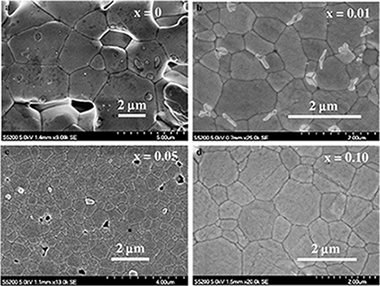
Abstract
Trivalent cation-doped barium cerate perovskites are attractive materials for clean-energy applications, in particular solid oxide fuel cells, due to their singular proton conductivity in wet environments. Furthermore, these devices operate at high temperatures, where creep and other deformation processes determine the lifetime and overall performance. In this work, the structural and microstructural characteristics of undoped and ytterbium-doped (1 to 10 at.%) BaCeO 3 polycrystals produced by solid state reaction have been investigated. A single orthorhombic perovskite phase was found after sintering in air at 1500 °C for 10 h. The microstructure shows a complex evolution with doping: the average grain size firstly decreases with increasing Yb content up to 5 at.%, and then increases with further Yb additions. The high-temperature mechanical properties have been studied in compression between 1100 and 1250 °C in air at constant initial strain rate. The creep strength increases with increasing Yb content. Extended steady states of deformation were attained at lower strain rates and higher temperatures when increasing doping amount.
Noviembre, 2012 · DOI: 10.1016/j.fuproc.2011.10.005
Materiales de Diseño para la Energía y Medioambiente
Microstructural and high-temperature mechanical characteristics of nickel oxide/zirconia composites for solid oxide fuel cells
Oliva-Ramirez, M.; Huaman-Mamani, F. A.; Jimenez-Melendo, M.Fuel Processing Technology, 103 (2012) 45-50 DOI: 10.1016/j.fuproc.2011.09.013
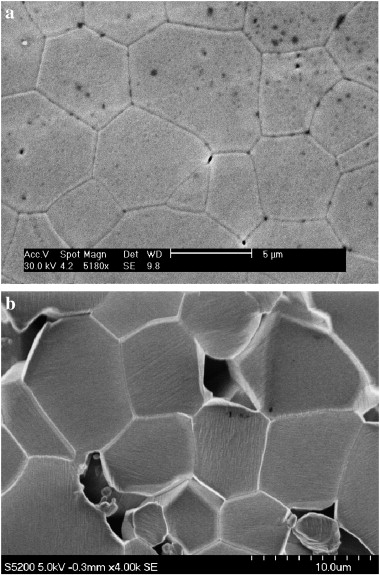
Abstract
NiO/8YSZ (8 mol% Y 2O 3-stabilized ZrO 2) composites with different NiO contents (10, 20 and 40 mol%) have been fabricated by a conventional route of mechanical mixing of NiO and 8YSZ powders and sintering at 1500 °C for 10 h in air. The resulting microstructures have been characterized by electron microscopy. In 10 and 20 mol% NiO/8YSZ, the composite is formed by isolated NiO particles surrounded by zirconia matrix grains; this phase is interconnected in the 40 mol% NiO/8YSZ composite. Mechanical tests at constant strain rate and at constant load were conducted on these materials at temperatures of up to 1350 °C. Different behaviors were found depending on the percolation of the NiO phase. Microstructural observations after deformation are essential to understand the overall mechanical behavior of the composites.
Noviembre, 2012 · DOI: 10.1016/j.fuproc.2011.09.013
Materiales de Diseño para la Energía y Medioambiente
Creep strength of nickel oxide/zirconia composites under different environmental atmospheres
M. Jiménez-Melendo; F.A. Huamán-MamaniSolid State Ionics, 225 (2012) 471-475 DOI: 10.1016/j.ssi.2012.02.011
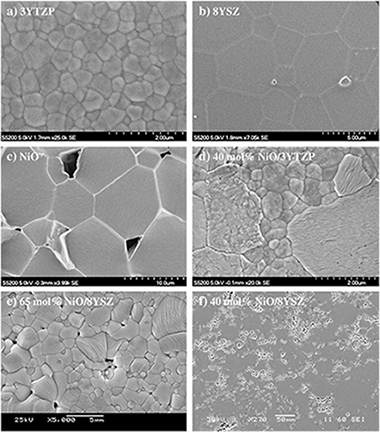
Abstract
NiO/8YSZ (8 mol% Y2O3-stabilized cubic ZrO2) and NiO/3YTZP (3 mol% Y2O3-stabilized tetragonal ZrO2) composites with different NiO contents have been fabricated by a conventional route of mechanical mixing of NiO and zirconia powders and sintering at 1500 °C for 10 h in air. The resulting microstructures have been characterized by electron microscopy. The composites show a duplex microstructure formed by equiaxed grains of NiO and ZrO2, without any intermediate phase. Compressive mechanical tests at constant strain rate were carried out at temperatures between 1150 and 1350 °C under different environments: air, inert (Ar) and reducing (5% H2/95% Ar) atmospheres. The overall creep behavior of the composites is essentially controlled by the zirconia matrix, due to the softness of the NiO phase in the experimental conditions used in this study. The creep strength is not affected by oxygen partial pressure. However, a large decrease in creep resistance under reducing conditions was observed in samples submitted to in situ redox cycling.
Octubre, 2012 · DOI: 10.1016/j.ssi.2012.02.011
Materiales de Diseño para la Energía y Medioambiente
High-temperature plastic deformation mechanisms of ytterbium-doped barium cerate proton conductor
M. Jiménez-MelendoSolid State Ionics, 225 (2012) 286-290 DOI: 10.1016/j.ssi.2012.03.031
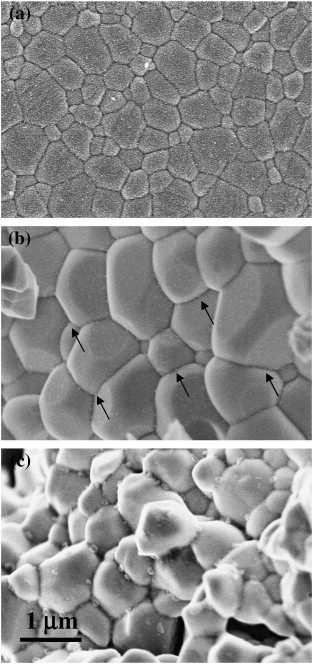
Abstract
The enhanced proton conductivity exhibited by trivalent cation-doped barium cerate perovskites makes these materials excellent candidates for electrochemical applications, in particular as electrolytes for solid oxide fuel cells. These devices operate at elevated temperatures, where creep and other deformation processes influence the overall efficiency and lifetime. In this work, the high-temperature plastic deformation mechanisms of fine-grained 5 at.% Yb-doped BaCeO3 polycrystals produced by conventional solid-state reaction has been investigated by means of compressive tests at constant load between 1150 and 1250 °C in air. The creep curves show an unusual sigmoidal behavior, followed by extended steady states of deformation. Grain boundary sliding is the main deformation mechanism, characterized by a stress exponent n of 2, as found in other fine-grained superplastic ceramics and metals.
Octubre, 2012 · DOI: 10.1016/j.ssi.2012.03.031
Materiales de Diseño para la Energía y Medioambiente
Electrical resistivity and thermal conductivity of SiC/Si ecoceramics prepared from sapele wood biocarbon
Parfen'eva, LS; Orlova, TS; Smirnov, BI; Smirnov, IA; Misiorek, H; Mucha, J; Jezowski, A; Pardo, AG; Rico, JRPhysics of the Solid State, 54 (2012) 2132-2141 DOI: 10.1134/S1063783412100289
Abstract
Samples of β-SiC/Si ecoceramics with a silicon concentration of ∼21 vol % have been prepared using a series of consecutive procedures (carbonization of sapele wood biocarbon, synthesis of high-porosity biocarbon with channel-type pores, infiltration of molten silicon into empty channels of the biocarbon, formation of β-SiC, and retention of residual silicon in channels of β-SiC). The electrical resistivity ρ and thermal conductivity κ of the β-SiC/Si ecoceramic samples have been measured in the temperature range 5–300 K. The values of ρ Si chan(T) and κ Si chan(T) have been determined for silicon Sichan located in β-SiC channels of the synthesized β-SiC/Si ecoceramics. Based on the performed analysis of the obtained results, the concentration of charge carriers (holes) in Sichan has been estimated as p ∼ 1019 cm−3. The factors that can be responsible for such a high value of p have been discussed. The prospects for practical application of β-SiC/Si ecoceramics have been considered.
Octubre, 2012 · DOI: 10.1134/S1063783412100289
Materiales de Diseño para la Energía y Medioambiente
Microstructure and high-temperature mechanical behavior of melt-growth Al2O3/Er3Al5O12/ZrO2 ternary eutectic composites
Huaman-Mamani, FA; Jimenez-Melendo, M; Mesa, MC; Oliete, PBJournal of Alloys and Compounds, 536 (2012) S527-S531 DOI: 10.1016/j.jallcom.2012.01.105
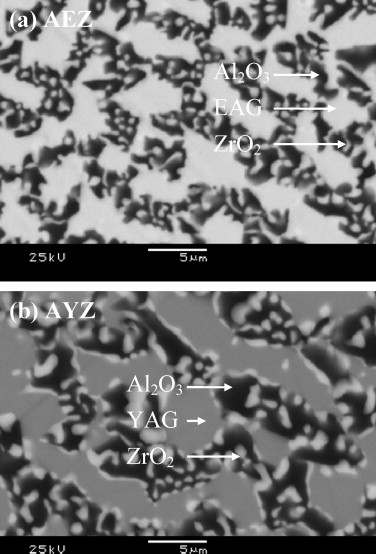
Abstract
The microstructural and high-temperature mechanical characteristics of directionally solidified rods of Al2O3–Er3Al5O12–ZrO2 ternary eutectic oxides processed by the laser-heated floating zone method at different growth rates have been investigated. The eutectic microstructure displayed an entangled three-dimensional network of Al2O3 and Er3Al5O12 phases of similar sizes, elongated along the growth direction; the minority zirconia phase formed small fibers into the alumina phase. The interphase spacing is reduced with increasing solidification rate, changing about 2 μm down to 200 nm. These microstructural features are essentially the same exhibited by Al2O3–Y3Al5O12–ZrO2 composites processed by the same technique. Compressive deformation tests performed at 1400 °C at constant strain rate showed that the creep resistance decreased when increasing the growth rate due to the refinement of the microstructure.
Septiembre, 2012 · DOI: 10.1016/j.jallcom.2012.01.105
Materiales de Diseño para la Energía y Medioambiente
High-temperature mechanical characteristics of NiO/3YTZP composites
Jimenez-Melendo, M; Oliva-Ramirez, M; Huaman-Mamani, FAJournal of Alloys and Compounds, 536 (2012) S472-S476 DOI: 10.1016/j.jallcom.2011.11.040
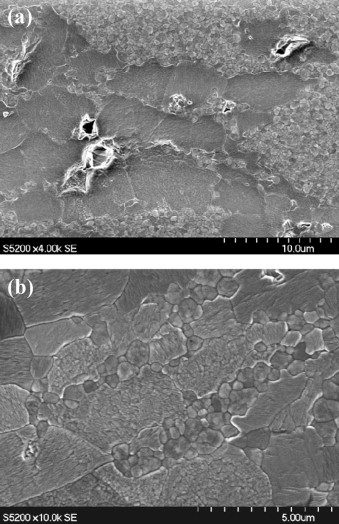
Abstract
NiO/3YTZP (3 mol% Y2O3-stabilized tetragonal ZrO2) composites with 40 mol% NiO (26 vol% NiO) have been fabricated by mechanical mixing of NiO and 3YTZP powders and sintering at 1500 °C for 10 h in air. The resulting microstructures have been characterized by electron microscopy. Compressive mechanical tests at constant strain rate were conducted on these materials at temperatures between 1150 and 1350 °C in air. The σ–ɛ curves display extended secondary creep regimes without signals of macroscopic failure. The composite creep behavior is characterized by a stress exponent n = 2 and an activation energy for flow Q = 490 kJ/mol. The overall creep behavior of the composites is essentially controlled by the zirconia matrix, due to the softness of the NiO phase in the experimental conditions used in this study.
Septiembre, 2012 · DOI: 10.1016/j.jallcom.2011.11.040
Materiales de Diseño para la Energía y Medioambiente
Effects of the presence of Fe(0) on the sorption of lanthanum and lutetium mixtures in smectites
Galunin, E; Alba, MD; Santos, MJ; Vidal, MApplied Clay Science, 65-66 (2012) 162-172 DOI: 10.1016/j.clay.2012.06.011
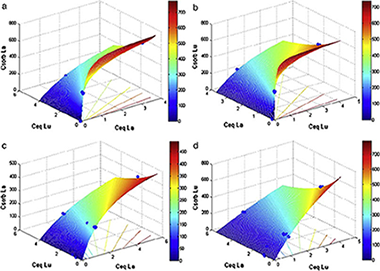
Abstract
The sorption of La and Lu mixtures was examined in two bentonites after incubation for three months at 20 and 80 °C with Fe(0), as a laboratory approach to evaluate the effects of waste canister corrosion in a deep repository on the performance of clay engineered barriers. The sorption/desorption parameters were determined from batch tests in two ionic media: deionized water and, to consider the additional effect of cement leachates, 0.02 mol L− 1 Ca.
Results from XRD analyses showed the formation of crystalline FeO(OH), goethite, in a few samples and the degradation of the bentonites due to Fe(0) oxidation during incubation. Moreover, the EDX spectra showed that the lanthanides were sorbed primarily at smectite sites, although sorption onto goethite was also observed, whereas Fe(0) particles did not contribute to lanthanide sorption. The formation of goethite could explain the high Kd values measured in a few scenarios (e.g., those with single solutions or mixtures with the lowest initial concentration of the competitive lanthanide in which high affinity sites governed sorption), with up to 3-fold increases over the values obtained without Fe incubation. However, at higher lanthanide concentration, Kd values decreased or remained constant compared to the samples without Fe incubation, which could be explained by bentonite degradation. In the Ca medium, as much as 5 times lower Kd values were obtained, because of the competitive effect of the Ca ions, especially for Lu in the MX80 bentonite. This indicated that the small number of high affinity sites had been diminished.
The sorption data were satisfactorily fitted to a two-solute Langmuir model. In addition, Kd values correlated well with desorption data, which showed that the larger the decrease in Kd, the larger the increase in sorption reversibility. It is suggested that corrosion products from the metal canister might compromise the long-term radionuclide retention of the clay-engineered barriers.
Septiembre, 2012 · DOI: 10.1016/j.clay.2012.06.011
Materiales de Diseño para la Energía y Medioambiente
Thermal conductivity of high-porosity heavily doped biomorphic silicon carbide prepared from sapele wood biocarbon
Parfen'eva, LS; Orlova, TS; Smirnov, BI; Smirnov, IA; Misiorek, H; Mucha, J; Jezowski, A; Cabezas-Rodriguez, R; Ramirez-Rico, JPhysics of the Solid State, 54 (2012) 1732-1739 DOI: 10.1134/S1063783412080240
Abstract
The electrical resistivity and thermal conductivity of high-porosity (~52 vol %, channel-type pores) bio-SiC samples prepared from sapele wood biocarbon templates have been measured in the temperature range 5-300 K. An analysis has been made of the obtained results in comparison with the data for bio-SiC samples based on beech and eucalyptus, as well as for polycrystalline β-SiC. The conclusion has been drawn that the electrical resistivity and thermal conductivity of bio-SiC samples based on natural wood are typical of heavily doped polycrystalline β-SiC.
Agosto, 2012 · DOI: 10.1134/S1063783412080240
Materiales de Diseño para la Energía y Medioambiente
Biomimetic mineralization of calcium phosphate on a functionalized porous silicon carbide biomaterial
Dey, A; van den Hoogen, CJ; Rosso, M; Lousberg, N; Hendrix, MMRM; Friedrich, H; Ramirez-Rico, J; Zuilhof, H; de With, G; Sommerdijk, NAJMChemPlusChem, 77 (2012) 694-699 DOI: http://onlinelibrary.wiley.com/doi/10.1002/cplu.201200118/full

Abstract
Porous biomorphic silicon carbide (bioSiC) is a structurally realistic, high-strength, and biocompatible material which is promising for application in load-bearing implants. The deposition of an osteoconductive coating is essential for further improvement of its integration with the surrounding tissue. A new strategy towards biomimetic calcium phosphate coatings on bioSiC is described. X-ray photoelectron spectroscopy (XPS) analysis shows that using 10-undecenoic acid methyl ester a covalently bound monolayer can be synthesized on the surface of the bioSiC. After hydrolysis it exposes carboxylic acid groups that promote the selective nucleation and growth of a very well-defined crystalline layer of calcium phosphate. The resulting calcium phosphate coating is characterized by X-ray diffraction and electron microscopy techniques. Further, ion beam imaging is employed to quantify the mineral deposition meanwhile, three-dimensional dual-beam imaging (FIB/SEM) is used to visualize the bioSiC/mineral interface. The monolayer is show to actively induce the nucleation of a well-defined and highly crystalline mixed octacalcium phosphate/hydroxyapatite (OCP/HAP) coating on implantable bioSiC substrates with complex geometry. The mild biomimetic procedure, in principle, allows for the inclusion of bioactive compounds that aid in tissue regeneration. Moreover, the mixed OCP/HAP phase will have a higher solubility compared to HAP, which, in combination with its porous structure, is expected to render the coating more reabsorbable than standard HAP coatings.
Agosto, 2012 · DOI: http://onlinelibrary.wiley.com/doi/10.1002/cplu.201200118/full
Materiales de Diseño para la Energía y Medioambiente
Synthetic high-charge organomica: Effect of the layer charge and alkyl chain length on the structure of the adsorbed surfactants
Pazos, MC; Castro, MA; Orta, MM; Pavon, E; Rios, JSV; Alba, MDLangmuir, 28 (2012) 7325-7332 DOI: 10.1021/la300153e

Abstract
A family of organomicas was synthesized using synthetic swelling micas with high layer charge (NanSi8-nAlnMg6F4O20 center dot XH2O, where n = 2, 3, and 4) exchanged with dodecylammonium and octadecylammonium cations. The molecular arrangement of the surfactant was elucidated on the basis on XRD patterns and DTA. The ordering conformation of the surfactant molecules into the interlayer space of micas was investigated by C-13, Al-27, and Si-29 MAS NMR The arrangement of alkylammonium ions in these high-charge synthetic micas depends on the combined effects of the layer charge of the mica and the chain length of the cation. In the organomicas with dodecylammonium, a transition from a parallel layer to a bilayer-paraffin arrangement is observed when the layer charge of the mica increases. However, when octadecylammonium is the interlayer cation, the molecular arrangement of the surfactant was found to follow the bilayer-paraffin model for all values of layer charge. The amount of ordered conformation all-trans is directly proportional of layer charge.
Mayo, 2012 · DOI: 10.1021/la300153e
Materiales de Diseño para la Energía y Medioambiente
Interfacial characterization of silicon nitride/silicon nitride joints brazed using Cu-base active metal interlayers
Singh, M; Fernandez, JM; Asthana, R; Rico, JRCeramics Intenational, 38 (2012) 2793-2802 DOI: 10.1016/j.ceramint.2011.11.050
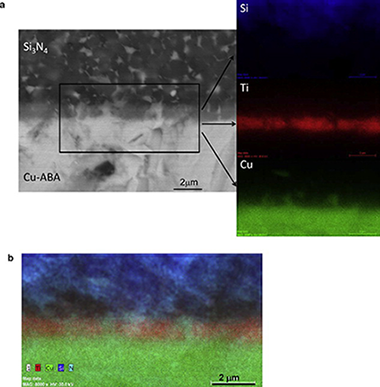
Abstract
Silicon nitride/silicon nitride joints were vacuum brazed at 1317 K for 5 min and 30 min using ductile Cu-base active metal interlayers. The joints were characterized using scanning electron microscopy (SEM), energy dispersive spectroscopy (EDS), electron back scattered diffraction (EBSD), and transmission electron microscopy (TEM). An inhomogeneous Ti-rich reaction layer (similar to 2-3 mu m thick) formed in 5 min at the Si3N4/braze interface. The inhomogeneity disappeared after brazing for 30 min and was replaced with a compact and featureless reaction zone. TEM studies revealed fine grains in the reaction layer, and larger grains in the inner part of the joint interfaces. The joints were crack-free and presented features associated with plastic deformation, which indicated accommodation of strain associated with CTE mismatch. Electron Backscatter diffraction (EBSD) revealed a highly textured braze alloy interlayer and its crystallographic orientation was determined. The formation of additional phases at the joint interface during brazing is discussed.
Mayo, 2012 · DOI: 10.1016/j.ceramint.2011.11.050
Materiales de Diseño para la Energía y Medioambiente
Remediation of metal-contaminated soils with the addition of materials - Part II: Leaching tests to evaluate the efficiency of materials in the remediation of contaminated soils
Gonzalez-Nunez, R; Alba, MD; Orta, MM; Vidal, M; Rigol, AChemosphere, 87 (2012) 829-837 DOI: 10.1016/j.chemosphere.2012.01.015
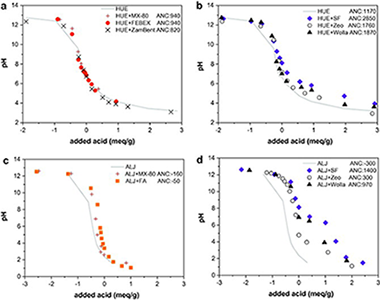
Abstract
The effect of the addition of materials on the leaching pattern of As and metals (Cu, Zn, Ni, Pb, and Cd) in two contaminated soils was investigated. The examined materials included bentonites, silicates and industrial wastes, such as sugar foam, fly ashes and a material originated from the zeolitization of fly ash. Soil + material mixtures were prepared at 10% doses. Changes in the acid neutralization capacity, crystalline phases and contaminant leaching over a wide range of pHs were examined by using pHstat leaching tests. Sugar foam, the zeolitic material and MX-80 bentonite produced the greatest decrease in the leaching of pollutants due to an increase in the pH and/or the sorption capacity in the resulting mixture. This finding suggests that soil remediation may be a feasible option for the reuse of non-hazardous wastes.
Mayo, 2012 · DOI: 10.1016/j.chemosphere.2012.01.015
Materiales de Diseño para la Energía y Medioambiente
Residual stresses in Al2O3-ZrO 2 (3mol.% Y2O3) directionally solidified eutectic ceramics as a function of temperature
Ramirez-Rico, J; Martinez-Fernandez, J; Pena, JI; Singh, D; Routbort, JMaterials Science and Engineering A, 541 (2012) 61-66 DOI: 10.1016/j.msea.2012.02.001
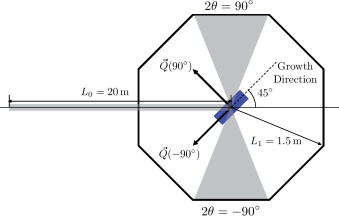
Abstract
Directionally solidified eutectics are in situ composites grown from the melt. Due to the differences in the thermoelastic properties of the different phases present in the material, these composites often exhibit residual stresses that can affect their mechanical properties. In this work we use neutron diffraction to investigate residual stresses in Al 2O 3-ZrO 2 eutectic composites as a function of temperature, for samples processed at two different growth rates, 10mm/h and 750mm/h. Our results show that the stress-free temperature is in the range of 1200±200°C. We explain the experimental observations based on the thermoelastic properties of the phases in the material and confirm our measurements using a simple, self-consistent model.
Abril, 2012 · DOI: 10.1016/j.msea.2012.02.001
Materiales de Diseño para la Energía y Medioambiente
Electrostatic Induced Molecular Tilting in Self-Assembled Monolayers of n-Octadecylamine on Mica
Oviedo, J; San-Miguel, MA; Heredia-Guerrero, JA; Benitez, JJJournal of Physical Chemistry C, 116 (2012) 7099-7105 DOI: 10.1021/jp300829g
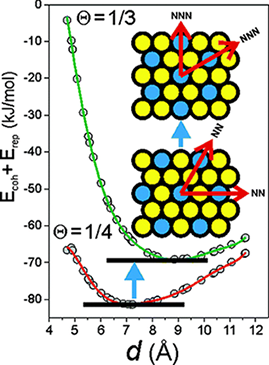
Abstract
Self-assembled monolayers of n-octadecylamine on mica (ODA/mica SAMs) have been investigated by atomic force microscopy (AFM) and by attenuated total reflectance infrared (ATR-FTIR) and X-ray photoelectron (XPS) spectroscopies. Topographic data characterizes a stable configuration with the alkyl skeleton tilted approximate to 46 degrees from the surface normal that is rationalized according to a well established structural alkyl chain packing model. Extended contact with air increases molecular tilting up to approximate to 58 degrees. ATR-FTIR and XPS reveal the presence of protonated amino groups within the monolayer and its increment upon exposure to air. The transition between both tilted states is explained assuming the protonation reaction as the driving force and introducing a model to evaluate an electrostatic repulsions term in the overall cohesive energy balance of the system. ODA molecules in the self-assembled monolayer respond to their spontaneous protonation by atmospheric water by tilting as a mechanism to relax the repulsions between -NH3+ heads.
Marzo, 2012 · DOI: 10.1021/jp300829g
Materiales de Diseño para la Energía y Medioambiente
Effect of oxidation on the compressive strength of sintered SiC-fiber bonded ceramics
Ramirez-Rico, J; Martinez-Fernandez, J; Singh, MMaterials Science and Engineering A, 534 (2012) 394-399 DOI: 10.1016/j.msea.2011.11.085
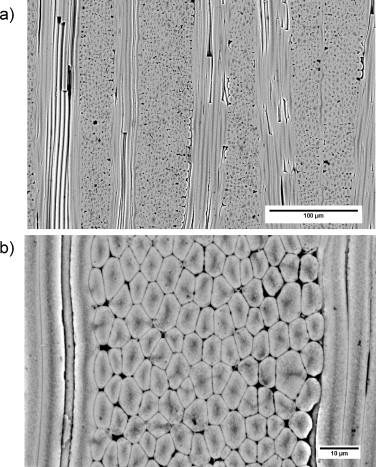
Abstract
The compressive strength of SiC-fiber bonded ceramics obtained from hot-pressed amorphous Si-Al-C-O fibers and its degradation by high temperature exposure to an oxidizing environment was studied. Compressive strength was measured at room temperature as a function of strain rate, orientation, and oxidation temperature. Weight loss was monitored as a function of exposure time in atmospheric air at temperatures ranging from 800 to 1600°C, for times ranging from 0.5 to 5. h. Room-temperature compressive strength had a moderate decrease after exposures at 800°C associated to carbon burnout; increased for exposures in the range 1000-1500°C due to a defect-blunting action of the silica scale; and decreased significantly at 1600°C due to extensive surface recession.
Febrero, 2012 · DOI: 10.1016/j.msea.2011.11.085
2011
2011
Materiales de Diseño para la Energía y Medioambiente
Application of the solid state NMR to the study of the alcohol/alkane mixtures adsorption onto graphite
María D. Alba, Miguel A. Castro, Stuart M. Clarke, Santiago Medina, Loic Messe, Carmen MillánSolid State Nuclear Magnetic Resonance, 40 (2011) 138-143 DOI: 10.1016/j.ssnmr.2011.11.002

Abstract
The mixing of molecules adsorbed from solution to different interfaces has both industrial and academic relevance and the mixing behaviour at the interface is a key to understanding for example, that the surface tension of a mixture of two surfactants is lower than either of the two pure materials and many other effects. In this paper, we report, for the first time, the application of Solid State NMR to the study of alkane/alcohol mixtures, in a range of relative size ratio between 0 and 0.35, adsorbed onto graphite at high, multilayer coverage. Moreover, this paper evaluated, for the first time, the utility of the combined used of 1H and 2H NMR for: (i) determining the surface composition and (ii) making a theoretical approach to the sorption isotherm. A variety of preferential adsorption behaviour is reported. Preferential adsorption of the longer molecule (decane vs. heptanol) from a mixture has been observed. However, if both components are of similar length, the alcohol is preferentially adsorbed (heptanol vs. octane and octanol vs. octane). Finally, a linear relation between the relative size ratio and the amount of alcohol at monolayer coverage is observed.
Noviembre, 2011 · DOI: 10.1016/j.ssnmr.2011.11.002
Materiales de Diseño para la Energía y Medioambiente
Remediation of metal-contaminated soils with the addition of materials – Part I: Characterization and viability studies for the selection of non-hazardous waste materials and silicates
R. González-Núñez, M.D. Alba, M.M. Orta, M. Vidal, A. RigolChemosphere, 85 (2011) 1511-1517 DOI: 10.1016/j.chemosphere.2011.09.042
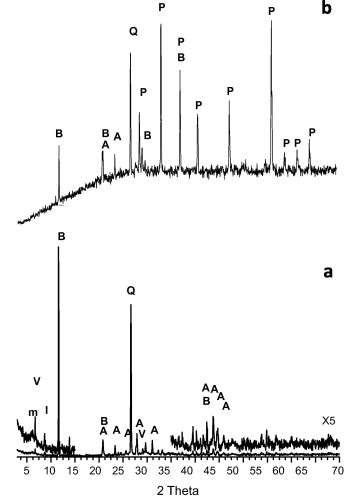
Abstract
Contamination episodes in soils require interventions to attenuate their impact. These actions are often based on the addition of materials to increase contaminant retention in the soil and to dilute the contaminant concentration. Here, non-hazardous wastes (such as sugar foam, fly ash and a material produced by the zeolitization of fly ash) and silicates (including bentonites) were tested and fully characterized in the laboratory to select suitable materials for remediating metal-contaminated soils. Data from X-ray fluorescence (XRF), N2 adsorption/desorption isotherms, X-ray diffraction (XRD) and scanning electron microscopy/energy-dispersive X-ray spectroscopy (SEM–EDX) analyses revealed the chemical composition, specific surface area and the phases appearing in the materials. A pH titration test allowed the calculation of their acid neutralization capacity (ANC). The metal sorption and desorption capacities of the waste materials and silicates were also estimated. Sugar foam, fly ash and the zeolitic material were the best candidate materials. Sugar foam was selected because of its high ANC (17 000 meq kg−1), and the others were selected because of their larger distribution coefficients and lower sorption reversibilities than those predicted in the contaminated soils.
Noviembre, 2011 · DOI: 10.1016/j.chemosphere.2011.09.042
Materiales de Diseño para la Energía y Medioambiente
Structure, Electrical Resistivity, and Thermal Conductivity of Beech Wood Biocarbon Produced at Carbonization Temperatures below 1000 degrees C
Parfen'eva, LS; Orlova, TS; Kartenko, NF; Smirnov, BI; Smirnov, IA; Misiorek, H; Jezowski, A; Muha, J; Vera, MCPhysics of the Solid State, 53 (2011) 2398-2407 DOI: 10.1134/S1063783411110230
Abstract
This paper reports on measurements of the thermal conductivity. and the electrical resistivity. in the temperature range 5-300 K, and, at 300 K, on X-ray diffraction studies of high-porosity (with a channel pore volume fraction of similar to 47 vol %) of the beech wood biocarbon prepared by pyrolysis (carbonization) of tree wood in an argon flow at the carbonization temperature T(carb) = 800 degrees C. It has been shown that the biocarbon template of the samples studied represents essentially a nanocomposite made up of amorphous carbon and nanocrystallites-"graphite fragments" and graphene layers. The sizes of the nanocrystallites forming these nanocomposites have been determined. The dependences rho(T) and kappa(T) have been measured for the samples cut along and perpendicular to the tree growth direction, thus permitting determination of the magnitude of the anisotropy of these parameters. The dependences rho(T) and kappa(T), which have been obtained for beech biocarbon samples prepared at T(carb) = 800 degrees C, are compared with the data amassed by us earlier for samples fabricated at T(carb) = 1000 and 2400 degrees C. The magnitude and temperature dependence of the phonon thermal conductivity of the nanocomposite making up the beech biocarbon template at T(carb) = 800 degrees C have been found.
Noviembre, 2011 · DOI: 10.1134/S1063783411110230
Materiales de Diseño para la Energía y Medioambiente
Evolution of Phases and Al–Si Distribution during Na-4-Mica Synthesis
María D. Alba, Miguel A. Castro, Moisés Naranjo, M. Mar Orta, Esperanza Pavón, and M. Carolina PazosJournal of Physical Chemistry C, 2011, 115 (41), pp 20084–20090 DOI: 10.1021/jp207408h
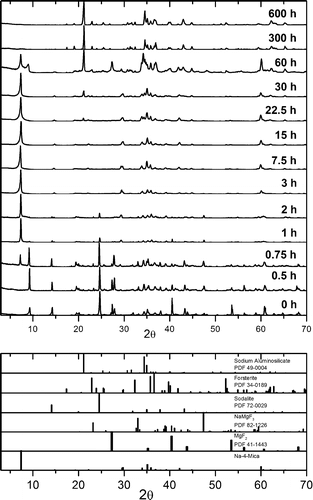
Abstract
Na-4-mica, a highly charged fluorophlogopite, has recently attracted much attention because of its unique combination of high charge (four charges per unit cell) and its swelling and cation-exchange properties. The ability to improve the properties of this mica depends on gaining knowledge about its phase evolution during the calcination process. For the synthesis, the stoichiometric powder mixture (4SiO 2/2Al 2O 3/6MgF 2/8NaCl) was heated to 900 °C for 0-600 h. The obtained solids were characterized by X-ray fluorescence (XRF); X-ray diffraction (XRD); scanning electron microscopy/energy-dispersive X-ray (SEM/EDX) analysis; 29Si, 27Al, and 23Na magic-angle-spinning MAS NMR spectroscopy; and thermogravimetric/differential thermal analysis (TG/DTA). The results showed that the precursors are rapidly (t < 3 h) transformed into sodalite, Al 6Na 8(SiO 4) 6Cl 2, and a 2:1 phyllosilicate. For t = 7.5 h, the amount of 2:1 phyllosilicate increased as a result of the decomposition of sodalite, with a progressive incorporation of aluminum in the 2:1 phyllosilicate being observed. For t = 7.5 h, synthesis of Na-4-mica was considered to be complete, as the material remained essentially unaltered for the next 15 h. For t = 30 h, the mica started to decompose, and for very long reaction times (t ≥ 300 h), only forsterite and a carnegierite phase were present.
Octubre, 2011 · DOI: 10.1021/jp207408h
Materiales de Diseño para la Energía y Medioambiente
The effect of polymorphic structure on the structural and chemical stability of yttrium disilicates
Evgeny Galunin, Miquel Vidal and María D. AlbaAmerican Mineralogist, 96 (2011) 1512-1520 DOI: 10.2138/am.2011.3659
Abstract
Under pressure and temperature conditions like those found in deep geological repositories (DGRs), rare-earth cations may react with silicates to form rare-earth disilicates. This study establishes the stability range of yttrium disilicates in response to changes in pH. The α, β, γ, and δ polymorphs of Y2Si2O7 were synthesized by the sol-gel process at temperatures between 1100 and 1650 °C and subjected to pHstat leaching tests. By measuring the Y and Si leaching rates and monitoring the transformation of the crystalline and amorphous phases, we showed that yttrium disilicates were stable at pH > 5. At pH < 5, the pH stability sequence was consistent with the temperature-dependent stabilities of Y2Si2O7 phases, with the δ polymorph showing the lowest leaching rates. Because rare-earth compounds can be used as a proxy for analogous actinide hosts, the results of this study can be used to predict the performance of engineered barriers in DGR.
Octubre, 2011 · DOI: 10.2138/am.2011.3659
Materiales de Diseño para la Energía y Medioambiente
Structure and Chemical State of Octadecylamine Self-Assembled Monolayers on Mica
Benitez, JJ; San-Miguel, MA; Dominguez-Meister, S; Heredia-Guerrero, JA; Salmeron, MJournal of Physical Chemistry C, 115 (40) (2011) 19716-19723 DOI: 10.1021/jp203871g
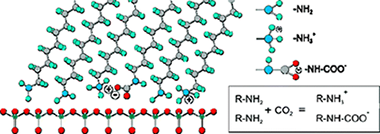
Abstract
Structural and chemical data on n-octadecylamine self-assembled monolayers on mica (ODA/mica SAMs) have been obtained from ATR-FTIR and XPS spectroscopies. The analysis of the methylene modes concludes that alkylamine molecules are arranged in a rigid and well-ordered packing. Besides, the magnitude of the splitting of the methylene scissoring deflection is consistent with a molecular tilted configuration within the self-assembled layer, as already reported from topographic AFM data. Molecular dynamics simulations have supported this conclusion. XPS has revealed the presence of an important fraction of protonated amino groups (-NH3+) even in freshly prepared ODA/mica SAMs in air at RT. Two sources of protonation are proposed: (i) the acid-base reaction of (-NH2) end groups with the water adlayer on the surface of hydrophilic mica and (ii) the formation of an alkylamonium alkylcarbamate by a fast reaction with the atmospheric CO2 dissolved in such water adlayer. Though the water induced amino protonation is hypothetical, the presence of carbamate is univocally confirmed by ATR-FTIR. Upon extended contact with air (ripening) the conformational ordering in ODA/mica SAMs is slightly improved. Besides, further amino group protonation takes place with no additional carbamate formation. The process is described by a tentative mechanism in which protons are transferred from water molecules at the edges of SAMs islands to the inside. On the other side, carbamation is hindered by the steric effect of CO2 molecules trying to penetrate the close packed structure of octadecylamine molecules.
Octubre, 2011 · DOI: 10.1021/jp203871g
Materiales de Diseño para la Energía y Medioambiente
Structural elucidation of Β-(Y,Sc)2Si2O 7: Combined use of 89Y MAS NMR and powder diffraction
Allix, M., Alba, M.D., Florian, P., Fernandez-Carrion, A.J., Suchomel, M.R., Escudero, A., Suard, E., Becerro, A.I.Journal of Applied Crystallography, 44 (2011) 846-852 DOI: 10.1107/S0021889811021303
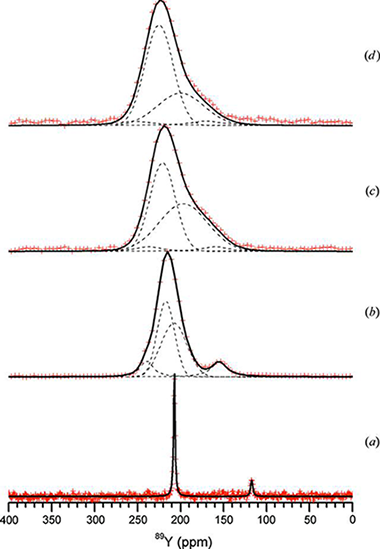
Abstract
Although the structures of pure Sc2Si2O7 and Β-Y2Si 2O7 have been described in the literature using the C2/m space group, 29Si magic angle spinning (MAS) NMR measurements of the intermediate members of the Sc2Si2O7-Β- Y2Si2O7 system indicate a lowering of the symmetry to the C2 space group. Indeed, these compositions exhibit a unique Si crystallographic site and an Si-O-Si angle lower than 180°, incompatible with the C2/m space group. C2 is the only possible alternative. Space group Cm can be discarded with regard to its two different Si sites per unit cell. Moreover, 89Y MAS NMR data have revealed the existence of two different Y sites in the structure of the intermediate members of the Sc 2Si2O7-Β-Y2Si2O 7 system, confirming the lowering of the symmetry to the C2 space group. The viability of the C2 model has therefore been tested and confirmed by refinement of synchrotron and neutron powder diffraction data for the different members of the system. The structural evolutions across the Sc 2Si2O7-Β-Y2Si2O 7 system are discussed.
Agosto, 2011 · DOI: 10.1107/S0021889811021303
Materiales de Diseño para la Energía y Medioambiente
Formation of organo-highly charged mica
Alba, M.D. , Castro, M.A., Orta, M.M., Pavón, E., Pazos, M.C., Valencia Rios, J.S.Langmuir, 16 (2011) 9711-9718 DOI: 10.1021/la200942u

Abstract
The interlayer space of the highly charged synthetic Na-Mica-4 can be modified by ion-exchange reactions involving the exchange of inorganic Na + cations by surfactant molecules, which results in the formation of an organophilic interlayer space. The swelling and structural properties of this highly charged mica upon intercalation with n-alkylammonium (RNH 3) + cations with varying alkyl chain lengths (R = C12, C14, C16, and C18) have been reported. The stability, fine structure, and evolution of gaseous species from alkylammonium Mica-4 are investigated in detail by conventional thermogravimetric analysis (TGA), Fourier transform infrared spectroscopy (FTIR), in situ X-ray diffraction (XRD), and solid-state nuclear magnetic resonance (MAS NMR) techniques. The results clearly show the total adsorption of n-alkylammonium cations in the interlayer space which expands as needed to accommodate intercalated surfactants. The surfactant packing is quite ordered at room temperature, mainly involving a paraffin-type bilayer with an all-trans conformation, in agreement with the high density of the organic compounds in the interlayer space. At temperatures above 160 °C, the surfactant molecules undergo a transformation that leads to a liquid-like conformation, which results in a more disordered phase and expansion of the interlayer space.
Agosto, 2011 · DOI: 10.1021/la200942u
Materiales de Diseño para la Energía y Medioambiente
Solid solubility of Yb2Si2O7 in β-, γ- And δ-Y2Si2O7
Fernández-Carrión, A.J., Alba, M.D., Escudero, A., Becerro, A.I.Journal of Solid State Chemistry, 184 (2011) 1882-1889 DOI: 10.1016/j.jssc.2011.05.034
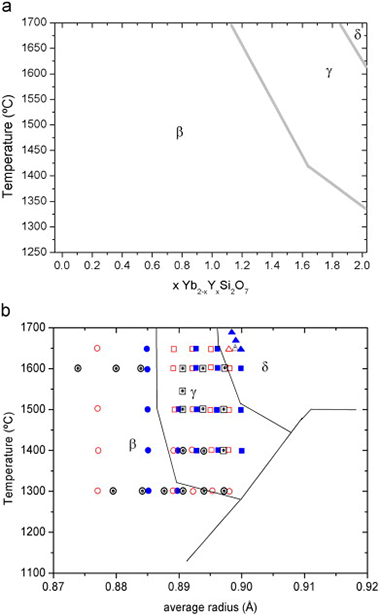
Abstract
This paper examines the structural changes with temperature and composition in the Yb2Si2O7–Y2Si2O7 system; members of this system are expected to form in the intergranular region of Si3N4 and SiC structural ceramics when sintered with the aid of Yb2O3 and Y2O3 mixtures. A set of different compositions have been synthesised using the sol–gel method to obtain a xerogel, which has been calcined at temperatures between 1300 and 1650 °C during different times. Isotherms at 1300 and 1600 °C have been analysed in detail to evaluate the solid solubility of Yb2Si2O7 in β-Y2Si2O7 and γ-Y2Si2O7. Although Yb2Si2O7 shows a unique stable polymorph (β), Yb3+ is able to replace Y3+ in γ-Y2Si2O7 and δ-Y2Si2O7 at high temperatures and low Yb contents. IR results confirm the total solid solubility in the system and suggest a constant SiOSi angle of 180° in the Si2O7 unit across the system. The temperature–composition diagram of the system, obtained from powder XRD data, is dominated by the β-RE2Si2O7 polymorph, with γ-RE2Si2O7 and δ-RE2Si2O7 showing reduced stability fields. The diagram is in accordance with Felsche's diagram if average ionic radii are assumed for the members of the solid solution at any temperature, as long as the β–γ phase boundary is slightly shifted towards higher radii.
Julio, 2011 · DOI: 10.1016/j.jssc.2011.05.034
Reactividad de Sólidos - Materiales de Diseño para la Energía y Medioambiente
High-temperature mechanical behavior of polycrystalline yttrium-doped barium cerate perovskite
Vaquero-Aguilar, C; Lopez-Robledo, MJ; Martinez-Fernandez, J; Real, C; Jimenez-Melendo, MJournal of the European Ceramic Society, 31 (2011) 1333-1338 DOI: 10.1016/j.jeurceramsoc.2010.05.023
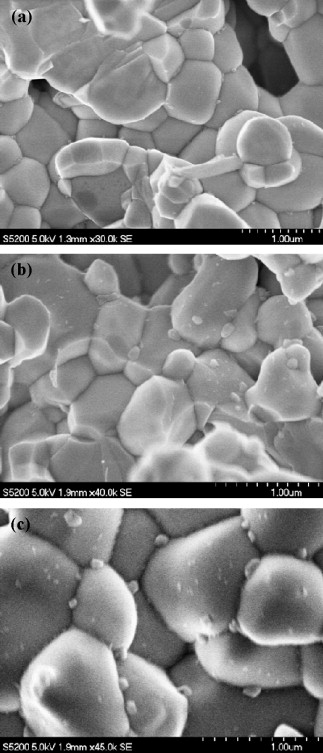
Abstract
The high-temperature mechanical properties of the mixed ionic-electronic conductor perovskite BaCe0.95Y0.05O3−δ with average grain size of 0.40 μm have been studied in compression between 1100 and 1300 °C in air at different initial strain rates. The true stress–true strain curves display an initial stress drop, followed by an extended steady-state stage. As the temperature decreases and/or the strain rate increases, there is a transition to a damage-tolerant strain-softening stage and eventually to catastrophic failure. Analysis of mechanical and microstructural data revealed that grain boundary sliding is the primary deformation mechanism. The strength drop has been correlated with the growth of ultrafine grains during deformation, already present at grain boundaries and triple grain junctions in the as-fabricated material.
Junio, 2011 · DOI: 10.1016/j.jeurceramsoc.2010.05.023
Materiales de Diseño para la Energía y Medioambiente
Microstructural and mechanical evaluation of a Cu-based active braze alloy to join silicon nitride ceramics
Singh, M; Asthana, R; Varela, FM; Martinez-Fernandez, JJournal of the European Ceramic Society, 31 (2011) 1309-1316 DOI: 10.1016/j.jeurceramsoc.2010.07.022
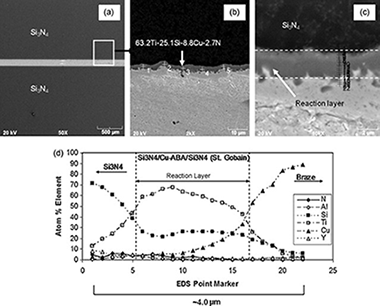
Abstract
Self-joining of St. Gobain Si3N4 (NT-154) using a ductile Cu–Al–Si–Ti active braze (Cu-ABA) was demonstrated. A reaction zone (∼2.5–3.5 μm thick) developed at the interface after 30 min brazing at 1317 K. The interface was enriched in Ti and Si. The room temperature compressive shear strengths of Si3N4/Si3N4 and Inconel/Inconel joints (the latter created to access baseline data for use with the proposed Si3N4/Inconel joints) were 140 ± 49 MPa and 207 ± 12 MPa, respectively. High-temperature shear tests were performed at 1023 K and 1073 K, and the strength of the Si3N4/Si3N4 and Inconel/Inconel joints were determined. The joints were metallurgically well-bonded for temperatures above 2/3 of the braze solidus. Scanning and transmission electron microscopy studies revealed a fine grain microstructure in the reaction layer, and large grains in the inner part of the joint with interfaces being crack-free. The observed formation of Ti5Si3 and AlN at the joint interface during brazing is discussed.
Junio, 2011 · DOI: 10.1016/j.jeurceramsoc.2010.07.022
Materiales de Diseño para la Energía y Medioambiente
Microstructural and mechanical evaluation of porous biomorphic silicon carbide for high temperature filtering applications
Bautista, MA; Cancapa, JQ; Fernandez, JM; Rodriguez, MA; Singh, MJournal of the European Ceramic Society, 31 (2011) 1325-1332 DOI: 10.1016/j.jeurceramsoc.2010.06.014
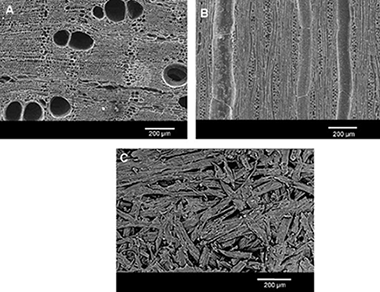
Abstract
Biomorphic SiC (bioSiC) is a low cost SiC/Si composite obtained by melt infiltration of carbon preforms obtained from the pyrolysis of cellulose precursors. The porosity and pore size distribution of bioSiC can be tailored for specific applications by adequate selection of the wood precursor. Natural and artificial industrial woods were explored as possible bioSiC precursors. Silicon was removed by chemical etching. Relevant microstructural parameters such as pore size distribution, total porosity, and permeability were characterized. Since the filtration process involves large pressure gradients along the material at high temperatures, mechanical properties of porous bioSiC from the different precursors were evaluated at room temperature and 800 °C. The feasibility of porous bioSiC as a filtration material for high temperature gasification processes is discussed in terms of these properties. MDF-bioSiC is shown to be a promising material for such applications because of its good mechanical properties, interconnected porosity, pore sizes, and permeability.
Junio, 2011 · DOI: 10.1016/j.jeurceramsoc.2010.06.014
Materiales de Diseño para la Energía y Medioambiente
Electrical properties of biomorphic SiC ceramics and SiC/Si composites fabricated from medium density fiberboard
T.S. Orlova, V.V. Popov, J. Quispe Cancapa, D. Hernández Maldonado, E. Enrique Magarino, F.M. Varela Feria, A. Ramírez de Arellano, J. Martínez FernándezJournal of the European Ceramic Society, 31 (2011) 1317-1323 DOI: 10.1016/j.jeurceramsoc.2010.06.015
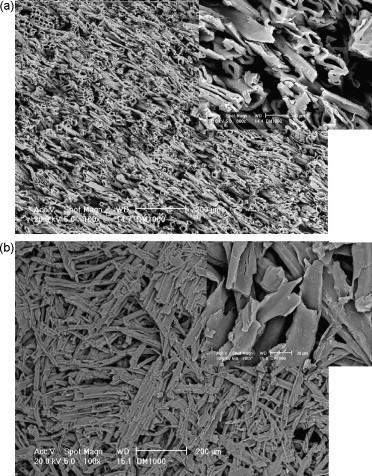
Abstract
A study has been made of the dependences of the electrical resistivity and the Hall coefficient on the temperature in the range 1.8–1300 K and on magnetic fields of up to 28 kOe for the biomorphic SiC/Si (MDF-SiC/Si) composite and biomorphic porous SiC (MDF-SiC) based upon artificial cellulosic precursor (MDF – medium density fiberboards). It has been shown that electric transport in MDF-SiC is effected by carriers of n-type with a high concentration of ∼1020 cm−3 and a low mobility of ∼0.4 cm2 V−1 s−1. The specific features in the conductivity of MDF-SiC are explained by quantum effects arising in disordered systems and requiring quantum corrections to conductivity. The TEM studies confirmed the presence of disordering structural features (nanocrystalline regions) in MDF-SiC. The conductivity of MDF-SiC/Si composite originates primarily from Si component in the temperature range 1.8–500 K and since ∼500 to 600 K the contribution of MDF-SiC matrix becomes dominant.
Junio, 2011 · DOI: 10.1016/j.jeurceramsoc.2010.06.015
Materiales de Diseño para la Energía y Medioambiente
Compressive strength degradation in ZrB2-based ultra-high temperature ceramic composites
Ramirez-Rico, J; Bautista, MA; Martinez-Fernandez, J; Singh, MJournal of the European Ceramic Society, 31 (2011) 1345-1352 DOI: 10.1016/j.jeurceramsoc.2010.05.020
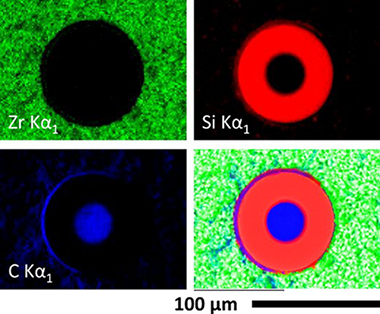
Abstract
The high temperature compressive strength behavior of zirconium diboride (ZrB2)-silicon carbide (SiC) particulate composites containing either carbon powder or SCS-9a silicon carbide fibers was evaluated in air. Constant strain rate compression tests have been performed on these materials at room temperature, 1400, and 1550°C. The degradation of the mechanical properties as a result of atmospheric air exposure at high temperatures has also been studied as a function of exposure time. The ZrB2-SiC material shows excellent strength of 3.1±0.2GPa at room temperature and 0.9±0.1GPa at 1400°C when external defects are eliminated by surface finishing. The presence of C is detrimental to the compressive strength of the ZrB2-SiC-C material, as carbon burns out at high temperatures in air. As-fabricated SCS-9a SiC fiber reinforced ZrB2-SiC composites contain significant matrix microcracking due to residual thermal stresses, and show poor mechanical properties and oxidation resistance. After exposure to air at high temperatures an external SiO2 layer is formed, beneath which ZrB2 oxidizes to ZrO2. A significant reduction in room temperature strength occurs after 16-24h of exposure to air at 1400°C for the ZrB2-SiC material, while for the ZrB2-SiC-C composition this reduction is observed after less than 16h. The thickness of the oxide layer was measured as a function of exposure time and temperatures and the details of oxidation process has been discussed.
Junio, 2011 · DOI: 10.1016/j.jeurceramsoc.2010.05.020
Materiales de Diseño para la Energía y Medioambiente
Structure and support induced structure disruption of soft nanoparticles obtained from hydroxylated fatty acids
Heredia-Guerrero, JA; San-Miguel, MA; Luna, M; Dominguez, E; Heredia, A; Benitez, JJSoft Matter, 7 (2011) 4357-4363 DOI: 10.1039/c0sm01545h
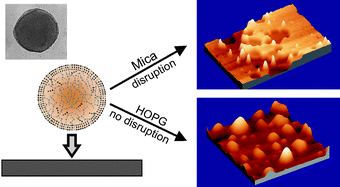
Abstract
Soft and spherical nanoparticles, named as cutinsomes, have been prepared from concentrated 9(10),16-dihydroxypalmitic acid (diHPA) in aqueous solution. After isolation, cutinsomes have been chemically and structurally characterized by ATR-FTIR, TEM and dynamic atomic force microscopy (dynamic AFM). The nanoparticle can be described as a lipidic, liquid-like and mostly esterified core surrounded by a polar shell of carboxylate/carboxylic acid molecules. Molecular dynamic (MD) simulations have been used to support this model. The structural stability of soft cutinsomes has been tested by deposition on both non-polar (HOPG) and polar (mica) flat substrates. It has been found that the magnitude of the interaction between the polar shell of cutinsomes and the support determines their structure conservation or its spreading or rupture and spill out of the liquid-like content. The structural consistence of these nanoparticles as a function of the polarity of substrate is of interest in elucidating the formation mechanism of cutin, the most abundant biopolyester in nature and a very interesting biomaterial to be mimetized.
Mayo, 2011 · DOI: 10.1039/c0sm01545h
Materiales de Diseño para la Energía y Medioambiente
Interaction of Eu-isotopes with saponite as a component of the engineered barrier
María D. Alba, Miguel A. Castro, P. Chaín, Santiago Hurtado, M. Mar Orta, M. Carolina Pazos and María VillaApplied Clay Science, 52 (2011) 253-257 DOI: 10.1016/j.clay.2011.02.027

Abstract
Bentonite is accepted as the best clay material in the engineered barrier of deep geological repositories (DGRs) for radioactive waste disposal. In recent years, the interactions between a wide range of rare-earth (REE) cations and smectites have been studied. A combined study of stable europium and radioactive isotopes is reported here. Saponite was subjected to hydrothermal reactions with stable and radioactive (152Eu) europium ions under subcritical conditions. The structural changes of saponite were evaluated by XRD and SEM. The effect of temperature and reaction time on the changes was quantified by measuring 152Eu through gamma spectrometry. The reaction between europium and saponite was a first-order reaction. The presence of Eu in the precipitate in an amount much higher than the cation exchange capacity of saponite confirmed participation of chemical reactions or surface adsorption in the europium immobilization, even at temperatures as low as 150 °C. The reaction rate constant indicated that an 8- to 9-month period was needed for the completion, without significant changes, of the europium/saponite chemical reaction under the subcritical conditions of 200 °C and 350 °C.
Mayo, 2011 · DOI: 10.1016/j.clay.2011.02.027
Materiales de Diseño para la Energía y Medioambiente
Stability of Rare-Earth Disilicates: Ionic Radius Effect
Galunin, E; Alba, MD; Vidal, MJournal of the American Ceramic Society, 94 (2011) 1568–1574 DOI: 10.1111/j.1551-2916.2010.04272.x
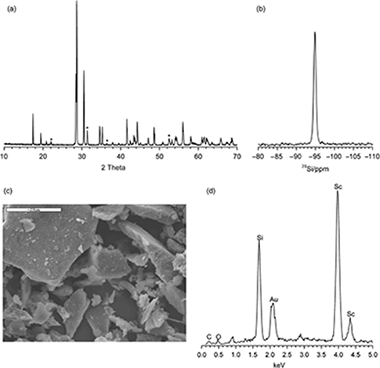
Abstract
Rare-earth (RE) disilicates, of general formula RE2Si 2O7, are one of the products of the chemical reaction between RE (elements), which are actinide simulators, and the silicates used in the engineered barrier systems of deep geological repositories (DGPs). The aim of this paper is to establish the stability range of the disilicate phase as function of the nature of the RE (RE=Sc, Lu, or Y) and examine whether this phase would permit RE leaching under experimental conditions simulating those of the DGP. The β-polymorphs of the RE disilicates were synthesized by the sol-gel method and subsequently submitted to a pHstat leaching test. The rates of RE and Si leaching were measured and the transformation of the crystalline and amorphous phases was examined by X-ray powder diffraction and nuclear magnetic resonance techniques. The results indicate that the disilicate phases were stable within a wide range of pH, their stability being related to the hydrated ratio of the RE. Disilicate stability increased with the ionic radius of the RE. As a result, the Sc disilicate was stable throughout the pH range tested, whereas Y and Lu disilicate leaching was only observed at pH<4. Thus, it was confirmed that the formation of the disilicate phases could contribute to the confinement of radioactive wastes in engineered barriers.
Mayo, 2011 · DOI: 10.1111/j.1551-2916.2010.04272.x
Materiales de Diseño para la Energía y Medioambiente
Structural, chemical surface and transport modifications of regenerated cellulose dense membranes due to low-dose γ-radiation
Vazquez, MI; Heredia-Guerrero, JA; Galan, P; Benitez, JJ; Benavente, JMaterials Chemistry and Physics, 126 (2011) 734-740 DOI: 10.1016/j.matchemphys.2010.12.051

Abstract
Modifications caused in commercial dense regenerated cellulose (RC) flat membranes by low-dose γ-irradiation (average photons energy of 1.23 MeV) are studied. Slight structural, chemical and morphological surface changes due to irradiation in three films with different RC content were determined by ATR-FTIR, XRD, XPS and AFM. Also, the alteration of their mechanical elasticity has been studied. Modification of membrane performance was determined from solute diffusion coefficient and effective membrane fixed charge concentration obtained from NaCl diffusion measurements. Induced structural changes defining new and effective fracture propagation directions are considered to be responsible for the increase of fragility of irradiated RC membranes. The same structural changes are proposed to explain the reduction of the membrane ion permeability through a mechanism involving either ion pathways elongation and/or blocking.
Abril, 2011 · DOI: 10.1016/j.matchemphys.2010.12.051
Materiales de Diseño para la Energía y Medioambiente
Bulk and Adsorbed Monolayer Phase Behavior of Binary Mixtures of Undecanoic Acid and Undecylamine: Catanionic Monolayers
Sun, C; Bojdys, MJ; Clarke, SM; Harper, LD; Jefferson, A; Castro, MA; Medina, SLangmuir, 27 (2011) 3626-3637 DOI: 10.1021/la1048198

Abstract
Differential scanning calorimetry (DSC) and X-ray powder diffraction (PXRD) have been used to determine the phase behavior of the binary mixtures of undecanoic acid (A) and undecylamine (B) in the bulk. In addition, we report DSC data that indicates very similar behavior for the solid monolayers of these materials adsorbed on the surface of graphite. The two species are found to form a series of stoichiometric complexes of the type AB, A2B, and A 3B on the acid rich side of the phase diagram. Interestingly, no similar series of complexes is evident on the amine rich side. As a result of this complexation, the solid monolayers of the binary mixtures exhibit a very pronounced enhancement in stability relative to the pure adsorbates.
Abril, 2011 · DOI: 10.1021/la1048198
Materiales de Diseño para la Energía y Medioambiente
The biophysical design of plant cuticles: an overview
Dominguez, E; Heredia-Guerrero, JA; Heredia, ANew Phytologist, 189 (2011) 938-949 DOI: 10.1111/j.1469-8137.2010.03553.x
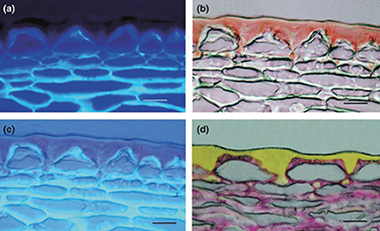
Abstract
The outer surfaces of epidermal cell walls are impregnated with an extracellular matrix called the cuticle. This composite matrix provides several functions at the interface level that enable plants to thrive in different habitats and withstand adverse environmental conditions. The lipid polymer cutin, which is the main constituent of the plant cuticle, has some unique biophysical properties resulting from its composition and structure. This review summarizes the progress made towards understanding the biophysical significance of this biopolymer with special focus on its structural, thermal, biomechanical, and hydric properties and relationships. The physiological relevance of such biophysical properties is discussed in light of existing knowledge on the plant cuticle.
Marzo, 2011 · DOI: 10.1111/j.1469-8137.2010.03553.x
Materiales de Diseño para la Energía y Medioambiente
Monolayer structures of alkyl aldehydes: Odd-membered homologues
Phillips, TK; Clarke, SM; Bhinde, T; Castro, MA; Millan, C; Medina, SThin Solid Films, 519 (2011) 3123-3127 DOI: 10.1016/j.tsf.2010.12.084

Abstract
Crystalline monolayers of three aldehydes with an odd number of carbon atoms in the alkyl chain (C7, C9 and C11) at low coverages are observed by a combination of X-ray and neutron diffraction. Analysis of the diffraction data is discussed and possible monolayer crystal structures are proposed; although unique structures could not be ascertained for all molecules. We conclude that the structures are flat on the surface, with the molecules lying in the plane of the layer. The C11 homologue is determined to have a plane group of either p2, pgb or pgg, and for the C7 homologue the p2 plane group is preferred.
Marzo, 2011 · DOI: 10.1016/j.tsf.2010.12.084
Materiales de Diseño para la Energía y Medioambiente
Blocking of grain reorientation in self-doped alumina materials
Suarez, M; Fernandez, A; Menendez, JL; Ramirez-Rico, J; Torrecillas, RScripta Materialia, 64 (2011) 517-520 DOI: 10.1016/j.scriptamat.2010.11.031
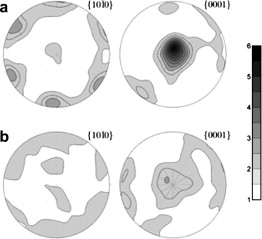
Abstract
Alumina nanoparticles 10-20 nm in diameter were nucleated on alumina particles, 150 nm average diameter, by a colloidal route followed by calcination. It is shown that after sintering, the final grain size is up to 20% smaller due to the addition of the alumina nanoparticles. Electron backscattered diffraction analysis shows that whereas a correlation in the relative crystalline orientations between neighbouring grains exists in the pure materials, the addition of alumina nanoparticles results in a random crystalline orientation.
Marzo, 2011 · DOI: 10.1016/j.scriptamat.2010.11.031
Materiales de Diseño para la Energía y Medioambiente
Examination of competitive lanthanide sorption onto smectites and its significance in the management of radioactive waste
Galunin, E; Alba, MD; Santos, MJ; Abrao, T; Vidal, MJournal of Hazardous Materials, 186 (2011) 1930-1941 DOI: 10.1016/j.jhazmat.2010.12.098

Abstract
The competitive effect of La and Lu (analogues of radionuclides appearing in radioactive waste) in the sorption in four smectites was examined. Sorption and desorption distribution coefficients (Kd; Kd,des), and desorption rates (Rdes) were determined from batch tests in two media: deionized water and, to consider the influence of cement leachates, 0.02molL-1 Ca. The competitive effect was lower when high-affinity sites were available, as in the water medium at the lowest range of initial lanthanide concentration, with high Kd for La and for Lu (5-63×104Lkg-1). Lower Kd was measured at higher initial concentrations and in the Ca medium, where Lu showed a stronger competitive effect. This was confirmed by fitting the sorption data to a two-solute Langmuir isotherm. The desorption data indicated that sorption was virtually irreversible for the scenarios with high sorption, with an excellent correlation between Kd and Kd,des (R2 around 0.9 for the two lanthanides). Assuming that radioactive waste is a mixture of radionuclides, and that Ca ions will be provided by the cement leachates, this would reduce the retention capacity of clay engineered barriers.
Febrero, 2011 · DOI: 10.1016/j.jhazmat.2010.12.098
2010
2010
Materiales de Diseño para la Energía y Medioambiente
Bioactivation of biomorphous silicon carbide bone implants
Will J, Hoppe A, Muller FA, Raya CT, Fernandez JM, Greil PActa Biomaterialia, 6 (2010) 448-4494 DOI: 10.1016/j.actbio.2010.06.036
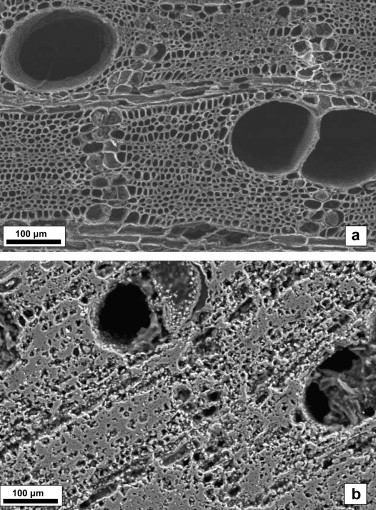
Abstract
Wood-derived silicon carbide (SiC) offers a specific biomorphous microstructure similar to the cellular pore microstructure of bone. Compared with bioactive ceramics such as calcium phosphate, however, silicon carbide is considered not to induce spontaneous interface bonding to living bone. Bioactivation by chemical treatment of biomorphous silicon carbide was investigated in order to accelerate osseointegration and improve bone bonding ability. Biomorphous SiC was processed from sipo (Entrandrophragma utile) wood by heating in an inert atmosphere and infiltrating the resulting carbon replica with liquid silicon melt at 1450 °C. After removing excess silicon by leaching in HF/HNO3 the biomorphous preform consisted of β-SiC with a small amount (approximately 6 wt.%) of unreacted carbon. The preform was again leached in HCl/HNO3 and finally exposed to CaCl2 solution. X-ray photoelectron spectroscopy (XPS) and Fourier transform infrared analyses proved that oxidation of the residual carbon at the surface induced formation of carboxyl [COO-] groups, which triggered adsorption of Ca2+, as confirmed by XPS and inductively coupled plasma optical emission spectroscopy measurements. A local increase in Ca2+ concentration stimulated in vitro precipitation of Ca5(PO 4)3OH (HAP) on the silicon carbide preform surface during exposure to simulated body fluid, which indicates a significantly increased bone bonding activity compared with SiC.
Diciembre, 2010 · DOI: 10.1016/j.actbio.2010.06.036
Materiales de Diseño para la Energía y Medioambiente
Aleuritic (9,10,16-trihydroxypalmitic) acid self-assembly on mica
Heredia-Guerrero, JA; San-Miguel, MA; Sansom, MSP; Heredia, A; Benitez, JJPhysical Chemistry Chemical Physics, 12 (2010) 10423-10428 DOI: 10.1039/c0cp00163e
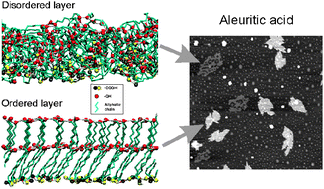
Abstract
Aleuritic (9,10,16-trihydroxypalmitic) acid self-assembly on mica from solution has been studied using AFM, ATR-FTIR and MD simulations. The goal of this study is to define the role of hydroxyl groups in the interaction between molecules as reference data to understand the mechanism of formation of synthetic and natural biopolyesters from polyhydroxylated long chain carboxylic acids. In a confined structure, such as the one imposed by a vertically self-assembled layer on mica, aleuritic acid has a tendency to adopt a monolayer configuration ruled by the lateral interactions between molecules via the two secondary hydroxyl groups. This (2D) growth competes with the multilayer formation (3D), which is conditioned by the terminal primary hydroxyl group. As the self-assembly spatial constraint is relaxed, MD has shown that the structure tends to become an amorphous and crosslinked phase that can be characterized by topographic and friction force AFM data.
Septiembre, 2010 · DOI: 10.1039/c0cp00163e
Materiales de Diseño para la Energía y Medioambiente
Steering the Self-Assembly of Octadecylamine Monolayers on Mica by Controlled Mechanical Energy Transfer from the AFM Tip
Benitez, JJ; Heredia-Guerrero, JA; Salmeron, MJournal of Physical Chemistry C, 114 (2010) 12630-12634 DOI: 10.1021/jp102813s
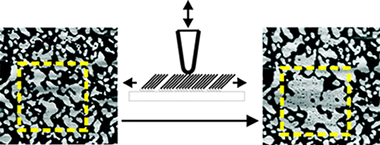
Abstract
We have studied the effect of mechanical energy transfer from the tip of an atomic force microscope on the dynamics of self-assembly of monolayer films of octadecylamine on mica. The formation of the self-assembled film proceeds in two successive stages, the first being a fast adsorption from solution that follows a Langmuir isotherm. The second is a slower process of island growth by aggregation of the molecules dispersed on the surface. We found that the dynamics of aggregation can be altered substantially by the addition of mechanical energy into the system through controlled tip surface interactions. This leads to both the creation of pinholes in existing islands as a consequence of vacancy concentration and to the assembly of residual molecules into more compact islands.
Julio, 2010 · DOI: 10.1021/jp102813s
Materiales de Diseño para la Energía y Medioambiente
Sc-45 Spectroscopy of Solids: Interpretation of Quadrupole Interaction Parameters and Chemical Shifts
Alba, MD; Chain, P; Florian, P; Massiot, DJournal of Physical Chemistry C, 114 (2010) 12125-12132 DOI: 10.1021/jp1036525
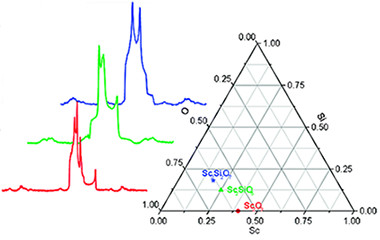
Abstract
The aims of the present study is to describe for the first time the Sc-45 MAS NMR spectra of X-2-Sc2SiO5 and C-Sc2Si2O7, to combine the spectroscopic information with the structures published from diffraction data, and to propose a rational interpretation of the chemical shifts and quadrupolar parameters. For that purposed, we have correlated the experimental quadrupole coupling parameters of Sc-45 determined for a number of scandium compounds to those found by a simple electrostatic calculation and we have found that the isotropic chemical shift of the Sc-45 is linearly correlated to the shift parameter, calculated by bond-valence theory. We also show that a simple point charge calculation can approximate the electric field gradient to a sufficiently good approximation that it provides a valuable mean to assign the NMR spectra.
Julio, 2010 · DOI: 10.1021/jp1036525
Materiales de Diseño para la Energía y Medioambiente
Self-assembly of supramolecular lipid nanoparticles in the formation of plant biopolyester cutin
Dominguez, E; Heredia-Guerrero, JA; Benitez, JJ; Heredia, AMolecular Biosystems, 6 (2010) 948-950 DOI: 10.1039/b927186d
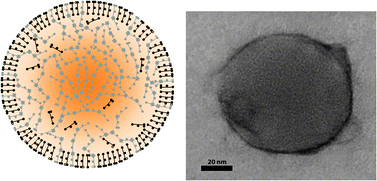
Abstract
The implication of a self-assembly process in the early stages of cutin biosynthesis has been shown by means of antibodies raised against polyhydroxy fatty acid nanoparticles (cutinsomes).
Junio, 2010 · DOI: 10.1039/b927186d
Materiales de Diseño para la Energía y Medioambiente
Application of Micro-X-ray Fluorescence Analysis for the Characterization of Industrial Wastes
Alba, MD; Aparicio, P; Benitez, JM; Castro, MA; Diaz, M; Orta, MMIndustrial & Engineering Chemistry Research, 49 (2010) 2348-2352 DOI: 10.1021/ie901716w
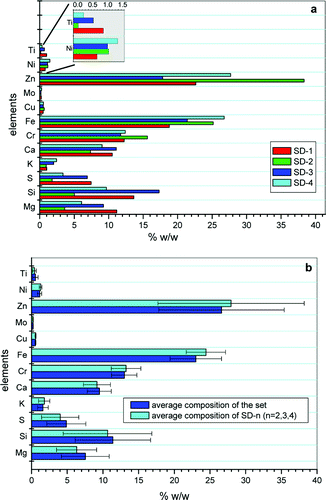
Abstract
The issue of how to improve product quality and product yield in a short period of time is becoming more critical in many industries. Thus, shorter delay times between laboratory analysis and process correction are important in process control. Elimination of sample handling and operator Manipulation is desirable. The present article proposes micro-X-ray fluorescence (mu XRF) as an economical control method for industrial product quality with a minimum time cost. Samples from different industrial processes have been chosen and analyzed by XRF and mu XRF, The results show that the two techniques give similar results and that mu XRF allows the waste to be classified and is able to detect problems in the production process.
Marzo, 2010 · DOI: 10.1021/ie901716w
Materiales de Diseño para la Energía y Medioambiente
Structural characterization of polyhydroxy fatty acid nanoparticles related to plant lipid biopolyesters
Heredia-Guerrero, JA; Dominguez, E; Luna, M; Benitez, JJ; Heredia, AChemistry and Physics of Lipids, 163 (2010) 329-333 DOI: 10.1016/j.chemphyslip.2010.01.006
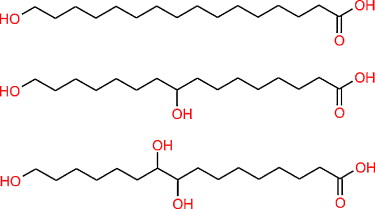
Abstract
In the present work, we report the physico-chemical properties and structural characteristics of special polyhydroxy fatty acid nanoparticles after their fusion by means of attenuated total reflection-Fourier transform infrared spectroscopy (ATR-FTIR), X-ray diffraction (XRD), differential scanning calorimetry (DSC), scanning electronic microscopy (SEM), atomic force microscopy (AFM), and light microscopy. All the characteristics and properties investigated have an important degree of similarity to the native plant cutin, the main biopolymer present in the plant cuticles. The supramolecular organization of these polymerized prime nanoparticles after their interaction on cellulose substrate and isolated cuticle samples, simulating the in vivo conditions in epidermal plant cells, strongly suggests a growth of these nanoparticles after a self-assembly process.
Marzo, 2010 · DOI: 10.1016/j.chemphyslip.2010.01.006
Materiales de Diseño para la Energía y Medioambiente
Lanthanide sorption on smectitic clays in presence of cement leachates
Galunin, E; Alba, MD; Santos, MJ; Abrao, T; Vidal, MGeochimica et Cosmochimica Acta, 74 (2010) 862-875 DOI: 10.1016/j.gca.2009.11.003

Abstract
Due to their potential retention capacity, clay minerals have been proposed for use in the engineered barriers for the storage of high-level radioactive actinides in deep geological waste repositories. However, there is still a lack of data on the sorption of actinides in clays in conditions simulating those of the repositories. The present article examines the sorption of two lanthanides (actinide analogues) in a set of smectitic clays (FEBEX bentonite, MX80 bentonite, hectorite, saponite, Otay montmorillonite, and Texas montmorillonite). Distribution coefficients (K-d) were determined in two media: water and 0.02 mol L-1 Ca, the latter representing the cement leachates that may modify the chemical composition of the water in contact with the clay. The K-d values of the lanthanides used in the experiments (La and Lu) varied greatly (25-50 000 L kg(-1)) depending on the ionic medium (higher values in water than in the Ca medium), the initial lanthanide concentration (up to three orders of magnitude decrease inversely with lanthanide concentration), and the examined clay (up to one order of magnitude for the same lanthanide and sorption medium). Freundlich and Langmuir isotherms were used to fit sorption data to allow comparison of the sorption parameters among smectites. The model based on the two-site Langmuir isotherms provided the best fit of the sorption data, confirming the existence of sorption sites with different binding energies. The sites with higher sorption affinity were about 6% of the total sorption capacity in the water medium, and up to 17% in the Ca medium, although in this latter site sorption selectivity was lower. The wide range of K-d values obtained regarding the factors examined indicated that the retention properties of the clays should also be considered when selecting a suitable clay for engineered barriers.
Febrero, 2010 · DOI: 10.1016/j.gca.2009.11.003
2009
2009
Materiales de Diseño para la Energía y Medioambiente
Reversibility of La and Lu sorption onto smectites: Implications for the design of engineered barriers in deep geological repositories
Galunin, E; Alba, MD; Aviles, MA; Santos, MJ; Vidal, MJournal of Hazardous Materials, 172 (2009) 1198-1205 DOI: 10.1016/j.jhazmat.2009.07.124
Abstract
The sorption reversibility of La and Lu (considered as actinide analogues) onto a set of smectites (bentonite FEBEX; hectorite, HEC; MX80; saponite, SAP; Otay montmorillonite, SCa-3; and Texas montmorillonite, STx-1) was studied to estimate actinide retention by smectites that are candidates for use as engineered barriers in deep geological repositories. The sorption distribution coefficients (K d) and the reversibility parameters (desorption distribution coefficients (K d,des), adjusted distribution coefficients (K d,adj), and desorption rates (R des)) were determined from batch tests in two ionic media: deionized water and Ca 0.02 mol L -1. The latter simulates possible conditions due to the presence of concrete leachates. The results varied greatly depending on the ionic medium, the lanthanide concentration and the clay structure. The high values of K d,des obtained (up to 1.1 × 10 5 and 9.2 × 10 4 L kg -1 for La and Lu in water, and 2.8 × 10 4 and 4.1 × 10 4 L kg -1 for La and Lu in the Ca medium) indicate the suitability of the tested smectites for lanthanide (and therefore, actinide) retention. Based on all the data, SCa-3, HEC and FEBEX clays are considered the best choices for water environments, whereas in Ca environments the suitable clays depended on the lanthanide considered.
Diciembre, 2009 · DOI: 10.1016/j.jhazmat.2009.07.124
Materiales de Diseño para la Energía y Medioambiente
Synthesis and characterization of a plant cutin mimetic polymer
Heredia-Guerrero, JA; Heredia, A; Garcia-Segura, R; Benitez, JJPolymer, 50 (2009) 5633-5637 DOI: 10.1016/j.polymer.2009.10.018
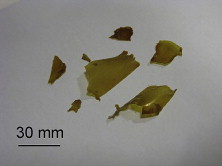
Abstract
A mimetic polymer of plant cutin have been synthesized from 9,10,16-trihydroxyhexadecanoic (aleuritic) acid through a low temperature polycondensation reaction. Reaction conditions (solvent, catalyst, temperature, etc…) were studied and modified to optimize yield and product characteristics. The resulting polyaleurate polymer was characterized by Attenuated Total Reflection-Fourier Transform Infrared Spectroscopy (ATR-FTIR), Differential Scanning Calorimetry (DSC), X-ray Diffraction (XRD) and solid state 13C-Cross Polarization/Magic Angle Spinning Nuclear Magnetic Resonance (13C-CP/MAS NMR). Mechanical and hydrodynamic properties were also investigated. In the average, the product obtained is physically and chemically very similar to plant cutin (a hydrophobic polyester). However, a more detailed analysis of results reveals that polyaleurate framework is more rigid than natural cutin and with additional larger short-range ordered domains. Also, the synthetic polymer displays slightly different mechanical properties with respect to natural cutin. Additional hydrogen bonding within the framework of polyaleurate is considered to be responsible for such experimental observations.
Noviembre, 2009 · DOI: 10.1016/j.polymer.2009.10.018
Materiales de Diseño para la Energía y Medioambiente
The hydrothermal conversion of kaolinite to kalsilite: Influence of time, temperature, and pH
Becerro, AI; Escudero, A; Mantovani, MAmerican Mineralogist, 94 (2009) 11-12 DOI: 10.2138/am.2009.3284
Abstract
Kalsilite (the low-temperature form of KAlSiO4) is used as the precursor of leucite, an important component in porcelain-fused-to-metal and ceramic-restoration systems, and it has also been proposed as a high-thermal expansion ceramic for bonding to metals. The present study reports the hydrothermal synthesis and characterization of pure kalsilite from kaolinite in subcritical conditions, as well as the characterization of the intermediate products by means of XRD, 29Si and 27Al MAS NMR, IR, SEM, and TEM. Effects of time, temperature, and pH on the reaction products are analyzed. The experimental data indicate that pure kalsilite is obtained after hydrothermal treatment of kaolinite at 300 °C for 12 h in 0.5 M KOH solution. Longer reaction times increase the crystallinity of the structure, whereas lower reaction times give rise to the metastable ABW-type KAlSiO4 polymorph. Lower temperatures are not sufficient to produce kalsilite, but zeolite W is obtained instead as the unique reaction product. Finally, the pH of the aqueous solution in contact with kaolinite is an important parameter for the synthesis of kalsilite, which must be ≥13.70.
Noviembre, 2009 · DOI: 10.2138/am.2009.3284
Materiales de Diseño para la Energía y Medioambiente
Hydrothermal Synthesis of Kalsilite: A Simple and Economical Method
Becerro, AI; Mantovani, M; Escudero, AJournal of the American Ceramic Society, 92 (2009) 2204-2206 DOI: 10.1111/j.1551-2916.2009.03232.x
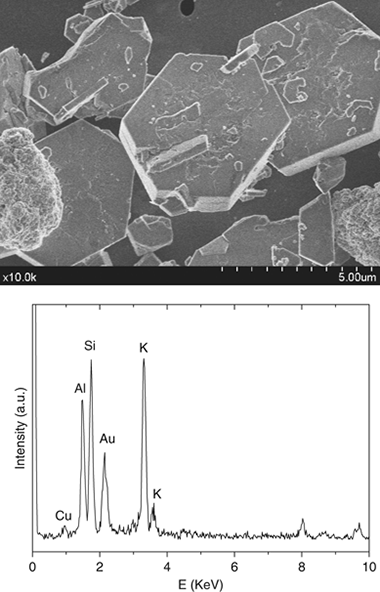
Abstract
This study reports a simple method to synthesize pure kalsilite (KAlSiO4) using readily available precursors, kaolinite and KOH solution, after only 12 h of hydrothermal treatment in mild conditions. A structural refinement has been carried out using the Rietveld method to obtain unit cell parameters, and the 29Si and 27Al magic angle spinning nuclear magnetic resonance spectra have shown the purity and complete Si/Al ordering of the kalsilite structure obtained. Finally, the morphology of the particles has been analyzed by scanning electron microscopy.
Octubre, 2009 · DOI: 10.1111/j.1551-2916.2009.03232.x
Materiales de Diseño para la Energía y Medioambiente
Rare-earth disilicate formation under Deep Geological Repository approach conditions
Alba, MD; Chain, P; Orta, MMApplied Clay Science, 46 (2009) 63-68 DOI: 10.1016/j.clay.2009.07.012
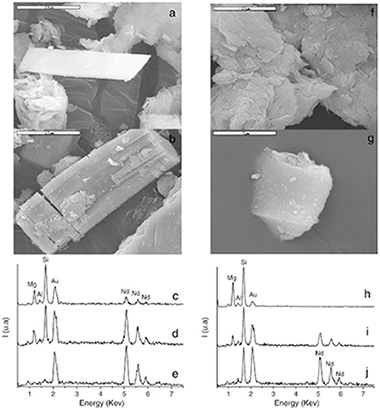
Abstract
The Deep Geological Repository (DGR) concept involves the placement of long-lived radioactive waste in rooms excavated deep. The major responsibility of the disposal safety falls on the Engineered Barrier System (EBS). The main constituent of EBS is bentonite that prevents the release of radiactive nuclei by physical and chemical mechanisms. The physical mechanism is expected to fault with the weathering of the bentonite while the chemical mechanisms have been only proved at 300 °C. It is the aim of this paper to explore the feasibility of the chemical mechanism at temperatures closer to the DGP conditions and to shed light on the mechanism of transformation of the argillaceous materials of the EBS in rare-earth disilicate phases. Saponite was submitted to hydrothermal reaction at 175 °C and 150 °C with different solutions of REE3+ cations (REE = Sc, Lu, Y, Sm, Nd and La). The products were analyzed by XRD, NMR and electron microscopy. At conditions close to the DGP, the saponite was able to form rare-earth silicates. The formation of the disilicate phase, as final product, needs a set of stages and oxyorthosilicate as precursor.
Septiembre, 2009 · DOI: 10.1016/j.clay.2009.07.012
Materiales de Diseño para la Energía y Medioambiente
Mineralogical stability of phyllosilicates in hyperalkaline fluids: Influence of layer nature, octahedral occupation and presence of tetrahedral Al
Becerro, AI; Mantovani, M; Escudero, AAmerican Mineralogist, 94 (2009) 1187-1197 DOI: 10.2138/am.2009.3164
Abstract
Mineralogical changes in a set of phyllosilicates, differing in their layer nature, chemical composition, octahedral character, and Al content of the tetrahedral sheet, were analyzed after hydrothermal reaction in an alkaline solution. The composition of the alkaline solution was selected to simulate the first stage of cement degradation [NaOH-KOH-Ca(OH)2]. The reaction products have been analyzed by XRD, 29Si and 27Al MAS NMR spectroscopy, SEM/EDX, and TEM. The results indicate that the main factor influencing the stability of the clays is the occupation of the octahedral sheet such that all trioctahedral members withstand the alkaline attack, whereas most of the dioctahedral clays suffer a complete dissolution and crystallization of new phases. Second, clays with Al in the tetrahedral sheet of their layers are shown to be less stable than those with a pure Si tetrahedral sheet.
Agosto, 2009 · DOI: 10.2138/am.2009.3164
Materiales de Diseño para la Energía y Medioambiente
Stability of phyllosilicates in Ca(OH)2 solution: Influence of layer nature, octahedral occupation, presence of tetrahedral Al and degree of crystallinity
Mantovani, M; Escudero, A; Alba, MD; Becerro, AIApplied Geochemistry, 24 (2009) 1251-1260 DOI: 10.1016/j.apgeochem.2009.03.012
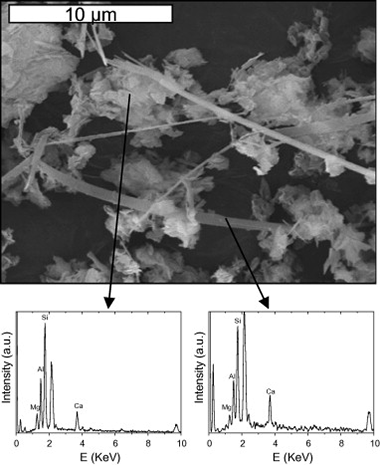
Abstract
This paper presents the results of a comprehensive investigation of the interaction of layered silicates with Ca(OH)2 in hydrothermal conditions. The study is intended to evaluate the stability of the clay buffer in radioactive waste repositories, at the intermediate stages of concrete leaching, when the pH is controlled by the dissolution of portlandite. The influence of layer nature, octahedral occupation, presence of tetrahedral Al and degree of crystallinity will be assessed by analysing the behaviour of a set of well-selected phyllosilicates and using the combined capabilities of 29Si and 27Al MAS-NMR spectroscopy, powder X-ray diffraction and SEM/EDX. The results show that the main factor affecting the stability of the clay is the octahedral occupation, so that trioctahedral phyllosilicates are much more stable than dioctahedral ones. The nature and expandability of the layer does not seem to much influence the stability of the clay, so that a 2:1 expandable phyllosilicate shows the same stability as a chemically analogous 1:1 non-expandable phyllosilicate. However other factors like the poor crystallinity of the starting material or the presence of Al in the tetrahedral sheet of trioctahedral phyllosilicates weaken the clay structure in alkaline conditions and favour the transformation towards other phases.
Julio, 2009 · DOI: 10.1016/j.apgeochem.2009.03.012
Materiales de Diseño para la Energía y Medioambiente
Chemical Reactions in 2D: Self-Assembly and Self-Esterification of 9(10),16-Dihydroxypalmitic Acid on Mica Surface
Heredia-Guerrero, JA; San-Miguel, MA; Sansom, MSP; Heredia, A; Benitez, JJLangmuir, 25 (2009) 6869-6874 DOI: 10.1021/la9001412
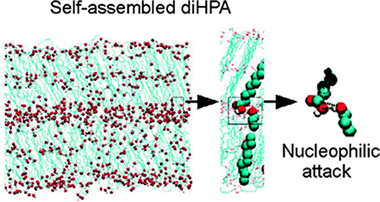
Abstract
9(10),16-Dihydroxypalmitic acid (diHPA) is a particularly interesting polyhydroxylated fatty acid (1) because it is the main monomer of cutin, the most abundant biopolyester in nature, and (2) because the presence of a terminal and a secondary hydroxyl group in midchain positions provides an excellent model to study their intermolecular interactions in a confined phase such as self-assembled layers. In this study we have combined atomic force microscopy (AFM), X-ray photoelectron spectroscopy (XPS), attenuated total reflection Fourier transform infrared (ATR-FT-IR) spectroscopy, as well as molecular dynamics (MD) simulations to conclude that the self-assembling of diHPA molecules on mica is a layer by layer process following a Brunauer−Emmett−Teller (BET) type isotherm and with the first layer growing much faster than the rest. Interactions between secondary hydroxyls reinforce the cohesive energy of the monolayer, while the presence of the terminal hydroxyl group is necessary to trigger the multilayered growth. Besides, XPS and ATR-FT-IR spectroscopies clearly indicate that spontaneous self-esterification occurs upon self-assembling. The esterification reaction is a prerequisite to propose a self-assembly route for the biosynthesis of cutin in nature. Molecular dynamics simulations have shown that internal molecular reorganization within the self-assembled layers provides the appropriate intermolecular orientation to facilitate the nucleophilic attack and the release of a water molecule required by the esterification reaction.
Junio, 2009 · DOI: 10.1021/la9001412
Materiales de Diseño para la Energía y Medioambiente
Cutin synthesis: A slippery paradigm
Heredia, A; Heredia-Guerrero, JA; Dominguez, E; Benitez, JJBiointerphases, 4 (2009) P1-P3 DOI: 10.1116/1.3063816
Abstract
Despite its biological importance, the mechanism of construction of cutin, the polymer matrix of plant cuticles, has not yet been elucidated. Recently, progress on lipid barrier formation of polymers such as cutin and suberin has been recently reviewed by Pollard et al. In their review the authors state that the ubiquitous cutin is the least understood of the plant extracellular polymers and that major questions about cutin structure and its macromolecular assembly remain to be resolved. At the time this paper was being published our research group has developed a new hypothesis on plant cutin synthesis.
Marzo, 2009 · DOI: 10.1116/1.3063816
Materiales de Diseño para la Energía y Medioambiente
Synthesis of MCM-22 zeolites of different Si/Al ratio and their structural, morphological and textural characterisation
Delitala, C; Alba, MD; Becerro, AI; Delpiano, D; Meloni, D; Musu, E; Ferino, IMicroporous and Mesoporous Materials, 118 (2009) 1-10 DOI: 10.1016/j.micromeso.2008.07.047
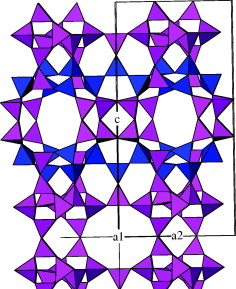
Abstract
MCM-22 zeolites with Si/Al in the 9–46 range were synthesised in rotating autoclave and characterised by X-ray diffraction, 1H, 29Si and 27Al magic angle spinning nuclear magnetic resonance, scanning electron microscopy and nitrogen physisorption. For the Si/Al = 21, 30 and 46 samples both X-ray diffraction and scanning electron microscopy revealed the crystallisation of pure MCM-22. Besides the latter, crystals of ferrierite also formed during the synthesis of the Si/Al = 9 sample. Based on the 1H MAS NMR spectra of dehydrated samples, the different proton species present on the MCM-22 samples were determined and quantified. Information about the incorporation of Al ions into the zeolite framework, as well as on the preferential crystallographic sites occupied in dependence on the Si/Al ratio of the sample, was obtained by 27Al MAS NMR spectroscopy. From 29Si MAS NMR spectra, differences in the degree of crystallinity of the samples were assessed, the results being in agreement with the diffraction data. Nitrogen physisorption runs revealed the microporous nature of the adsorbents, with a supermicropore to ultramicropore volume ratio in good agreement, for the best crystallised samples, with the porous structure with supercages and sinusoidal channels of the ideal MCM-22 crystal.
Febrero, 2009 · DOI: 10.1016/j.micromeso.2008.07.047
Materiales de Diseño para la Energía y Medioambiente
Liquid-phase thiophene adsorption on MCM-22 zeolites. Acidity, adsorption behaviour and nature of the adsorbed products
Delitala, C; Cadoni, E; Delpiano, D; Meloni, D; Alba, MD; Becerro, AI; Ferino, IMicroporous and Mesoporous Materials, 118 (2009) 11-20 DOI: 10.1016/j.micromeso.2008.08.008
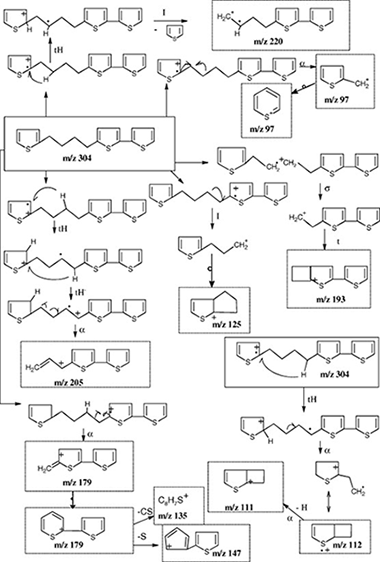
Abstract
The liquid-phase adsorption of thiophene from thiophene/iso-octane solutions has been investigated in batch conditions at room temperature and atmospheric pressure on MCM-22 zeolites with Si/Al in the 9–46 range. Thiophene adsorption was found to occur in two steps whatever the Si/Al ratio of the adsorbent. The presence of ferrierite besides the MCM-22 phase caused a significant loss of the adsorption performance. For pure MCM-22 samples, the Si/Al ratio influenced the adsorption performance. Based on the acid properties of the samples, investigated by adsorption microcalorimetry of ammonia, the adsorption features were interpreted by assuming that positively charged species were originated during the first step; these species underwent successive reaction with weakly adsorbed species formed in the second step, leading to heavy molecular weight organosulphur compounds. Direct evidence for the occurrence of reactive adsorption of thiophene involving its transformation into heavy molecular weight organosulphur compounds was obtained by GC/MS investigation of the nature of the adsorbed material recovered after the adsorption experiments. The peculiar structure of MCM-22 zeolites made possible the formation of long-sized organosulphur compounds. Due to the mechanism by which thiophene is transformed (i.e. progressive addition of other thiophene molecules), the size of the resulting products was found to depend also on the concentration of the weakly adsorbed thiophene molecules able to interact with those already activated through protonation.
Febrero, 2009 · DOI: 10.1016/j.micromeso.2008.08.008
Materiales de Diseño para la Energía y Medioambiente
Synthesis, Rietveld Analysis, and Solid State Nuclear Magnetic Resonance of X2-Sc2SiO5
Alba, MD; Chain, P; Gonzalez-Carrascosa, TJournal of the American Ceramic Society, 92 (2009) 487-490 DOI: 10.1111/j.1551-2916.2008.02877.x
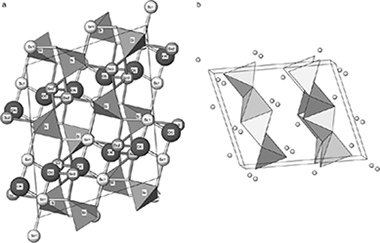
Abstract
Compounds containing rare earths are of increasing technological interest especially because of their unique mechanical, magnetic, electrical, and optical properties. Among them, rare earth oxyorthosilicates are attractive scintillators for γ- and X-ray spectroscopy and detection. However, there are many structural aspects of those compounds that are not clear. In this research, the structure parameters for Sc2Si2O5, X2-polymorph, have been refined from powder X-ray diffraction (XRD) data and the 29Si MAS NMR spectrum is reported for the first time. X2-Sc2SiO5 polymorph was synthesized by the sol–gel method and characterized by XRD and 29Si MAS NMR. The XRD pattern was indexed in a monoclinic unit cell with space group I2/c; the resulting unit cell parameters were a=9.9674(2) Å, b=6.4264(9) Å, c=12.0636(2) Å, and β=103.938(1)°. The 29Si MAS NMR spectrum showed a unique signal at −79.5 ppm, compatible with the unique Si crystallographic site in the unit cell. Finally, the band valence method has been applied to the calculation of a “shift parameter,” which is correlated with the NMR chemical shift.
Febrero, 2009 · DOI: 10.1111/j.1551-2916.2008.02877.x
Materiales de Diseño para la Energía y Medioambiente
Preferential Adsorption from Binary Mixtures on Graphite: The n-Decane−n-Heptan-1-ol System
Alba, MD; Castro, MA; Clarke, S; Medina, S; Messe, L; Millan, C; Orta, MM; Perdigon, ACJournal of Physical Chemistry C, 113 (2009) 3176-3180 DOI: 10.1021/jp8072014
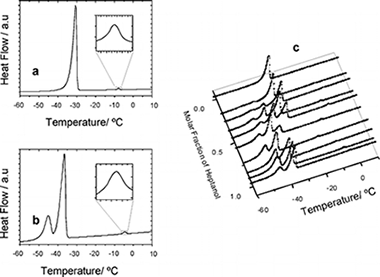
Abstract
The competitive adsorption of n-decane and n-heptan-1-ol adsorbed from the binary liquid mixture onto graphite has been studied using differential scanning calorimetry, incoherent quasielastic neutron scattering, and 1H and 2H nuclear magnetic resonance. A solid monolayer is identified at all bulk solution compositions with a melting temperature that varies with bulk composition in a manner resembling the bulk behavior. Incoherent elastic neutron scattering, IQNS, and nuclear magnetic resonance, NMR, data indicate that decane is preferentially adsorbed onto the surface over most of the composition range, heptanol being the principal surface component only at very high heptanol concentrations. NMR is proved, for the first time, to be an efficient tool to provide independent information on each component of the system.
Febrero, 2009 · DOI: 10.1021/jp8072014
Materiales de Diseño para la Energía y Medioambiente
Phase separation of carboxylic acids on graphite surface at submonolayer regime
Alba, MD; Bickerstaffe, AK; Castro, MA; Clarke, SM; Medina, S; Millan, C; Orta, MM; Pavon, E; Perdigon, ACThe European Physical Journal Special Topics, 167 (2009) 151-156 DOI: 10.1140/epjst/e2009-00951-6
Abstract
Mixing behaviour of solid crystalline monolayers adsorbed onto graphite from different mixtures of undecanoic and dodecanoic acids at submonolayer coverage has been investigated. X-ray diffraction measurements have been collected from a variety of compositions as a function of temperature. An extensive phase separation is found for all the compositions – the scattering patterns characteristic of the pure material crystalline structures being preserved across the entire composition range. The temperature dependence of the monolayer melting points and their depression is also clearly indicative of separation of the two surface components, in clear contrast to that expected if the two carboxylic acids mixed ideally in the monolayer.
Febrero, 2009 · DOI: 10.1140/epjst/e2009-00951-6
2008
2008
Materiales de Diseño para la Energía y Medioambiente
Fabrication, chemical etching, and compressive strength of porous biomimetic SiC for medical implants
Torres-Raya, C; Hernandez-Maldonado, D; Ramirez-Rico, J; Garcia-Ganan, C; de Arellano-Lopez, AR; Martinez-Fernandez, JJournal of Materials Research, 23 (2008) 3247-3254 DOI: 10.1557/JMR.2008.0392
Abstract
BioSiC is a biomimetic SiC-based ceramic material fabricated by Si melt infiltration of carbon preforms obtained from wood. The microstructure of bioSiC mimics that of the wood precursor. which can be chosen for tailored properties. When the remaining g unreacted Si is removed. a SiC Material with interconnected porosity is obtained. This porous bioSiC is Under study for its use as a medical Implant material. We have successfully fabricated bioSiC from Sipo wood and Studied the kinetics of Si removal by wet etching. The results suggest that the reaction is diffusion-limited, and the etch rate follows a t(-0.5) law. The etching rate is found to be anisotropic, which can be explained attending to the anisotropy of the pore distribution. The compressive strength was studied as a function of etching, time. and the results show a quadratic dependence with density. In the attainable ran-e of densities, the strength is similar or better than that of human bone.
Diciembre, 2008 · DOI: 10.1557/JMR.2008.0392
Materiales de Diseño para la Energía y Medioambiente
Crystallographic texture in Al2O3-ZrO2 (Y2O3) directionally solidified eutectics
Ramirez-Rico, J; de Arellano-Lopez, AR; Martinez-Fernandez, J; Pena, JI; Larrea, AJournal of The European Ceramic Society, 28 (2008) 2681-2686 DOI: 10.1016/j.jeurceramsoc.2008.04.015
Abstract
Directionally solidified Al2O3-based eutectics are in situ composites grown from the melt. The directional nature of the solidification process makes these materials highly anisotropic and therefore the measurement and quantification of their crystallographic texture is necessary to understand their physical properties. We studied the texture of Al2O3-ZrO2 (12 mol% Y2O3) eutectic rods by means of X-ray and electron backscattering diffraction. The phases grow according to the relationship (10 (1) over bar2}(Al2O3) //{110}(ZrO2) and Al2O3 is oriented with its c-axis approximately parallel to the growth direction. We observed that the c-axis orientation is not constant throughout the sample, but instead changes according to the distance from the growth axis. The c-axis orientation spread was found to be 10 degrees. This spread is a consequence of the curvature of the liquid-solid interface during solidification, whose shape we reconstructed using EBSD data.
Octubre, 2008 · DOI: 10.1016/j.jeurceramsoc.2008.04.015
Materiales de Diseño para la Energía y Medioambiente
The Role of Hydroxyl Groups in the Self-Assembly of Long Chain Alkylhydroxyl Carboxylic Acids on Mica
Benitez, JJ; Heredia-Guerrero, JA; Serrano, FM; Heredia, AJournal of Physical Chemistry C, 124 (2008) 16391-16401 DOI: 10.1021/jp805445z
Abstract
The adsorption and self-assembly of hydroxylated long chain fatty acids on mica has been studied by AFM. The presence of secondary midchain hydroxyl groups is found to strongly affect the self-assembly process via the reinforcement of lateral interactions between molecules by -OH center dot center dot center dot HO- hydrogen bonding. On the other side, the availability of an exposed terminal hydroxyl group in the acid molecule triggers the formation of a second layer due to the strength of tile -OH center dot center dot center dot HOOC- tail-to-head interaction. Surface coverage (theta) data follow a Langmuir-type relationship vs solution concentration (c). The analysis of the slope of 1/theta vs 1/c plots provides a relative estimation of the adsorption enthalpy for the formation of the first and second monolayers. Based on that, both the contribution of molecule-substrate and lateral molecule-molecule energy terms are found to be relevant in the self-assembly of this type of molecule oil mica.
Octubre, 2008 · DOI: 10.1021/jp805445z
Materiales de Diseño para la Energía y Medioambiente
High-temperature mechanical properties of porous NaMgF3 derived from directionally solidified NaMgF3-NaF eutectics
Ramirez-Rico, J; de Arellano-Lopez, AR; Martinez-Fernandez, J; Larrea, A; Orera, VMJournal of The European Ceramic Society, 28 (2008) 2451-2457 DOI: 10.1016/j.jeurceramsoc.2008.04.002
Abstract
Porous NaMgF3 ceramics have been fabricated by leaching a NaF-NaMgF3 eutectic in distilled water, producing NaMgF3 with 53% of connected porosity. The eutectic was fabricated using the Bridgman technique at growth rates of 8, 10 and 15 mm/h. The microstructure and composition of the resulting material has been studied by means of X-ray diffraction and SEM. Compression mechanical tests have been performed at different temperatures up to 750 degrees C, both in constant strain rate and constant stress loading. The microstructure consists of plate-like grains with cylindrical pores in approximately hexagonal packing. Pores are perpendicular in adjacent grains. The compressive strength is found to be rather independent of growth rate, in the range studied. Small differences can be explained using a minimum solid area (MSA) model and differences in the microstructure. In creep experiments, no steady-state regime was observed. Instead, the strain exhibited a series of accelerations that could be associated with damage propagation.
Septiembre, 2008 · DOI: 10.1016/j.jeurceramsoc.2008.04.002
Materiales de Diseño para la Energía y Medioambiente
Self-assembled polyhydroxy fatty acids vesicles: a mechanism for plant cutin synthesis
Heredia-Guerrero, JA; Benitez, JJ; Heredia, ABioessays, 30 (2008) 273-277 DOI: 10.1002/bies.20716
Abstract
Despite its biological importance, the mechanism of formation of cutin, the polymeric matrix of plant cuticles, has not yet been fully clarified. Here, for the first time, we show the participation in the process of lipid vesicles formed by the self-assembly of endogenous polyhydroxy fatty acids. The accumulation and fusion of these vesicles (cutinsomes) at the outer part of epidermal cell wall is proposed as the mechanism for early cuticle formation.
Marzo, 2008 · DOI: 10.1002/bies.20716
Materiales de Diseño para la Energía y Medioambiente
Getting more out of X2T2O7 compounds with thortveltite structure: The bond-valence model
Alba, MD; Becerro, AI; Chain, P; Escudero, A; Gonzalez-Carrascosa, TJournal of Solid State Chemistry, 181 (2008) 340-344 DOI: 10.1016/j.jssc.2007.11.027
Abstract
C-M2Si2O7 (M = RE and In) and crystals of composition X2T2O7 (T = P, As, Ge) with ionic radius of X less than 0.97 angstrom (X = Ni, Cd, Mg, Zn, Cu, Ca) are isostructural with the natural-occurring mineral thortveitite. In those compounds, the T-O bridging distance values vary considerably and there is no explanation to this fact in the literature. This paper will bring their structural characteristics out by the bond-valence model. It has been concluded that T-O bridging distance and mean T-O distance are linearly correlated to the total atomic valence of the bridging oxygen and the T atom (T = Si, P, As, Ge), respectively, and they are a function of the principal quantum number (n) in the valence shell of the atom T. Finally, we have applied successfully the model for the prediction of Ge-O distances of (In,A)(2)Ge2O7 (A = Fe,Y,Gd) compounds.
Febrero, 2008 · DOI: 10.1016/j.jssc.2007.11.027
Materiales de Diseño para la Energía y Medioambiente
Reaction-formation mechanisms and microstructure evolution of biomorphic SiC
Varela-Feria, FM; Ramirez-Rico, J; de Arellano-Lopez, AR; Martinez-Fernandez, J; Singh, MJournal of Materials Science, 43 (2008) 933-941 DOI: 10.1007/s10853-007-2207-4
Abstract
Biomorphic SiC is fabricated by liquid Si infiltration of a carbon preform obtained from pyrolized wood that can be selected for tailored properties. The microstructure and reaction kinetics of biomorphic SiC have been investigated by means of TEM, SEM, EBSD, and partial infiltration experiments. The microstructure of the material consists of SiC and Si and a small fraction of unreacted C. The SiC follows a bimodal size distribution of grains in the micrometer and the nanometer range with no preferential orientation. The infiltration-reaction constant has been determined as 18 x 10(-3) s(-1). These observations suggest that the main mechanism for SiC formation is solution-precipitation in the first stage of growth. If the pores in the wood are small enough they can be choked by SiC grains that act as a diffusion barrier between Si and C. If that is the case, Si will diffuse through SiC forming SiC grains in the nanometer range.
Febrero, 2008 · DOI: 10.1007/s10853-007-2207-4
|
||
|
||
|
|
icms




